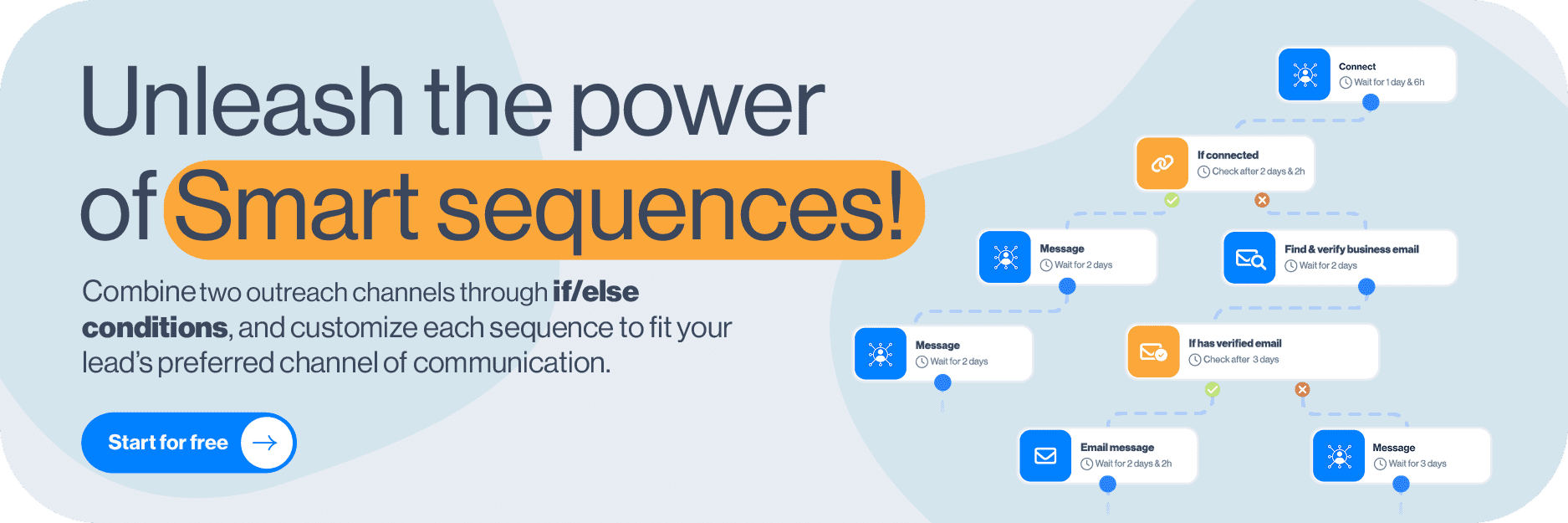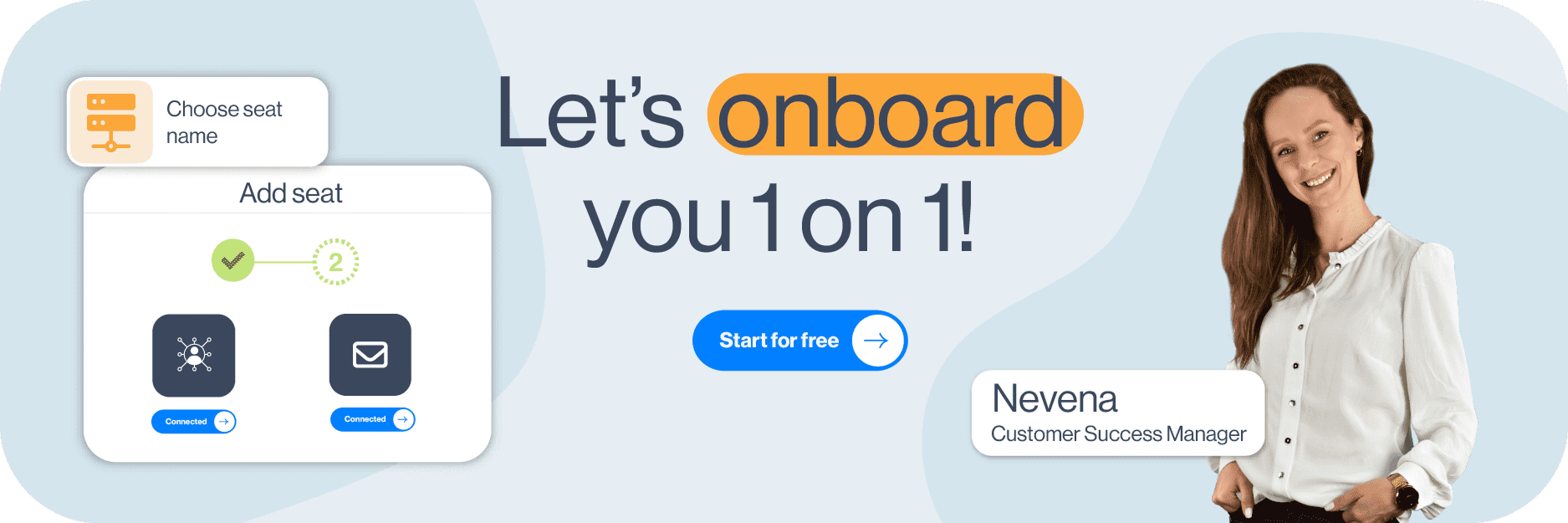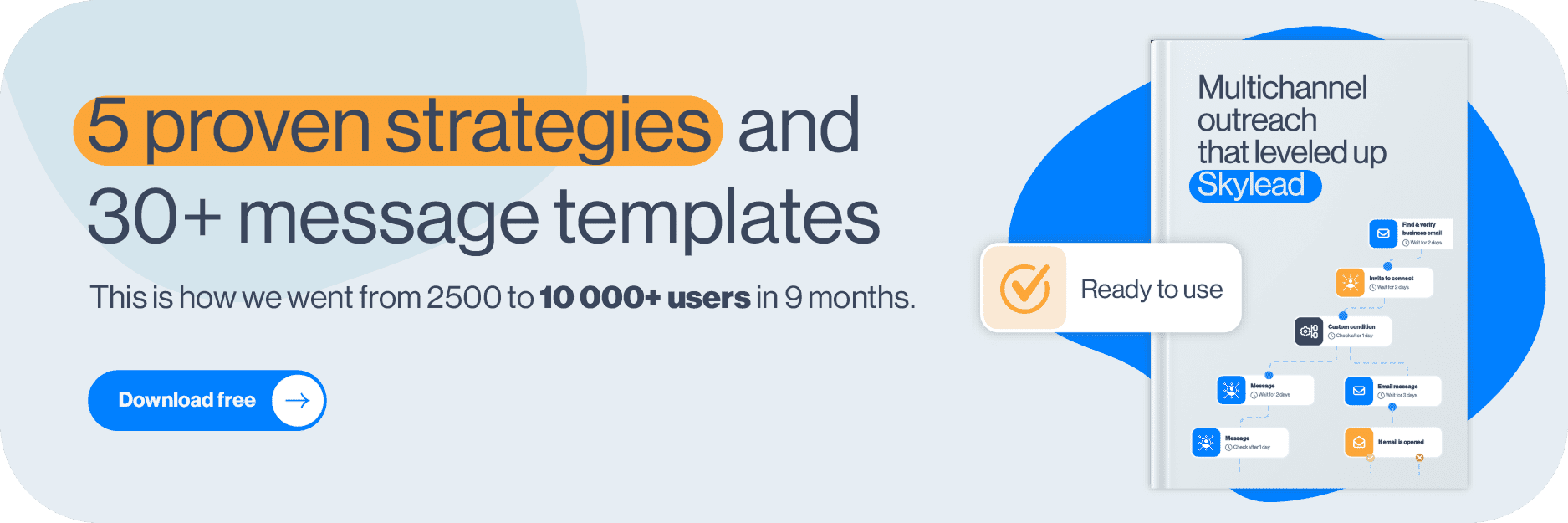If you are looking to scale your outreach, you've likely come across Instantly.ai. This cold outreach software, launched in 2021, promises to help you find, contact, and close your ideal clients.
But before you commit to it, there are a few things to consider.
Is it worth the investment?
What do others have to say about it?
And how does it compare to other tools on the market?
If you're ready to get answers to these questions, dive into our review that reveals:
- Notable Instantly.ai features
- Downsides to using it
- Real users’ opinions on the tool
- How much it costs
We’ve even added a list of 12 alternatives, just in case Instantly features do not fulfill your business needs.
Let’s jump right in!
Instantly.ai or alternatives?
Instantly.ai is one of the best cold email software and an email management platform that’s quickly become popular for email outreach.
This cloud-based tool allows users to set up automated email campaigns with follow-ups to reach leads at scale.
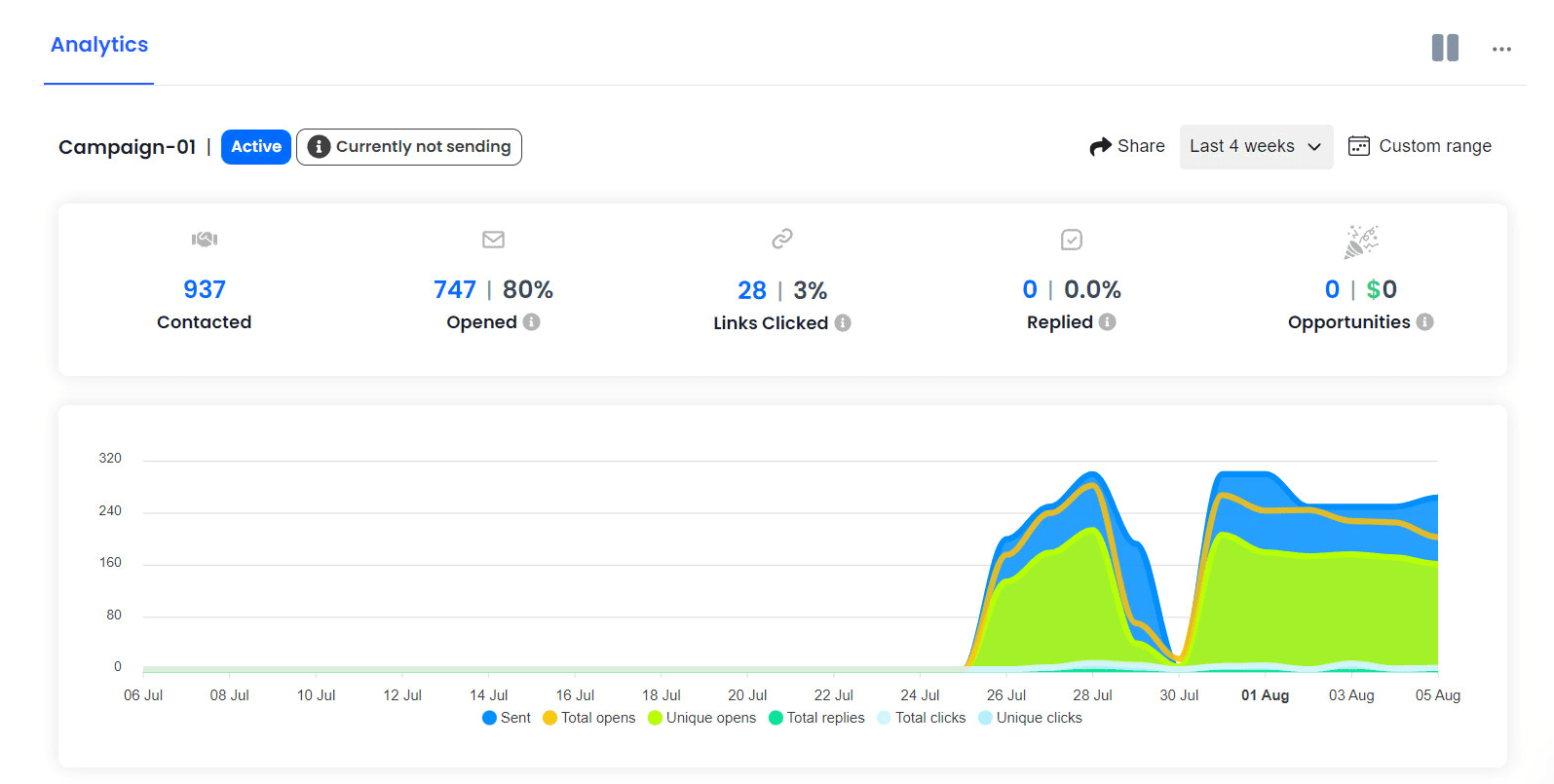
Users can add leads to their campaigns by either importing a CSV file with lead information or using Instantly.ai’s native B2B Lead Finder tool.
The software also offers a Unibox, which consolidates all email conversations in one place and various options for message personalization.
Speaking of personalization, to enhance your outreach, you can use its:
- Pre-set or custom variables
- Spintax - multiple variations of a text to avoid repetition
- Liquid syntax - dynamic text based on data
Additionally, Instantly.ai supports A/Z testing, which lets you test up to 26 different versions of email copy.
Data from Instantly.ai can be pushed to different CRMs and tools via Zapier webhooks.
However, the platform also has a built-in CRM that helps track lead statuses and enables you to make calls and send SMS directly from the platform.
Finally, the software can verify your leads' emails, reducing the chance of bounces and protecting your domain's reputation.
With the basics covered, let’s take a closer look at Instantly.ai’s main features.
Instantly.ai features
Unlimited email accounts
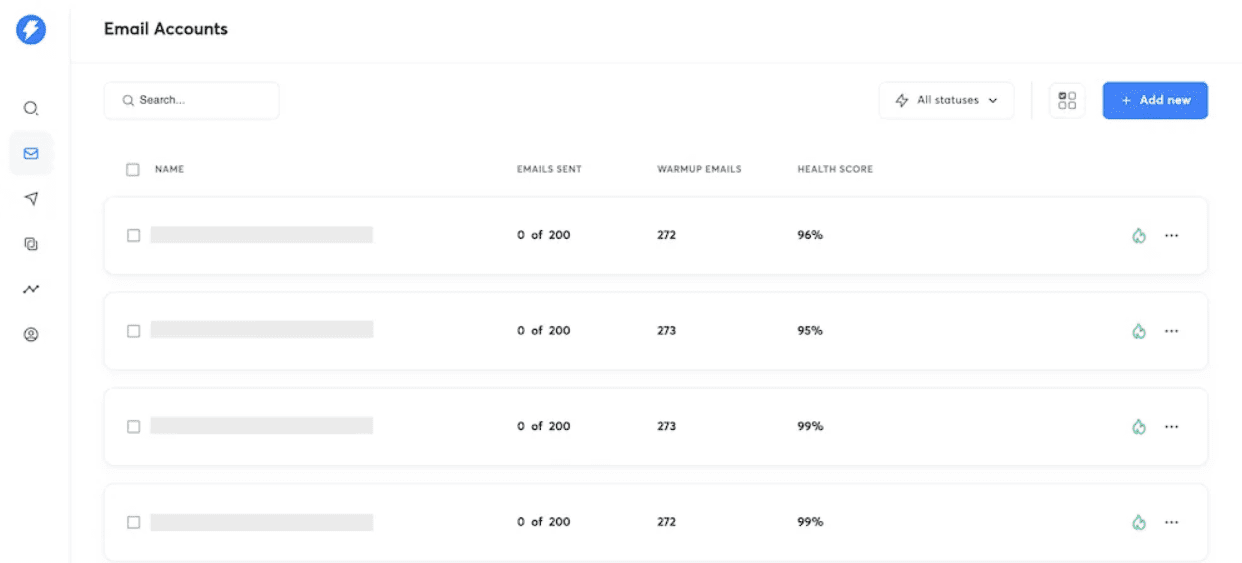
Instantly.ai allows you to connect and manage unlimited email accounts.
As they like to say, this enables you to:
‘’Infinitely scale your outreach.’’
However, despite being able to connect unlimited email accounts, the tool caps the number of active leads and emails you can send per month based on the subscription plan.
Nonetheless, Instantly.ai is still useful for email outreach, especially for those who need to reach a large number of leads quickly.
Why? Because you can use all connected accounts in the same campaign.
This is possible due to the software’s inbox rotation feature. This feature alternates sending emails from different accounts. In turn, it helps you send more emails daily without triggering automation detection.
Unlimited email warm-up
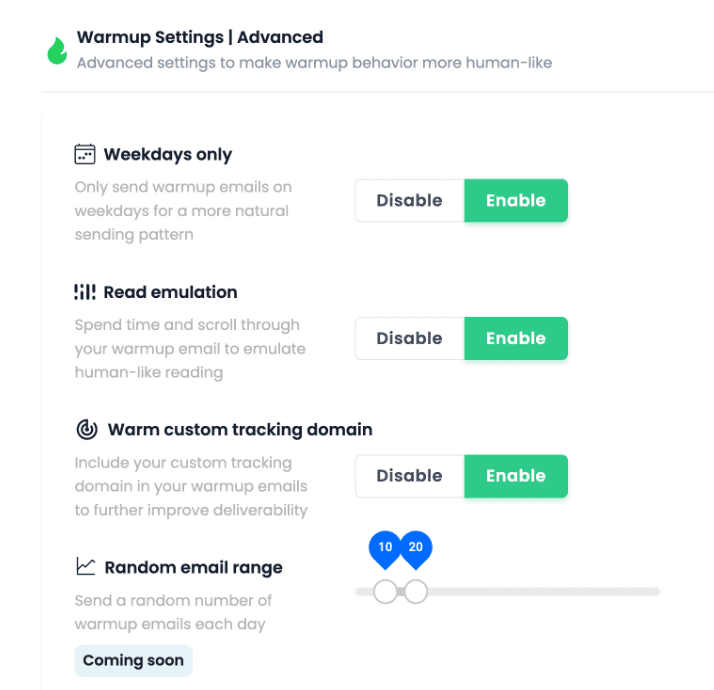
Instantly.ai is one of the few sales outreach tools (or outreach tools in general) with a built-in unlimited email warm-up functionality.
This means that you can warm up every new email address that you connect to it to ensure that:
- Fewer emails end up in spam
- Your sender’s reputation remains optimal
B2B Lead Finder
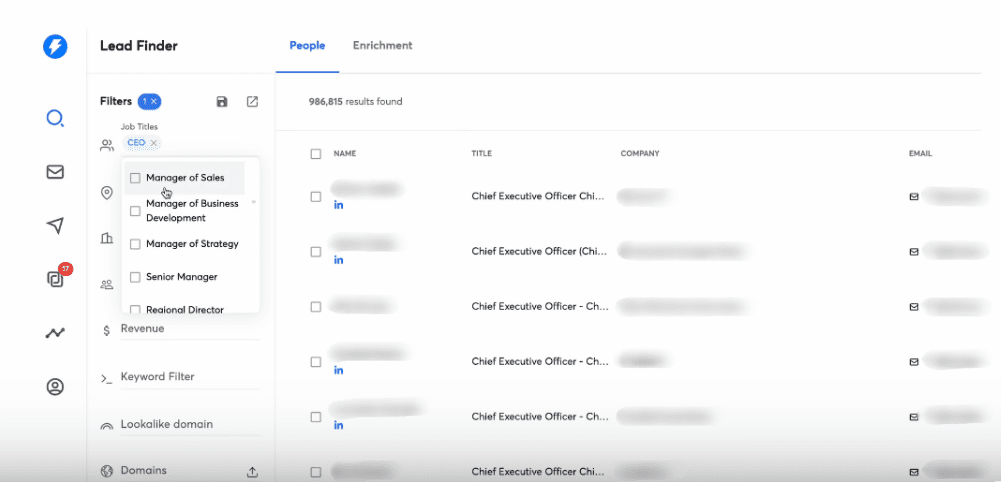
Instantly's B2B Lead Finder is a database with 160M contacts designed to help find leads that are highly relevant and accurate.
The feature relies on a range of filters — some of which match Sales Navigator filters. These include:
- Job Titles
- Location
- Industry
- Employees
- Revenue
- Domains
- ...etc.
What's more, the feature supports keyword-based searches and lets you apply multiple filters simultaneously. This helps you better narrow your search and pinpoint the most promising leads according to your Ideal Customer Profile (ICP) and buyer persona.
Another useful feature of the Lead Finder is Lead Enrichment. To use it, upload a list of contacts, and the system will enrich it with additional data.
Instantly.ai disadvantages
Instantly.ai excels in many aspects. However, certain disadvantages make it less than ideal and position other tools as superior.
Instantly.ai doesn’t support multichannel outreach of any kind.
Moreover, email sequences that you can create with Instantly.ai are pretty basic. You can’t set them up to adjust based on your leads’ behavior. So, if your leads don’t respond, there’s not much you can do.
Why, yes, messages can be personalized. Unfortunately, rich media content, including images and GIFs, can’t.
Analytics could also be improved to provide deeper insight into campaign performance. Additionally, there is no option to export stats to CSV or PDF.
While Instantly.ai claims you can scale your outreach infinitely, that's not quite accurate. In fact, their basic plan lets you send 5,000 emails per month only. Consequently, the mid-tier plan limits you to 100,000 emails, and the top plan caps at 500,000 emails.
Plus, they limit the number of leads you can upload to the platform. Depending on the plan, you can either upload 1,000, 25,000, or 100,000 leads.
Finally, while the tool can enrich your leads’ information, including their emails, this functionality will cost you extra. Not to mention, there are limits to how many leads you can enrich.
This is a huge con, considering that a certain tool lets you send tens of thousands of emails a month and verify as many emails as you want at no additional cost.
But we’ll get to that shortly.
What Instantly.ai reviews say
While doing the research, we stumbled across both positive and negative Instantly.ai reviews.
As for the positive aspects, we noticed many users are praising the interface.
For instance, one of them, Jonas R, says:
‘’The automation of follow-ups and the user-friendly interface make it incredibly efficient for managing my cold outreach campaigns.’’
On the other hand, Zirva Z. has pointed out certain flows in her review:
‘’The leads aren't great, and being limited to adding only 100 at a time is really frustrating.’’
She also went on to mention that:
‘’It's not very useful unless you have a really high budget.’’
Instantly.ai pricing
Instantly.ai has 2 main pricing categories — Sending & Warmup and Leads — with multiple sub-plans.
Sending & Warmup is the pricing plan for sending and warming up emails.
As such, it doesn’t include access to the B2B Lead Finder and is divided into 3 individual sub-plans.
The pricing varies and is determined based on the number of leads you can upload and emails you can send.
| Growth | $37/mo per account |
| Hypergrowth | $97/mo per account |
| Light Speed | $358/mo per account |
Meanwhile, Leads plans are meant to streamline prospecting and entail full access to the B2B Lead Finder feature.
There are a total of 4 of these. They differ in price depending on the number of leads you can verify and include:
| Growth Leads | $37.9/mo per account |
| Supersonic Leads | $77.6/mo per account |
| Hyperleads | $169.3 per account |
| Enterprise | Custom / Contact sales for pricing details |
But remember, if you want to use Instantly.ai to send and warm up emails and generate leads, you can’t purchase a plan from a single category. Instead, you’ll need one from each.
This means that the price of using the software can quickly skyrocket.
For instance, if you were to subscribe to their lowest-tier subscriptions, you’d pay a total of $84 for both each month. On the other hand, their highest-tier plans combined set you back an exorbitant $850 a month.
That said, you might be better off using a tool that offers much more at a lower price.
12 best Instantly.ai alternatives
Are you interested in exploring other software on the market? If so, here are 12 compelling alternatives to Instantly.ai that may provide you with better value for your money.
1. Skylead
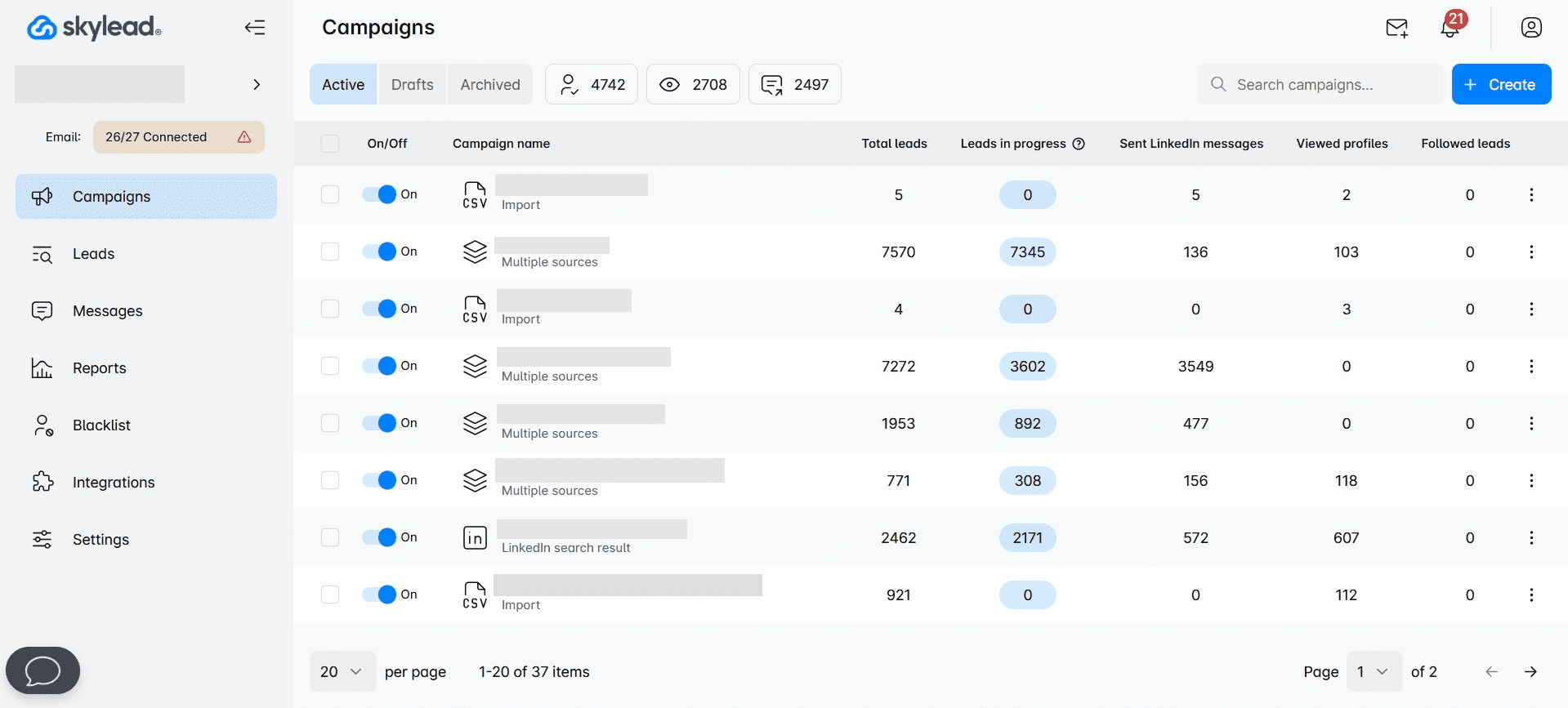
Well, hello - that’s us! 😊
Skylead is a leading cloud-based multichannel sales engagement tool that is 100% compliant with LinkedIn's ToS.
It's commonly used by:
- Sales professionals and entrepreneurs who aim to free up as much as 11 hours a week for booking 3x more meetings.
- Marketing professionals seeking to distribute content and secure more backlinks.
- Recruiters on the hunt for the best talent.
- Lead generation agencies focused on acquiring high-quality leads for their clients.
The biggest difference between Instantly.ai and Skylead is the support for another professional social media platform.
As a matter of fact, our software allows you to create multichannel campaigns that combine different outreach actions. All thanks to our Smart sequences.
The tool also lets you personalize messages with preset and custom variables. While at it, you can even engage in A/B testing to determine how to best approach leads.
However, what truly sets Skylead apart in the personalization department is our native image and GIF personalization feature.
Not to mention, Skylead also offers infinite email warm-up, courtesy of our partnership with an email warm-up tool, InboxFlare.
Finally, our tool comes with advanced reporting capabilities and even supports CSV and PDF exports. You can also integrate it with any CRM or tool you like using Zapier webhooks or API.
Now, let’s get deeper into our features that are changing the outreach game as we know it.
Email automation
Much like Instantly.ai, Skylead lets you add unlimited email accounts to help you send tens of thousands of emails a month.
However, unlike it, it doesn’t limit the number of active leads you can have. You can input unlimited leads, allowing you to reach out to more people.
If you were wondering how it’s possible to send thousands of emails a month, well, it’s because our tool supports inbox rotation. This means that Skylead alternates sending emails from different accounts to keep you within safe limits on each.
Email discovery & verification
Namely, our software can find and verify your leads’ emails. In turn, it reduces the chances of bounces that impact deliverability and your sender’s reputation.
And guess what? You can take advantage of this feature without breaking your campaign creation flow.
Just add the Find & Verify Email step to your sequence for the tool to find and double-verify the existence of your leads’ emails.
The best thing about this feature is that it has one of the highest, if not the highest, email-finding probabilities on the market.
Not to mention, it’s both unlimited and comes at no extra cost. In other words, as long as you’re subscribed to the tool, you can use it as much as you want.
This makes Skylead more cost-effective than Instantly.ai, which requires a separate subscription to enrich emails.
Smart sequences
And that brings us to the star of the show: Smart sequences.
In essence, they are algorithms that combine outreach actions with if/else conditions. As a result, you get coherent outreach flows that helps you unfold outreach according to the way your prospects behave. That said, here's one smart sequence example.
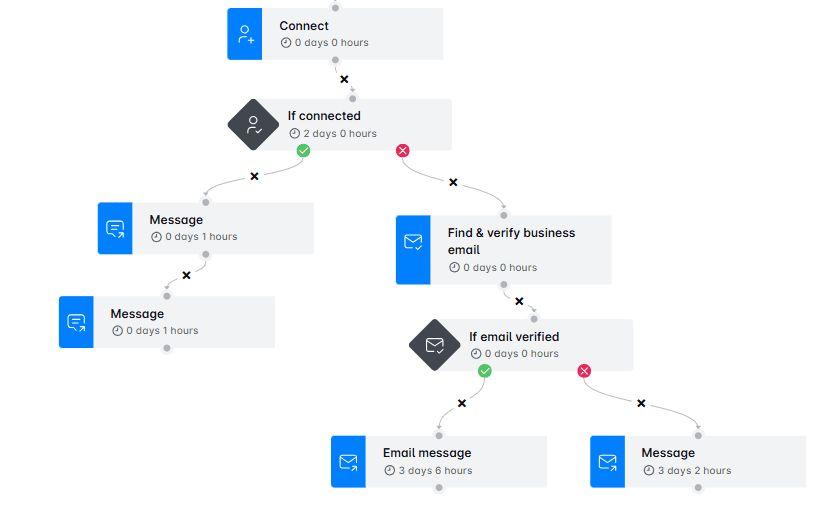
Of course, there are a thousand more ways this can go. Smart sequence builder is your playground, so feel free to experiment with different branching paths.
Or, you can try our tried and tested Smart sequences templates inside the tool for guaranteed results!
Smart inbox
Smart inbox, although serving the same purpose as Instantly.ai’s Unibox, is far superior. That’s because it doesn’t only aid email management. It also lets you manage your conversations from both platforms.
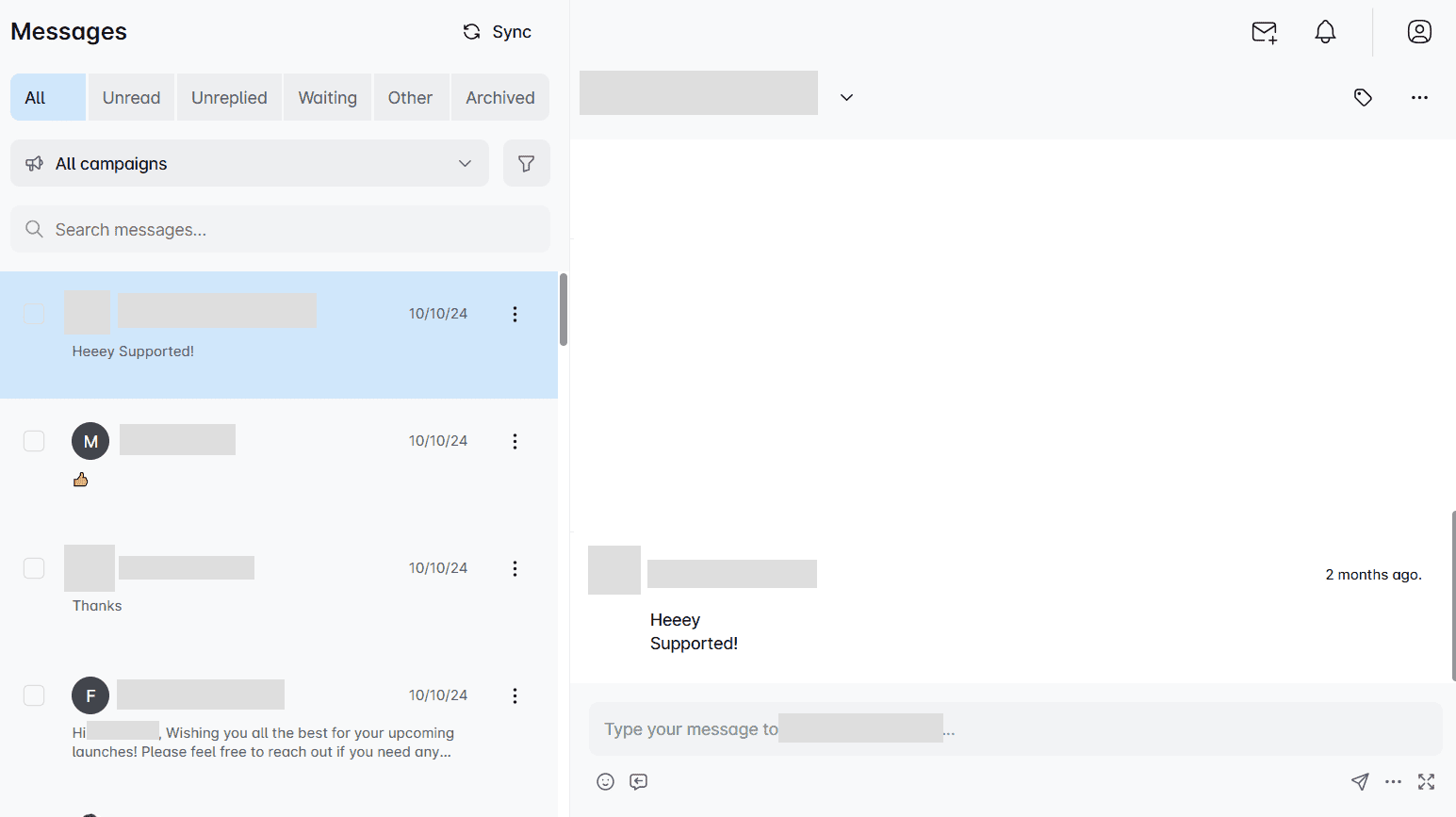
But what makes our Smart inbox truly irreplaceable is the opportunity to label chats. These labels are great because they can help you keep track of ROI and conversions. That said, you can choose between a couple of predefined ones or add your own.
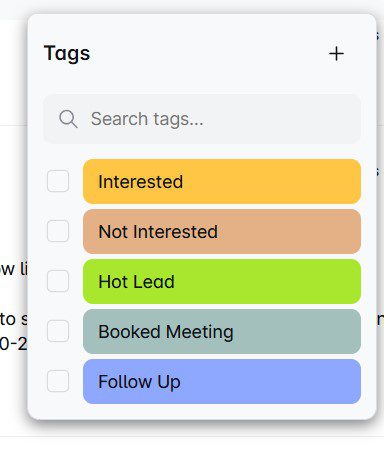
Image & GIF personalization
They say a picture is worth a thousand words. And we agree, which is why we introduced our image and GIF personalization feature.
Believe it or not, by personalizing visuals for each recipient, you can increase your response rate to more than 63%.
That said, our image and GIF editor lets you upload any picture you like and personalize it with:
- Your lead’s name
- Their and/or your profile image
- Their and/or your company logo
- A custom message
The choice is yours! Either way, you’ll surely leave a lasting impression.
In fact, just look at the astonishing 76% response rate we got using the following visual!
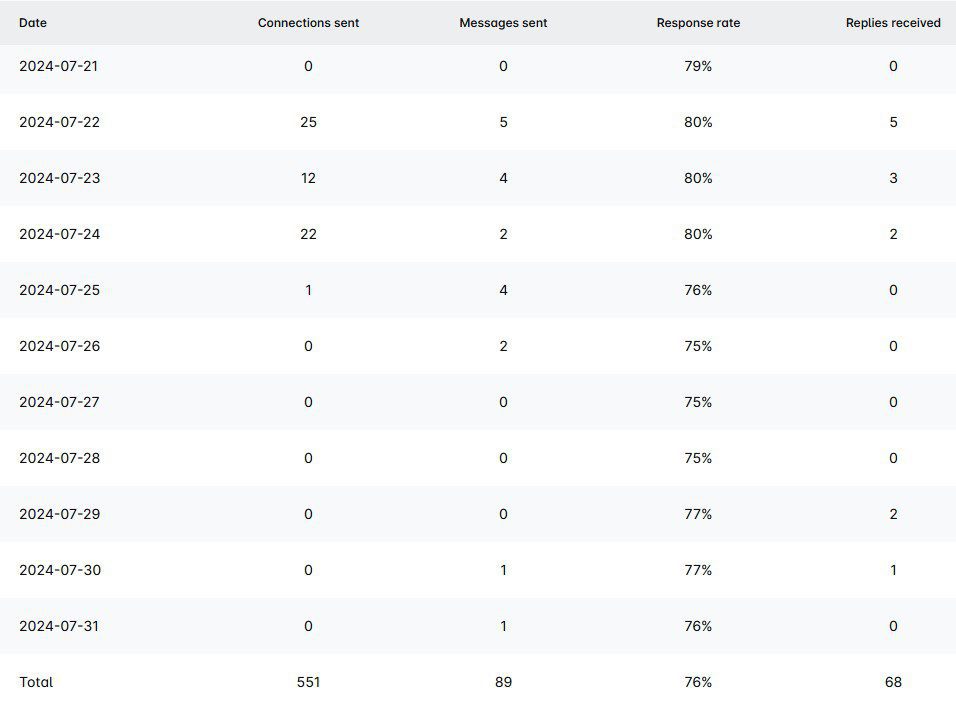

Advanced analytics
Speaking of results, Skylead comes equipped with advanced analytics, which are available on the Reports page.
Here, you can see how all of your campaigns are performing or examine the stats for a single campaign.
That said, there are 3 ways to observe results:
- In a graph form, to visually compare oscillations between different metrics;
- In table-view, to observe fluctuations on a daily basis;
- Step-by-step, to see how your A/B tests are performing.
Unlike Instantly.ai, Skylead even lets you download these reports. The good news is that there are 2 different formats to choose from: CSV and PDF.
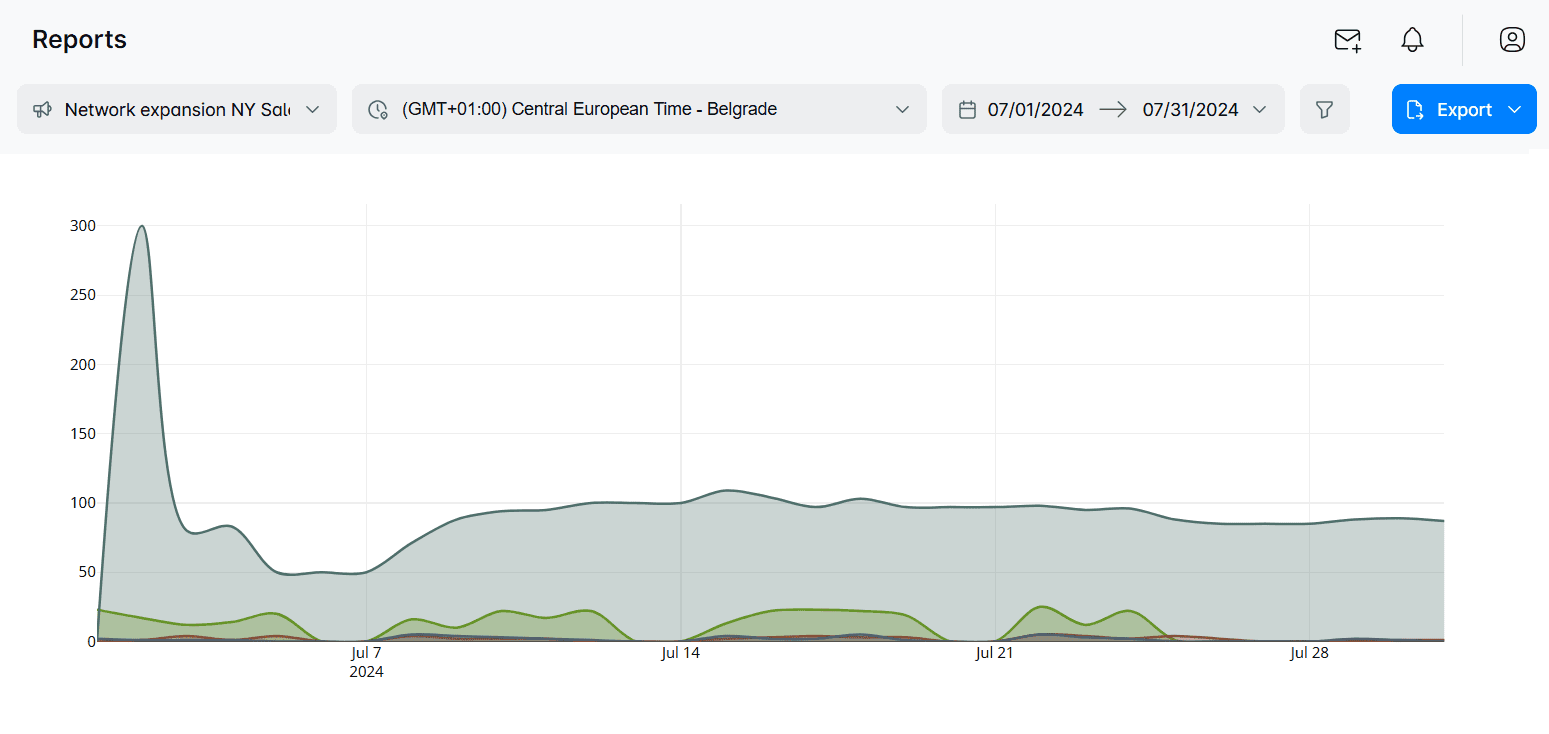
What Skylead reviews say
Skylead reviews are positive, with people praising it for what it has helped them accomplish.
For instance, Daniel Hoffmann, a Managing director at Toplevel Performance, has said that:
“Since I’ve started working with these clients and using Skylead, I have earned approximately $33.000.”
In the meantime, NewPoort's founder, Toine Boelens, has highly praised our Smart sequences and email finder and verifier:
‘’If/else conditions in Smart Sequences are also great. It's low code, so it's great because I'm not good at coding yet. I also like the Find & verify business email step, which finds email addresses most of the time. So you get, like, two ways you can get in touch with the client. ‘’
Instantly.ai vs. Skylead
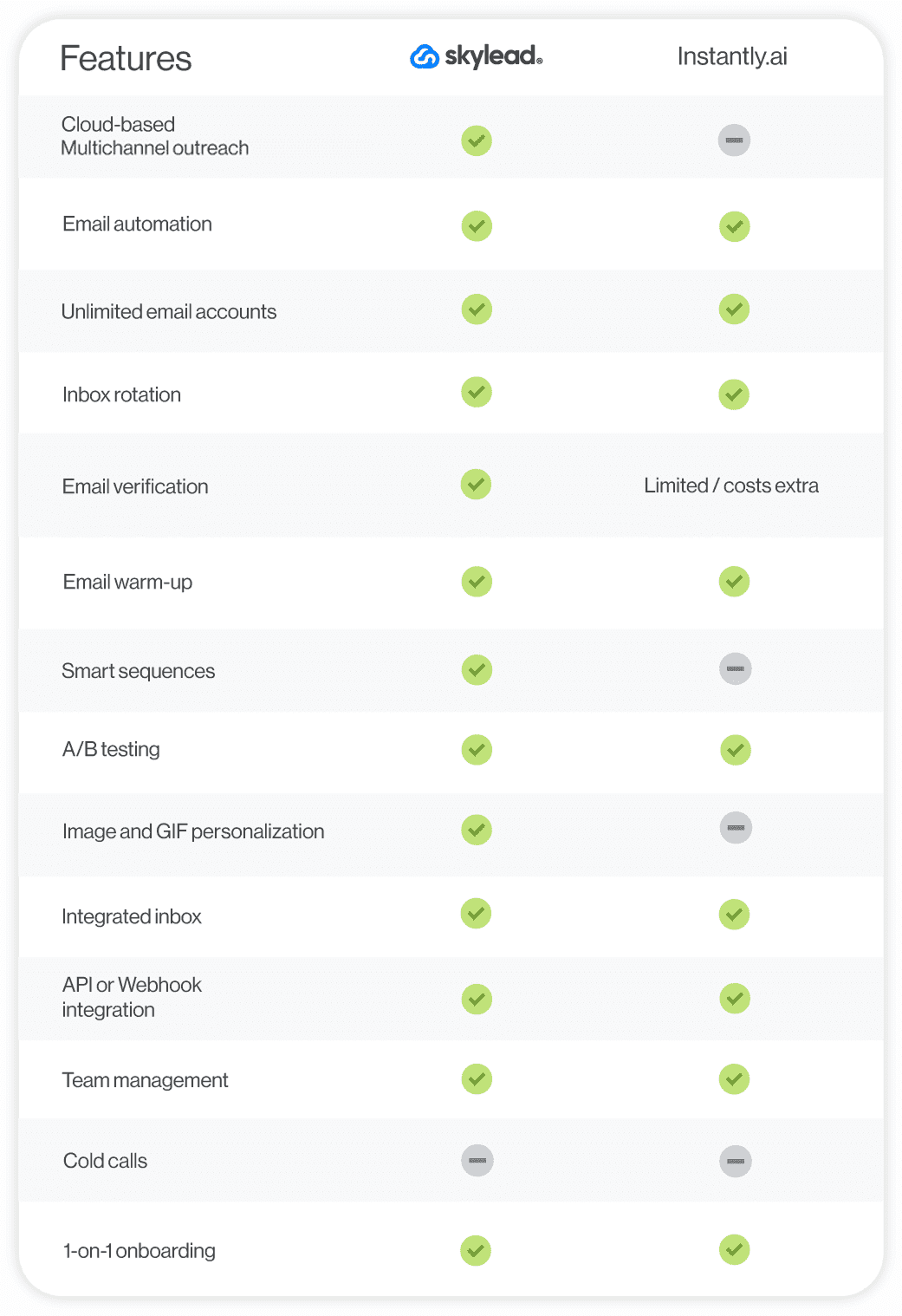
Pricing
Skylead has a singular plan that costs $100 per seat. To test out the tool and its functionalities, feel free to take advantage of our 7-day free trial period. Moreover, our customer support remains available for a 1-on-1 onboarding call—completely free of charge!
2. Lemlist
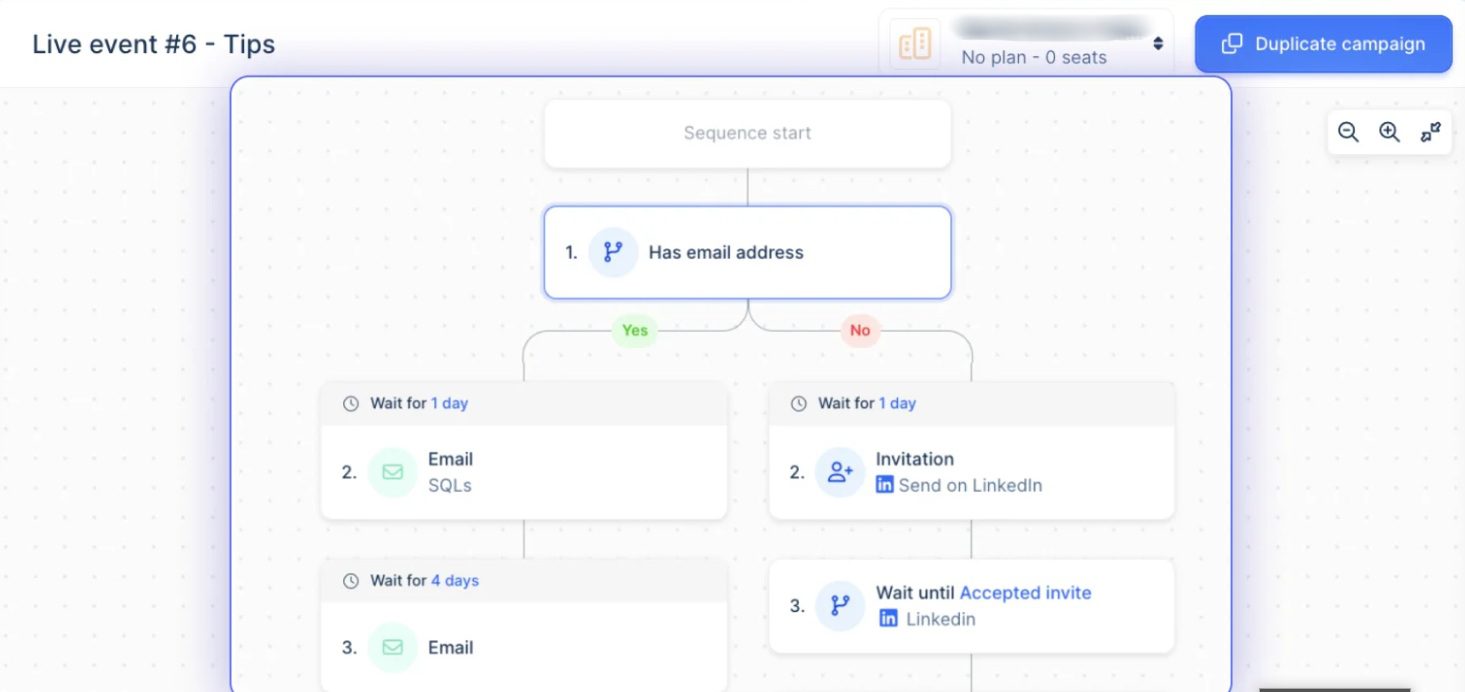
Lemlist is a cloud-based tool primarily used for email outreach. Nonetheless, its higher-tier subscription supports multichannel outreach, letting you add automatic LinkedIn actions and calls to the mix. That said, it may not comply with LinkedIn's ToS like Skylead does.
In terms of LinkedIn automation, the tool can visit your lead's profiles, invite them to connect, and send them a message. Moreover, you can add conditions to your sequences to cover several outreach scenarios.
You can also perform any other action on LinkedIn. However, you’ll need to add it as a manual step to your campaign, the same as calls.
The software offers advanced personalization features, including custom images, intro lines, and dynamic landing pages.
It's also known for Lemwarm, a built-in email warm-up tool that helps emails stay away from spam.
Now, even though Lemlist comes with an email finder and verifier, like Skylead and Instantly.ai, it limits the number of emails you can discover and verify by plan. In fact, even with their most expensive plan, you can only discover and verify up to 1,000 emails a month. If your needs exceed this, you can purchase additional credits. However, this comes at a cost of $1 per 100 verified emails.
That's not it for limitations, though. For instance, you can't connect unlimited email accounts to the tool. Moreover, although Lemlist offers a B2B lead database with over 450M contacts, the quality of leads isn't the highest.
This is somewhat compensated for with the Chrome extension for prospecting on LinkedIn. However, considering that Chrome extensions inject code into LinkedIn that may jeopardize your account, you might want to think twice before using it.
Instantly.ai vs. Lemlist
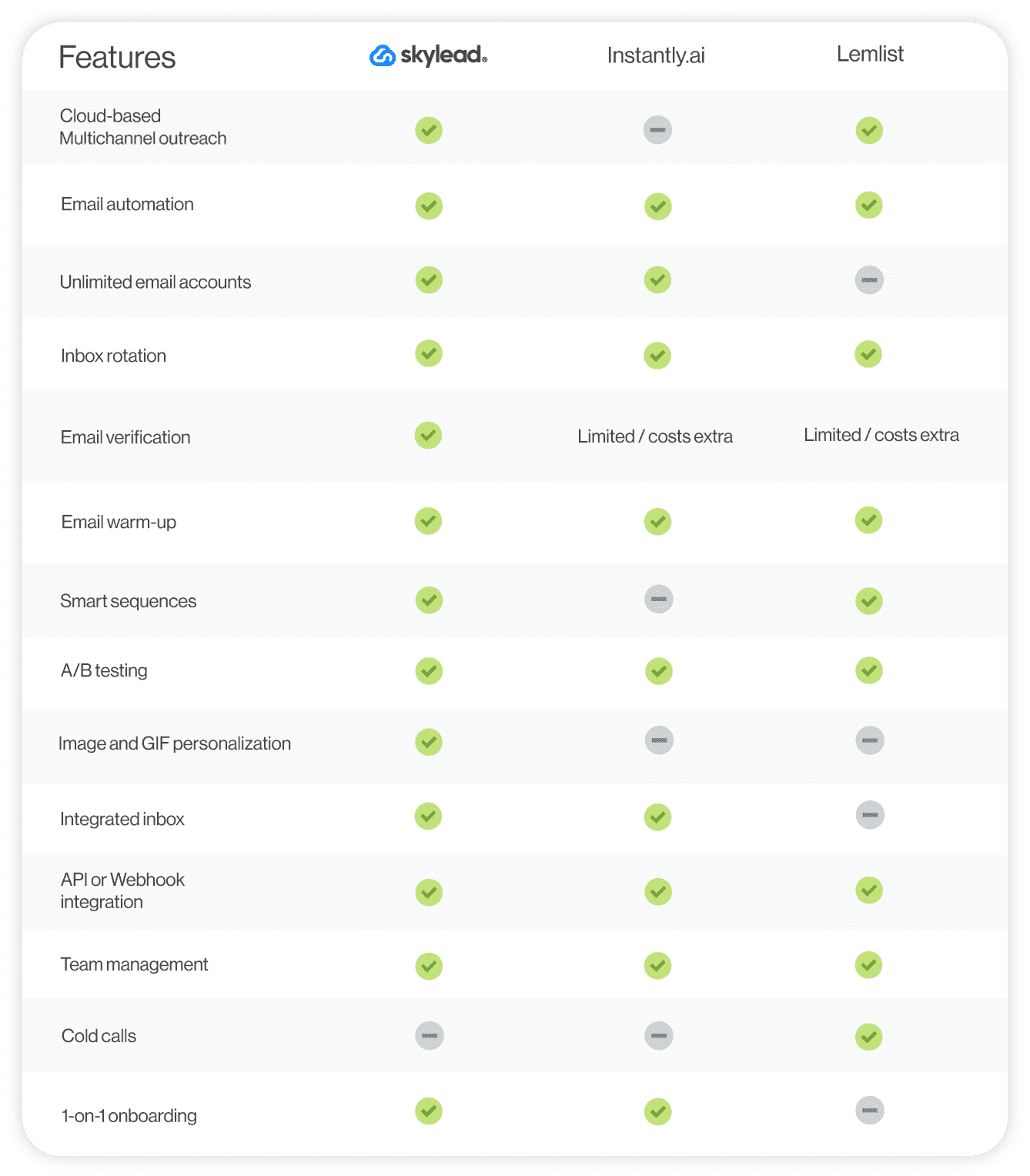
Pricing
| Email Starter | $39/mo per user with 1 sending email address |
| Email Pro | $69/mo per user with 3 sending email addresses |
| Multichannel Expert | $99/mo per user with 5 sending email addresses |
| Outreach Scale | $159/mo per user with 15 sending email addresses |
| Outbound agency | Contact sales for pricing details |
3. Apollo

Apollo.io is a multichannel sales engagement platform that combines email, LinkedIn outreach, and cold calls in seamless sequences.
It allows users to set up campaigns that feature both automatic and manual emails.
When engaging leads via LinkedIn, Apollo can automate connection requests, messages, and interactions with posts.
However, its multichannel sequences—known as Playbooks—are relatively simple. Namely, unlike Skylead's Smart sequences, they don't unfold according to your lead's behavior, making them less than ideal.
Regarding integrations, the platform natively integrates with tools like Pipedrive, HubSpot, and Slack.
The software also has A/B testing capabilities, which help optimize outreach efforts. Additionally, it comes with a built-in AI writing assistant that those previously using ChatGPT for sales writing may find convenient.
Now, in terms of pulling leads into a campaign, Apollo does it through its databases of over 275M contacts. However, certain users have complained about the quality of these leads.
Like Lemlist, the platform can also scrape new leads from LinkedIn. However, this process, yet again, involves using a Chrome extension and could lead to account penalties. This means that the tool is not compliant with LinkedIn's ToS.
Instantly.ai vs. Apollo
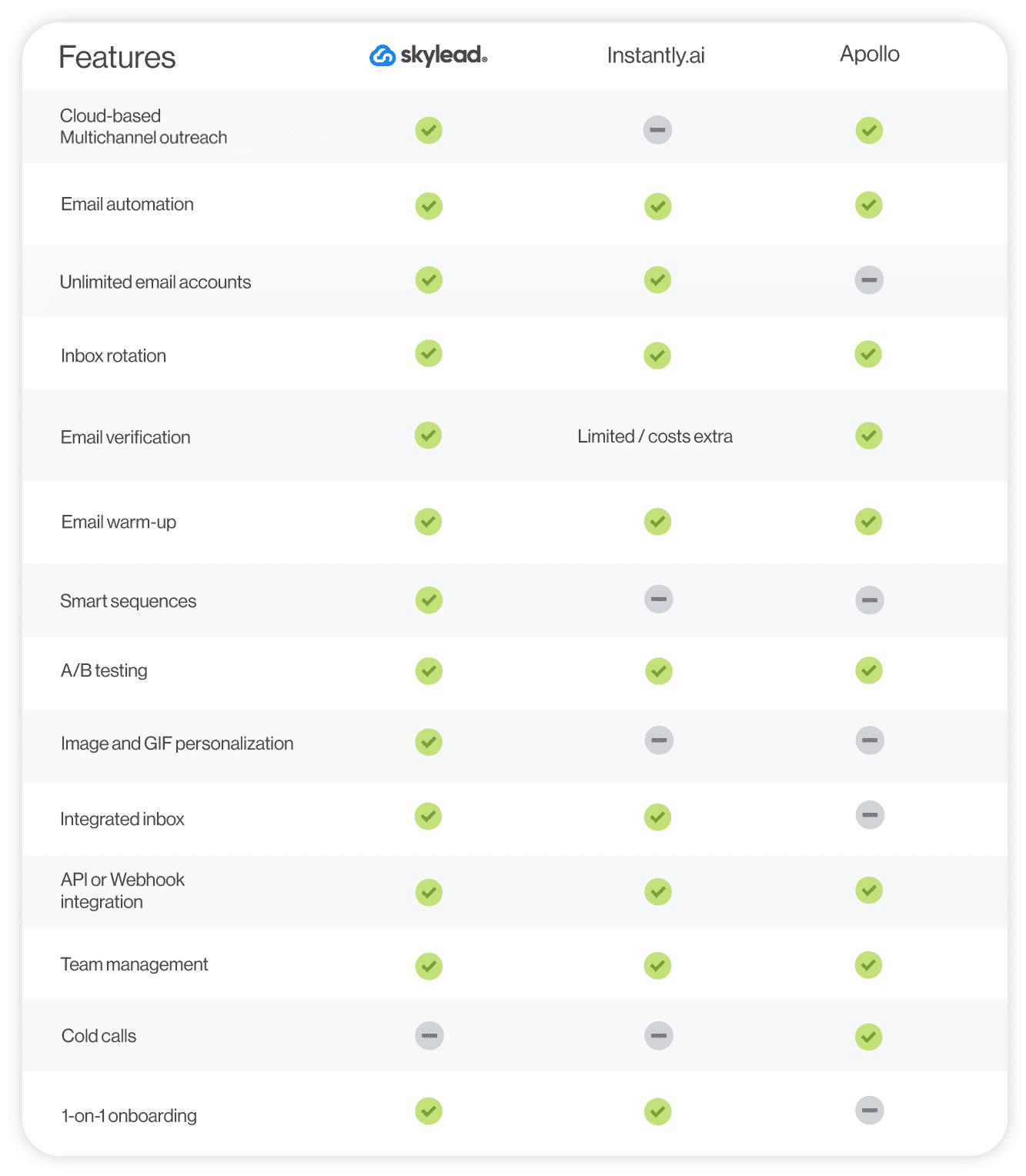
Pricing
| Free | $0/mo per user with 1 email account / 2 sequences |
| Basic | $59/mo per user with 1 email account / Unlimited sequences |
| Professional | $99/mo per user with 5 email accounts / Unlimited sequences |
| Organization | $149/mo per user with 15 email accounts / Unlimited sequences (minimum 3 users / billed annually) |
4. Smartlead.ai
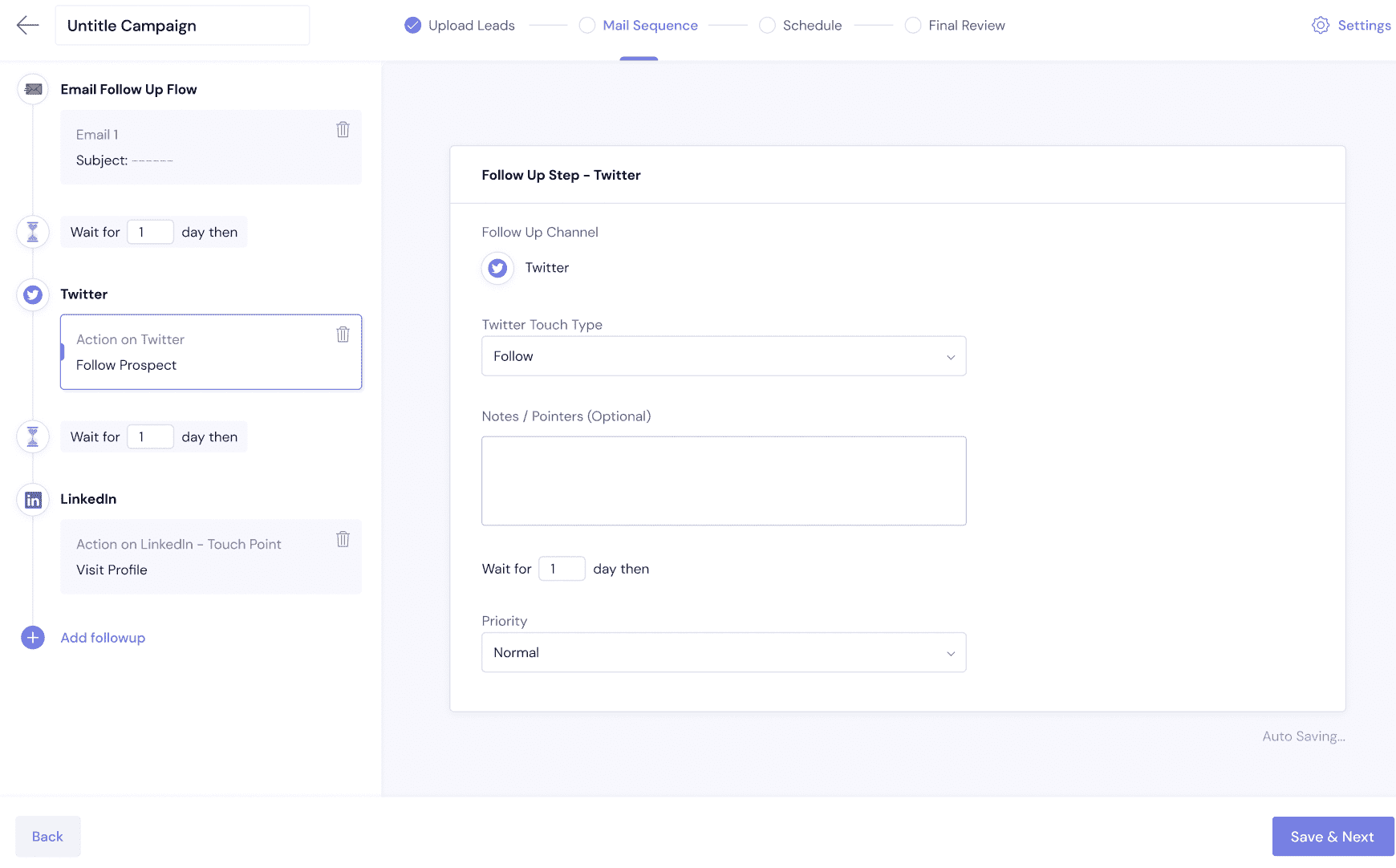
Smartlead is a robust email outreach tool designed to automate and streamline lead generation efforts.
It supports unlimited email accounts and email warmups, features inbox rotation, and uses a Master Inbox for streamlined email management.
The platform offers advanced personalization options like variables, spintax, and liquid syntax, along with split testing capabilities for up to 26 email variants.
Smartlead also integrates with various CRMs, including HubSpot, via API and webhooks.
However, it has some drawbacks.
Additionally, it lacks image and GIF personalization and an email discovery feature that Skylead has.
Finally, while you can create subsequences for each campaign to make it reactive to your leads' behavior, you must break the campaign creation flow to do so. Not to mention, you can only add leads to your campaign through a CSV file or HubSpot.
Instantly.ai vs. Smartlead.ai
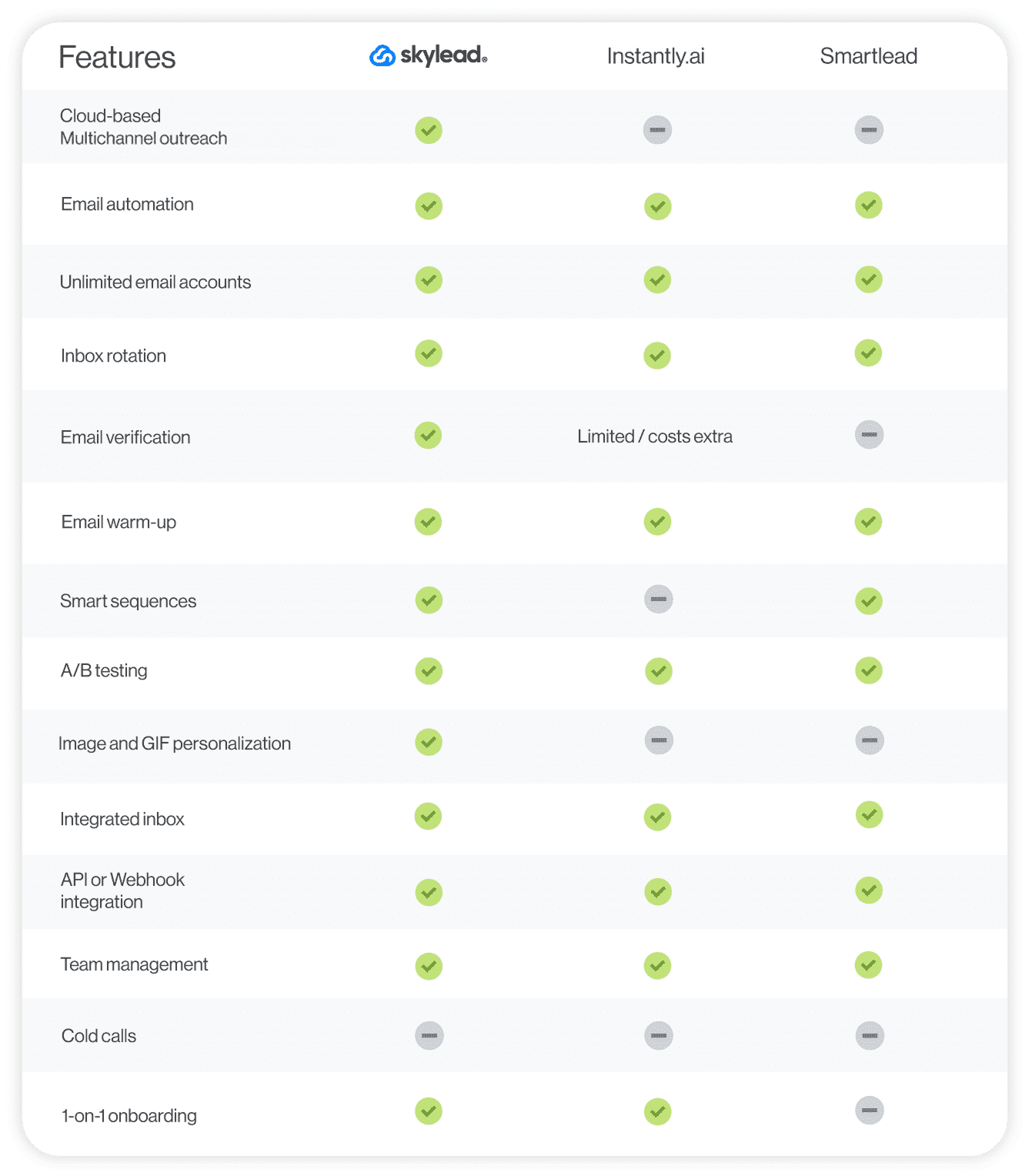
Pricing
| Basic | $39/mo per account with 2,000 active leads |
| Pro | $94/mo per account with 30,000 active leads |
| Custom | starting at $174/mo per account with up to 12M active leads |
Pro and Custom plans support adding additional seats, with each costing $29 a month.
5. Mailshake
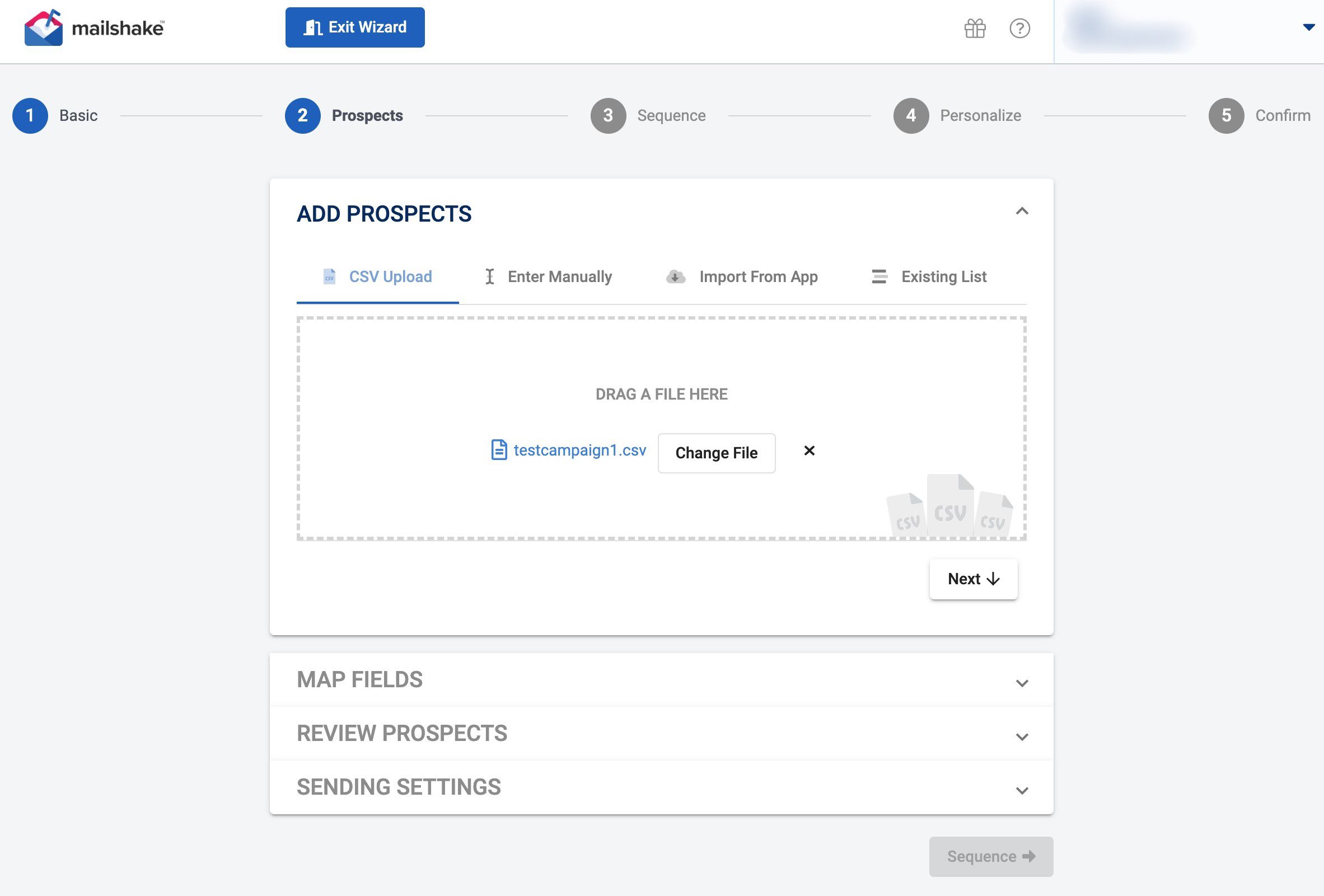
Mailshake is a cloud-based tool designed primarily for sending emails and follow-ups.
Nonetheless, it does have a Chrome extension that transforms it into a multichannel outreach and may violate LinkedIn's ToS. You can use to set up simple outreach sequences to automatically:
- View your leads' profiles on LinkedIn,
- Send them invites to connect,
- And messages.
At the same time, you can use the extension for cold-calling purposes, as it comes with a built-in dialer and call recorder. However, this option is available strictly for leads based in the US and Canada.
Moreover, you can integrate the tool with more than 1,000 software via Zapier webhooks. In terms of native integrations, there are those with Pipedrive and Hubspot.
A/B testing is supported, too, and so is inbox rotation. Unfortunately, you can't connect unlimited email accounts to Mailshake as you can with Skylead and Instantly.ai. In fact, the highest-tier subscription limits you to a maximum of 5 accounts.
LinkedIn automation and calls are restricted to the highest-tier plan, too.
Lastly, the use of a Chrome extension for LinkedIn actions risks account restrictions.
Instantly.ai vs. Mailshake
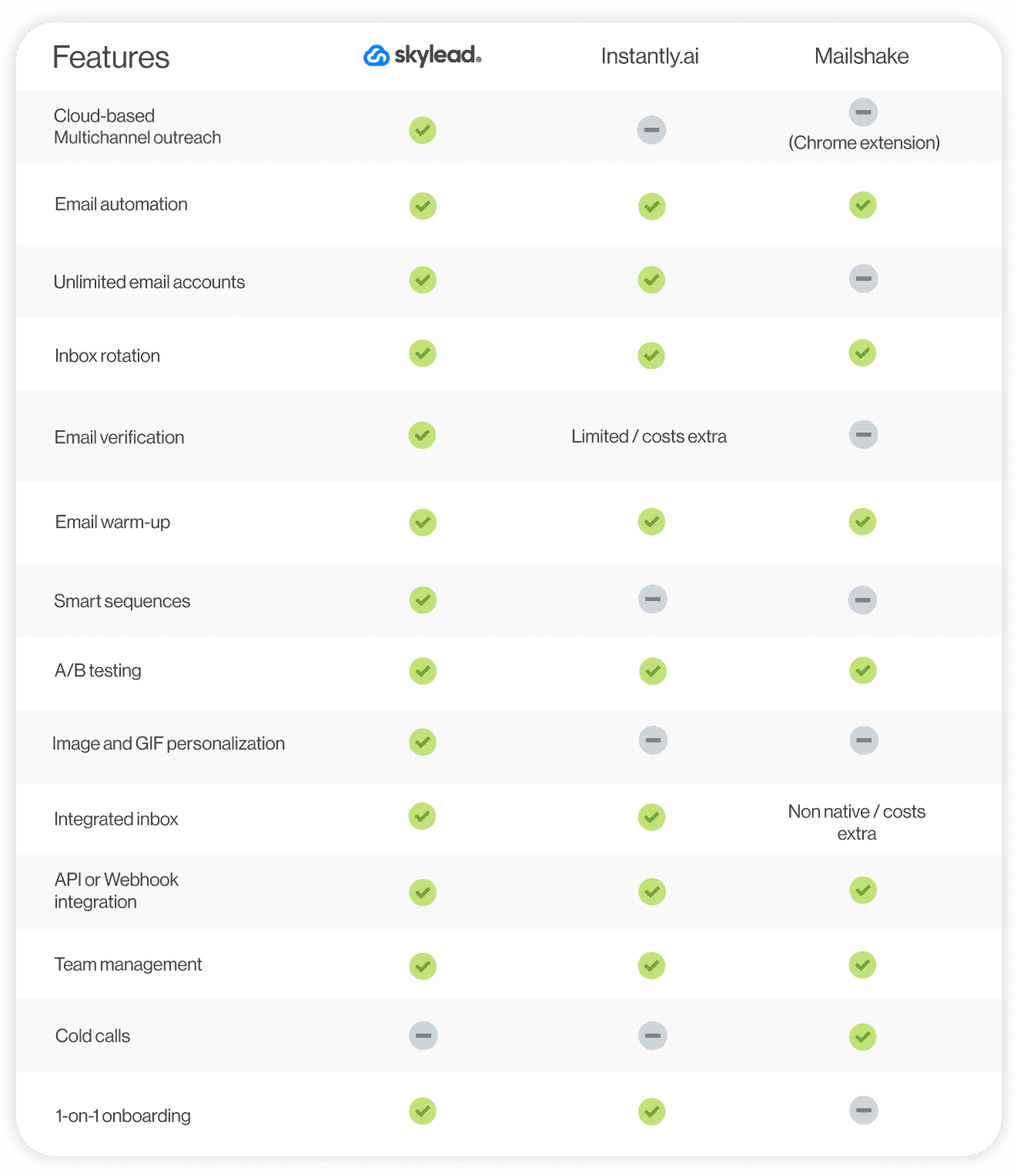
Pricing
| Starter | $29/mo per user with 1 sending email address |
| Email Outreach | $59/mo per user with 2 sending email addresses |
| Sales Engagement | $99/mo per user with 5 sending email addresses |
6. Woodpecker
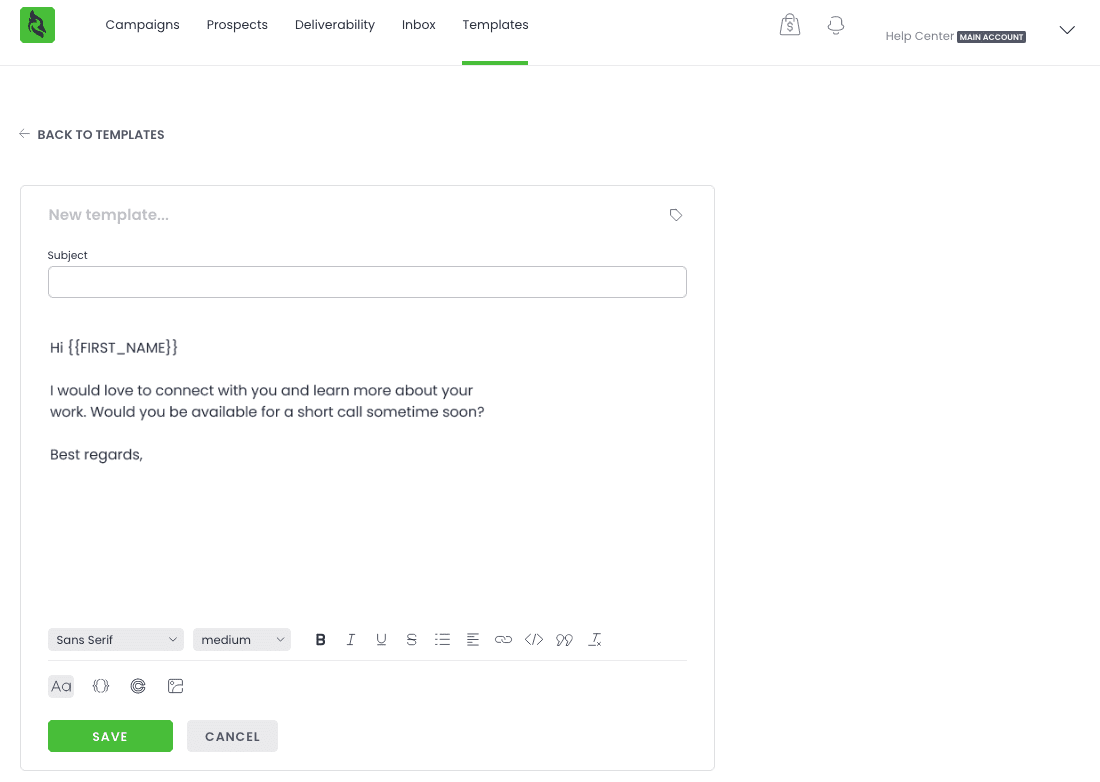
Woodpecker is a tool that automates emails and follow-ups to help individuals connect with ideal clients.
What's great about it is that it lets you connect as many email accounts to it as you want, just as Skylead, Instantly.ai, and Smartlead do. The same can be said about inbox rotation.
Sequences you can create with Woodpecker are condition-based. This means they adapt according to the way your leads behave.
With Woodpecker, you can A/B test up to 5 different variations of your message copy. And if you have trouble writing, its AI writing assistant is there to help.
Moreover, the tool supports plenty of 3rd party integrations, such as the one with Dux-Soup. This integration allows its users to tap into LinkedIn outreach, not just email, but it will cost you more.
That said, not everything's ideal with this tool.
Why, yes, the Dux-Soup integration turns Woodpecker into a multichannel outreach solution. The catch is, however, that they must subscribe to Dux-Soup’s Turbo plan for this to be made possible. This raises the cost of a subscription that's already steep and depends heavily on the number of contacted prospects.
Instantly.ai vs. Woodpecker
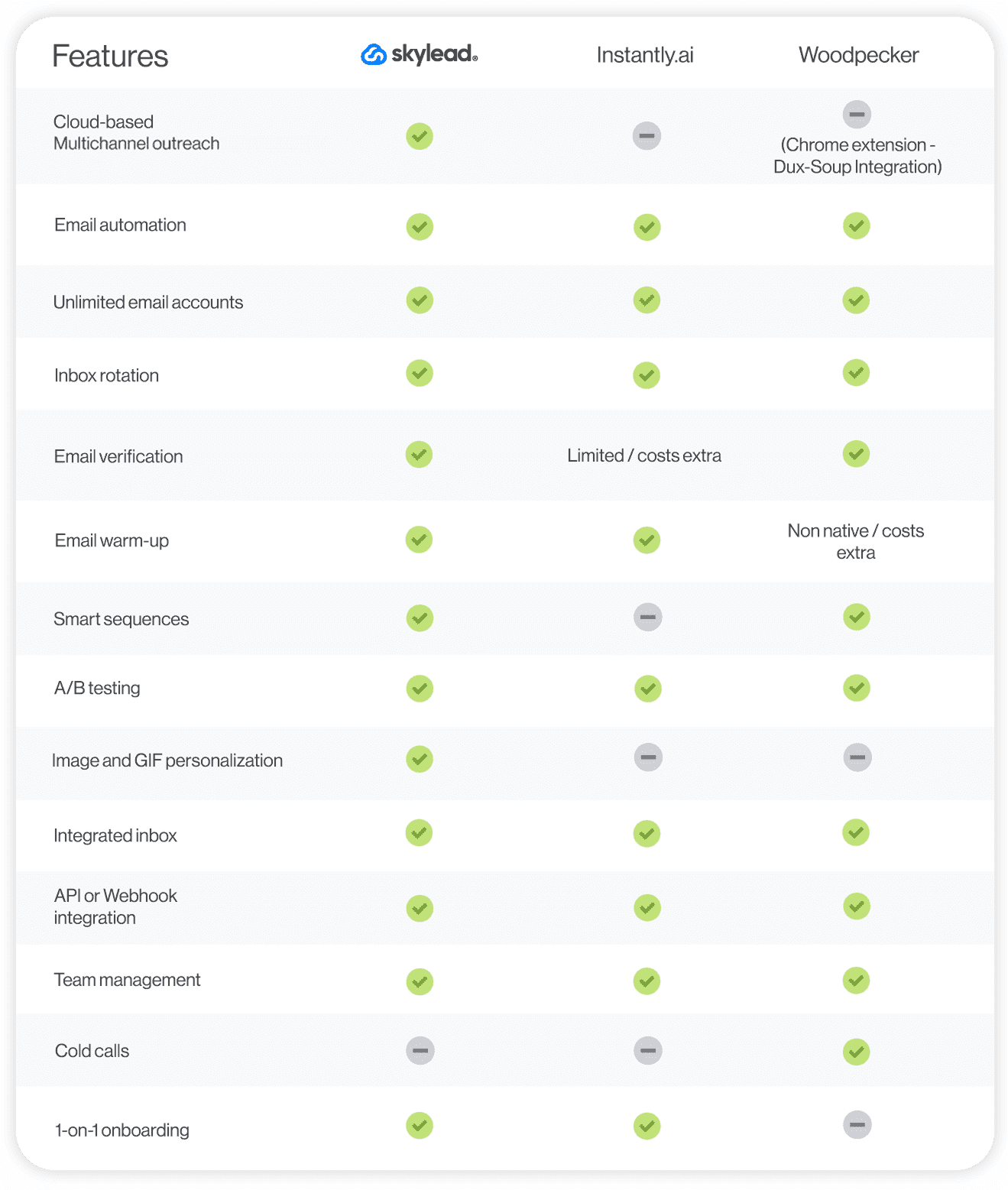
Pricing
| Cold Email | Starting at $29/mo per user |
| Agency | Starting at $29/mo per user |
| Custom | Contact sales for pricing details |
The exact cost of the Cold Email and Agency plan is determined by the number of leads contacted. It ranges between $29 for 500 contacted leads and $395 a month for 25,000.
Although price points for these plans are the same, they differ in one thing: the Cold Email plan is designed for individuals, whereas the Agency plan is meant to be used by teams. That said, the latter supports adding additional users at the price of $27 per each.
Additionally, the Dux-Soup integration adds an extra $55 a month to the subscription.
7. Salesloft
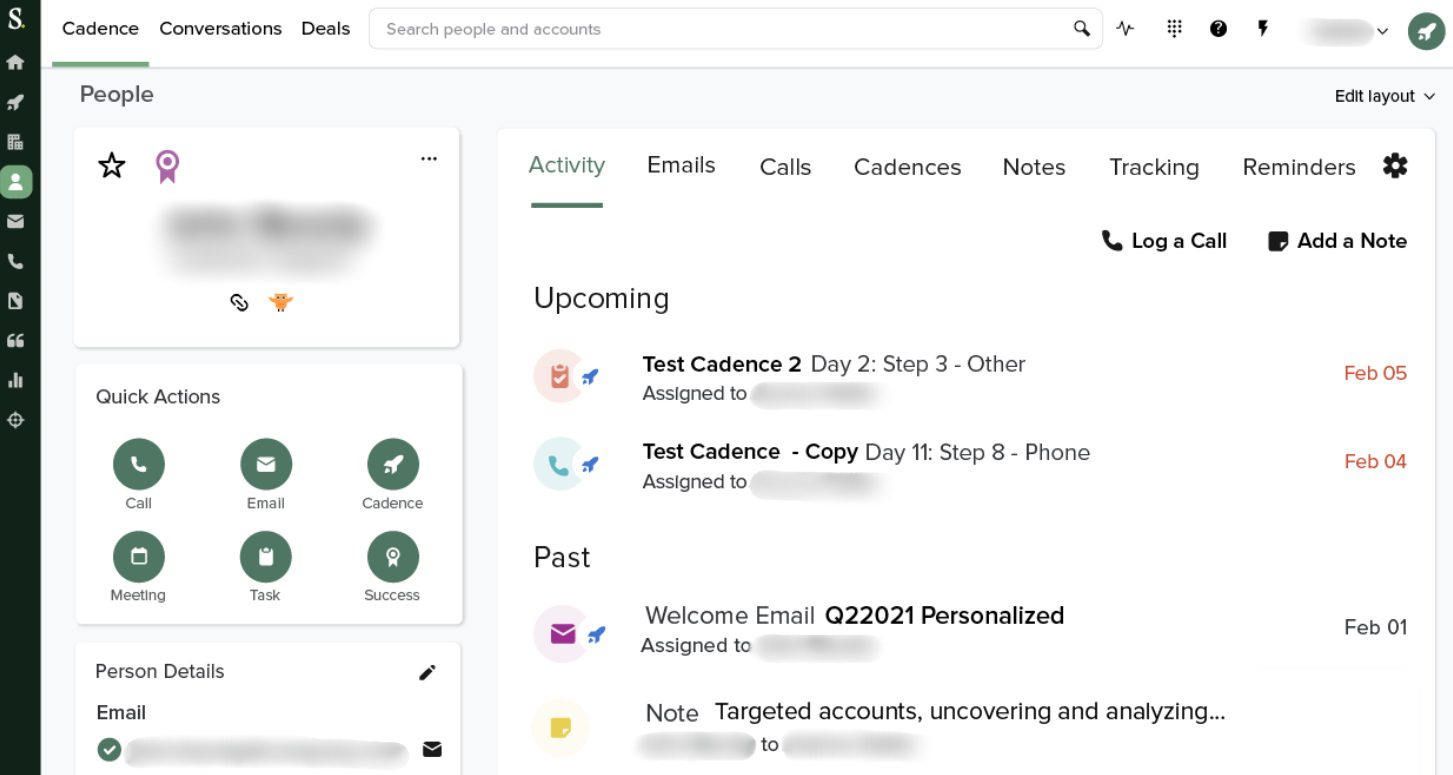
Salesloft is a cloud-based sales engagement platform ideal for sales teams that want to automate workflows and connect with more prospects.
Its Cadences—a form of campaign—integrate email, phone, and Sales Navigator tasks, though only emails are automated.
Nonetheless, the platform shines in email tracking and advanced analytics, offering A/B testing and customizable email templates.
However, Salesloft only integrates with Sales Navigator, missing support for LinkedIn Premium and Recruiter accounts.
Additionally, it lacks the Smart sequences that Skylead has, which limits touchpoints with leads.
Users have also complained about a less user-friendly interface and a buggy dialer.
Instantly.ai vs. Salesloft
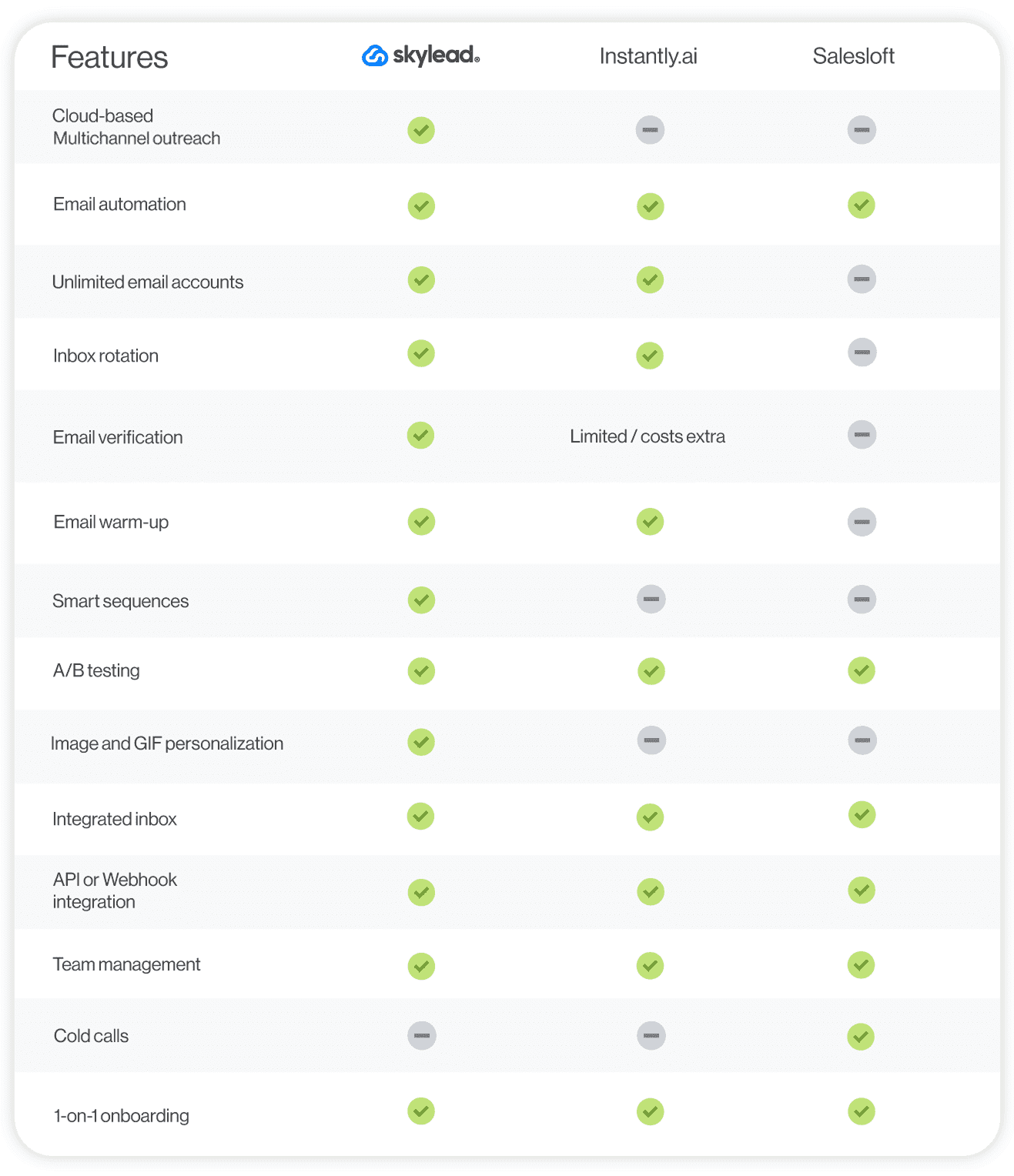
Pricing
At this time, Salesloft doesn’t disclose its pricing details for either of its plans: Essentials, Advanced & Premier. Instead, upon visiting the "Pricing" page, their bot prompts you to contact their team for a tailored quote.
However, the information on the Internet suggests that users are paying anywhere from $75 to $125 per user a month.
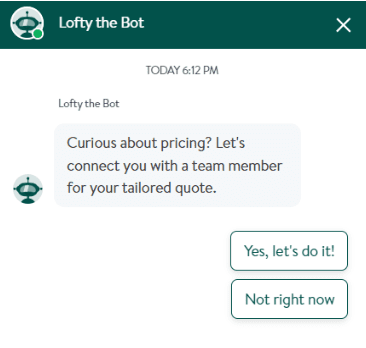
8. Outreach.io
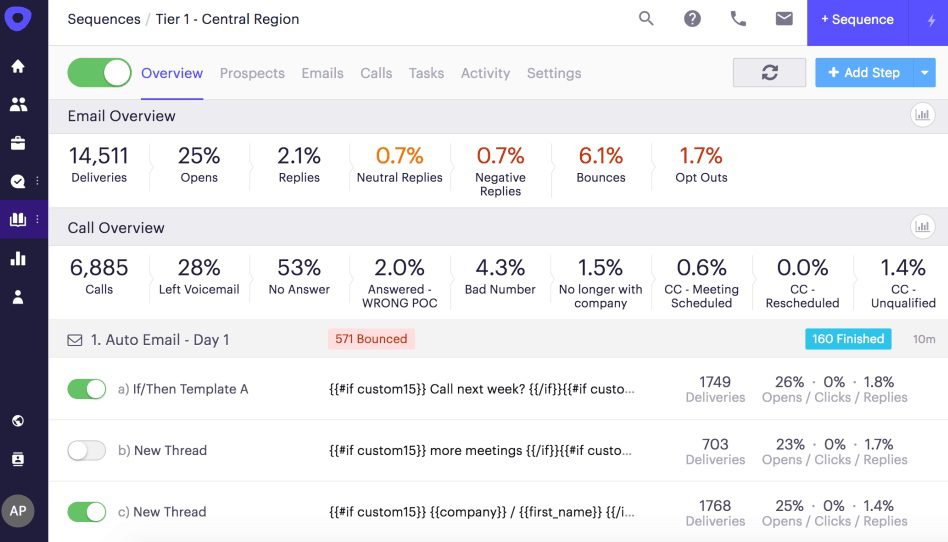
Outreach.io is a complete sales engagement platform designed to streamline the sales process for enterprise teams.
It integrates email, phone, LinkedIn, and live chat into a unified workflow, allowing for seamless multichannel outreach.
The platform lets you create personalized outreach sequences with automated follow-ups and response-based triggers. However, any actions on LinkedIn that are part of your sequences must be completed manually which means they are compliant with LinkedIn's ToS.
The tool integrates well with popular CRMs like Salesforce and HubSpot for smooth data synchronization.
Key features include robust email tracking, detailed analytics, A/B testing, and a library of customizable email templates.
Outreach.io also provides AI-driven sentiment analysis, call scheduling, and a pipeline calculator to estimate necessary sales expenses.
Its conversation intelligence tool, Kaia, offers real-time call transcription and insights, enhancing sales interactions and coaching.
In terms of cons, it's worth noting that the platform can be expensive for small businesses. Furthermore, no free trial is available, and the interface is complex.
Also, the platform connects to Sales Navigator accounts only and caters primarily to sales professionals. As such, it may lack features that marketing experts and lead generation agencies need, such as email discovery and verification.
Lastly, users can connect a maximum of 2 email accounts to the tool unless otherwise outlined in the contract.
Instantly.ai vs. Outreach.io
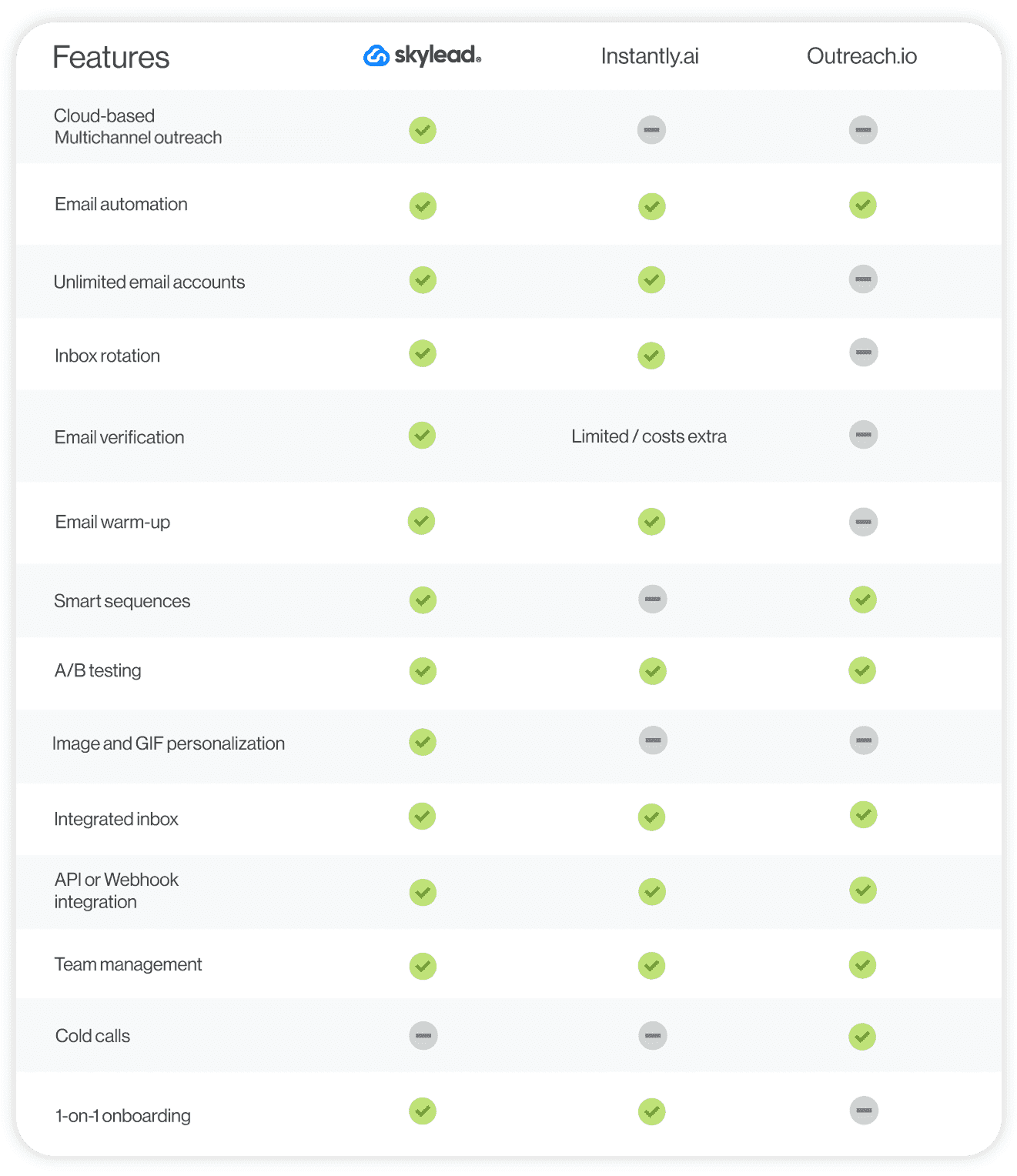
Pricing
Much like Salesloft, Outreach.io doesn’t disclose pricing details to non-users. Instead, the price is customized and heavily depends on the number of users within a team.
However, we did some research online and found that one user was quoted $130 per month per user, with a minimum requirement of 20 users.
9. QuickMail
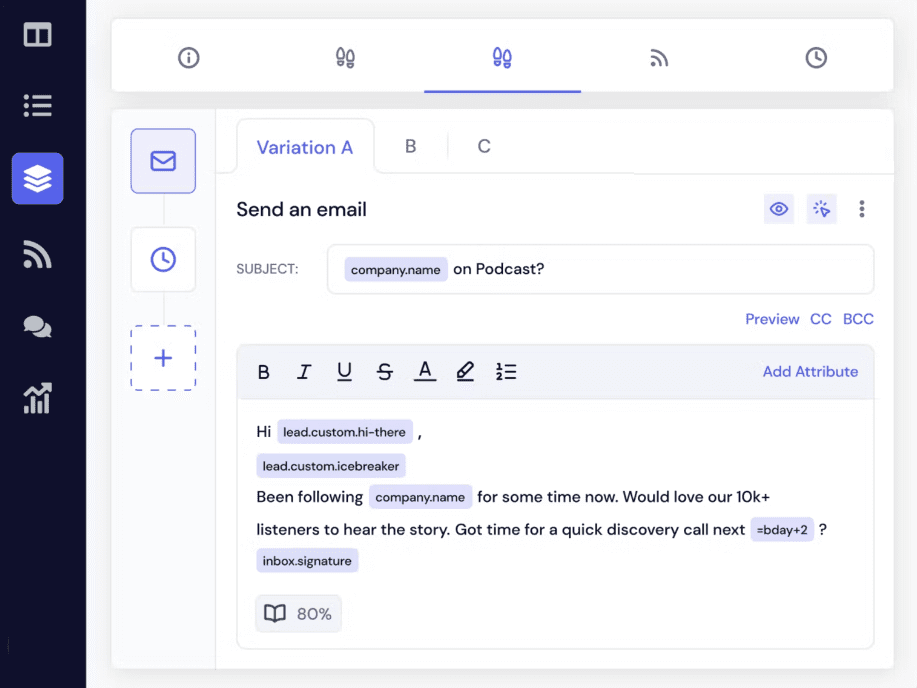
QuickMail is an effective outreach tool that goes beyond email campaigns.
It supports multichannel outreach, combining email, LinkedIn, calls, and SMS to help you reach your prospects where they are.
Linked outreach actions that QuickMail can perform are automatic and include:
- Profile views
- Connection requests
- Messages
This means that they are not compliant with LinkedIn ToS like Skylead is. Contrary to tools like Skylead, which lets you import leads directly from LinkedIn, QuickMail offers 2 import options: a CSV file or Google Drive.
The tool comes with a built-in email warm-up and an inbox rotation feature that maintains high deliverability rates. It supports A/B testing and natively integrates with popular CRMs like Pipedrive and HubSpot. Nonetheless, you can integrate any tool with it via Zapier.
While email verification is available, QuickMail relies on 3rd party tools for this.
Similarly, Image and GIF personalization, while there, isn't native. For this, you’ll need Hyperise, which incurs additional costs.
Moreover, if you want to use LinkedIn in your outreach, you'll need QuickMail’s Chrome extension, which can put your account at risk.
You can add unlimited team members to your QuickMail account. However, you can connect a maximum of 50 email accounts and 15 LinkedIn accounts to the tool. And this is for the highest-tier subscription.
Instantly.ai vs. QuickMail
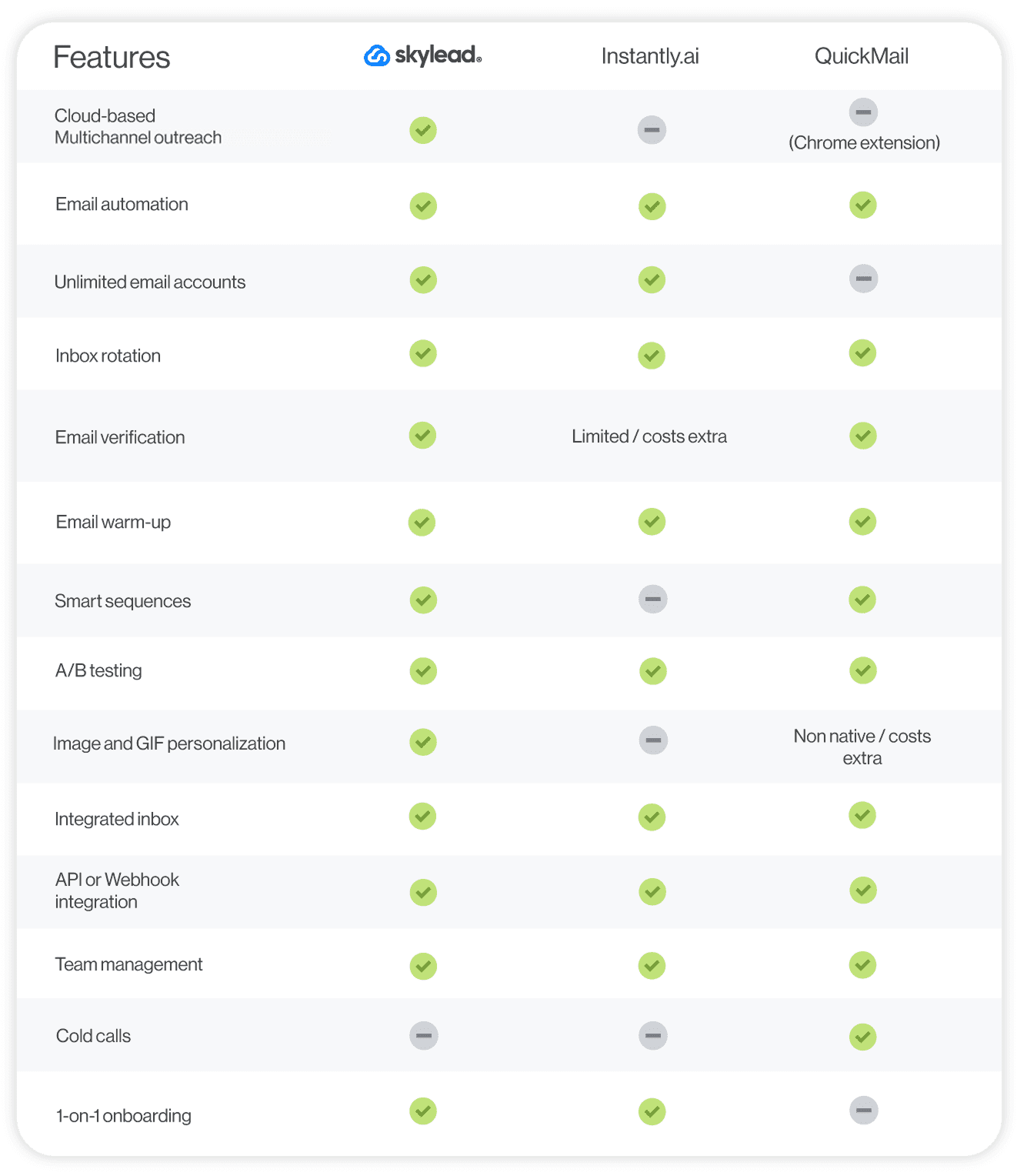
Pricing
| Basic Plan | $49/mo for 1 LinkedIn account and 5 email addresses |
| Pro Plan | $89/mo for 5 LinkedIn accounts and 20 email addresses |
| Expert Plan | $129/mo for 15 LinkedIn accounts and 50 email addresses |
10. Snov.io
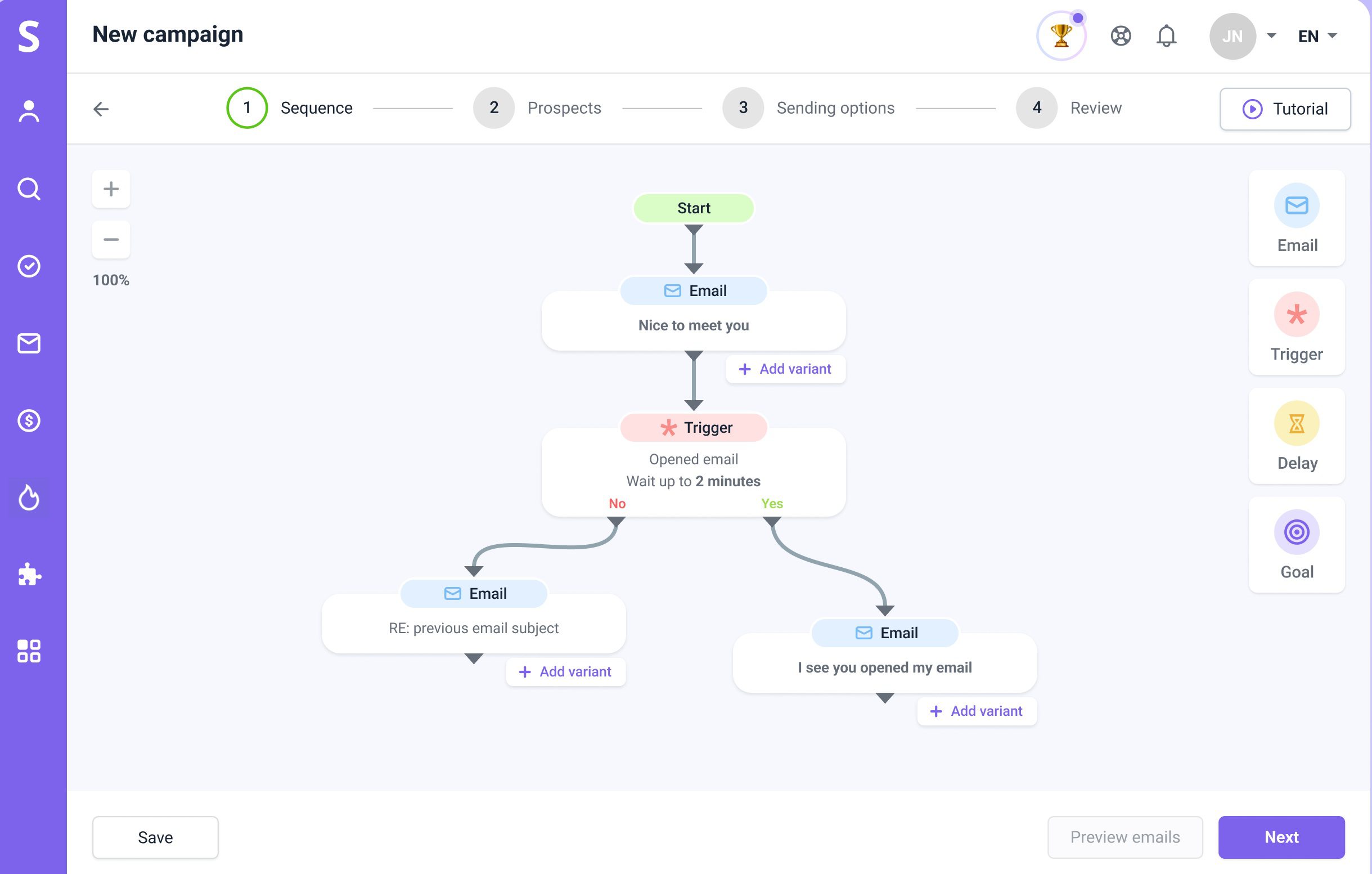
Snov.io is a cloud-based multichannel outreach tool that lets you create automated campaigns that combine emails and LinkedIn touches. These include profile visits, post likes, messages, and connection invites.
The platform lets you add "triggers" to your sequences, similar to Skylead's if/else conditions. These make your outreach smart and adaptable based on how your prospects react.
Additionally, Snov.io comes with a built-in email warm-up tool and a CRM. While the CRM isn’t the most advanced, it has enough functionality to be a good choice for those on a budget.
Snov.io can verify your leads' emails, but this feature isn’t unlimited. In fact, the number of emails you can verify depends on your plan.
Furthermore, for LinkedIn automation, you’ll need to pay an extra $69 per LinkedIn account you want to add to the software.
While Snov.io's LinkedIn automation is cloud-based, the tool prompts you to use their 2 Chrome extensions:
- One for prospecting on LinkedIn
- Another for finding leads' emails across the web.
However, if you choose to use them, be cautious: they may put your account at risk as this tool is not compliant with LinkedIn's ToS.
Instantly.ai vs. Snov.io
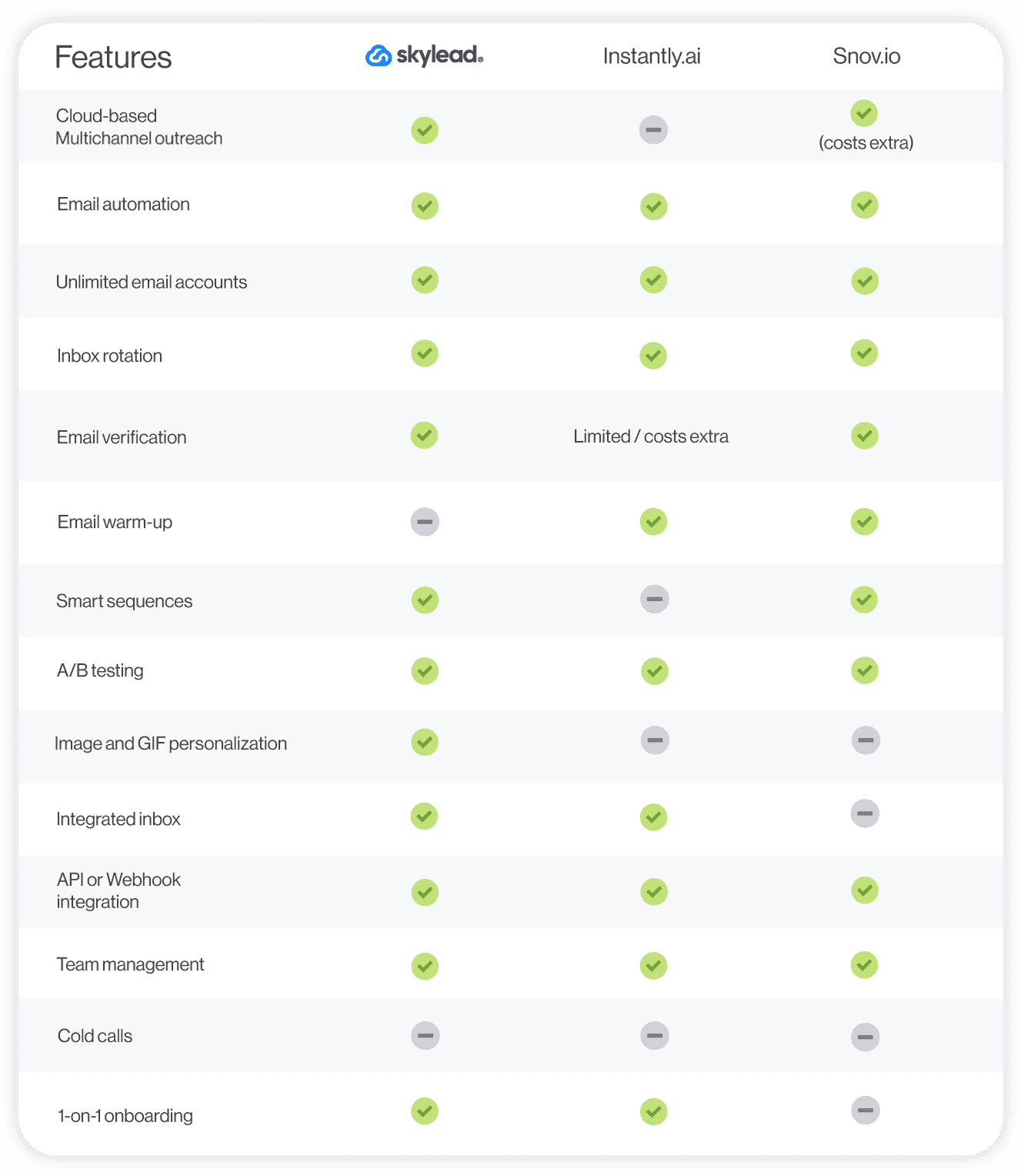
Pricing
| Starter | $39/mo per account | |
| Pro - has 4 sub-plans that differ in price based on the number of leads you can contact | Pro 5K | $99/mo per account |
| Pro 20K | $189/mo per account | |
| Pro 50K | $369/mo per account | |
| Pro 100K | $738/mo per account | |
| Managed Service | $3,999/mo per account | |
11. Salesblink
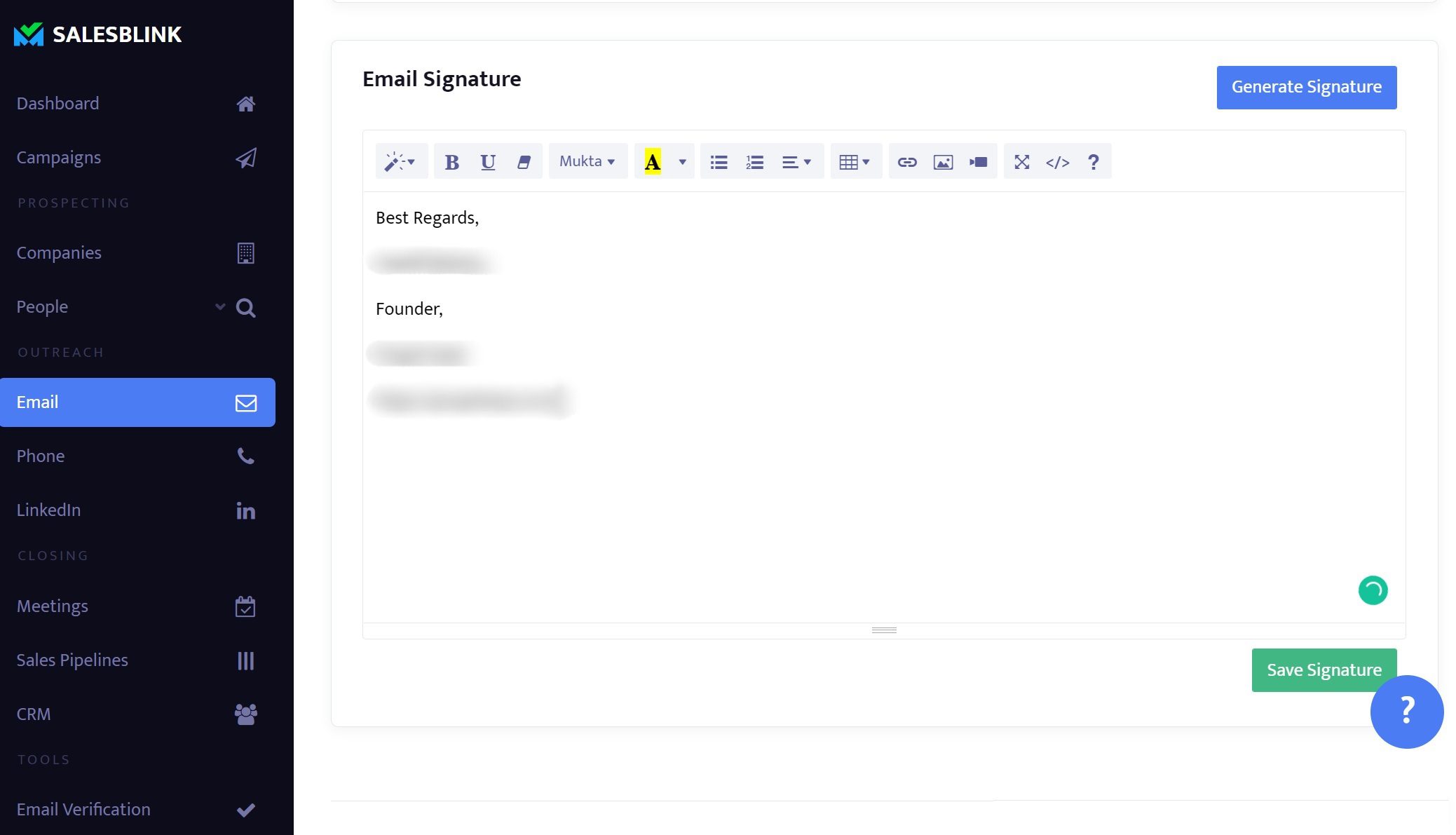
SalesBlink is one of the best Insantly.ai alternatives for cold emailing.
It uses its AI, BlinkGPT, to craft smart email sequences with follow-ups that adapt based on your leads' behavior.
Plus, with its email warm-up feature, your messages are more likely to land in your leads’ inboxes instead of their spam folders.
SalesBlink lets you connect unlimited email accounts and automatically rotates them while sending emails, thus keeping you within safe limits.
Furthermore, it comes with a Unified inbox that keeps all your conversations in one place, similar to Skylead, Instantly.ai, and Smartlead.
Although SalesBlink supports adding multichannel tasks to your sequences, these tasks need to be done manually making them complaint with LinkedIn's ToS.
The tool also provides email verification, but this feature is limited. Simultaneously, it isn't available to the subscribers to the lowest-tier plan.
Instantly.ai vs. Salesblink
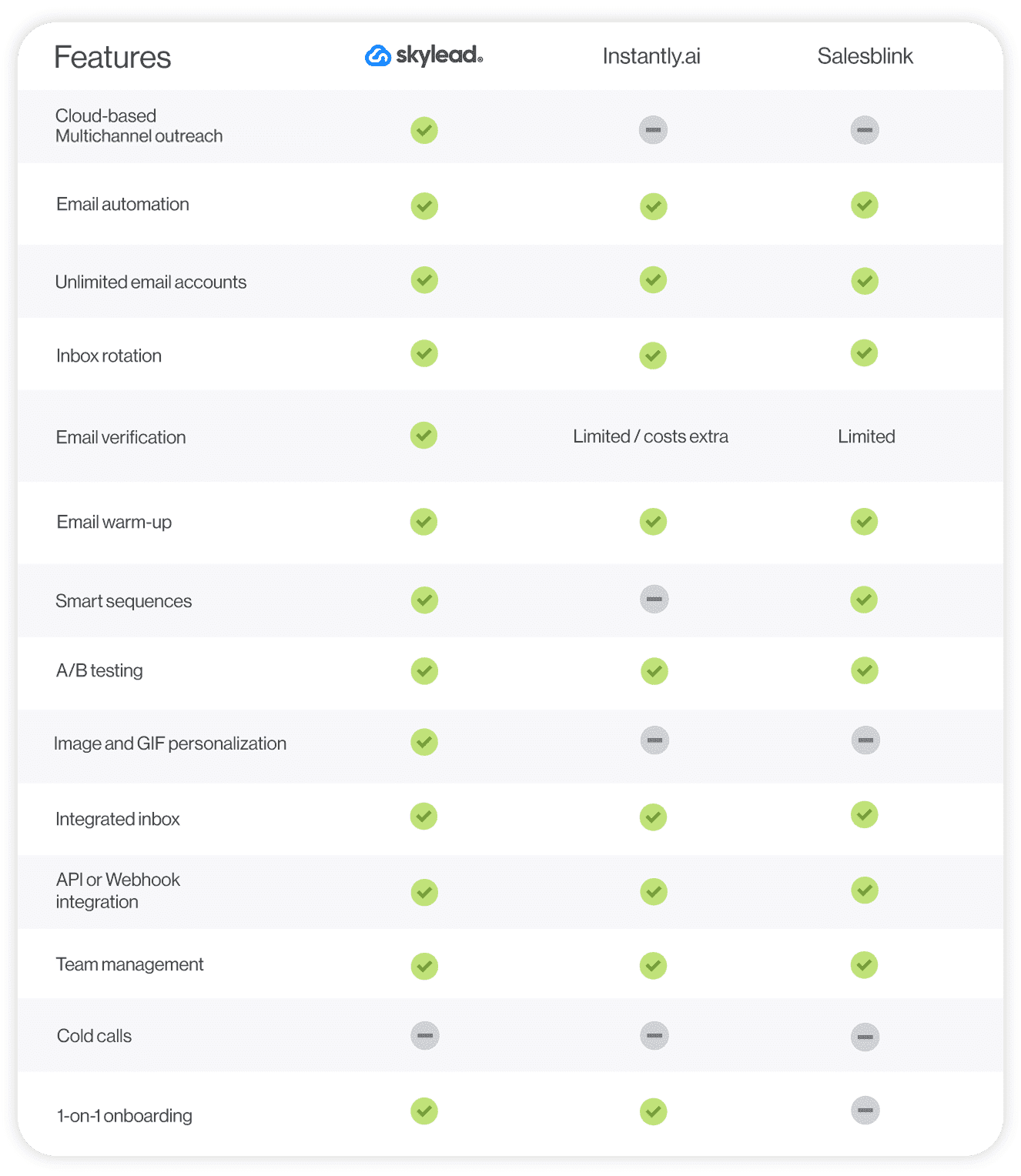
Pricing
The number of emails you can send with the software depends on your plan.
For example, the basic plan lets you send up to 6,000 emails, while the top tier allows up to 100,000.
| Scale | $29/mo per account |
| Growth | $99/mo per account |
| Business | $199/mo per account |
12. Hunter.io
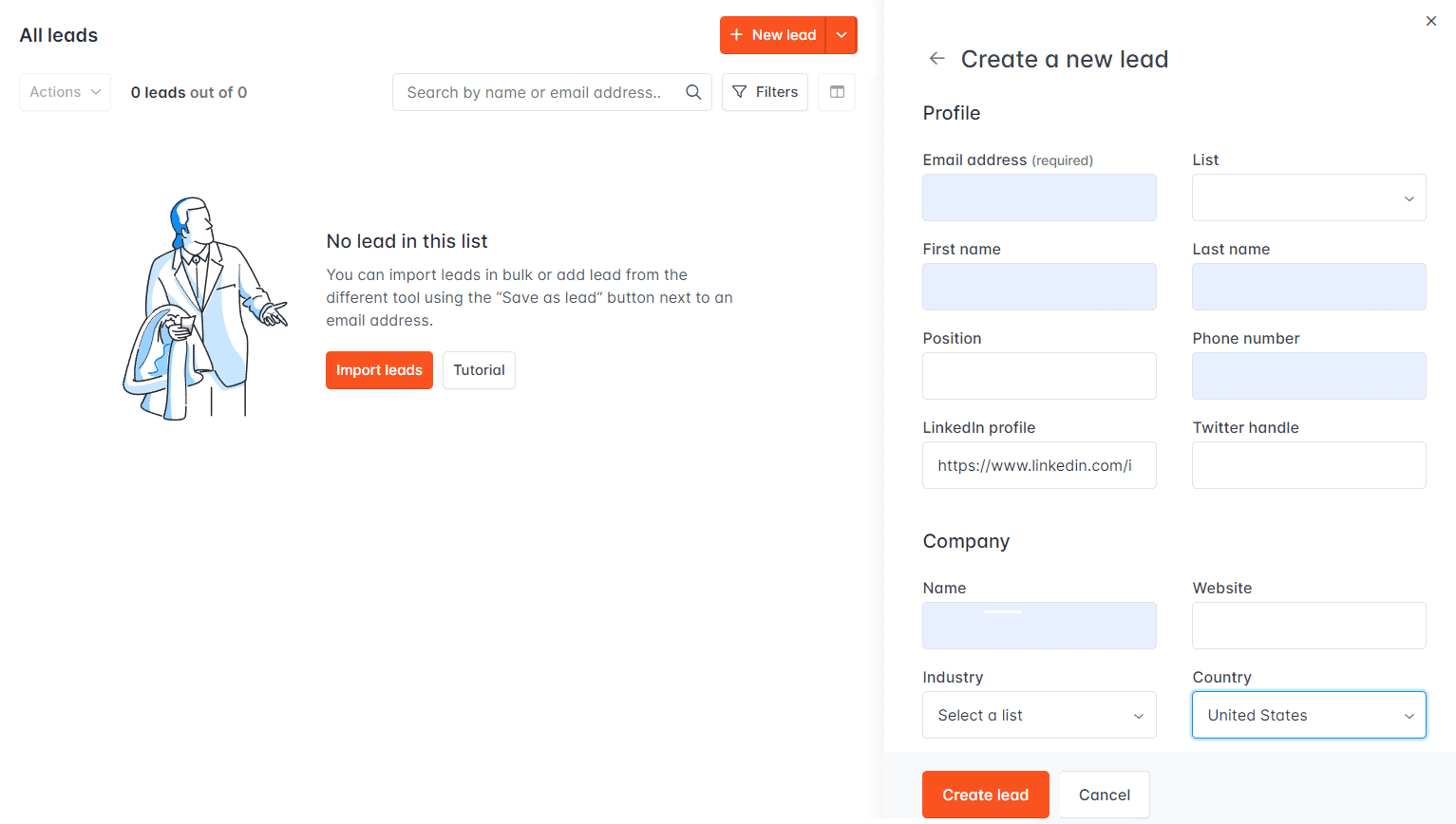
Hunter.io is a tool renowned for its email finding and verification capabilities.
It boasts a user-friendly interface and frequently updates its database with new publicly available emails.
One of its standout features is the ability to invite team members and grant role permissions, which makes team collaboration much easier.
Additionally, Hunter.io offers multiple cold email templates and supports integrations with various CRMs and software via Zapier.
However, there are some limitations. For example, you can only create outreach campaigns if you connect a Gmail or Outlook account. Other email service providers are not supported. It also lacks features like A/B testing, advanced message personalization, and email warm-up.
Furthermore, the tool requires a bit of a learning curve, and the support response time can be slow.
Instantly.ai vs. Hunter.io
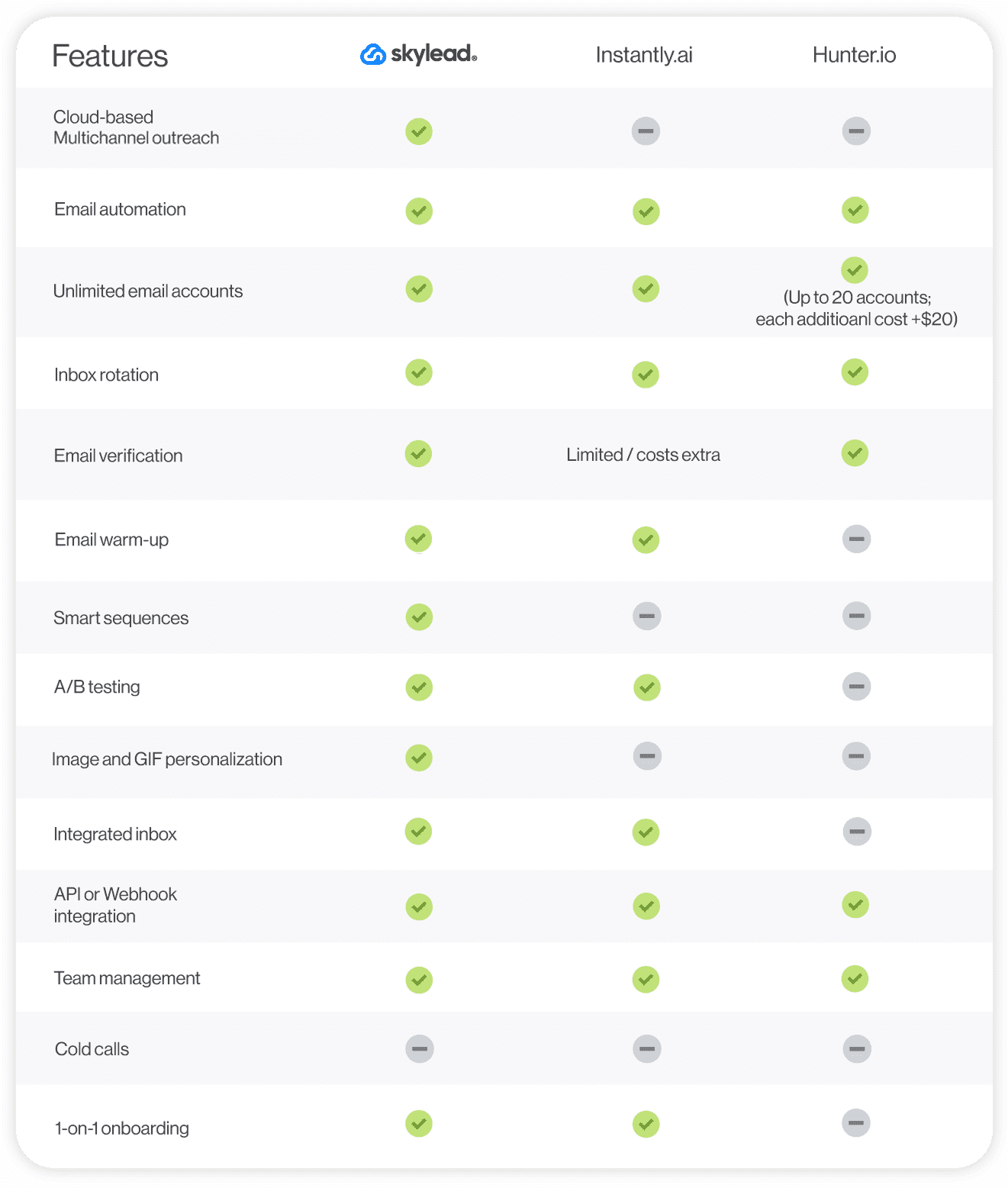
Pricing
| Free | 0€/mo per account with 1 sending email address |
| Starter | 49€/mo per account with 3 sending email addresses |
| Growth | 149€/mo per account with 10 sending email addresses |
| Business | 499€/mo per account with 20 sending email addresses |
| Enterprise plan | Contact sales for pricing details |
How to cancel Instantly.ai subscription?
If you’re not satisfied with Instantly.ai, you can cancel your subscription and try another tool from our list.
Here's how:
- Log into your account.
- Go to the Billing page.
- Under your active plan (s), find the "Cancel plan" button. Click it to confirm your cancellation.
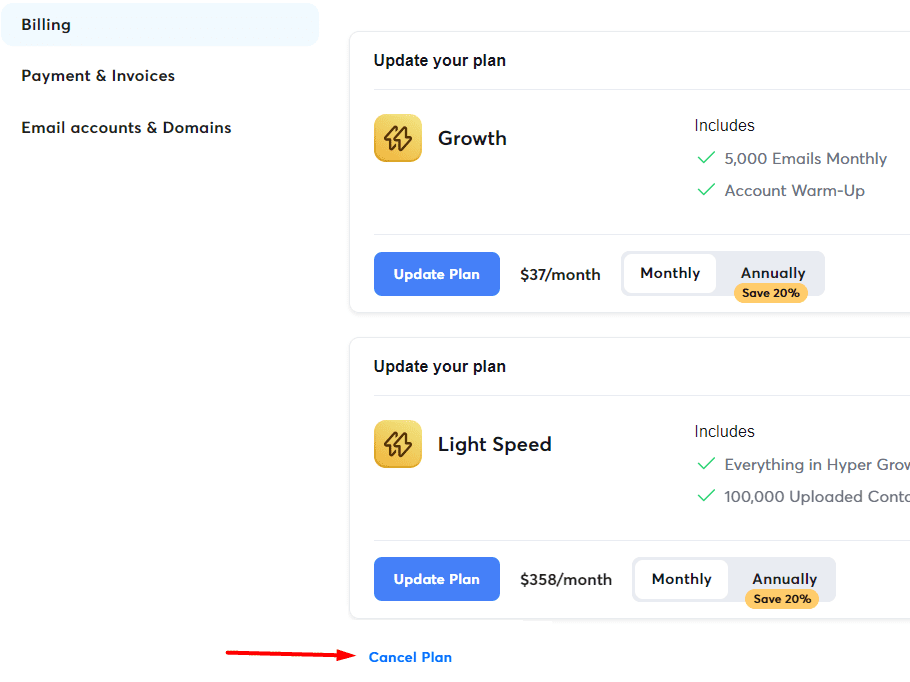
If you have one plan only, you can use it until the end of the billing cycle.
However, if you have both a Lead Finder and Email Outreach plan and cancel only one, the cancellation of said plan takes effect immediately.
Also, if you want to cancel multiple plans, keep in mind that you'll need to cancel each one individually.
Lastly, to confirm your plan is canceled, look at the date listed next to the plan on the Billings page.

Frequently asked questions (FAQs)
What is instantly.ai?
Instantly.ai is an advanced email automation tool designed to help individuals manage their email campaigns more effectively. It offers a range of features, including unlimited email accounts, email warm-up, B2B Lead Finder, and a Unibox.
What does instantly AI do?
Instantly.ai automates various aspects of cold emailing and customer relationship management. It helps users manage multiple email accounts, warm up emails to improve deliverability, find new leads, and keep track of them. The platform also consolidates all emails into a single inbox, making it easier to manage conversations and follow-ups.
How to use instantly.ai?
Using Instantly.ai is easy. Just create an account, add and configure email accounts, and use the email warm-up feature to prepare your accounts for sending. Then, create and launch your email campaigns and manage interactions through Unibox. Finally, use the tracking and analytics page to analyze campaign performance.
Is instantly.ai free?
Instantly.ai is not free but offers various pricing plans to suit different needs and budgets. Each plan provides access to a range of features, allowing you to choose the one that best fits your requirements.
Does Instantly AI have a free trial?
Yes, instantly.ai offers a free trial for new users. This allows you to test out the platform and its features before committing to a paid plan.
How many emails can you send with instantly AI?
The number of emails you can send per month depends on the plan. For instance, the lowest plan limits you to sending 5,000 a month, whereas the Custom plan allows you to send more than 500,000.
Instantly.ai vs. alternatives: What’s the better option?
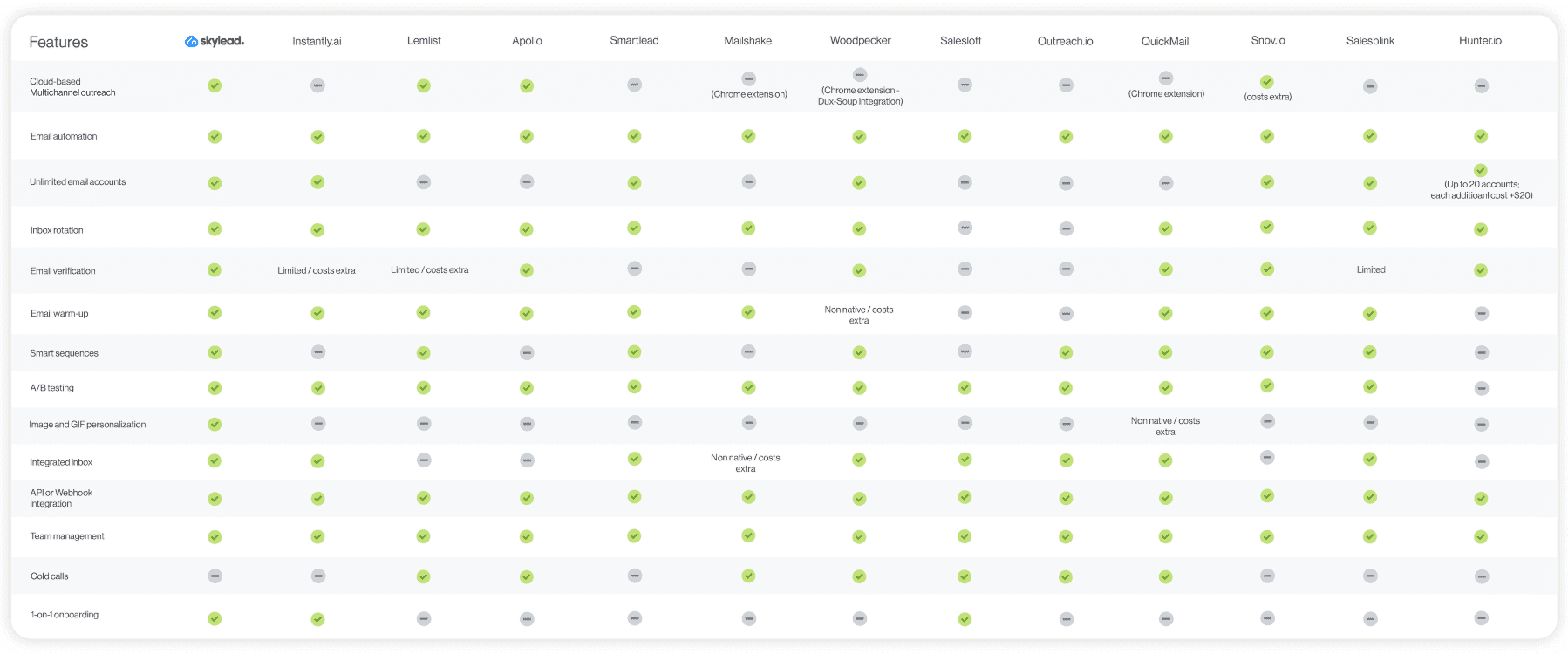
And there you have it—our deep dive into Instantly.ai and its top 12 alternatives.
As you’ve discovered, Instantly.ai has some powerful features. But it's not perfect, mainly because of the lack of multichannel outreach support that tools like Skylead have.
That said, if your strategy relies heavily on engaging prospects across multiple channels, Instantly may not be for you.
Luckily, your perfect alternative is out there, waiting for you to discover it.
We've given you the options. Now, it's up to you to try them out.
But why not start with Skylead?
With a 7-day free trial, you can experience the true power of email and LinkedIn automation combined.
So, come chat with us, sign up, and begin scaling your outreach — to infinity and beyond!
LinkedIn, as the main professional network, with 1 billion users, is the number 1 tool to help you find leads.
Using LinkedIn lead generation is great. However, there are other sources you can use and combine with LinkedIn to reach more high-quality leads. Extra targeting work always pays off.
We’ve done the work, researched, and analyzed creative ways to find these leads for your business besides our favorite targeting hacks on LinkedIn. This blog will show you lead generation sources that can be beneficial for your outreach efforts, match your ICP and Buyer Persona, and actually convert.
Let’s jump right in! 🏊
What is a lead?
A business or sales lead is a potential customer who is interested in your product or service. Salespeople use lead generation methods to find leads from multiple sources. Then, they reach out and follow up with each one continuously to warm up the lead and convert them.
Leads vs. prospects
A prospect is a qualified lead. For a lead to become qualified, they have to match your ICP, and you need to interact with them. Once they show interest in your product/service, they become qualified and can continue their journey through the sales process.
How to define and find leads
If your goal is to find leads of high quality, cold outreach can be a powerful tool for building solid relationships. If done right, it could help you close more deals. This could depend on multiple factors, ranging from a catchy email subject line, a LinkedIn inMail subject line, and a powerful call to action to creating a strong follow-up email after no response campaign flow.
However, before you get into outreach, your first job is to define your target audience. Here are the 3 main things to consider. 👇
1. Build your inbound strategy
To maximize results, you should consider investing time and effort into building your inbound strategy as well, as inbound and outbound work well together.
Make sure to build your website and fill it with educational content, such as blogs, downloadable templates, lead generation forms, case studies, and documents. Your support team should always be available, and the support chat icon should be visible on the homepage.
2. Define your ICP and Buyer Persona
Both the Ideal Customer Profile and Buyer Persona are your essential documents for defining the type of company or person you’ll target with your outreach. Before you go out to find leads, you should define both.
Just a reminder, the Ideal Customer Profile describes the company that would benefit the most from your product or service. These companies should have the fastest conversion cycle, highest LTV, and highest customer retention and be willing to refer your product or service to others.
On the other hand, a Buyer Persona describes your perfect decision-maker. In other words, a Buyer Persona is a collection of an individual’s personal data such as age, location, likes, dislikes, goals, wishes, challenges, and motivations.
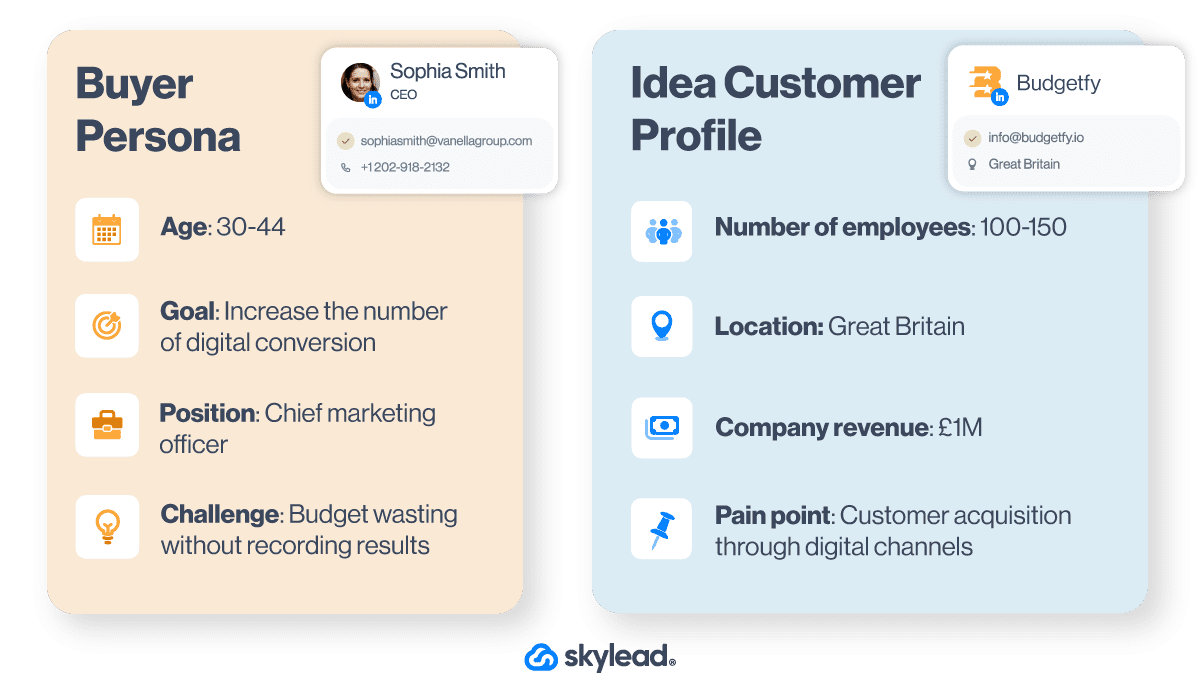
Ideally, both Buyer Persona and ICP should be based on existing customers and data, as it will help you create these documents more precisely.
3. Create your sales leads personalization document
Social selling is about building relationships and helping your sales leads reach their goals with your product or service. But before you can dive into relationship-building, you should gather personal info about your leads.
To personalize your outreach at scale, you would need to do extensive research on what they do and the content they publish or get more personal by finding their hobby. Start by creating an Excel file with columns like:
- First name
- Last name
- LinkedIn profile URL
- Company
Then, continue by inserting information, such as:
- The topic of the content they published
- What stood out for you the most from the particular post
- School they went to
- Field of study
- Jobs they posted
- Company growth information
- Personalized message intro (the message you can create based on the above-mentioned)
In other words, create a column for everything you can find while researching. This document contains actionable data for your outreach. So, read on to see how you can use and benefit from it.
Pro tip: Before you start your outreach be sure you have your LinkedIn prepared to sell for you.
Why you need to update your lead generation strategies
LinkedIn is still our #1 platform for generating leads, right? However, by using different strategies and sources to find leads apart from LinkedIn, you will gain even deeper insights into your potential ICP or Buyer Persona. This will ultimately help you maximize your sales efforts and results.
Below, we will review a list of 30 ways to find leads online and how to use them. We’ll show you how to automate outreach, save 11 hours per week on manual work, and focus on closing deals. Sounds good? Keep reading! 🤓
30 ways to find leads
1. Find leads on company websites
To find leads on company websites, you identify target companies and visit their official websites. Then, you explore the “About us” and “Team” pages to find the decision-makers. While you’re at it, you should also check the “Contact us” page for general contact info.

Once you click, you’ll usually get to names and titles, sometimes, even with LinkedIn icons, do you don’t have to look for them manually.
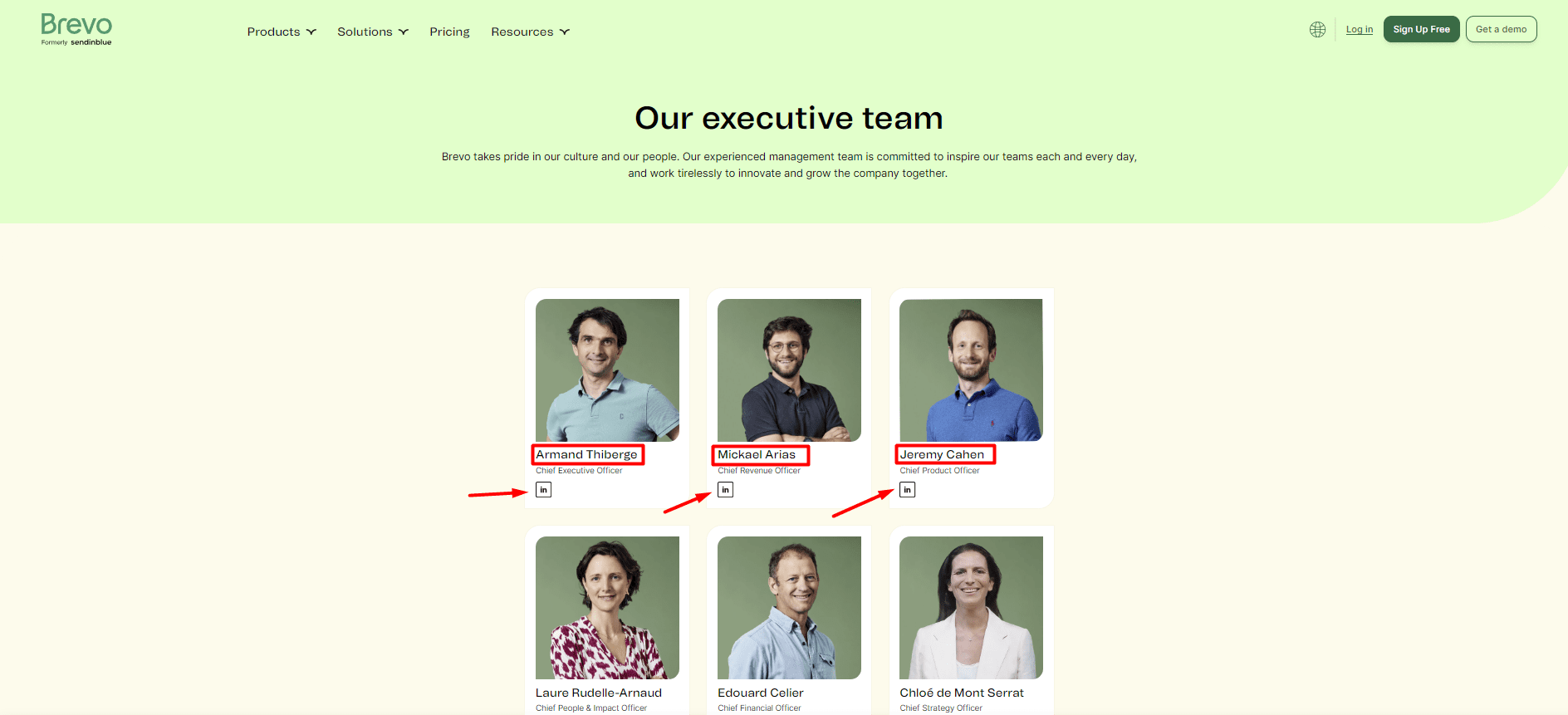
After getting leads on these pages and finding them on LinkedIn, you can send connection requests for a more natural and personalized outreach.
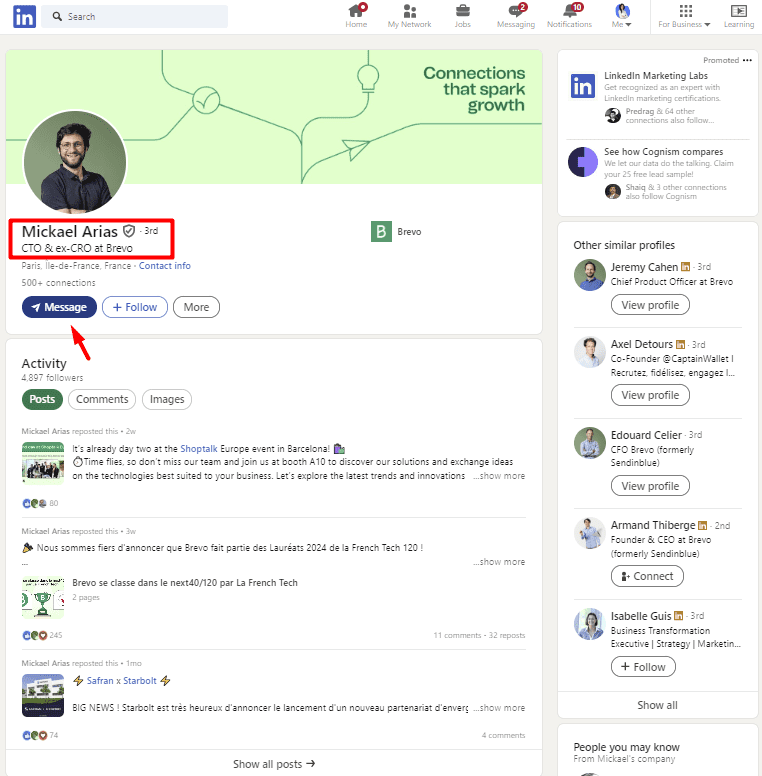
You can also use operators like “site.com email” to find employee email addresses. Or, even better, use an automation tool to Find & verify business emails. Lastly, you can use content to engage and comment on blog posts to get noticed by content creators, start conversations, and get recommended to their colleagues, who are your target audience.
2. Find leads on live events
To find leads at live networking events, you should find relevant events first: industry conferences, trade shows, and meetups. Our advice is to register early to ensure your spot. Also, make sure to review the attendee list if it’s available. Before the event:
- Do the prep work
- Research key participants and companies
- Plan your approach to engage with attendees
In case of a live event, you can go as an attendee, or you can have your own booth. As an attendee or guest, you should attend sessions and participate in all discussions to connect with other attendees. The main goal is to learn about industry news, meet new people, and build relationships with potential leads.
If you have your own booth, you will have a chance to talk to interested parties, distribute marketing materials, and start meaningful conversations. You can also exchange digital cards or connect on LinkedIn immediately.
After the conference, in both cases, you should follow up with new contacts shortly after to keep the conversation going and nurture newly built relationships.
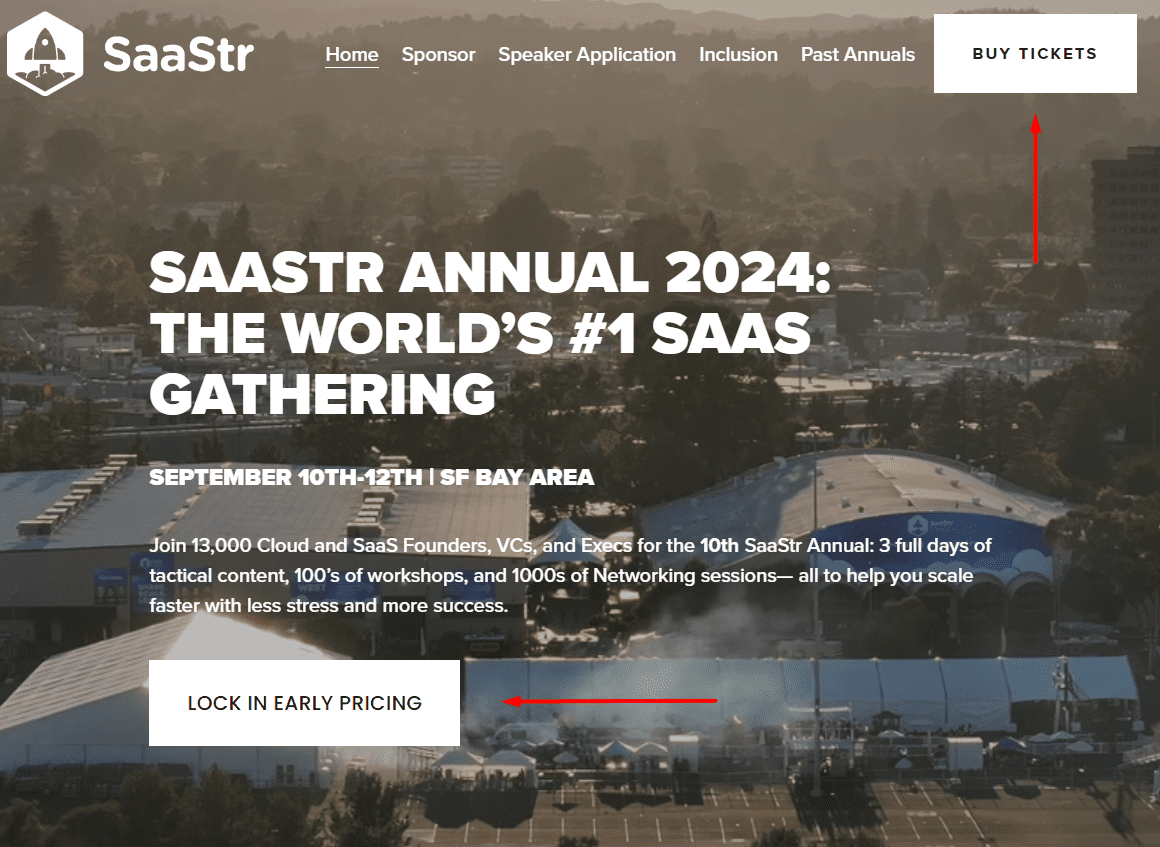
3. Find leads on digital events
With digital networking events, such as webinars, LinkedIn events, and online meetups, the rules are a bit different. Come prepared, research everything about the event and the attendees, and plan your approach.
You should join Q&A sessions, breakout rooms, and chats to connect with attendees. After the event, be sure to reach out on LinkedIn or email and mention your interaction or a specific topic from the event. By keeping the conversation going, you’ll easily generate and nurture B2B leads.
4. Find leads via referrals
You can find leads with a little help from your existing customers. Reach out to satisfied clients, colleagues, and industry contacts for referrals.
To get the most out of your referrals, our advice is to create strong incentives or a reward-based referral program. This will encourage referrers and keep leads coming in. You should also always keep in touch with your network through LinkedIn chat or email.
When you do get the leads from referrals, our advice is to always make sure to follow up and show appreciation to both the referrer and the new contact they brought in.
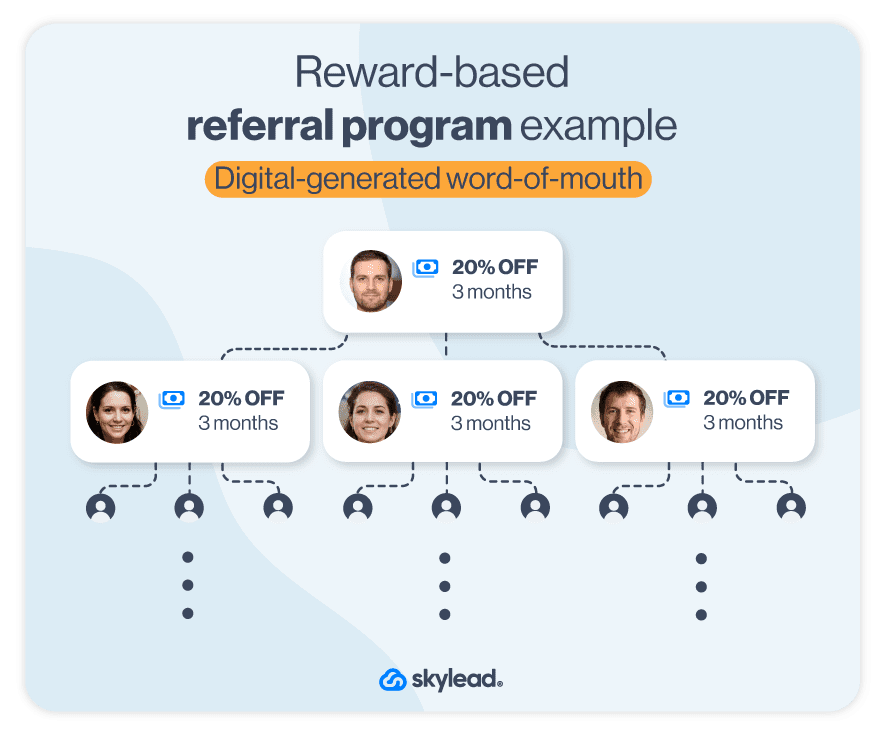
5. Find leads via industry associations
Another way to find leads is to join industry associations and actively participate in their activities. Attend association meetings, conferences, and events to network with other members on LinkedIn or via email.
The trick is to pick associations relevant to your business that have active memberships and ongoing events. For example, if cloud-based companies are your ICP, you could join the Cloud Software Association.
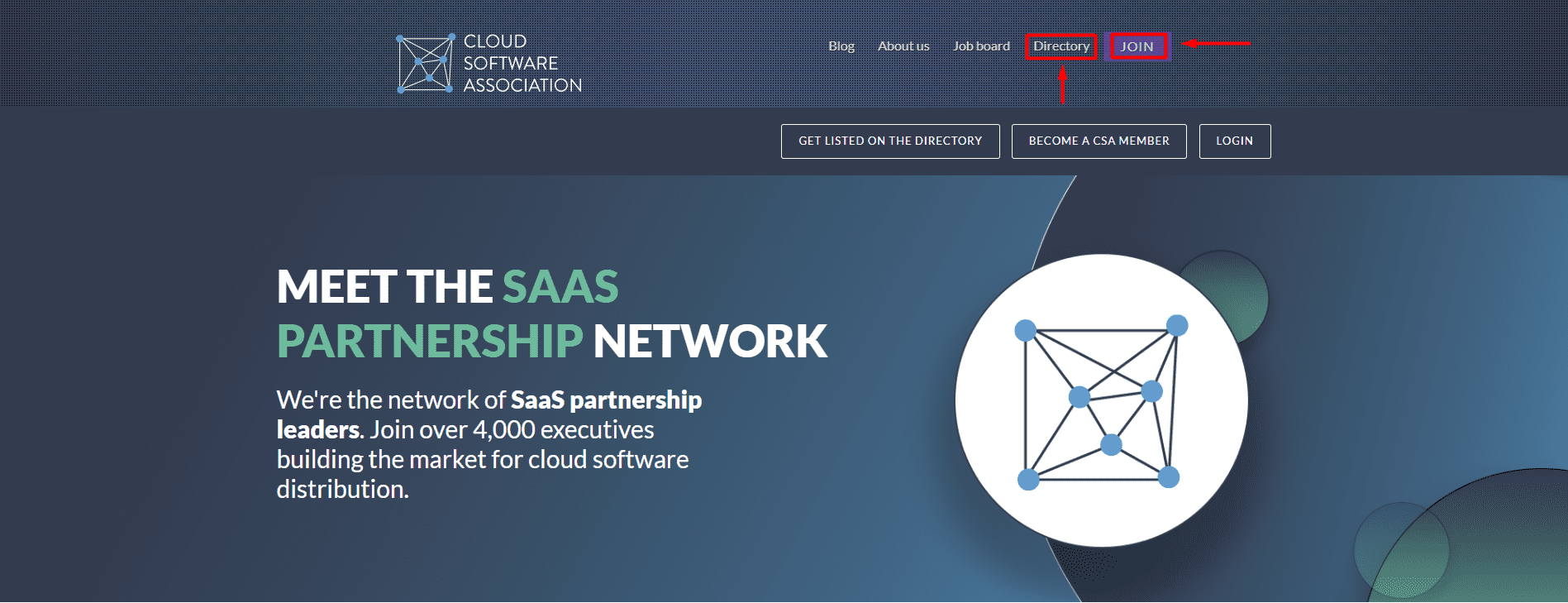
After that, go to their directory and search for businesses of interest. You can use numerous filters to narrow down your search.
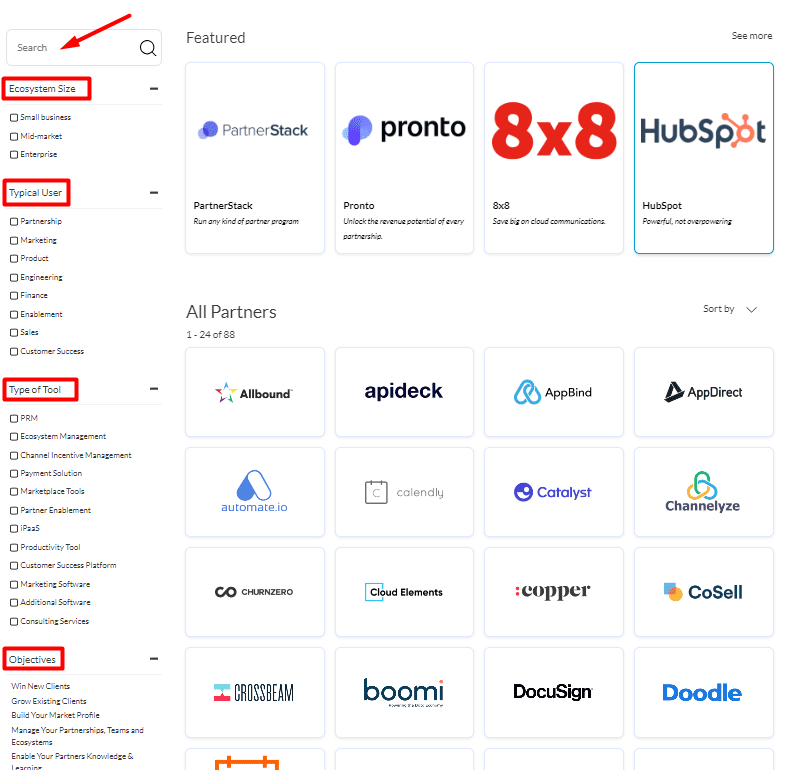
After that, you know the drill. Go to LinkedIn, find the company of choice, go to their people section, find decision-makers, and outreach away!
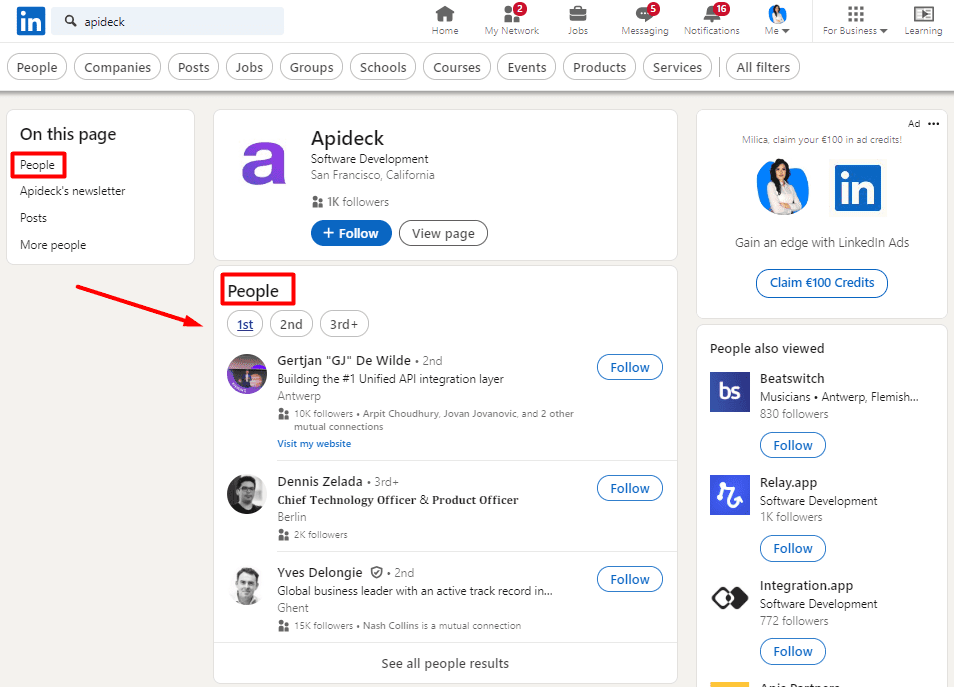
6. Find leads on X
Finding leads on X can be a real game-changer! For example, you can search for your competitors and find negative Tweets or comments. Then try finding them on LinkedIn (if they have their full name and a legit picture) and add them to your CSV file for future outreach. Don’t forget to personalize your outreach and reference how you’ve found them.
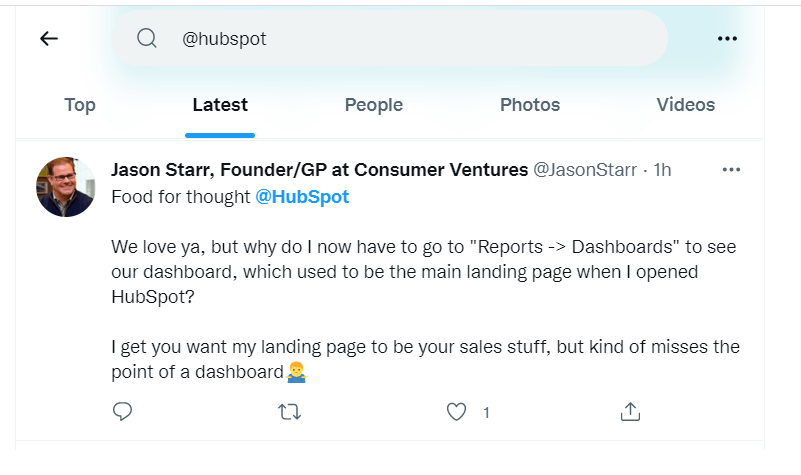
7. Find leads in Facebook groups
Facebook is a perfect place to find your Buyer Persona. However, you just need to dig a little deeper to find them, and join a couple of groups here and there.
The first thing you need to do is to research and find the Facebook groups your sales leads follow. Then, join these groups and wait for approval. From there, you can find your sales leads by the posts they have published. The only thing you need to do is search the group by the keyword.
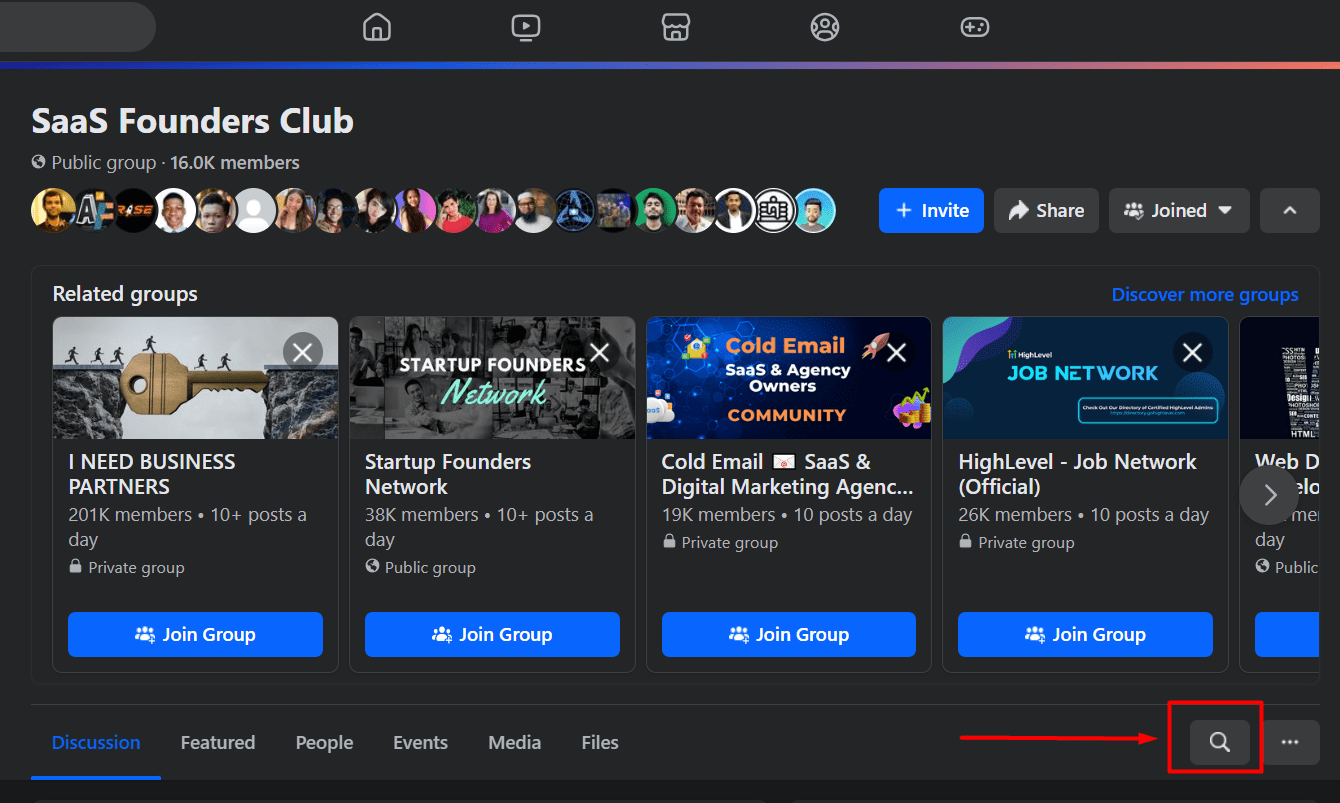
You then search sales leads by, for example, the exact pain point they experience or the goal they want to achieve. This is where you find potential interested parties for your product/service.
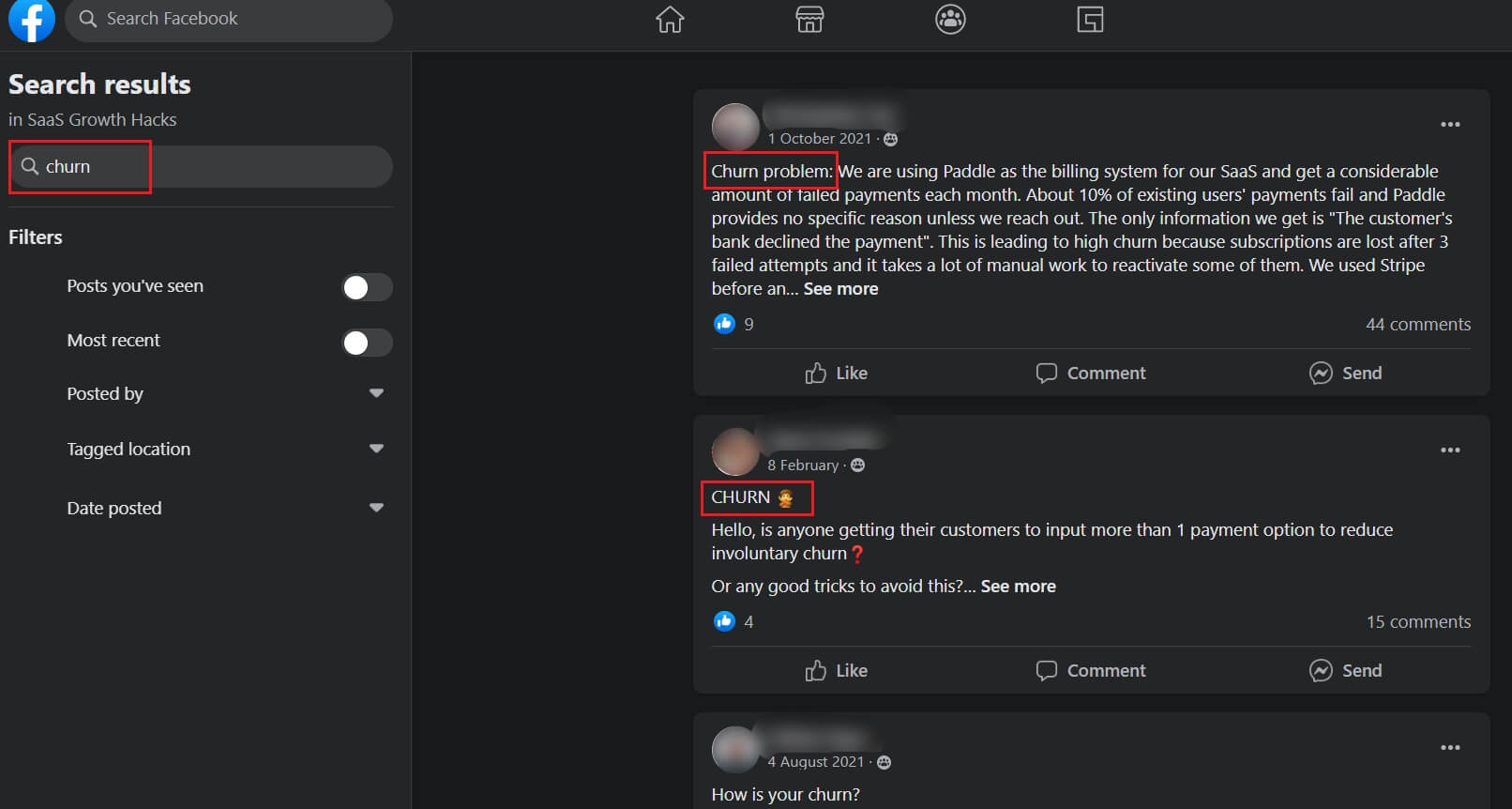
You can message the people who posted directly on Facebook or, better yet, connect with them on LinkedIn and begin your outreach campaign.
8. Find leads on Instagram
Instagram is all about good visuals, hundreds of followers, but also finding leads. Yes, we’re not kidding. Go to the profiles of companies that are your competitors or have similar ICP and Buyer Persona, go to the followers section, and scroll down to find leads.
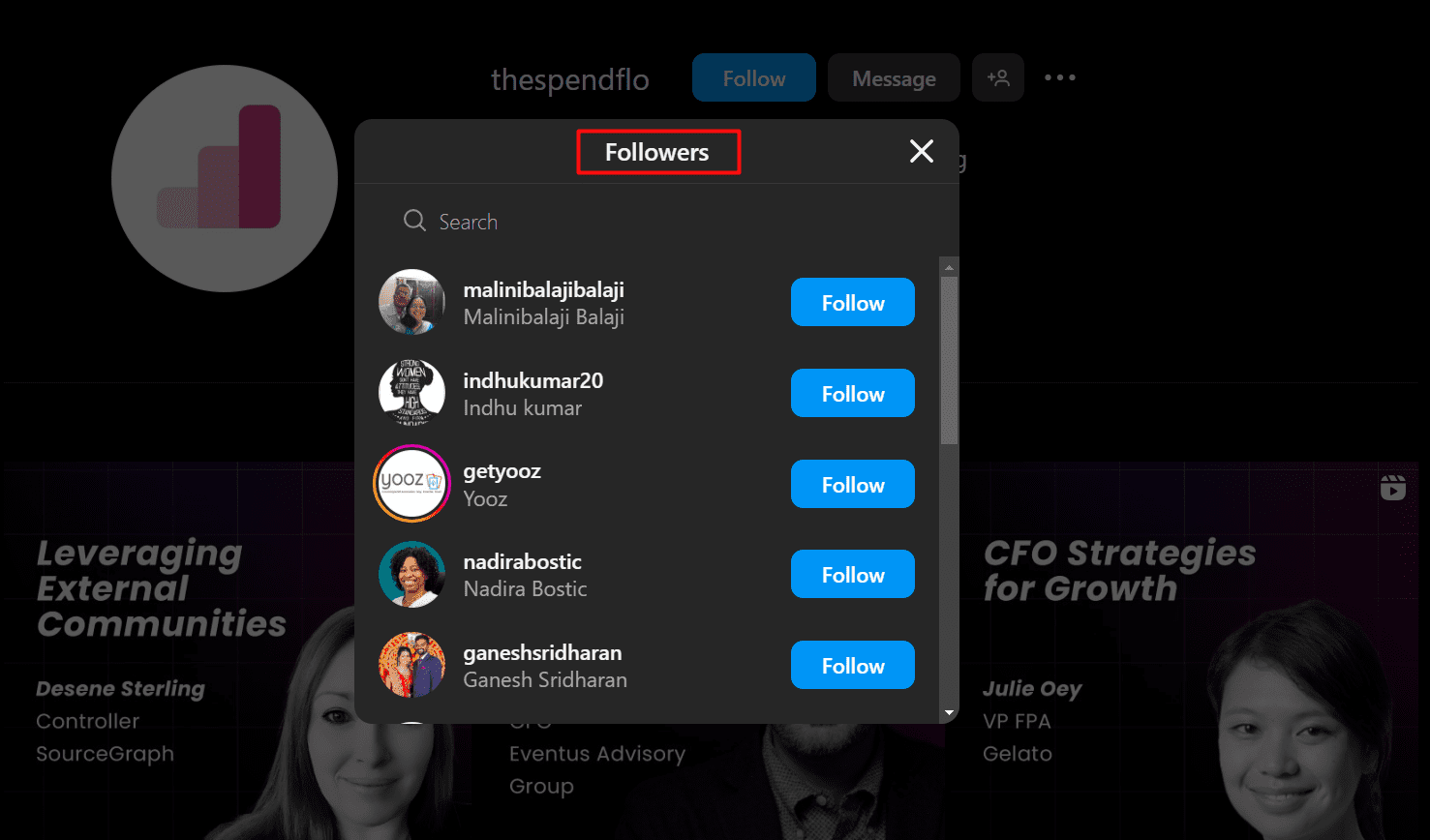
Once you get to them, we’re using our favorite lead gen ally - LinkedIn 👇
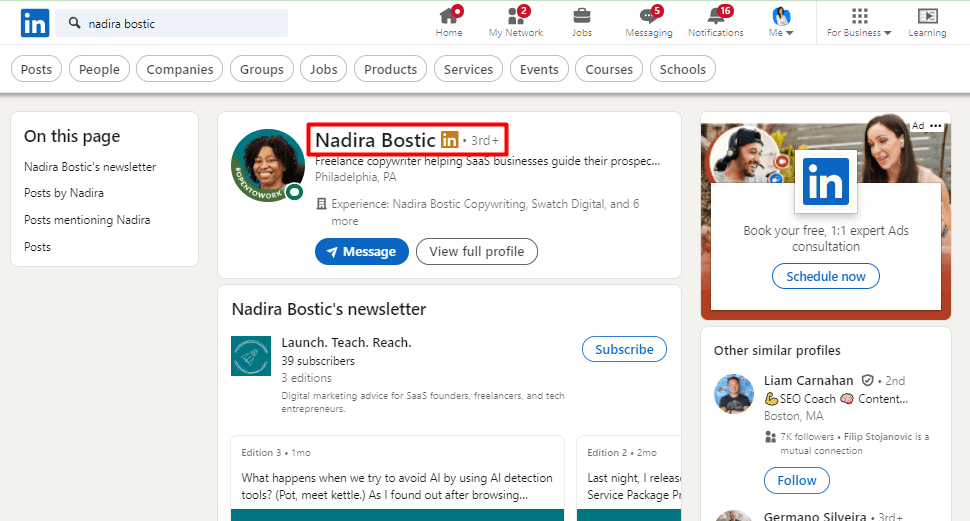
9. Find leads on Reddit (Specific Subreddits)
If done right, finding leads on Reddit can be incredibly effective. Here’s what you’ll need to do:
- Find relevant subreddits
- Actively participate in discussions
- Find content that discusses problems you’re solving and mention your product without sounding too salesy (use the Search comments option for keywords)
- DM those people and ask to connect on LinkedIn
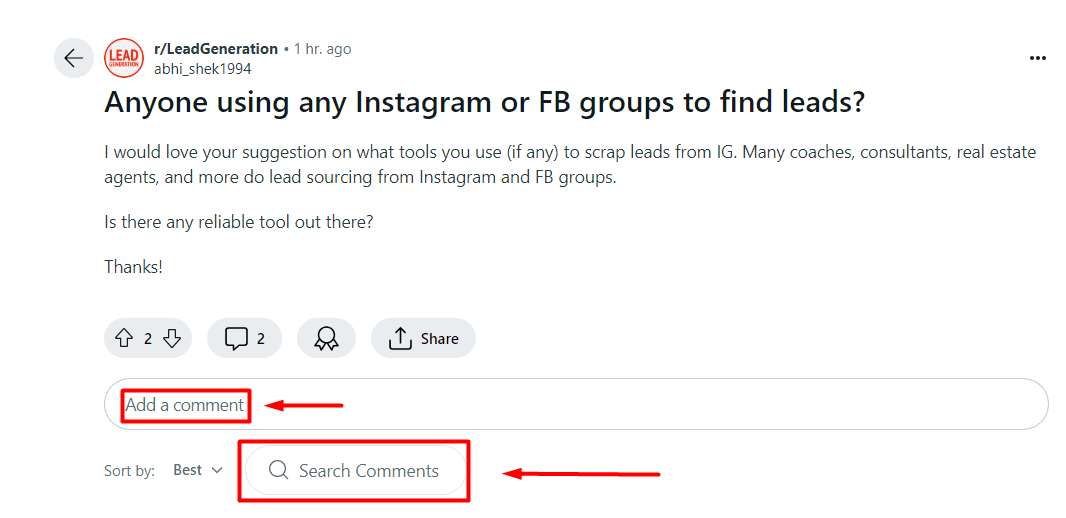
From what we’ve learned from our own experience, people will see your comment as useful and reach out to you themselves, asking for more information. This is usually a sign that you’re providing value where value is needed, so keep up the good work!
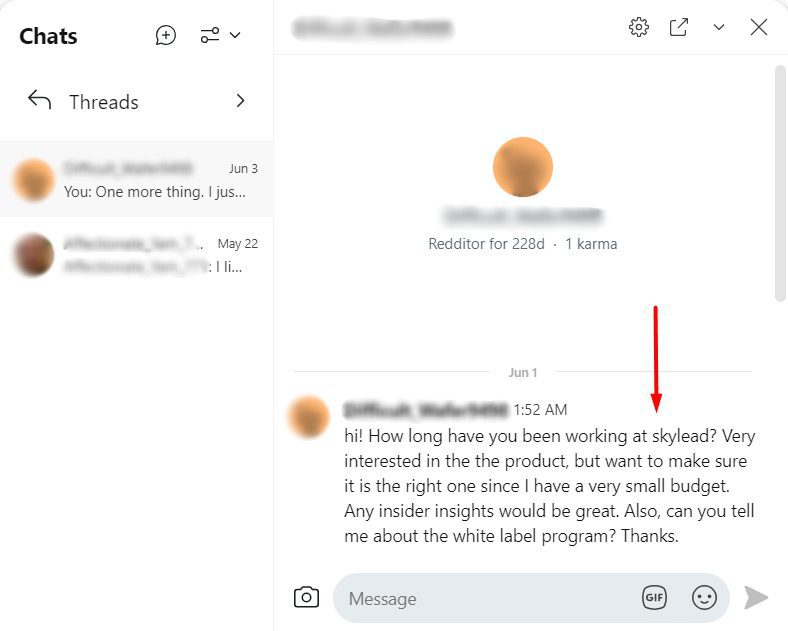
10. Find leads with gated content
You might know this already, but using gated content with lead capture forms is a smart way to get leads. The marketing team creates:
- E-books
- Whitepapers
- Exclusive webinars
- Downloadable templates
Then, they send the list of leads to the sales team, who creates outreach campaigns. In fact, this is how we did it: We’ve offered a sales book that helped us grow our business from 2,500 to 10,000 users in just 9 months. In exchange, people leave contact information through a simple sign-up form on our website. We’ve also promoted our gated content through blog posts, social media, and email campaigns to drive more traffic and capture more leads.
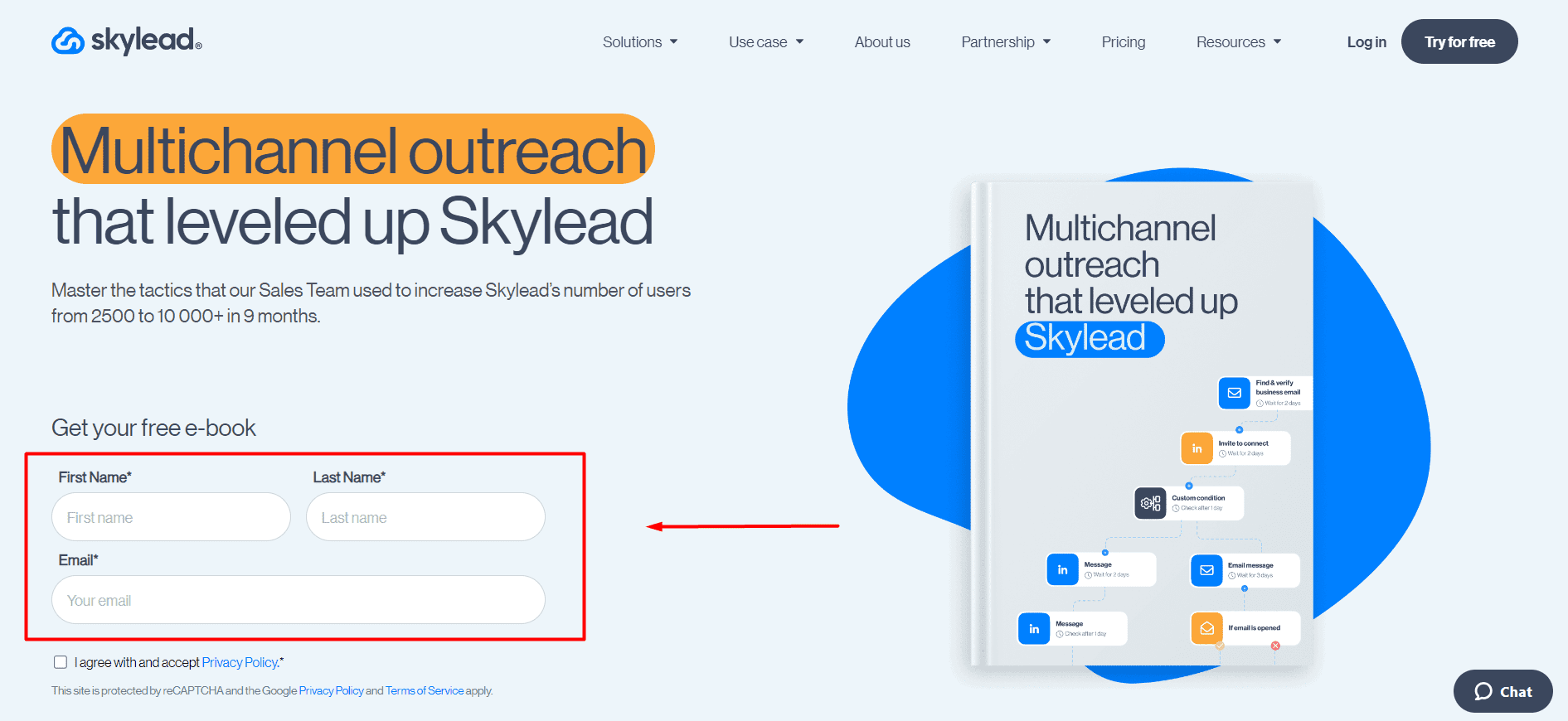
Here are our tips on how to attract leads with quality gated content:
- Strong CTAs: Use clear and enticing calls to action to encourage users to access your gated content.
- Tailor your content: Tailor your gated content to specific segments of your audience to increase relevance and engagement.
- Follow up quickly: Send a follow-up email immediately after someone downloads your content to nurture the lead.
- Use analytics: Track the performance of your gated content to understand what resonates best with your audience.
- A/B test: Test different formats, headlines, and designs to optimize your landing pages and sign-up forms.
- Offer multi-step content: Create a series of gated content pieces that build on each other to nurture leads to conversion over time.
- Integrate with CRM: Make sure your sign-up forms are integrated with your CRM to streamline lead generation.
11. Find leads on review websites
Review websites can be very useful for finding leads. Here are a few review website examples:
Just go to the review website of choice, find your competitor, and then search for people who posted negative reviews. For example, here’s a person who is not satisfied with calendar software. Find them on LinkedIn and put them in your CSV file so you can include them in your automated outreach campaign.
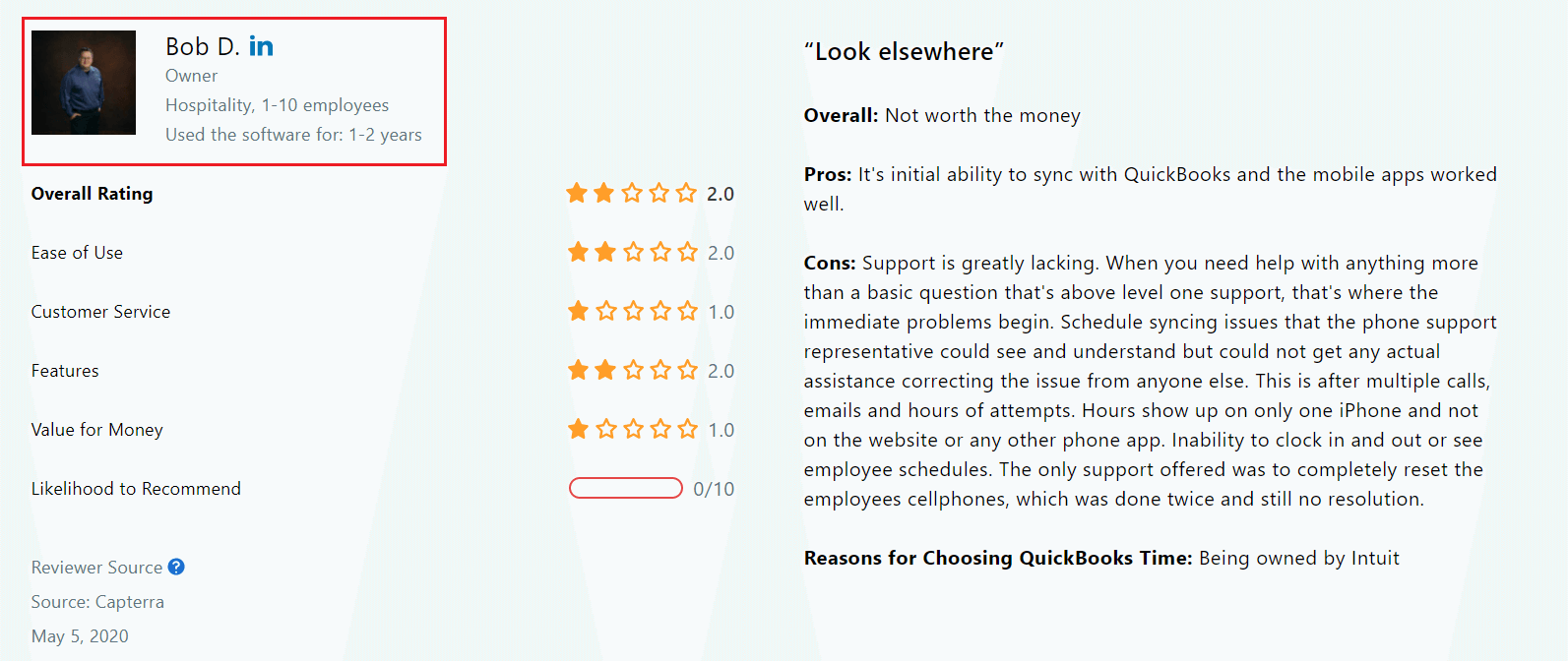
12. Find leads using a LinkedIn X-Ray Search
LinkedIn X-ray search, a.k.a. Boolean search, is a method that allows us to research our leads on Google without using LinkedIn’s internal filters. But why would you do that if you have LinkedIn? Well:
- You’ll get more search results
- You’ll get to see 3rd-degree and out-of-network connections, too
- More relevant search results, thanks to Google’s different algorithms
- A more comprehensive search (thanks to the * symbol (Asterisk) that includes missing words in your search results.
Now, to find leads using LinkedIn's X-ray search, use Google with specific search operators. Enter "site.com" followed by relevant keywords, such as job titles or industries (e.g., "site
.com marketing manager"). This narrows down the LinkedIn profiles that match your criteria. Refine your search by adding location or company filters to target specific leads effectively.
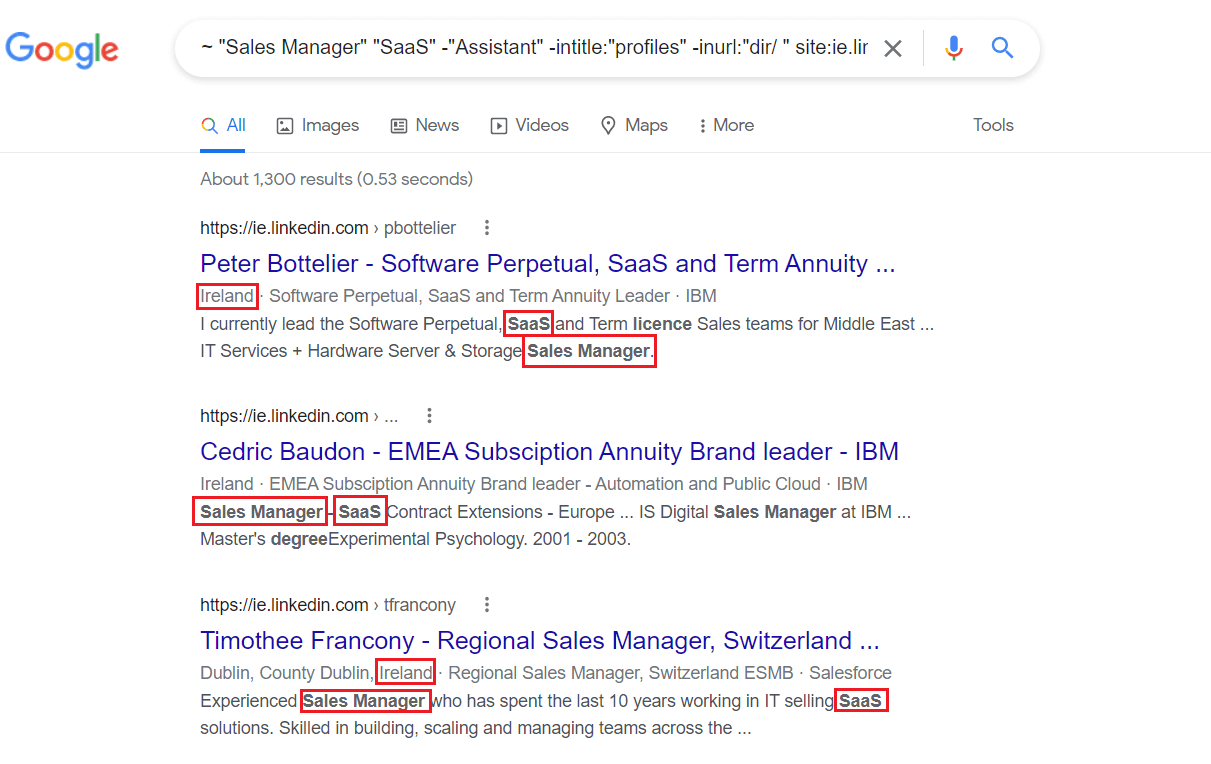
After you’ve pinpointed your leads, you go to LinkedIn and copy-paste their info to your CSV file for future outreach.
13. Find leads in CRM databases
Up until now, we’ve been talking about finding leads elsewhere, but you should not forget to look for leads among your own clients. Or rather, the ones that ended up in the churn box. Go to your CRM database and find the email addresses of clients who went in another direction, so to speak.
Think about why they might have left and use a new feature or update to start the conversation again or rather a check-in message. Since you’ve already had a relationship with them, restarting the conversation should be easier than with cold leads.
Our advice is to review your earlier conversations and create a separate automated outreach campaign tailored for these old/new leads.

14. Find leads via partnerships and alliances
It’s time to partner up! Start by identifying potential partners whose services complement yours or similar businesses that are not your competition. Reach out to these companies to find out about mutual benefits and opportunities for collaboration. Partnering up can open doors to new networks, which will increase your lead pool.
Here’s an example. Our partner included this image in their newsletter when we launched Product Hunt. It was a perfect opportunity to show us off to their user base and inform them about our special event.
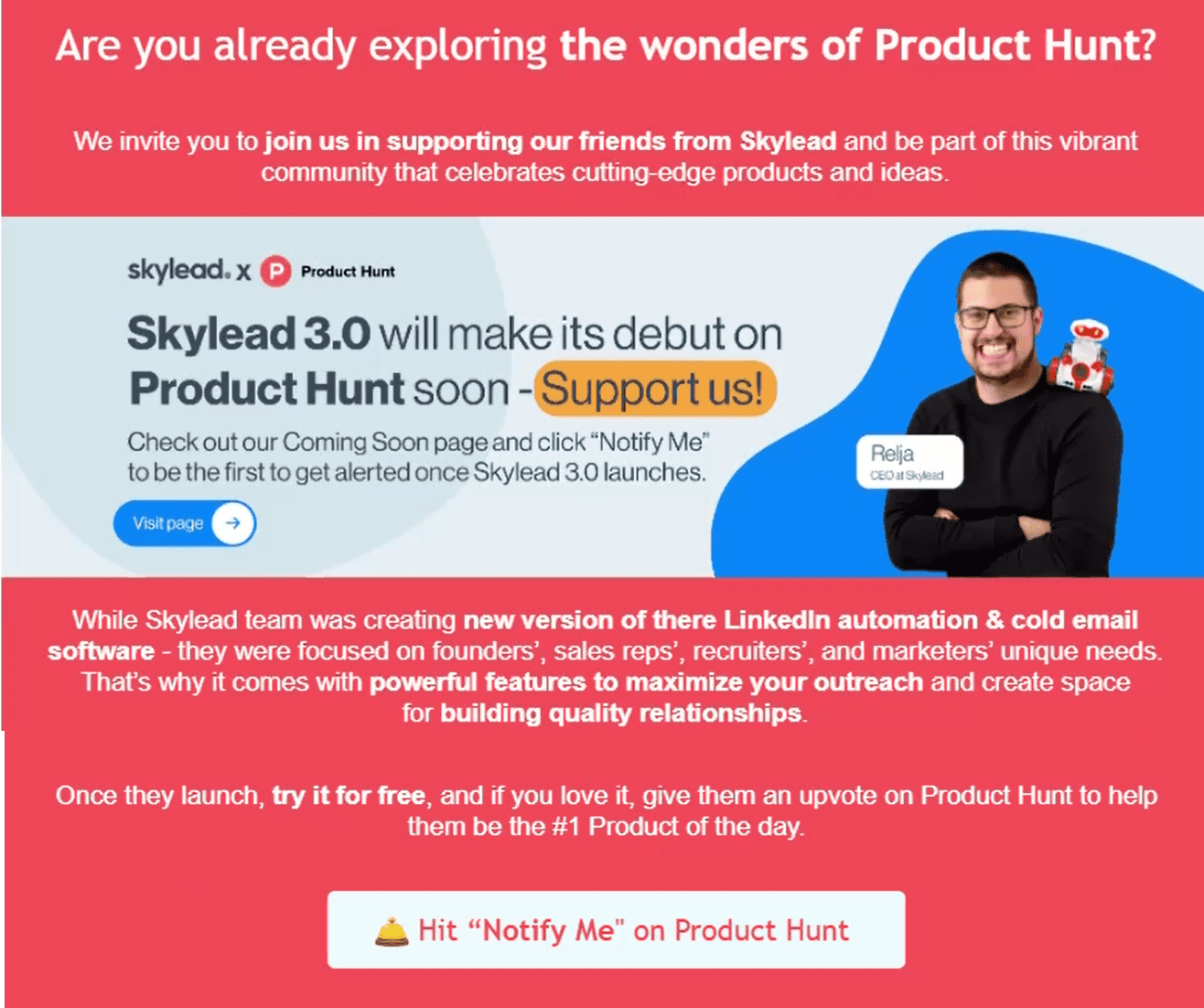
This also works for sharing gated content and referrals through mutual B2B marketing strategies.
15. Find leads via job listings
When a company is hiring, it usually means one of these 3 things:
- They have a bigger budget for the department
- Something is not right in the current process
- Or a person from the team is leaving for a certain reason.
Job postings mean a department change, and you should seize that opportunity. This is where recruiters usually spill the beans, so keep an eye on the department and industry of interest.
For example, let’s say you are selling team management software for remote teams. You can go to any job search website like Indeed and filter the jobs by industry, job type, and remote work.
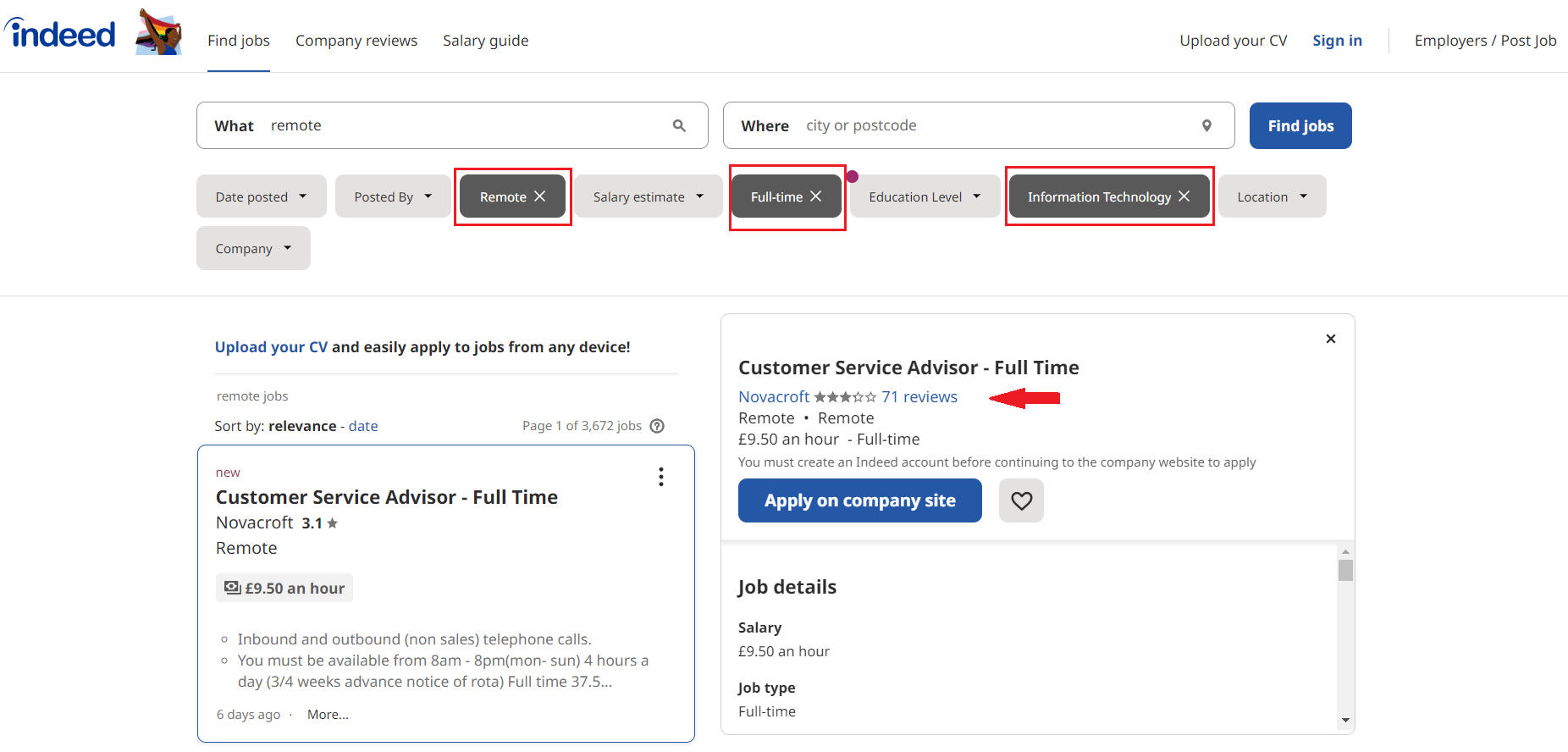
This is a great place to find your ICP and go from there. In addition, if you have a LinkedIn Premium account, you can check out the company’s growth insight on LinkedIn and move on to find your decision-maker.
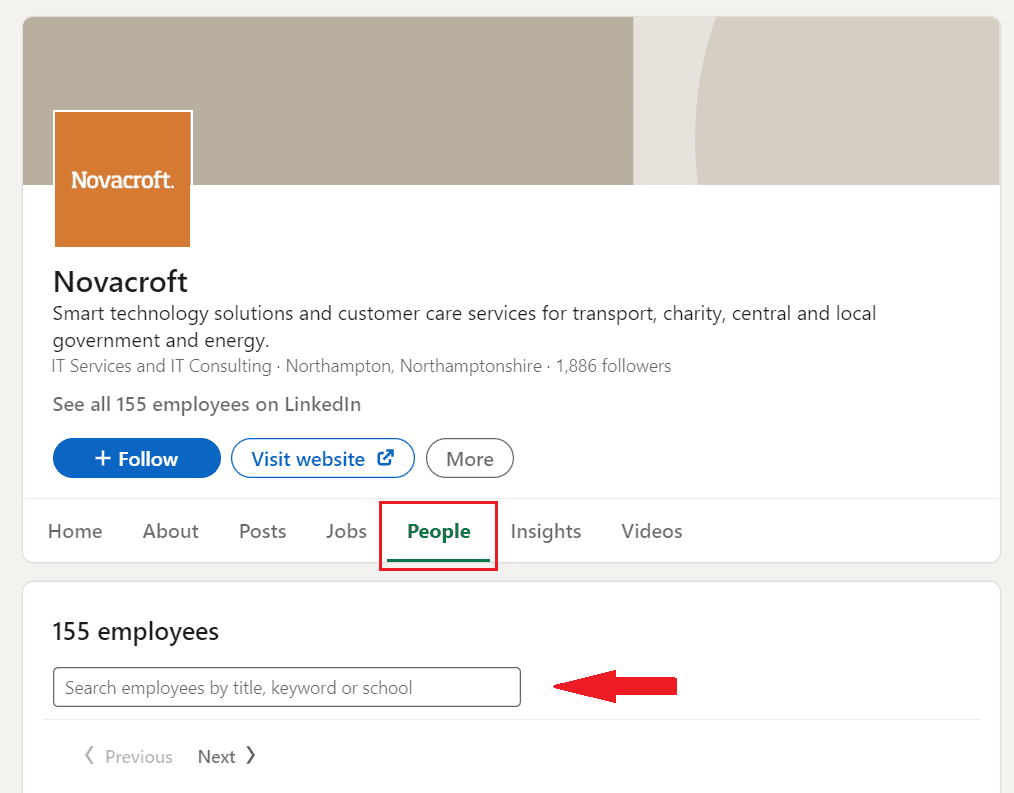
You can do this process on LinkedIn, as well. However, keep in mind that if your ICP is a small company, you might not be able to see their job posts unless you are their 1st-degree connection or they promote these posts on LinkedIn.
16. Find leads using LinkedIn topics
Another place to look for leads on LinkedIn is LinkedIn topics. You get to go through industry related questions, discover key contributors and find your Buyer Persona. You can also filter topics by industry and narrow down your lead search.
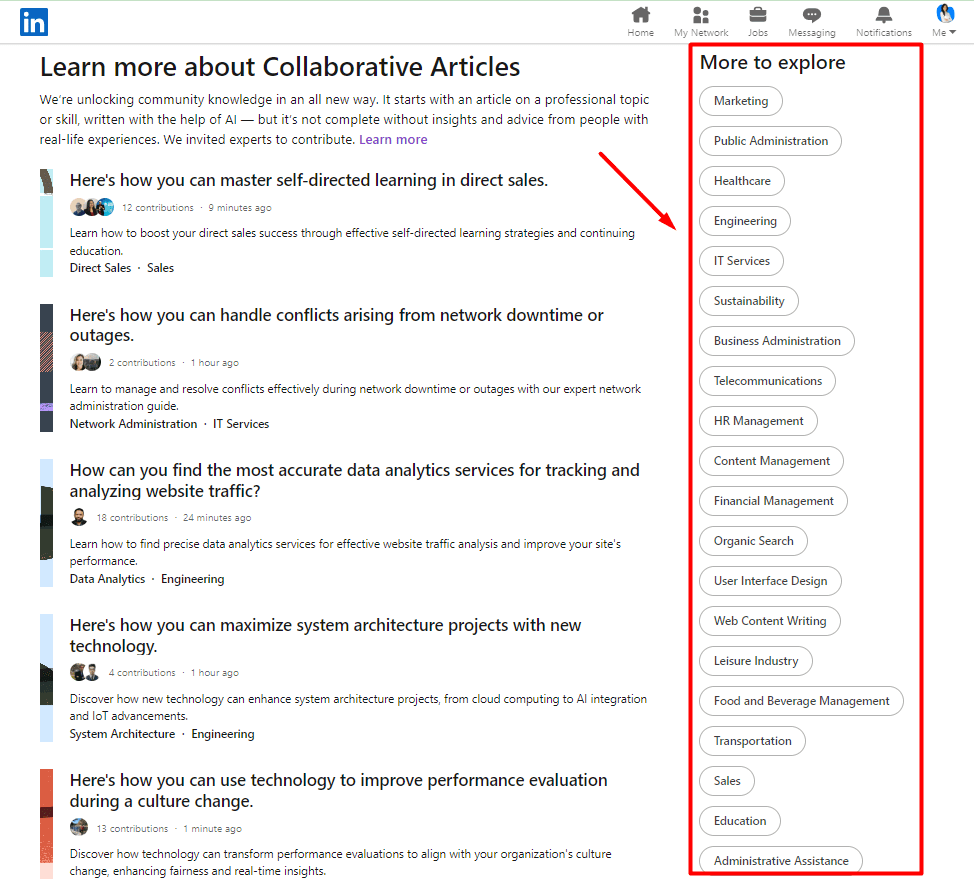
Once you click on a topic, you’ll see different sections and related subtopics you can access. You can go through the contributors listed on the right. Then, you can find the ones you’ll reach out to easily since you’re already on LinkedIn. Our advice is to reference their contribution to a certain topic as an opener. It’s that easy.
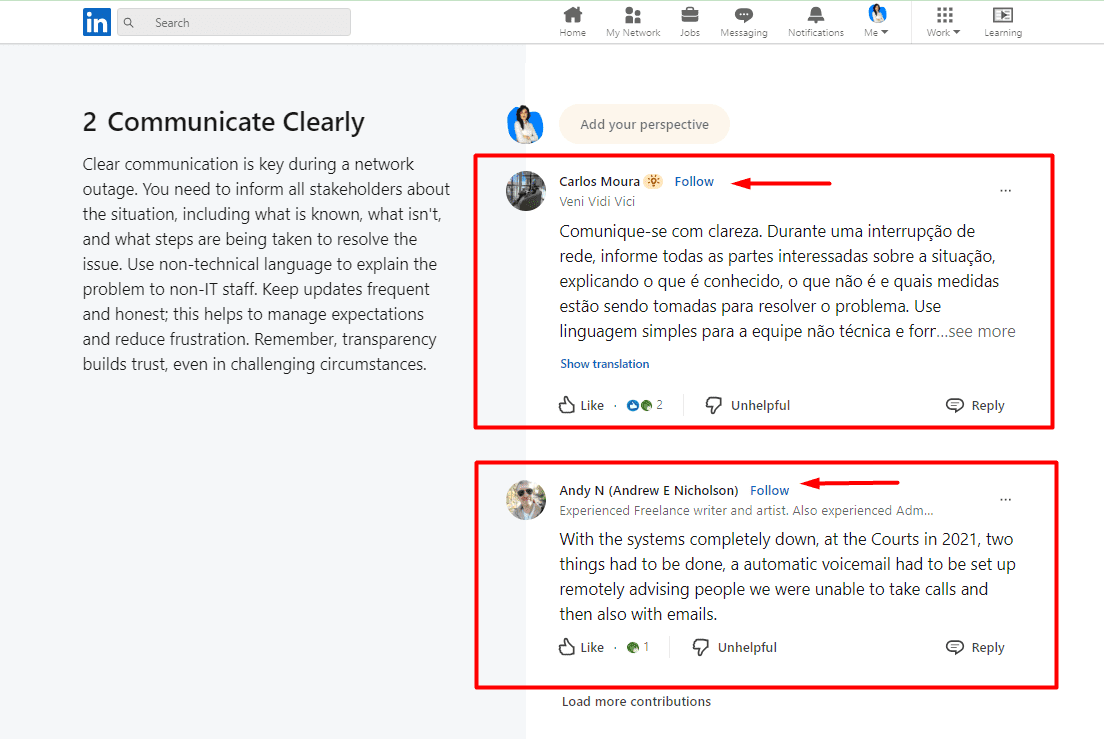
17. Find leads through recently funded companies
Another great way to find your ICP is to research what companies recently got funded. Since we know they’ve got money to invest, make sure their priority is growth.
So, to find these companies, you can choose one of two ways. First, you can use company data websites, such as Fundz, TechCrunch, or Crunchbase. Crunchbase makes it easier to find information as you can filter the companies using the free Funding Rounds feature.
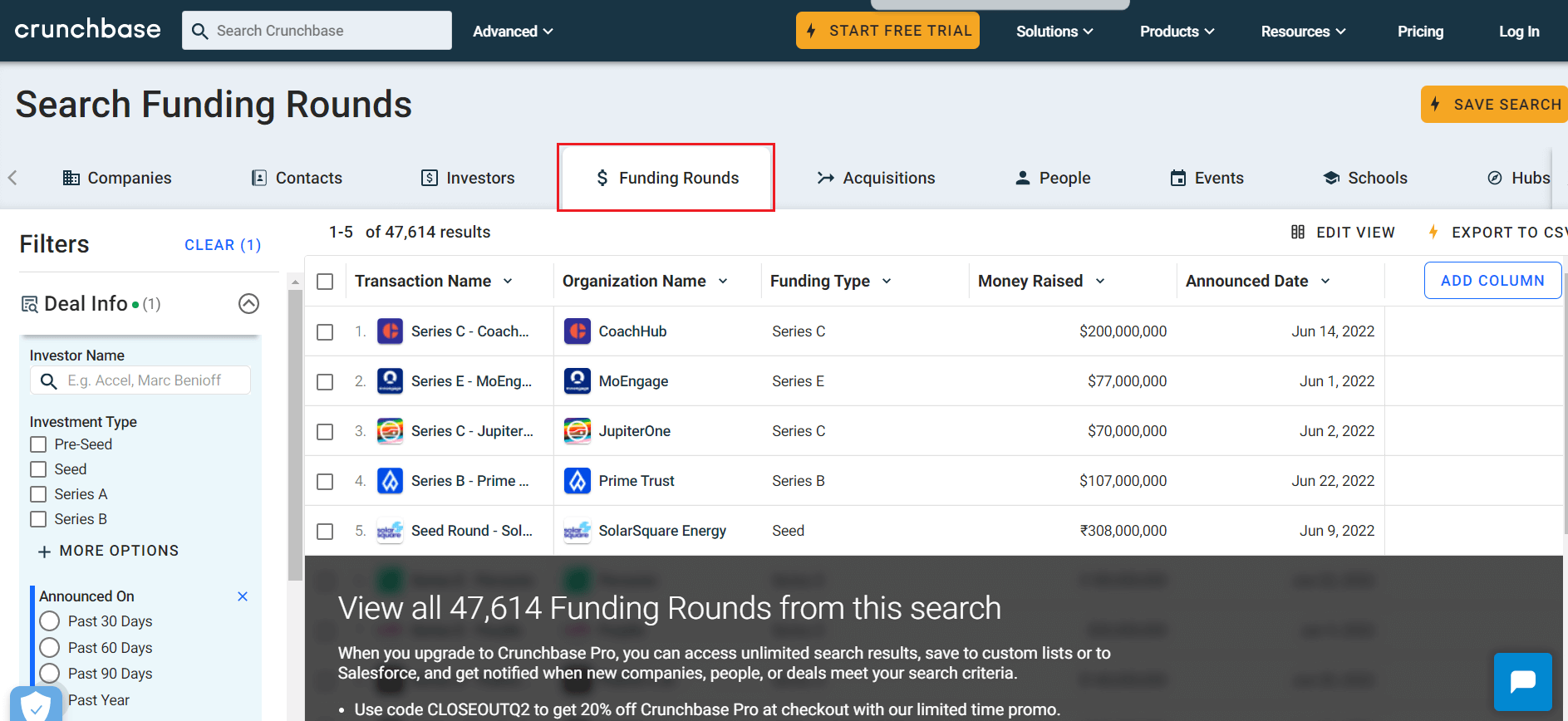
Secondly, you can Google search for companies using Boolean search operators.
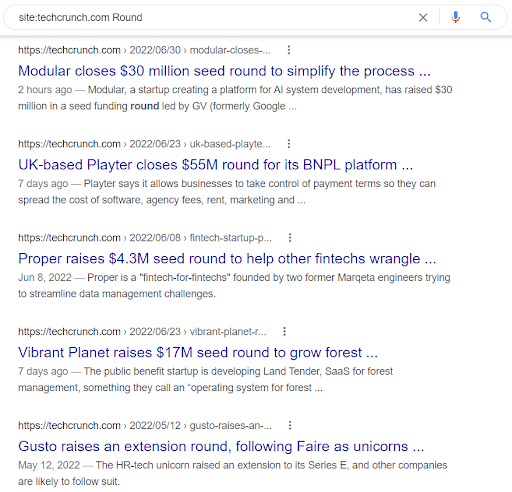
Whatever approach you pick, making the connection with the person from the company that just got the funding and building the relationship can result in a long-lasting partnership.
18. Find leads through Slack communities
Slack channels offer many possibilities, from finding leads to learning something new. The best part is that you can contact each member privately via chat.
There are different communities all over Slack, and you can explore and find the ones your Buyer persona joined. For example, a B2B content director must be following the content trends, so you will most likely find them in the Superpath Slack community under the content-b2b channel.
What’s best is that Slack channels like RevGenius or The Trenches are very educational, supportive, and welcoming. So, apart from finding sales leads and reaching out to people who face a problem your product can resolve, you can enjoy your stay and learn about the changes in the market.
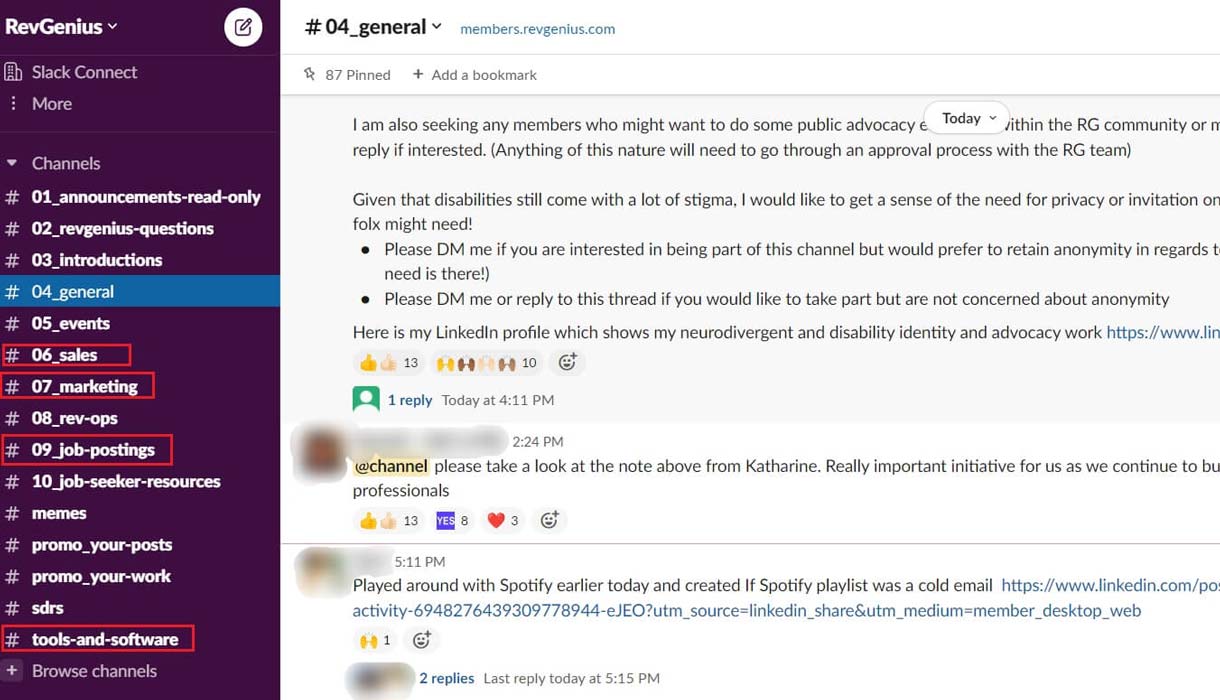
19. Find leads through YouTube comments
To find leads in YouTube comments, all you need to do is find the videos your sales leads might be watching and look in the comment section. Our advice is to find someone with a legit profile, meaning with their full name and picture. You can use this information to find these individuals on LinkedIn.
Let’s say your sales leads are SaaS founders. Consequently, you would find a video related to SaaS, such as this one. 👇
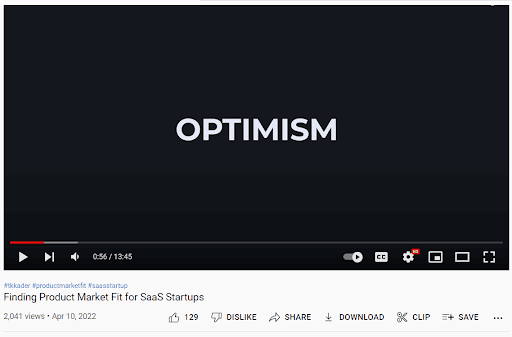
Now, scroll down to find a comment such as this one:

Now go to LinkedIn and search for the person. You can contact them there directly or save their profile in a CSV file with remarks for a perfect conversation starter.
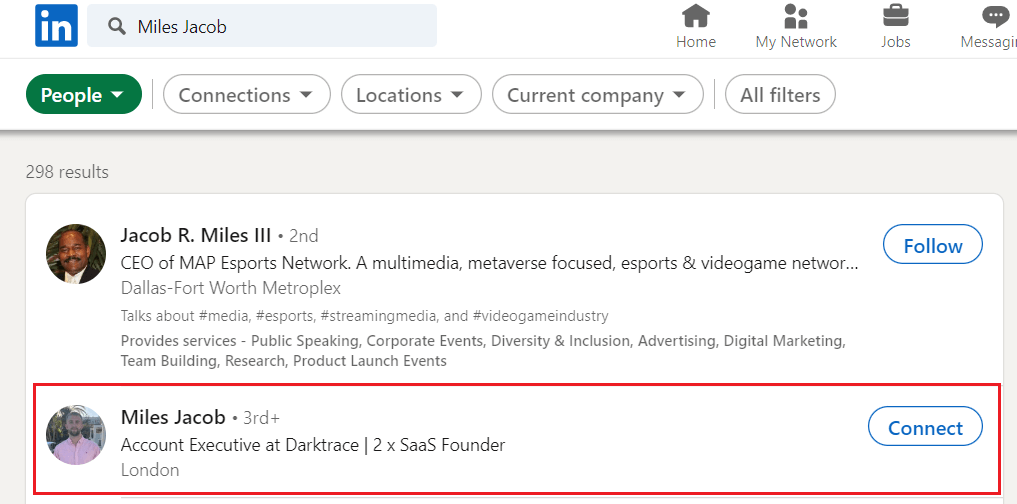
20. Find leads via LinkedIn events
Using LinkedIn events for lead generation is a great strategy for connecting with potential leads and clients. Go to LinkedIn’s search bar, type in a keyword of choice, and select “Events” as your main category.
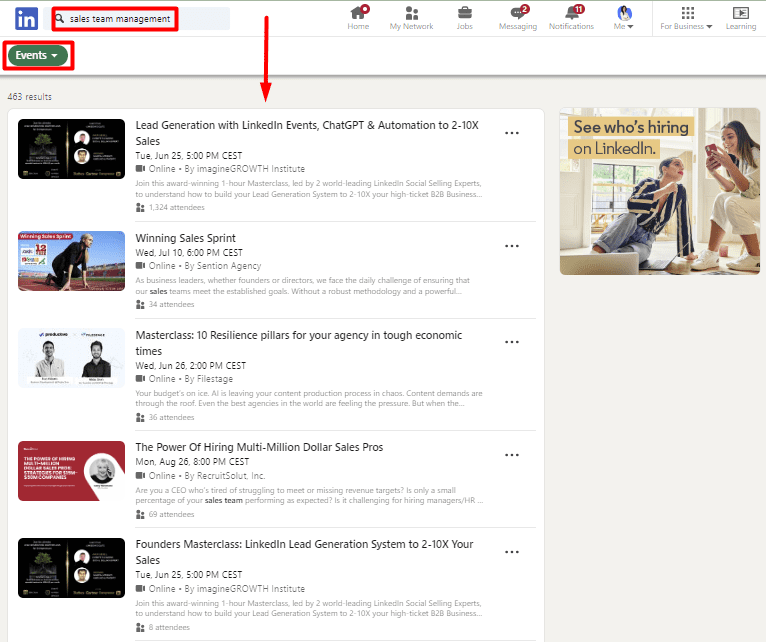
To access the attendees' list and find those leads, you have to click on “Register.”
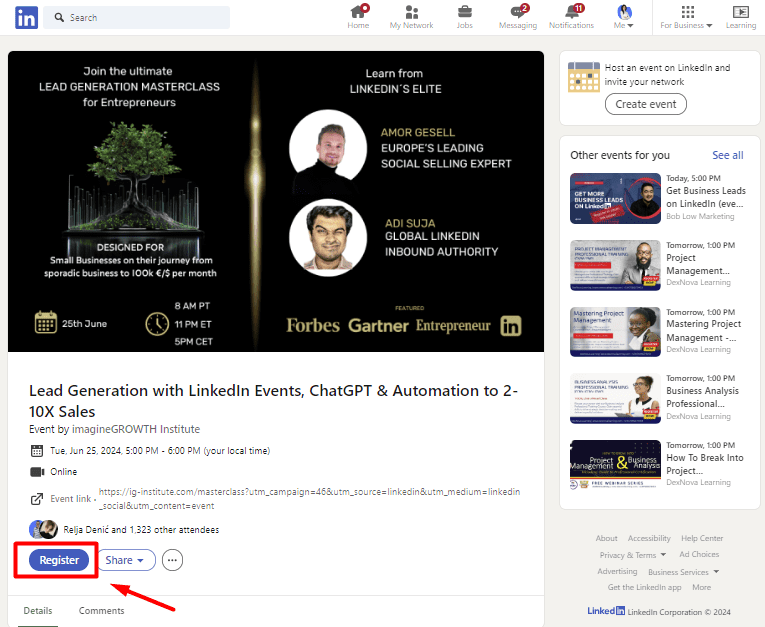
After that, you should click here 👇
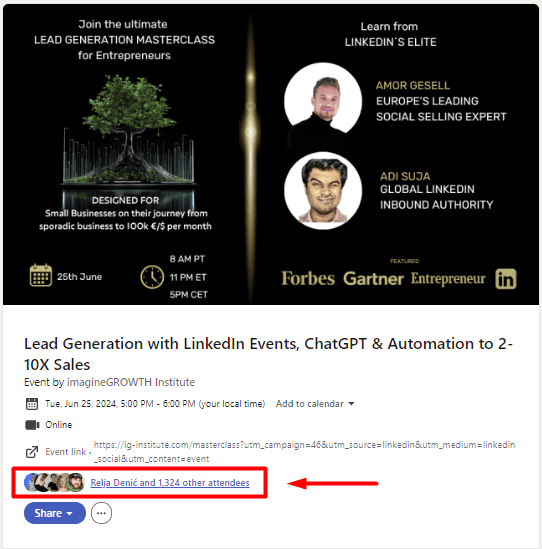
Use filters to narrow down your search to match your Buyer Persona as closely as possible. The only thing left to do is attend the event and use some of the topics and information mentioned in the event to break the ice with your leads.
21. Find leads via Product hunt
Your journey on Product Hunt begins with discovering new and trending products in your industry. There are two ways to find leads here. Firstly, you can go to relevant discussions, watch out for questions from your target audience, and find them on LinkedIn.
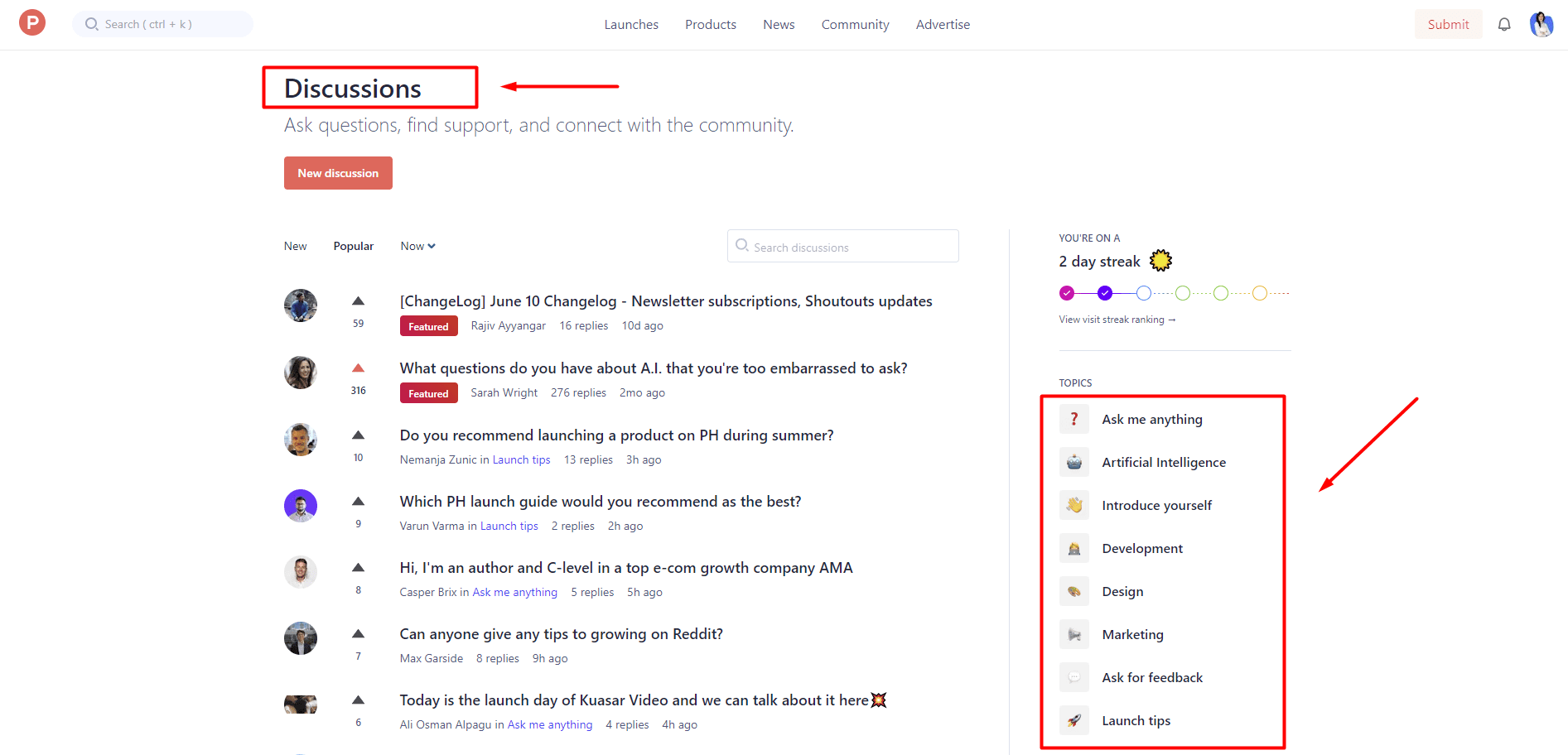
Secondly, if SaaS is your industry of choice, you can watch for new software or releases and find makers.
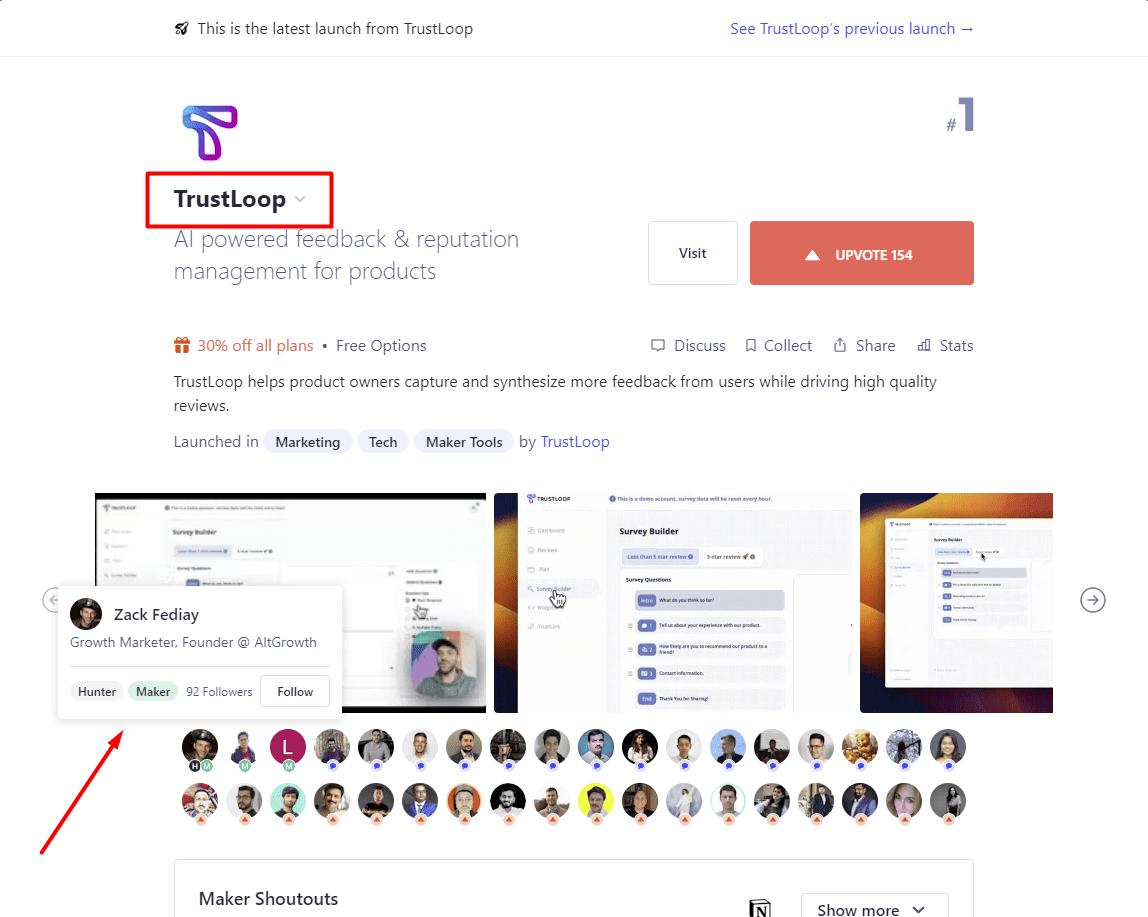
Then, the only thing left to do is to find them on LinkedIn and put the data and personal reference to your CSV file for outreach later on.
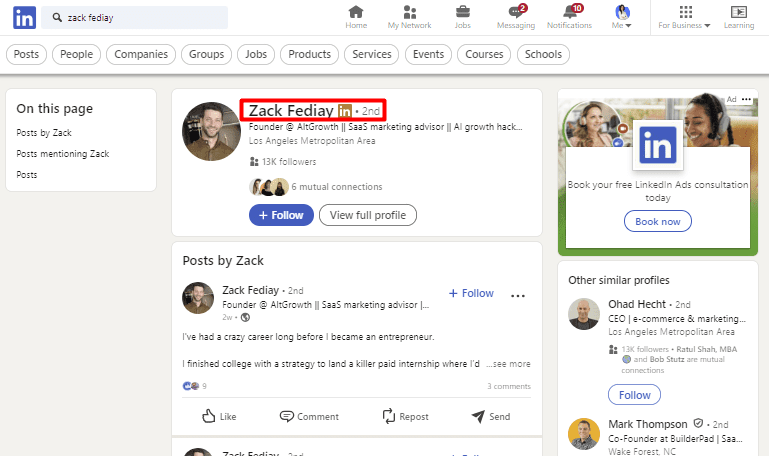
22. Find leads on Medium
Many people of all occupations share their stories and thoughts on Medium, and your sales leads could be one of them. Medium is a blogging platform with over 100 million active monthly readers and 175,000 authors who are thought leaders, journalists, and experts, so you have a deep pool of sales leads to search from.
Also, Medium is pretty easy to use. You just need to type the topic of interest in the search bar and comb through articles.
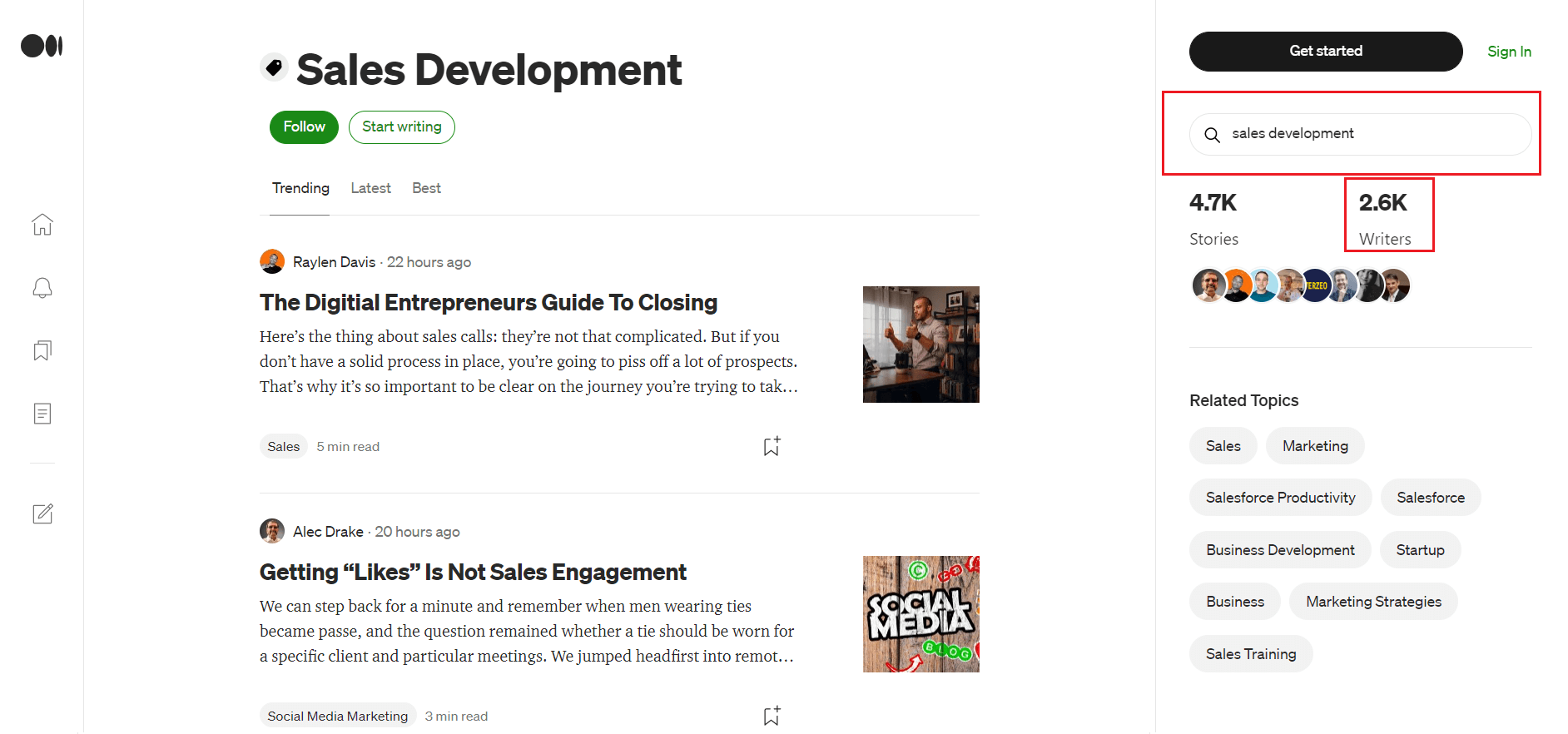
Once you find an interesting post, go to the author's profile. You will usually see their LinkedIn profile or other Social Media URLs in the About section, so it is easy to find leads right away.
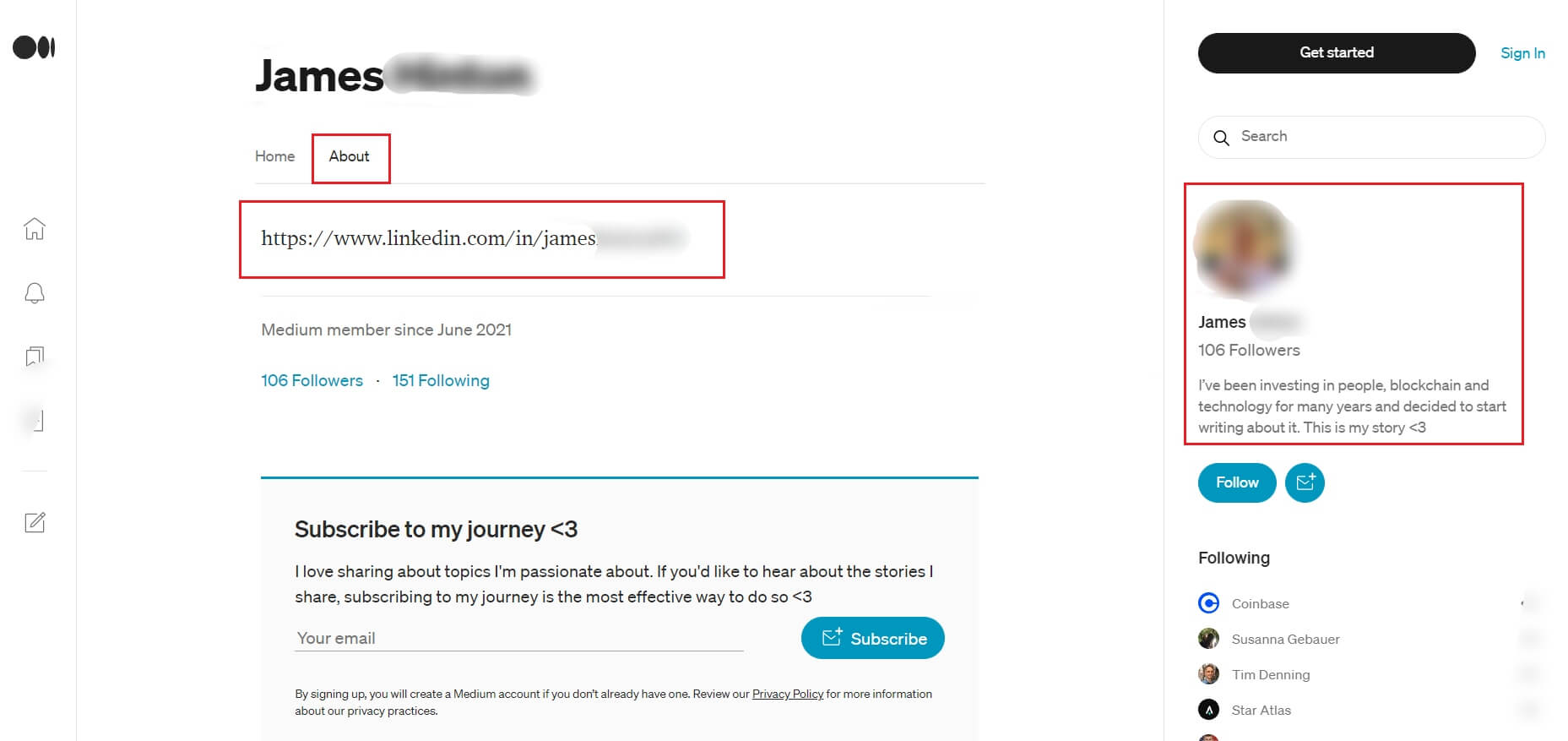
Additionally, you can see the comments and the profile of the person who posted that comment. Your sales leads could be one of them, so you can find them on LinkedIn and put them in your personalized document for further outreach.
23. Find leads on podcast guest lists
Use a simple Google search to find podcasts relevant to your industry or target market. Then, examine video titles and write down the speakers so you can find them on LinkedIn. Once you're ready to reach out to them, use personalized messages where you reference their podcast appearance and explain how your services can benefit them.
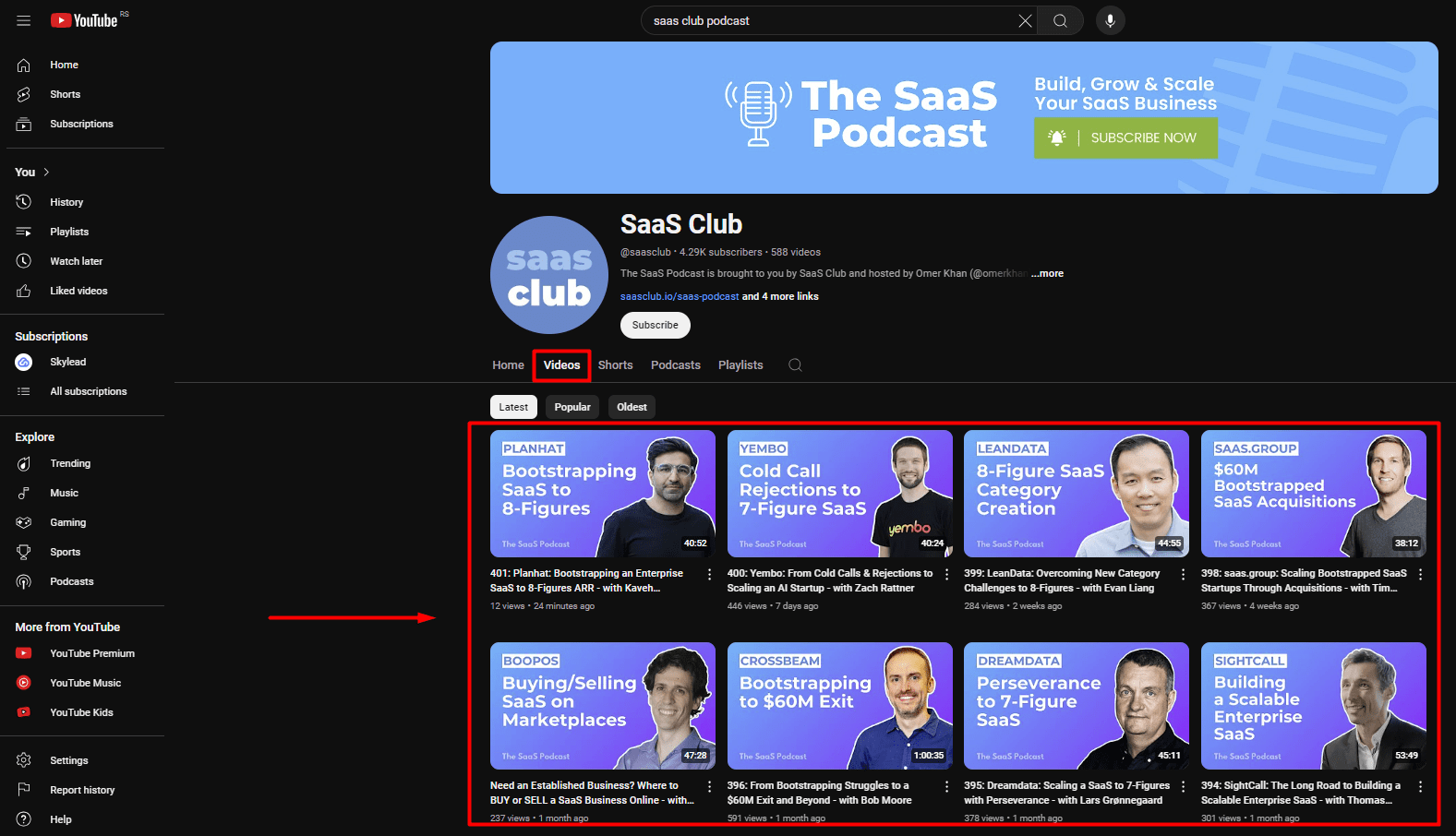
24. Find leads on Discord
Discord is a place where people can communicate with each other via either text or voice chat. Unlike Slack, Discord was initially created as an informal place to hang out with your friends or even play massive multiplayer online games.
However, Discord grew to be more. Now, it is a new hotspot where people all around the world gather to share their experiences and thoughts on all kinds of topics. Thus, many so-called servers, aka groups, have emerged, and you will be able to find the ones of your target audience.
For example, here is what the Salesforce discord channel looks like.
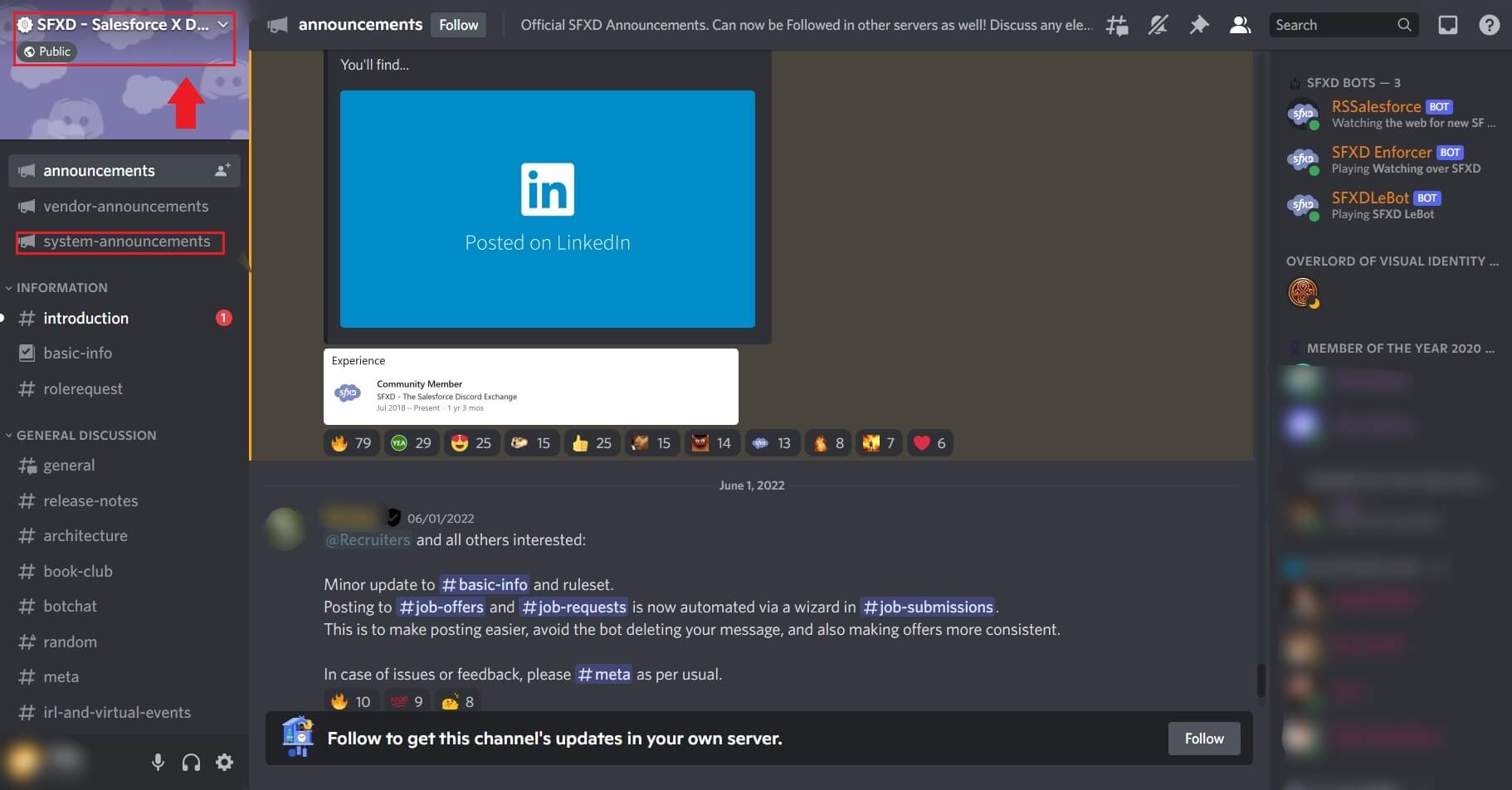
Once you find your niche, join that server, and you’ll get to see a list of all members you can message privately or ask to connect on LinkedIn and take it from there.
25. Find leads on forums and online communities
Online communities such as GrowthHackers or SalesHackers are another place where you can find sales leads. With plenty of topics to search from, you will be shocked by how many discussions and users you will find.
For example, the nice thing about the GrowthHackers community is that you can find the user, see their publications and topics they follow, and choose to follow them or contact them directly. You can also always find them on LinkedIn and reach out from there.
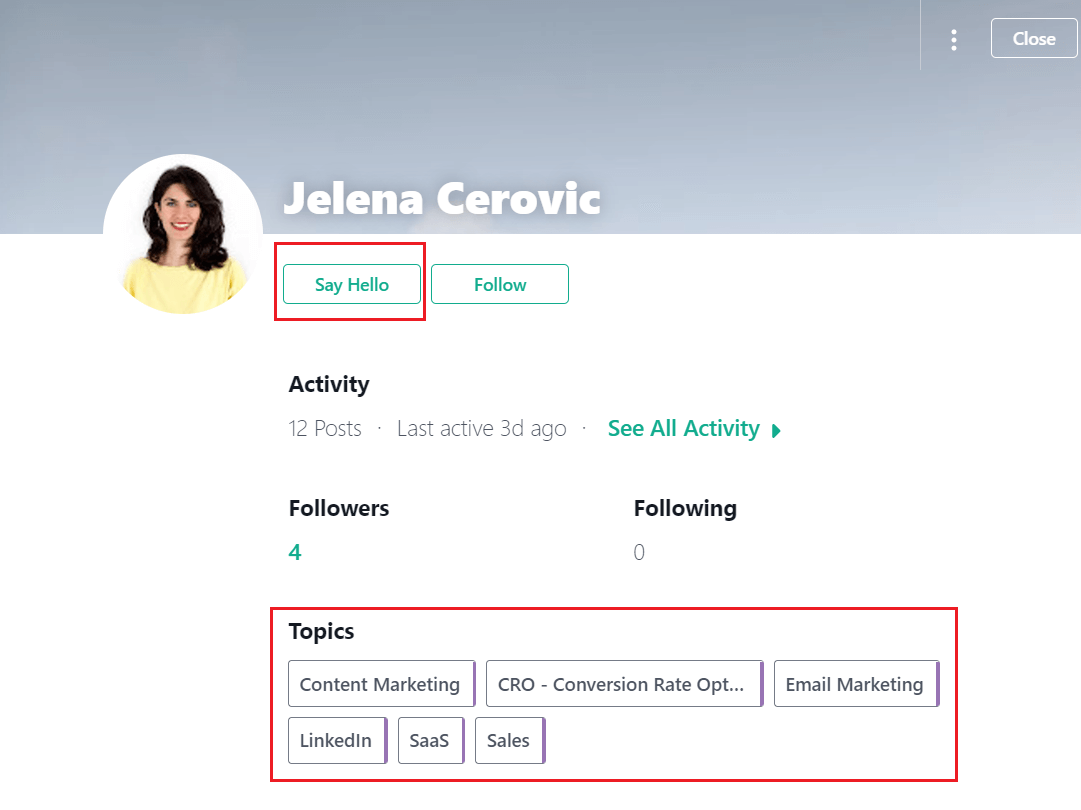
26. Find leads in LinkedIn groups
Despite the common belief, LinkedIn groups can still be useful for something - lead generation. To find leads in LinkedIn groups, you should look for relevant ones from your industry and join.
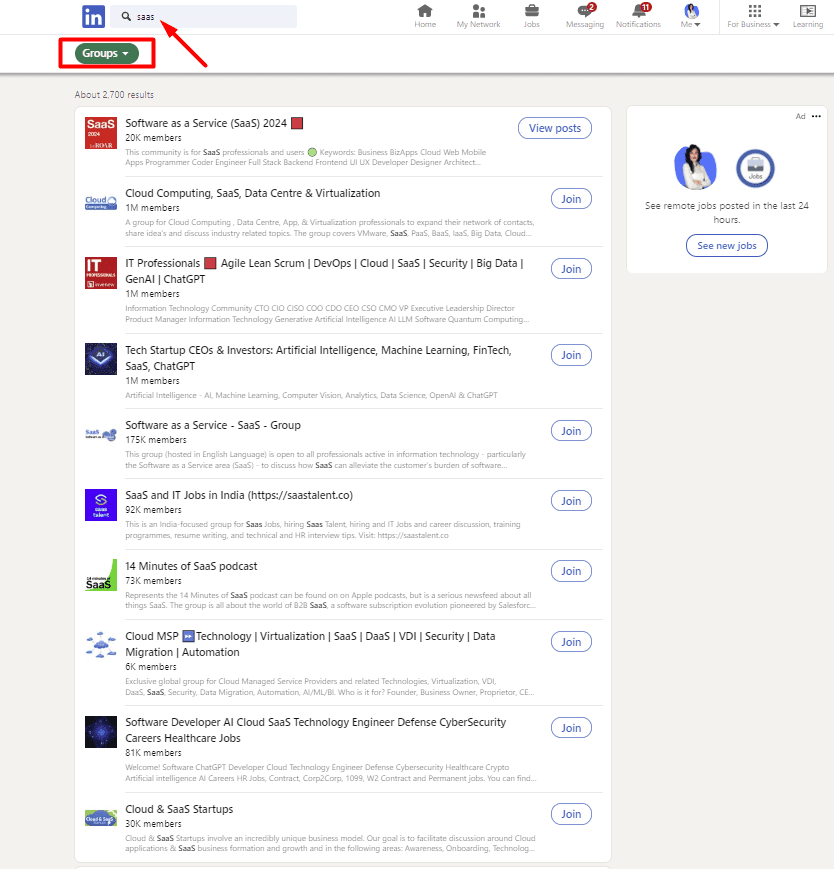
Once you join, you’ll get access to a members list. Click on “Show all.”
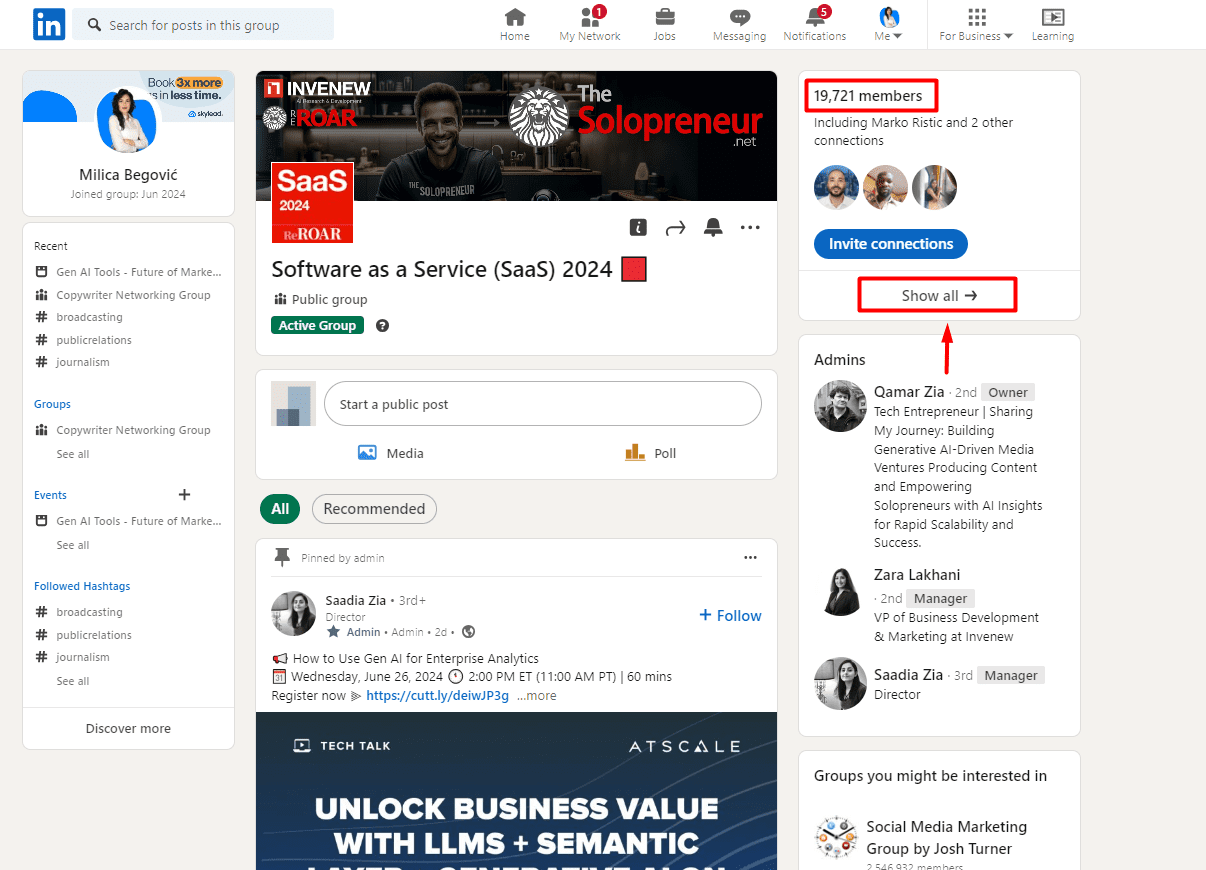
Then, extract the leads from the People section by copying the URL from your browser.
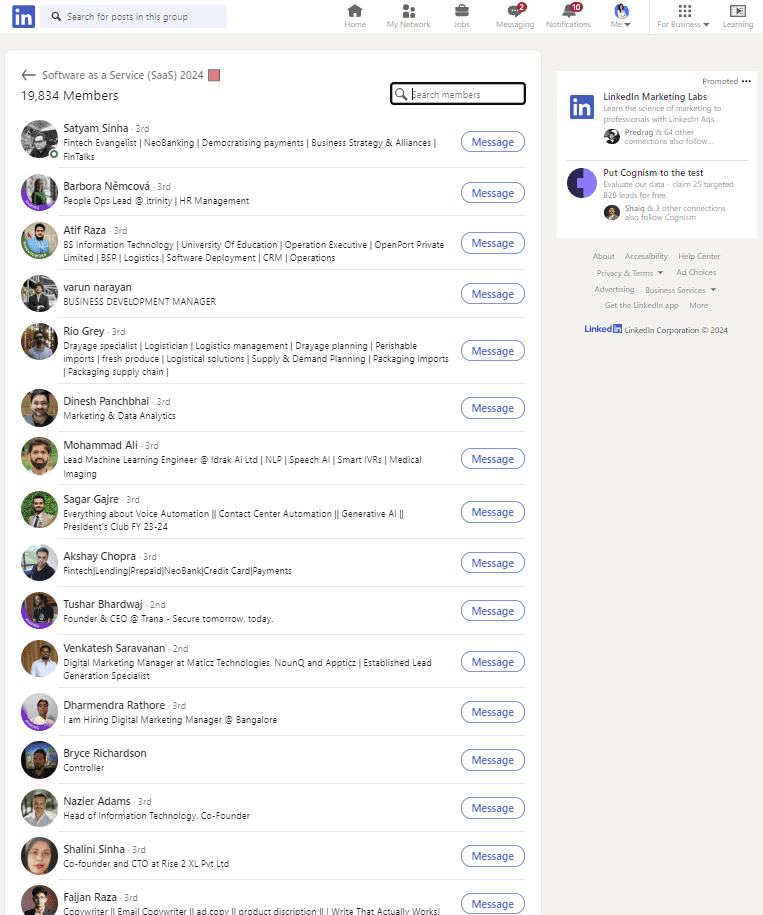
Now, this only works if you use Skylead to help reach out to these particular group members. Just paste the link and create a dedicated campaign for these group members only.
27. Find leads via LinkedIn posts
Lastly, you can also find leads via LinkedIn posts. For example, find a viral post on LinkedIn and go through the comment section and likes. Comb through them, find decision-makers, and put them in your personalization document. Here’s what that looks like 👇
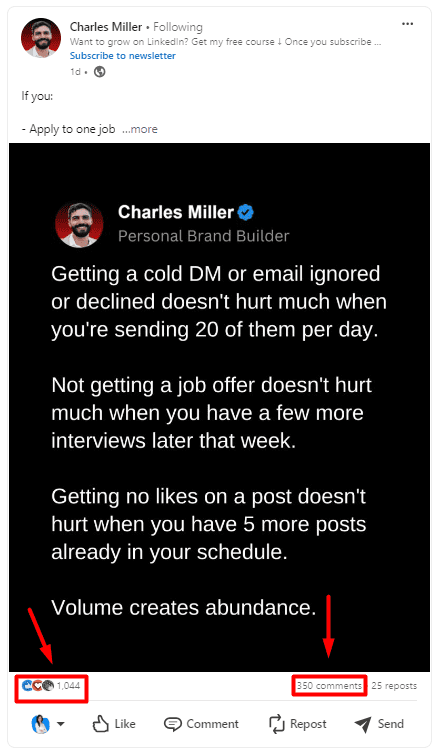
Once you click, this is what you’ll see:
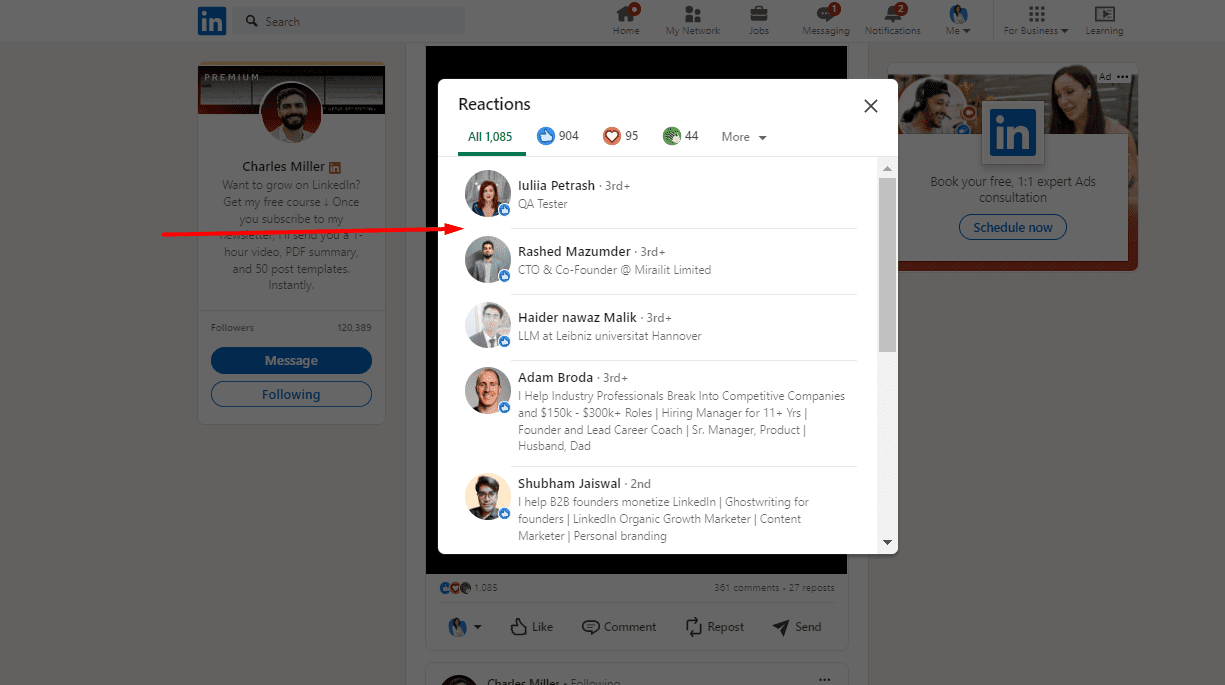
The next step is to use automation tools like Skylead to create an automated outreach campaign, and target leads from that specific post. Isn’t that amazing? Yes, we think so too. 😎 Here’s a connection request message example you can use in this case:
Hey,
I’ve noticed you liked this post on how volume creates abundance.
Just wanted to check what your thoughts are on the subject.
28. Find leads with LinkedIn polls
You can also use LinkedIn polls to attract and find leads. Just create a poll that has a relevant industry pain point, and once you get your replies, go through those people and reach out to them. It’s that simple. Here’s an example:
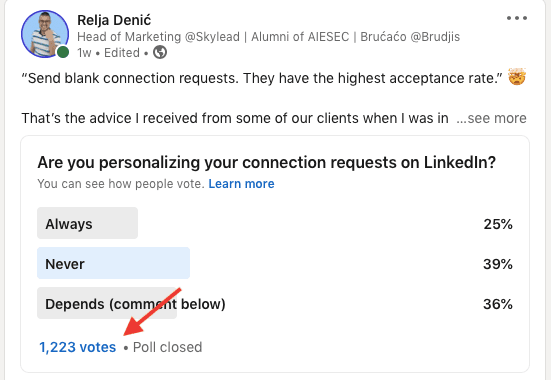
In this case, since users opted for one of three answers, we have three groups of leads: the ones who said "always," "never," and "it depends." You can adapt your outreach efforts to each answer group.
29. Find leads by discovering startups
If your ICP consists mostly of startups, you should visit websites such as ProductHunt, BetaList, AngelList, or Crunchbase. BetaList is the place for recently launched internet startups. It cleverly segments startups by industries, so you’ll find the one you need easily.
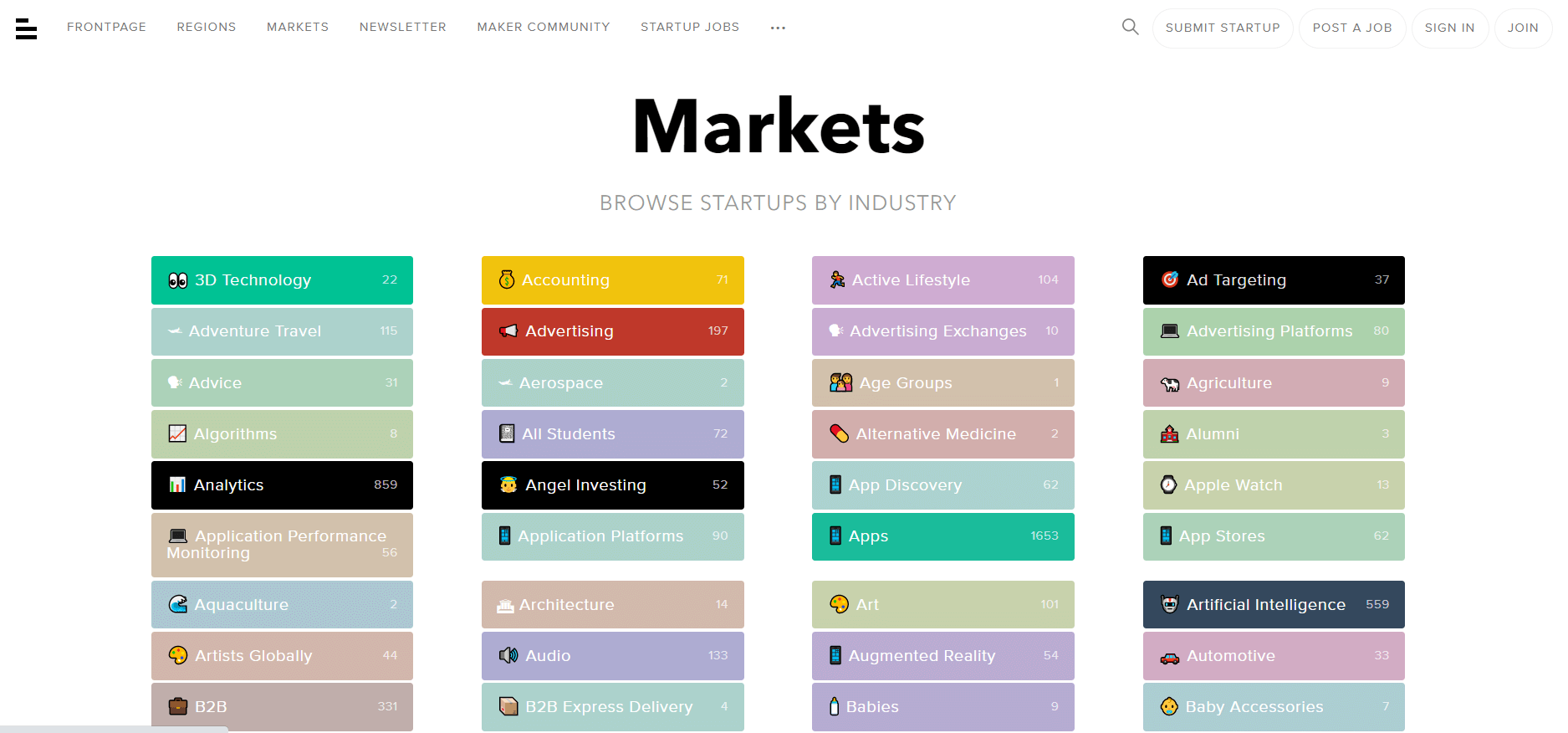
Another advantage is that you can contact the founder directly by finding their social media account on the profile listed beneath the company description or manually on LinkedIn.
30. Find leads by researching niche platforms
Not all companies are alike, and many niche businesses have buyer personas with unique jobs. So, it’s important to research and visit platforms where the target audience has a profile.
For example, if your target group is videographers or graphic designers, you would most likely visit Behance or Vimeo. On the other hand, if your sales leads are music artists, then SoundCloud is the place for you. Looking for developers? Give Github a try.
If, for example, you are selling an invoice management tool and need to reach out to freelancers, go to Upwork. The more information you have on your sales leads, the easier it will be to start the conversation. Here’s an example:
Hey,
I have seen the ratings on your Upwork profile, they are amazing.
I bet you get a lot of work as a freelancer. I was just wondering what tool you use for the invoice.
The possibilities are pretty much endless here.
Leads found, now what? Streamline your outreach to optimize time
Your leads are found, so now it’s time for outreach. To make it easier, you’ll need a tool that helps you organize, personalize, and send messages at scale. Skylead — a sales engagement and email outreach platform — is built to do just that.
Remember the personalization document with actionable data we mentioned earlier? This is where it comes into play.
To streamline the process and reach out to the leads you’ve manually researched, create a CSV file from the gathered data.
Skylead supports native variables for message personalization, such as:
- First name
- Last name
- Current company
- Years at current company
- Total career positions count
- Total years of experience
- College name
- Occupation
You can also add your own custom variables, such as a reference to a specific post, comment, or event where you discovered the lead, for a more personalized approach.customized intro that references how you’ve found them as a custom variable.
FAQs
How to find leads?
Identify potential customers through content marketing, social media engagement, and networking. Create valuable content, participate in discussions, and connect with prospects at industry events to generate interest and build relationships.
How to find B2B leads?
Use LinkedIn, industry associations, trade publications, and networking events. Leverage content marketing, email campaigns, and partnerships to attract and engage business clients.
How do I measure the effectiveness of each lead generation strategy?
To measure the effectiveness of each lead generation strategy, you need to track and analyze key metrics. Start by setting clear objectives for each strategy, such as the number of leads generated, conversion rates, and the quality of leads.
Tools like Google Analytics, CRM software, and marketing automation platforms are used to monitor these metrics. Look at the engagement levels, such as open rates and click-through rates for email campaigns or the level of interaction on social media posts. By comparing these metrics against your goals, you can determine which strategies are most effective and adjust your approach accordingly.
Can you provide examples of successful lead generation campaigns using these strategies?
Yes! A SaaS company used content marketing by creating a series of whitepapers and e-books targeting specific pain points in their industry. They promoted these resources through blog posts and social media, capturing leads through gated content forms. Another example is a B2B firm that utilized webinars and online events. They hosted industry-specific webinars, offering valuable insights and networking opportunities, which helped them gather high-quality leads.
A third example is a small business that leveraged email marketing and CRM automation. They segmented their email list based on customer behavior and engagement, sending personalized follow-ups and nurturing leads effectively, resulting in a significant increase in conversions. These examples highlight the importance of targeted content, engaging events, and personalized outreach in successful lead generation campaigns.
Ready to get those leads?
Now that you’ve seen 30 ways to find leads, it’s time for you to put your newly found knowledge to the test. Pick a couple of sources that hit close to home, and begin expanding your lead generation strategy.
Outreach away!
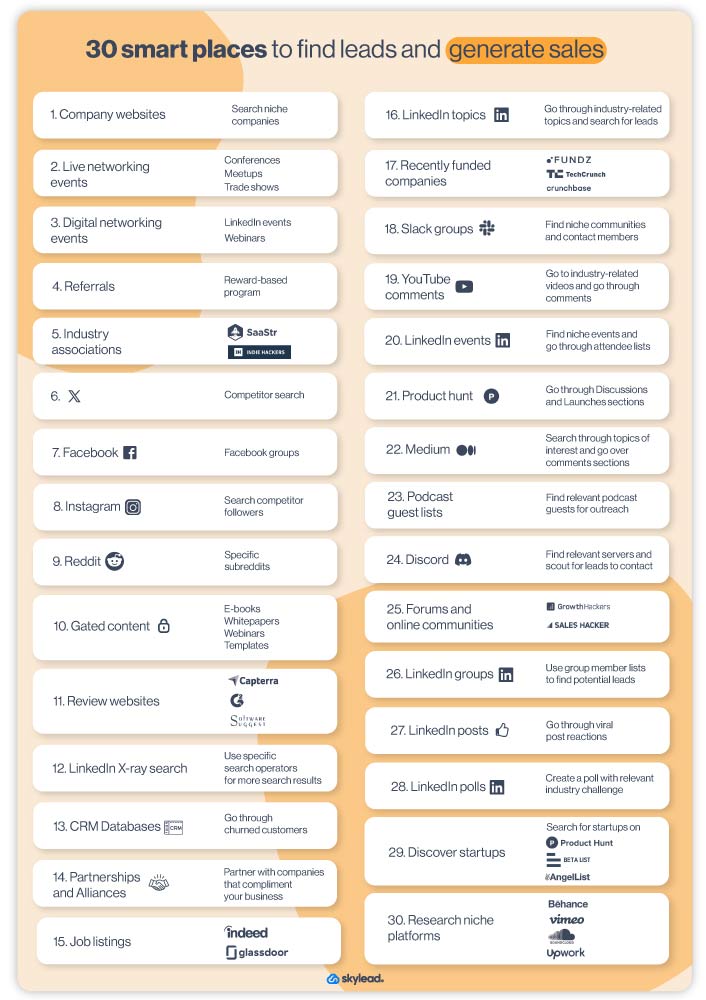
Disclaimer: Skylead is not affiliated, endorsed by, or connected with LinkedIn in any way.
Alongside your profile picture and LinkedIn headline, your LinkedIn cover photo plays a crucial part in your LinkedIn identity.
Not only does it contribute to your overall professional image, but it represents an important element in forming the first impression for your LinkedIn profile visitors.
As such, a LinkedIn background photo requires an equal amount of attention you would dedicate to any of the other sections of your LinkedIn header.
Therefore, in this blog, you’ll learn:
- How to change your LinkedIn cover photo for personal & company pages on desktop and mobile;
- The size of a LinkedIn background photo for personal & company pages;
- What online tools to use to craft a perfect LinkedIn cover photo;
- Top 17 LinkedIn cover photo ideas with real-life examples for any profession to make your profile stand out on the platform.
How do I change a LinkedIn cover photo?
Change LinkedIn background photo for LinkedIn personal profiles
On desktop
This is your LinkedIn background photo.
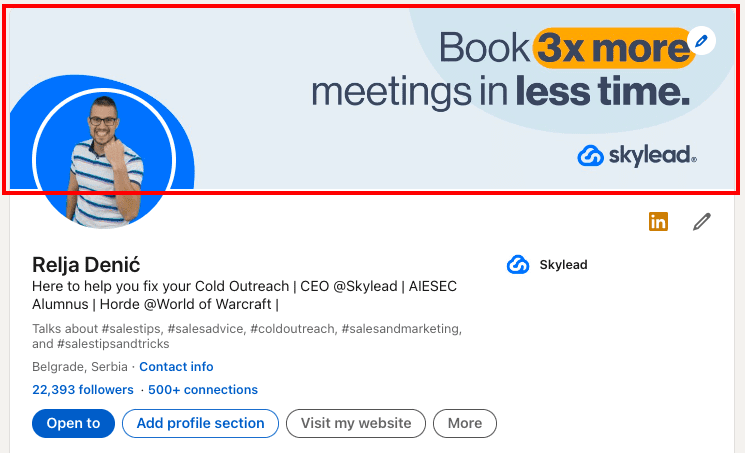
You can change it anytime and as many times as you wish.
#1 Click on the pencil icon in the top right corner of your LinkedIn profile’s header.
You will see two pencil icons, the lower one takes you to change your name, last name, headline, locations, etc., while the upper one takes you to change your LinkedIn cover photo.
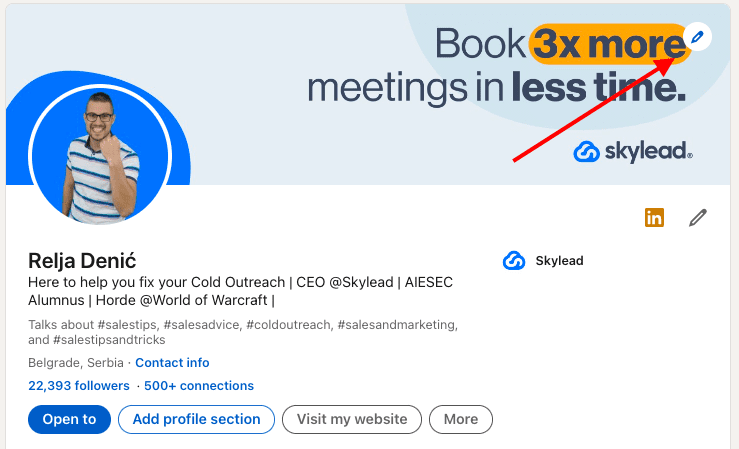
#2 Click on the Pen icon to access the LinkedIn background photo editor.
Here you can:
- Upload a new cover photo,
- Crop it,
- Apply filters,
- Adjust brightness,
- Rotate it,
- Zoom it, etc.
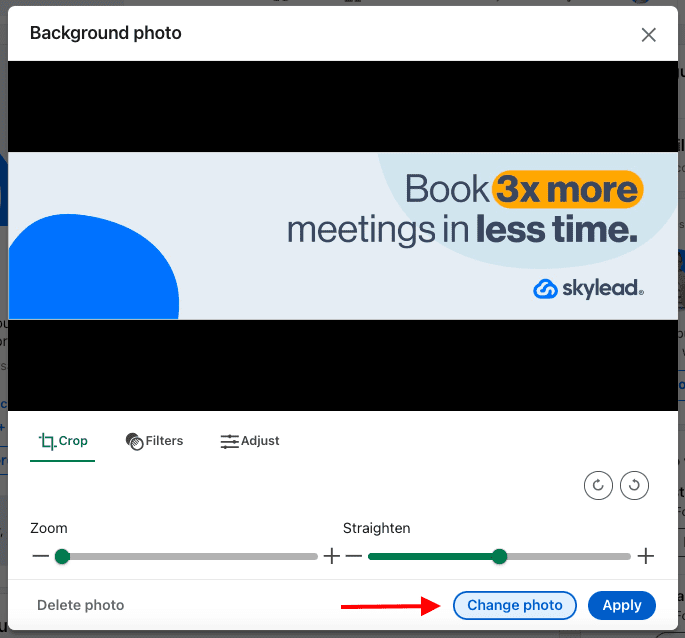
By clicking the Adjust icon you can make additional corrections to your image, such as
- Brightness
- Contrast
- Saturation
- Vignette
On mobile
To change your LinkedIn background photo on mobile, go to your LinkedIn profile page and click the Pencil icon in the top right corner.
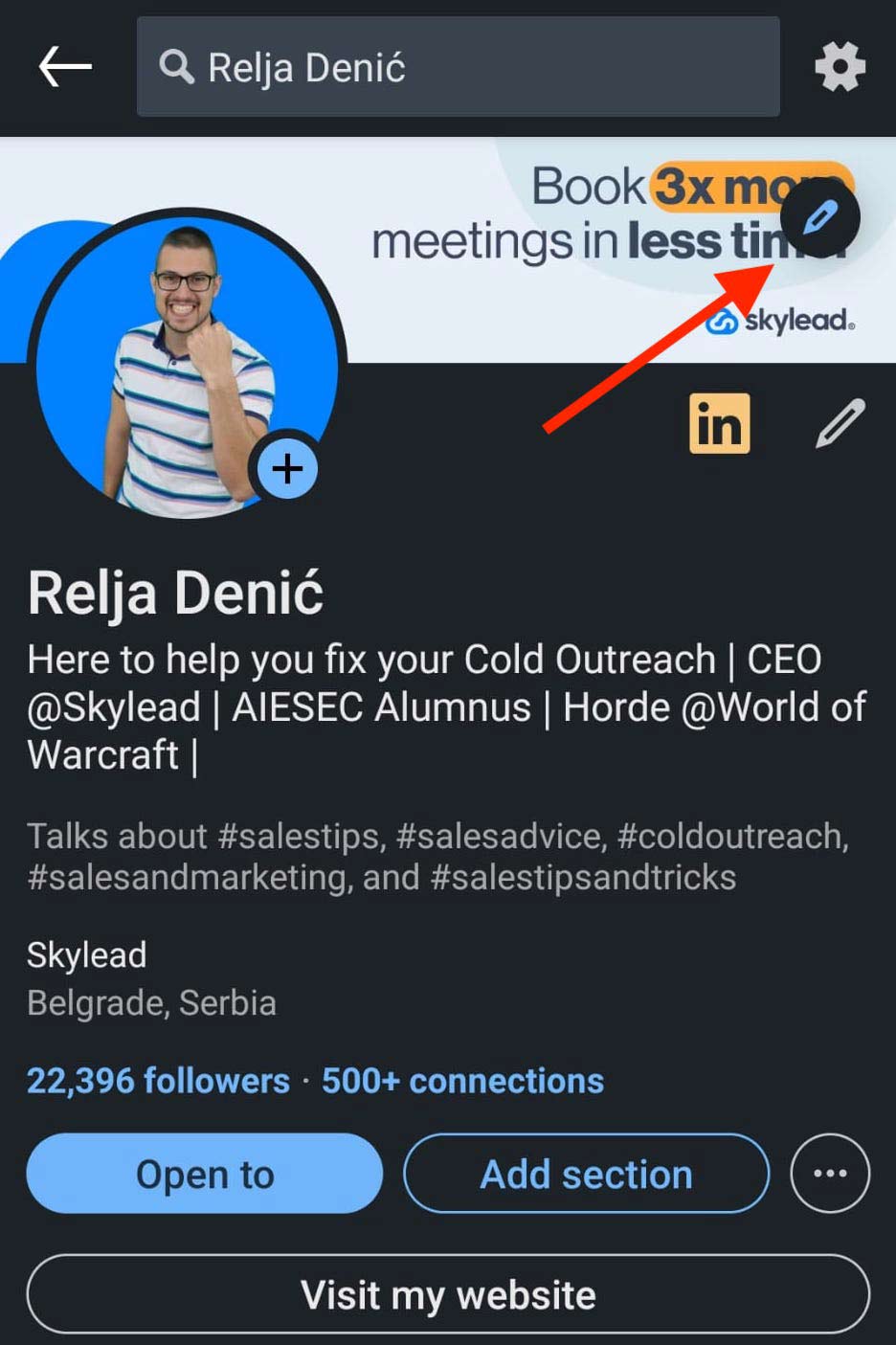
#2 In the bottom, you’ll find the options to edit, add a photo, or delete the existing one.
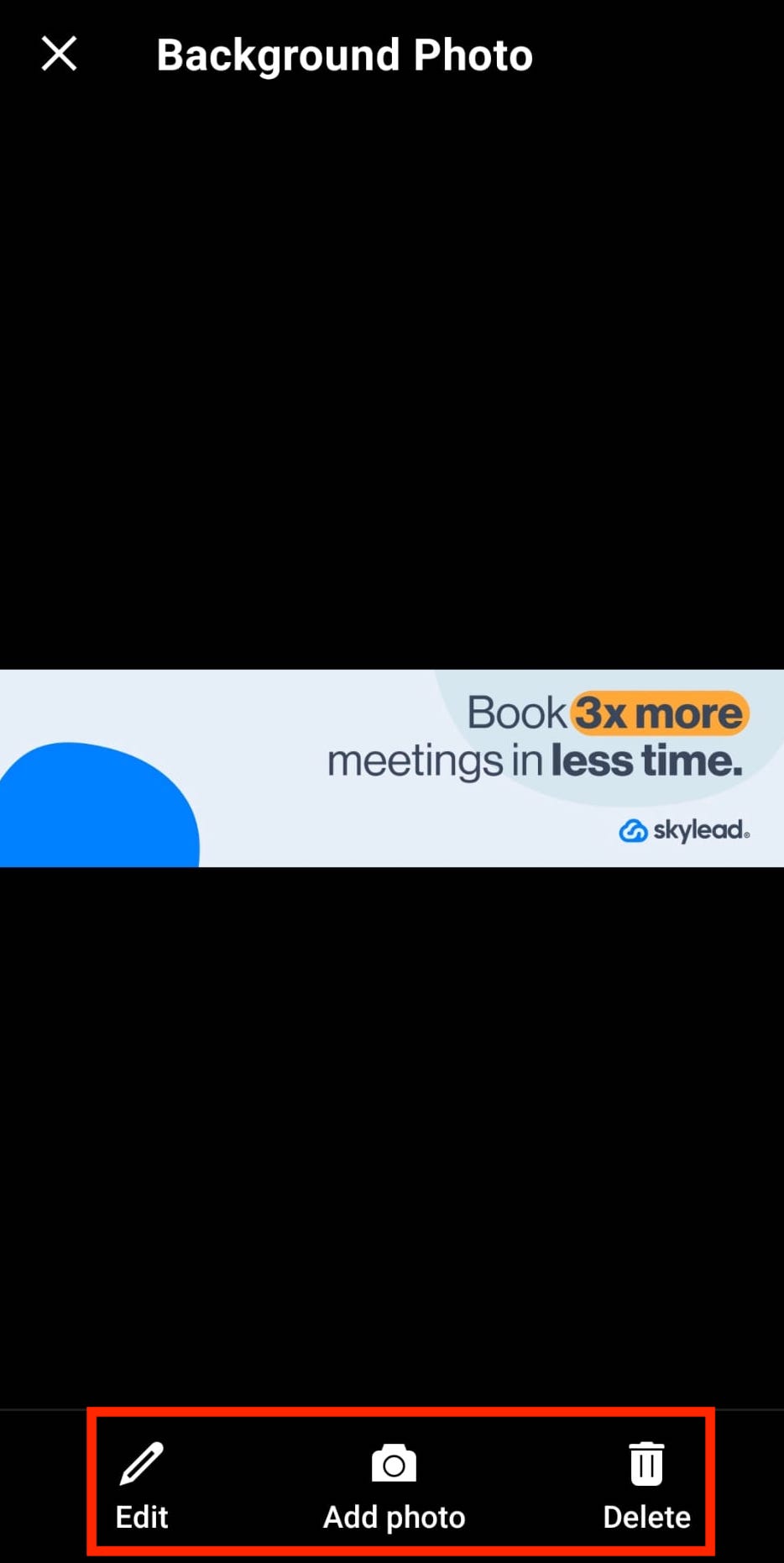
#4 Once you’ve uploaded the photo, you’ll get the same editing options as on the desktop.
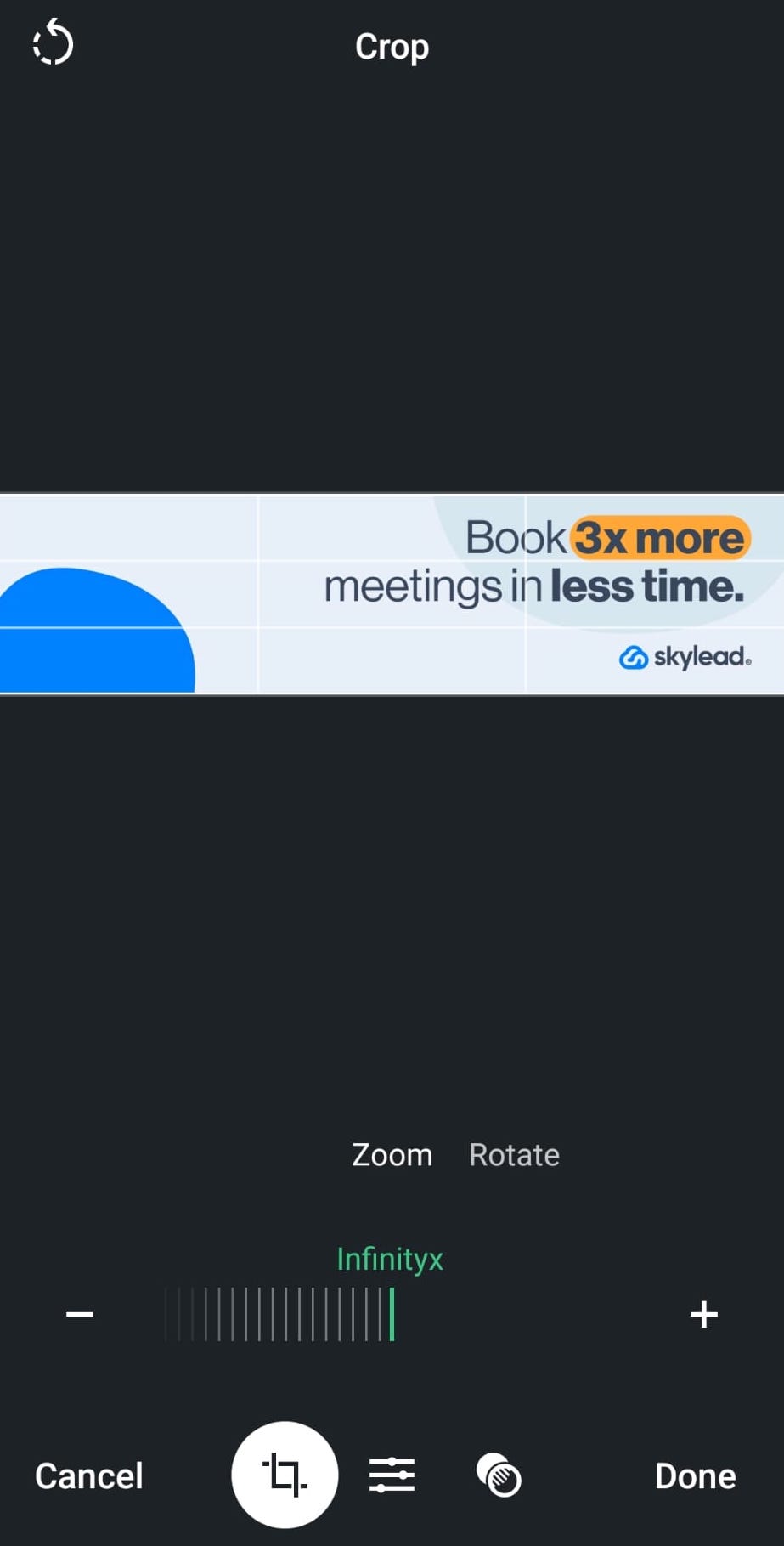
Change LinkedIn background photo for LinkedIn company pages
On desktop
To change the LinkedIn background photo on your LinkedIn company page, you must either be the page’s admin or be given access to the page with editing permissions.
Then, go to the LinkedIn company page you’re managing, and click the Pen icon here.

You will get a dropdown menu to:
- Upload a new cover image (check out LinkedIn cover photo size recommendations in this blog’s next section)
- Adjust the current cover image;
- Or, delete the current cover image.
Once you upload a new LinkedIn banner for your company page, or if you click to adjust the current one, the LinkedIn cover image editor will give you options to:
- Upload a new cover photo,
- Crop it,
- Apply filters,
- Adjust brightness,
- Rotate it,
- Zoom it, etc.
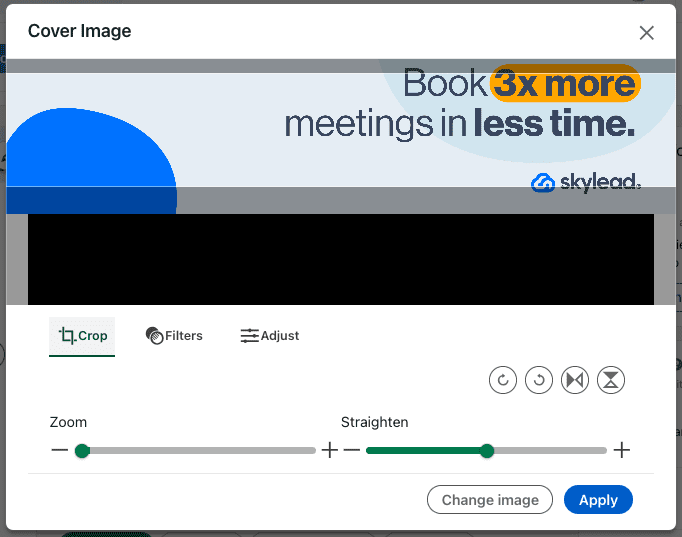
Also, by clicking the Adjust icon you can make additional corrections to your image, such as
- Brightness
- Contrast
- Saturation
- Vignette
What is the size of a LinkedIn cover photo?
In 2026, a LinkedIn cover photo size for personal profiles should be a maximum of 1584 x 396 px and a minimum of 1192 × 220 px, up to 8MB, and in JPEG, GIF, or PNG file formats.
When it comes to LinkedIn cover photo size for company pages, LinkedIn recommends a size of 1128 x 191 px, which is at the same time the minimum size, up to 8MB, and in JPEG, GIF, or PNG file formats.
Also, another thing to bear in mind is that LinkedIn cover photos are cropped differently on mobile and desktop devices. So, make sure to view your profile on both kinds of displays when setting up a new LinkedIn background photo. You don’t want important parts of your banner to be hidden or simply look bad.
Luckily, there are many online tools to help you make an ideal LinkedIn cover photo, and you don’t even need to be design-savvy.
Where can I find LinkedIn cover photo templates?
Nowadays, many online design tools have templates specifically for LinkedIn - such as posts, profile images, and background photos that require very little editing to look good.
Otherwise, if you wish to put in more effort, there are websites with free or paid stock images, or you can consider hiring a designer or someone design-savvy to do it for you.
Start with these.
| paid stock image websites | free stock image websites | online graphic design platforms |
| iStockphoto.com | Vecteezy | Canva |
| Shutterstock.com | Freepik | Fotor |
| Envato.com | Morguefile | VistaCreate |
| Depositphotos.com | Pixabay | Freepick |
| StockAdobe.com | Stockvault | |
| Pexels | ||
| Picjumbo | ||
| Pikwizard | ||
| Rawpixel | ||
| Reshot |
In our next section, you will find 10 ideas on different types of LinkedIn cover photos depending on the message you wish to get across with it.
Top 17 LinkedIn Cover Photo Ideas For Any Profession
As mentioned above, your LinkedIn background photo should complement your profile picture and headline and offer clarity on what your business is all about to your profile visitors already through the LinkedIn header section.
However, this doesn’t mean that you have one solution only.
Here’s a list of 17 LinkedIn cover photos that represent good practices with real-life examples.
Highlight your customers’ goals on your LinkedIn background photo
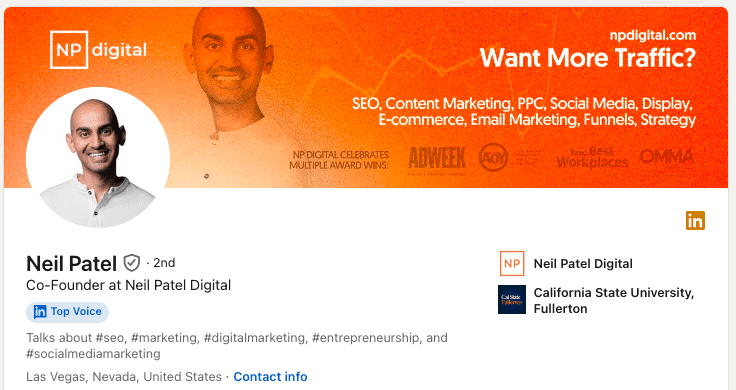
An excellent way to draw attention to yourself is to highlight your client’s most common pain point or ask a question that you know they’ll answer affirmatively.
Of course, it should relate to your service and a pain point your product or service can solve.
Make sure you communicate these messages clearly and include an important award or some kind of social proof (if any).
Showcase the people you serve on your LinkedIn cover photo
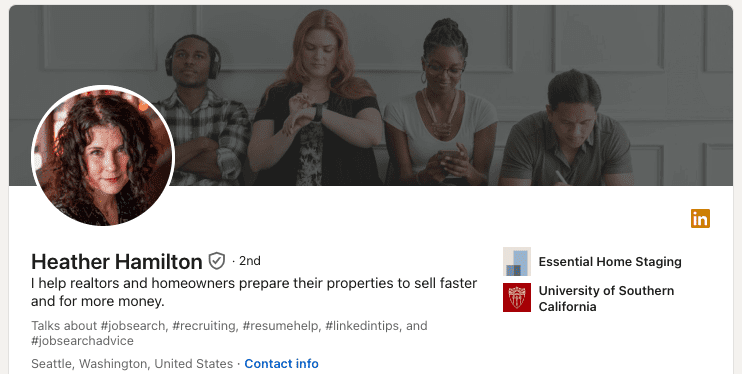
Featuring your customers is beneficial because people who visit your LinkedIn profile know right away if they potentially fall into that category.
Additionally, people are more drawn to images of real people, faces, and their expressions, so a LinkedIn cover photo of this kind will make them want to investigate further.
A LinkedIn background photo that showcases your clientele or your target clients doesn’t need to be their actual photo, of course. You can get a stock image that features people who are good examples of the types of people you serve.
Use the location or the location of your business on your LinkedIn banner
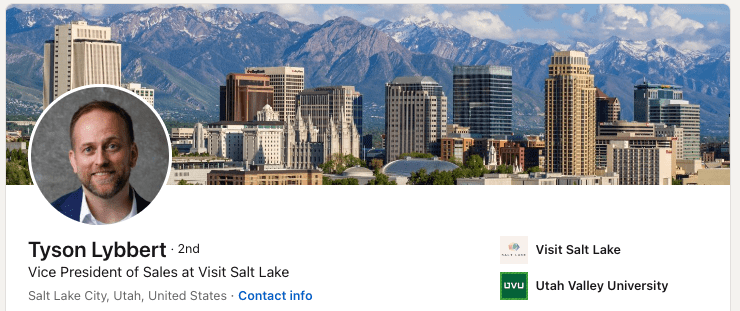
OR
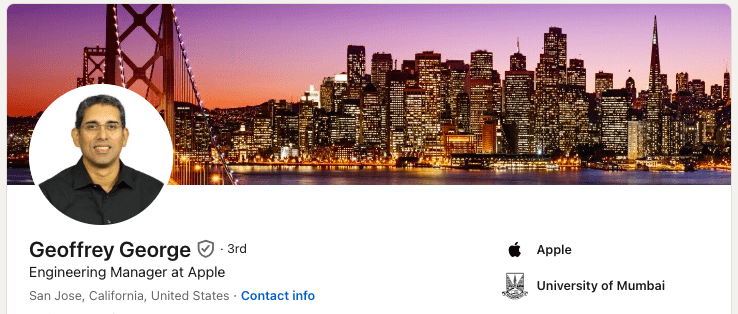
Highlighting the location of your business makes sense if what you do is restricted to a specific area or it’s particularly significant for it.
These types of LinkedIn cover photos don’t have to be necessarily limited to industries such as tourism for example. Still, they can be applied to any business or industry that acts locally.
On the other hand, displaying the city where you work or where you came from or that is particularly dear to your heart independently from the location of your business can ‘humanize’ your LinkedIn profile a bit.
Just because LinkedIn is a professional network whose members are encouraged to connect, network, and chat in the name of business, that doesn’t mean you should hide that you are a human before anything else. People are more likely to work with those whom they can connect with, rather than robots.
Put your hobbies or interests on your LinkedIn cover photo
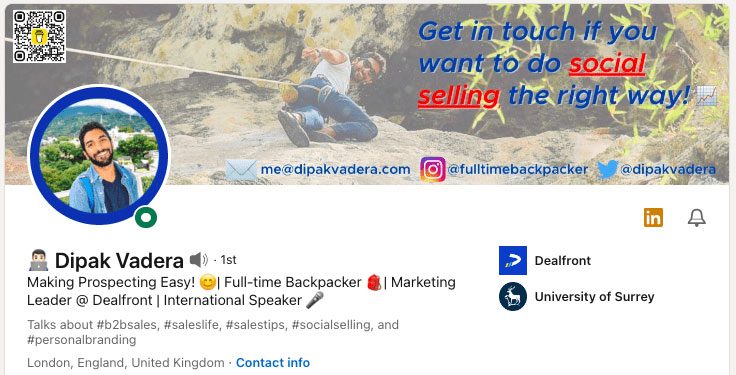
Speaking of ‘humanizing’ your LinkedIn profile, there’s no better way to do it than sharing something that interests you outside of your work schedule.
You could use your LinkedIn background photo to tell others about your hobbies, volunteering activities, or any kind of extracurricular activities. Opinions on sharing personal pictures on LinkedIn vary, given the platform’s professional nature. However, if the sharing is genuine, not excessive, and comes from a desire to build authentic connections, we say go for it.
No matter if you’re on LinkedIn to network, get clients, or find a job, everyone likes to see there’s more to you than just your professional, online self.
Display objects or tools relevant to your job on your LinkedIn background photo
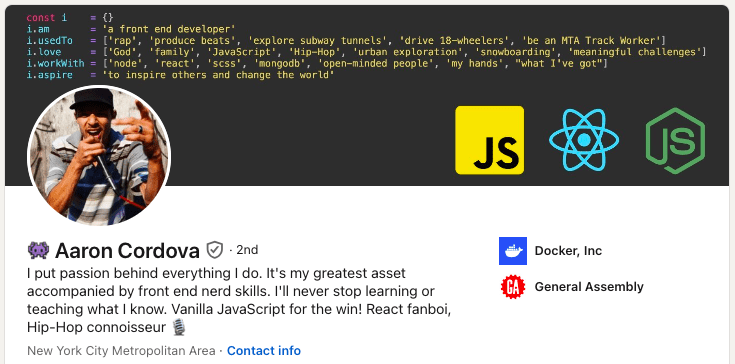
Featuring an object such as a photo camera if you are a photographer can seem a bit ‘unsurprising’ but it doesn’t need to be! Just look at how creative, yet informative the above LinkedIn cover photo is.
Without even reading through this LinkedIn user’s profile, you can understand what he does for a living and what technologies he knows (JavaScript, React, NodeJS).
Furthermore, he adds a personal touch to his LinkedIn background photo by mentioning the things he loves, believes in, and does outside his regular working hours.
This type of LinkedIn cover photo is excellent for freelancers and people who are searching for a job, as it says straight off the bat what your professional strengths are.
Use a LinkedIn cover photo of you doing your work
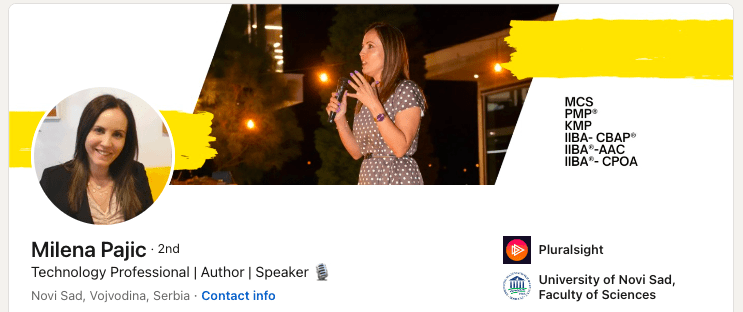
A picture of yourself doing your work can be a great choice if your job is actually some kind of service that can be presented clearly in a photo.
On LinkedIn, usually, these types of LinkedIn cover photos are typical for motivational and public speakers, or for those who want to highlight them speaking in front of larger audiences.
It doesn’t mean that it will not work for other industries as well, just put your creativity to use and make sure you have someone to take a good shot of it.
Clearly state what your job is on your LinkedIn banner
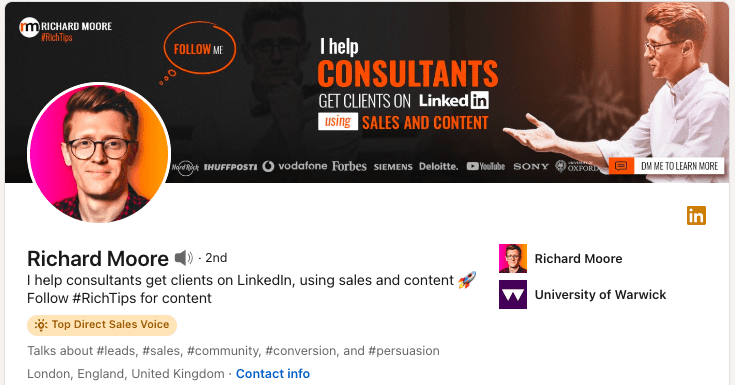
OR
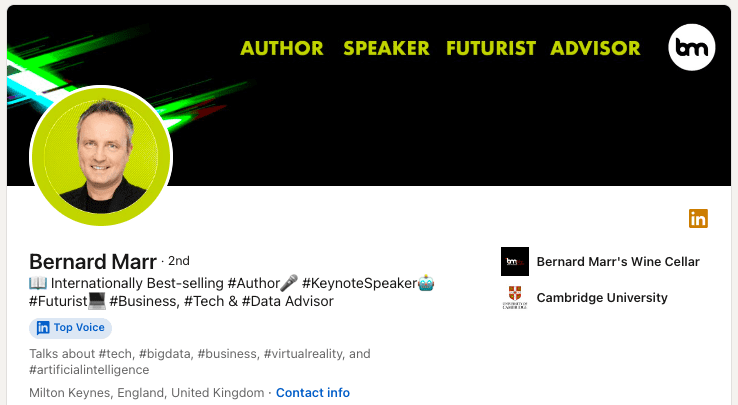
This is a pretty straightforward, nothing-too-crazy yet effective way to make it very clear to your LinkedIn profile visitors what you do for work.
As you may see from the above examples, you can describe what you do (example #1) and how you do it, or simply list your professional roles (example #2).
This way, it is very clear what your business is about to whoever lands on your LinkedIn profile.
Showcase your product or service on your LinkedIn background photo
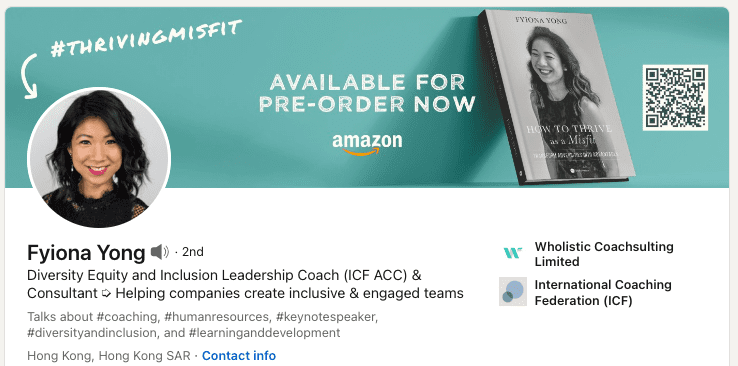
This is a pretty straightforward, yet effective way to tell your profile visitors what you are all about in general or at the moment. Furthermore, it is a great way to promote a book, podcast, service, you name it.
As you may see from our examples, displaying your product or service could be accompanied by a catchy Call-To-Action.
Display your career path on your LinkedIn cover photo
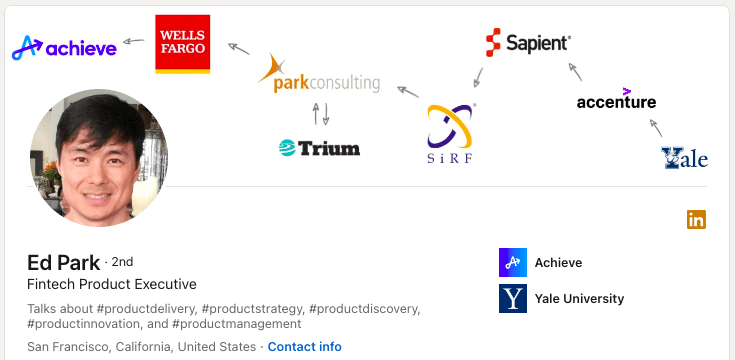
If you find your career path to be the most valuable part of your curriculum or your valuable unique selling point, here’s a creative and smart idea of how your LinkedIn profile visitors can learn all about it.
This LinkedIn member decided to display his path from a college to the company for which he currently works. However, this creative idea can be applied in many ways depending on what you wish to highlight in your LinkedIn background photo.
Use your company’s LinkedIn cover photo for your personal LinkedIn background photo
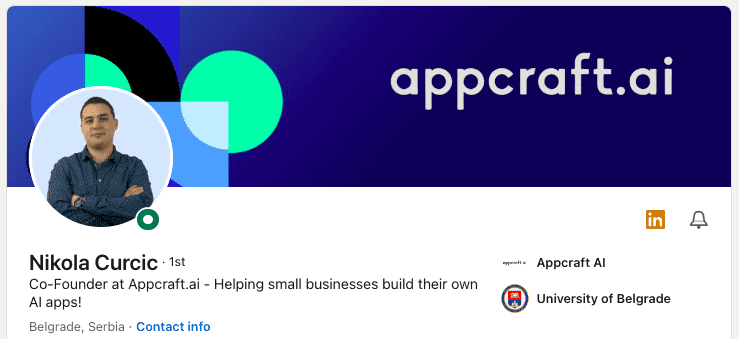
OR
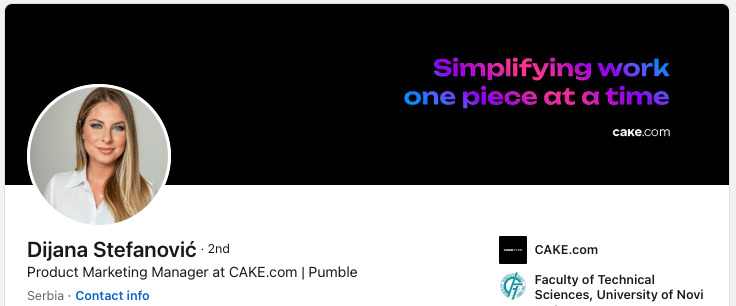
Some companies have LinkedIn cover photos designed specifically for their employees. This can be the simplest way to tell your profile visitors where you work right off the bat.
Featuring a LinkedIn background photo with just your company’s logo or some other kind of visual representation of your company can be a good choice if you feel strongly about the brand.
Furthermore, your company’s LinkedIn cover photo can contain a mission statement, values, or any message that your brand wants to get across.
Put an inspiring quote on your LinkedIn banner

An inspirational quote on your LinkedIn background photo can refer to something you personally believe in, or it can have to do with your brand.
If combined with an attractive design, this type of LinkedIn cover photo can be pretty effective and inspiring to people visiting your LinkedIn profile to investigate your services further.
Put a picture of an office space or a building for corporate, executives, legal, & similar to your LinkedIn cover photo
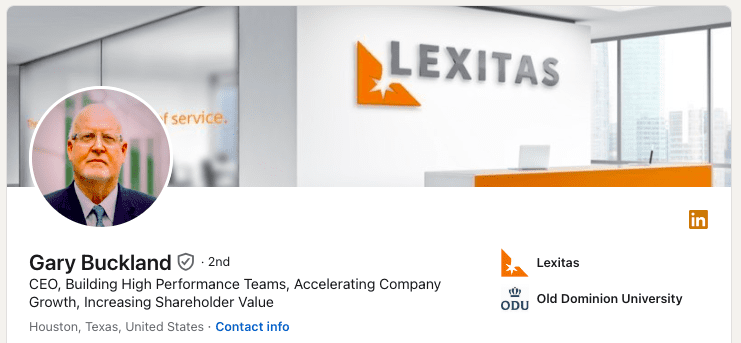
OR
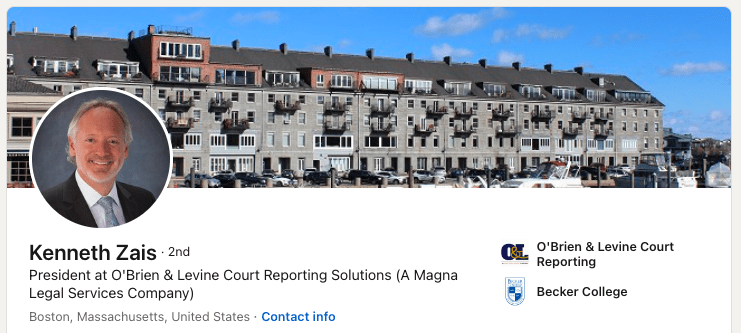
The above example is a good LinkedIn cover photo of people working in corporate, upper management, legal, and anyone who finds their business space to give off the impression of professionalism, a specific status symbol, high-level service, or similar.
Furthermore, if your office is a well-known building, or it has been there for ages so that it even become part of the city's history, displaying it in your background might give your LinkedIn profile visitors a sense of familiarity.
Make your LinkedIn banner a collage

Finally, you can make a collage visually representing your interests, product or service, target audience, yourself while doing your work, or pretty much anything you wish to showcase on your LinkedIn cover photo.
However, keep in mind that crafting appealing collages is not as easy as it might seem – they should be informative without becoming cluttered or chaotic. Therefore, unless you are a skilled visual artist, you might want to hire a designer to do it for you. Collages are pretty effective, so it could totally be worth it.
Summary
Before diving into choosing your ideal LinkedIn cover photo, consider your focus — clients, yourself, workspace, or tools.
Which emotions do you wish to convey? Empowerment, trust, professionalism?
What kind of LinkedIn background photo would enhance your professional image while aligning seamlessly with your brand?
This strategic approach ensures your LinkedIn presence resonates effectively with your target audience and lays the foundation for effective sales engagement once those profile visits turn into leads. Speaking of sales engagement, why not use Skylead to save up to 11 hours a week on it? All features are available for a 7-day FREE trial starting today! Don’t miss out!
Disclaimer: Skylead is not affiliated, endorsed by, or connected with LinkedIn in any way.
Everyone is talking about the Social Selling Index and with good reason. LinkedIn SSI score came into our lives to explain and answer our questions like why my posts have fewer impressions, what I am doing wrong in my outreach, and how my LinkedIn profile can get more integrity in the eyes of the algorithm. Moreover, social selling leaders have 45% more sales opportunities than the ones with a lower LinkedIn SSI score.
That said, if you haven’t already, it’s best to jump into this story and boost your LinkedIn SSI score immediately. However, if you don’t know where to start or what to improve first, don’t despair. We are here to give you tips and pointers from our first-hand experience on improving your LinkedIn SSI score and making this platform work to your advantage.
What is the LinkedIn SSI score?
Social Selling Index is LinkedIn’s measurement of how effective you and your profile are at building your brand. In other words, finding the right people, engaging with insights, and establishing relationships.
Users with a higher LinkedIn SSI score are better positioned to become thought leaders, do LinkedIn lead generation and therefore more likely to succeed in closing the deal. This is LinkedIn’s way of awarding those with high social selling skills.
Where to find LinkedIn SSI score?
SSI is available to everyone, whether using a free or paid LinkedIn account. (If you are not sure where to find it, copy and paste this 👉 www.linkedin.com/sales/ssi in your browser’s search engine. Go ahead and check it. This is your first step towards knowing what you are doing right and what needs a little extra push.
This is what you can expect.
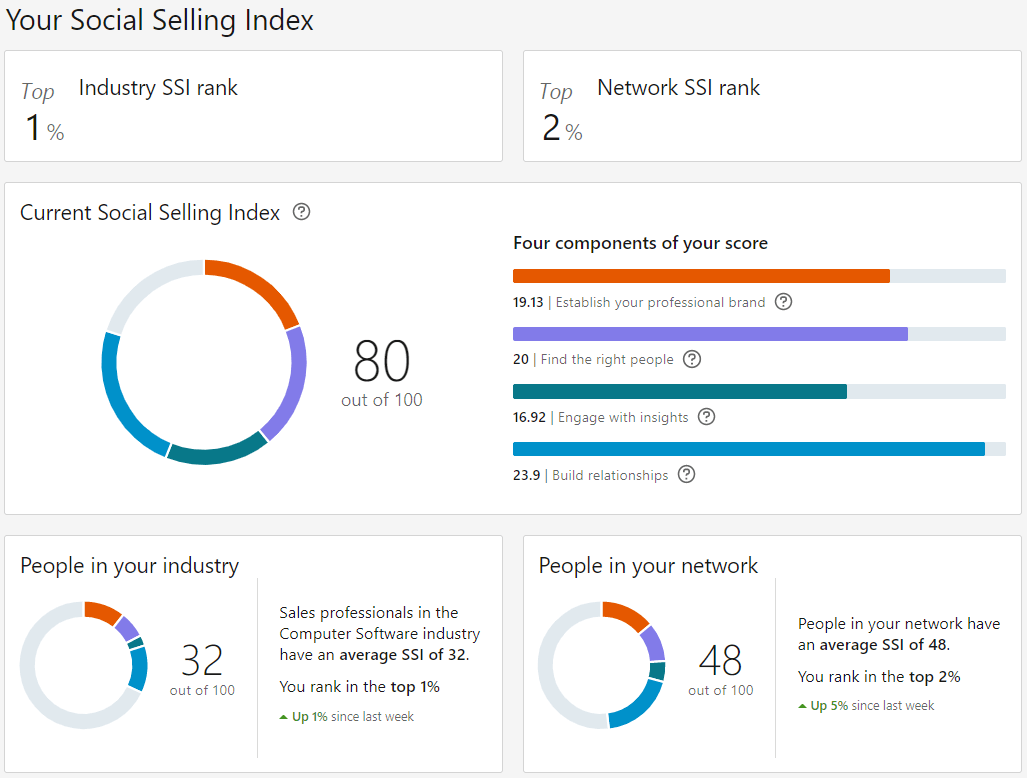
Founded on the above four sections, LinkedIn SSI score shows your success as a salesperson and how effectively you are using the platform.
Each of the segments can grow up to 25 points, with the total score anywhere between 0 and 100. This implies that all four sections are equally valued when measuring your Social Selling Index on LinkedIn.
Tips to increase LinkedIn SSI score
Tip #1: Complete your LinkedIn profile
If you want to boost your personal brand and Social Selling Index, you need to first complete your LinkedIn profile.
Yes, your personal brand starts with a neat and complete LinkedIn profile. The way you communicate with your leads, the way you nurture them, the type of content you post, they all add up. But first and foremost, your profile.
It’s just like in the real world. It takes only a few seconds for someone to form the first impression. And they get attracted or rejected by your looks, not your brains. Sorry, it’s just the way it works.
That said, there are many steps that you can follow to improve the Social Selling Index pillar #1 “Establish your professional brand”. Here is what we did and saw an immediate increase in SSI:
- Upload a professional profile picture that gives the impression of you being a reliable, yet approachable expert in the field.
- Write a catchy LinkedIn headline that sums up what your career is all about.
- Dedicate time to a summary that will make your profile stand out and grab the visitors’ attention.
- Fill out your professional achievements, but don’t overwhelm us. It’s like sending a CV to a recruiter. Only career highlights, please.
- List your fortes.
- Ask for recommendations (from people you worked and had a close bond with).
- Endorse others and others will endorse you. The law of reciprocity rocks.
While striving to fully complete your LinkedIn profile, always have in mind the keywords you would like to be connected with and searched by. Just like you are optimizing your content to show up on Google, you are optimizing yourself to show up in your leads’ search engines.
If you’re still unsure how to set up your entire profile, check out our masterclass. 👇
Tip #2 Find the right people
Speaking of search engines, who is showing up in yours?
As mentioned above, LinkedIn was created to suit business needs. Not personal. Read that again.
Don’t invite people to connect because you like their looks. There are other platforms designed for that.
For you to improve the LinkedIn SSI score pillar #2 “Find the right people”, focus on expanding your network according to the following parameters:
- People you already know in person.
- Users that are from the same industry, are industry thought-leaders, or share an interest in the same industry as you.
- LinkedIn members from adjacent industries.
- Audiences that you think (or even better: you researched) would be interested in your product or service.
Fortunately for all of us, LinkedIn has developed plans, each of them with different perks, depending on what you’re expecting from the platform.
LinkedIn Premium Business, for example, has the same filtering options as LinkedIn basic. However, it does give you unlimited profile search and views, together with 15 Paid and 800 free monthly LinkedIn InMail credits.
On the other hand, Sales Navigator, designed in particular for salespeople, has numerous other options that will make your life easier while searching for that perfect lead. Aside from Sales Navigator advanced filters, it has Lead Lists, Saved Searches, and 20 Paid and 800 free monthly InMail credits.
You can improve the quality of your network and leads by:
- Checking out LinkedIn groups of your interest.
- Reaching out to people attending a certain LinkedIn event.
- Using the Boolean Search to narrow down your audience with more precision.
Tip #3 Engage with insights
Don’t just stand there looking good. Say something. Post on LinkedIn and share your vision with the community. Don’t be afraid to speak up, as the world is full of people thinking differently. Luckily for you, there is plenty of fish in the sea and you will for sure find like-minded users. If that’s what’s worrying you.
For the LinkedIn algorithm to like you and for your Social Selling Index pillar #3 “Engage with insights” to grow, you need to:
- Post engaging and valuable content.
- React and comment on other people’s posts.
- Reshare what you find worthy of resharing.
LinkedIn SSI score is not the only one benefiting from your engagement with insights.
LinkedIn pushes people who give value to the platform by sharing their insights, encouraging constructive criticism, and starting meaningful conversations. These users come up in the search results more often and get more exposure in comparison to inactive users.
That said, make every post count. From our experience, here is what made a difference:
- Providing value,
- And offer a solution to a pain point our network is struggling with.
By engaging with insights, you are telling people who you are and what you stand for. Consequently, you will start being surrounded by like-minded people.
A LinkedIn post can be an excellent source of leads. People who react and comment on a certain topic from your or your target industry are apparently interested in the subject. And are all gathered at one place, making it easy for you to reach out to them. Not to mention, making a reference to a certain post is a serious game-changer when it comes to acceptance rates.
Tip #4 Expand network and create relationships
You can have 500+ connections and not stand out as a particularly “engaging” member of the LinkedIn community.
If you just had a LinkedIn profile long enough and behaved professionally, you are likely to have gathered quite a lot of connections. There you go. But that doesn’t help the LinkedIn algorithm, nor does it grow your LinkedIn SSI score.
For you to improve pillar #4 “Establish relationships”, do the following:
- Approach other users with a valid reason, be genuinely curious about their career path, ask business-related questions, be ready to reciprocate, and know when to stop (read: don’t spam them). You can use the following LinkedIn connection message template:
Hey {{firstName}},
I loved your {{topic}} post and followed every advice. So far, I have achieved {{achievedResult}}. Thank you so much! I would love to connect and exchange some experiences!
- Comment on other people’s posts or on the comment someone else left. The only way to provide value and show integrity is to give your honest opinion instead of repeating what others said.
- Introduce your connections. If you see that someone works in the same or adjacent industry, or they might benefit from each other, speak up. Not only will your connections appreciate it, but they are more likely to return the favor.
- Be responsive. Answer to messages, Invites to Connect, and post comments in a timely (and respectful) manner.
Briefly, you cannot go wrong with making a pleasant social interaction. In addition, what we found worked like magic was incorporating personalized images & GIFs in the outreach. It even increased our response rate to 63%.
Tip #5 Analyze LinkedIn SSI score and improve
Once you start improving your SSI, the job is not done. You need to keep track of your Social Selling Index score, analyze it, and see what area you need to improve. From our experience, experimenting with different social selling strategies and monitoring your SSI changes usually does the trick.
Frequently asked questions
How frequently does LinkedIn update the SSI score, and can changes in my activities impact my score immediately?
LinkedIn updates the Social Selling Index (SSI) score daily, reflecting changes in user activities almost in real time. Engaging consistently in recommended activities—like making connections, sharing content, and interacting on the platform—can positively impact your score, demonstrating the dynamic nature of SSI.
Are there any known limitations or criticisms of the LinkedIn SSI score as a metric for evaluating social selling effectiveness?
The LinkedIn SSI score, while useful, is not without criticisms. Some argue it may not fully capture the quality of social selling efforts or the depth of relationships built. It's a quantitative metric that might overlook the qualitative aspects of networking and sales effectiveness.
How can companies or teams collectively improve their LinkedIn SSI scores, and does LinkedIn offer insights or tools for group performance enhancement?
Companies can improve their collective LinkedIn SSI scores by encouraging consistent, strategic activity on the platform, including content sharing, engaging with connections, and endorsing skills. LinkedIn does offer analytics and insights for company pages, which can guide teams in enhancing their overall social selling performance.
To sum up
In real life, you make sure you look professional, your network at events, you are kind and genuinely interested in other people, and you stand behind your values and opinions. Hopefully.
That’s LinkedIn in a nutshell. Just online.
If finding the right people and nurturing relationships is something you would like to take to another level, then start a 7-day Free Trial and see how a sales engagement tool like Skylead can lend you a hand, all while saving you 11+ hours a week!
Disclaimer: Skylead is not affiliated, endorsed by, or connected with LinkedIn in any way.
The topic of how to cancel a LinkedIn invitation is rarely discussed, simply because people tend to leave invites pending for… Well, forever.
However, everyone should monitor their pending invites, especially if you are in sales or a recruiting business, as the integrity of your LinkedIn profile can get damaged. Yes, it’s that serious.
So to keep your integrity intact and help you reduce the number of pending invites in the first place, in this article, we’ll cover:
- Why do you need to cancel your LinkedIn invite;
- What you need to know about the cancellation process;
- How to cancel LinkedIn invitations that are pending for a long time;
- Why your LinkedIn invites aren’t getting accepted;
- How to create engaging invitations that will increase your acceptance rate.
Why should you cancel your pending invitations?
You should cancel LinkedIn invite because of 3 reasons:
- There’s a risk of getting your account restricted;
- Your LinkedIn experience can get damaged;
- LinkedIn won’t allow you to send new ones unless you clear the list.
Let’s clarify these statements.
Firstly, and most importantly, if you do not cancel your LinkedIn invite for a long time, you risk piling them up. It would be fine if LinkedIn didn’t have an eye out for suspicious activities. And, yes, LinkedIn does consider this suspicious.
In other words, if you do not withdraw your pending invites after a month or two and leave them piling up, LinkedIn can restrict your account. Moreover, you won’t be able to send any other connections until you clean out your pending invite list.
Secondly, if the connection doesn’t accept the invite for a while, the chances are they either are not interested, or they aren’t within your business industry.
To clarify. The quality of your network on LinkedIn plays a significant role in experiencing benefits while using this platform. So, one of the things that will boost your career is taking the effort and making a strategy to connect only with people related to you and your business, and cancel LinkedIn invites sent to those who are not.
Lastly, a word on the street is that if you have too many pending requests, LinkedIn won’t allow you to send new ones. Some people say they reached a whopping 3000 pending invites before LinkedIn restricted them from sending more invites. LinkedIn didn’t publish the precise number of how many pending requests you can have officially. However, to avoid this scenario some people experienced in the past, be sure to clean your list regularly.
What you need to know before proceeding to cancel LinkedIn invite?
Before you withdraw any of your LinkedIn invites, you should know a couple of things first.
First of all, you can’t cancel LinkedIn invites in bulk.
Also, if you send a LinkedIn connection request to a person, they will see the notification as soon as they log into their account. However, in case you cancel the LinkedIn invite before the user sees it, they wouldn’t even know that you’ve sent it.
In addition, canceling an invite will stop the recipient from receiving further LinkedIn notifications or emails to remind them of the request.
When can you cancel your LinkedIn invite?
You can cancel LinkedIn invite you’ve sent accidentally or that you regret sending, as long as the LinkedIn member hasn’t accepted your invitation.
In case the LinkedIn user accepts your connection request, there is always an option to remove them from your connections.
If you withdraw your request, you will have a tiny restriction.
After you cancel your invite, you won’t be able to resend it to the same recipient for up to 3 weeks.
How to cancel LinkedIn invite in 5 simple steps?
In case you’ve sent the requests you wish to withdraw or are pending too long, here’s how you can do it.
Cancel LinkedIn invite via desktop
First, go to Linkedin, and click on My Network in the header bar.
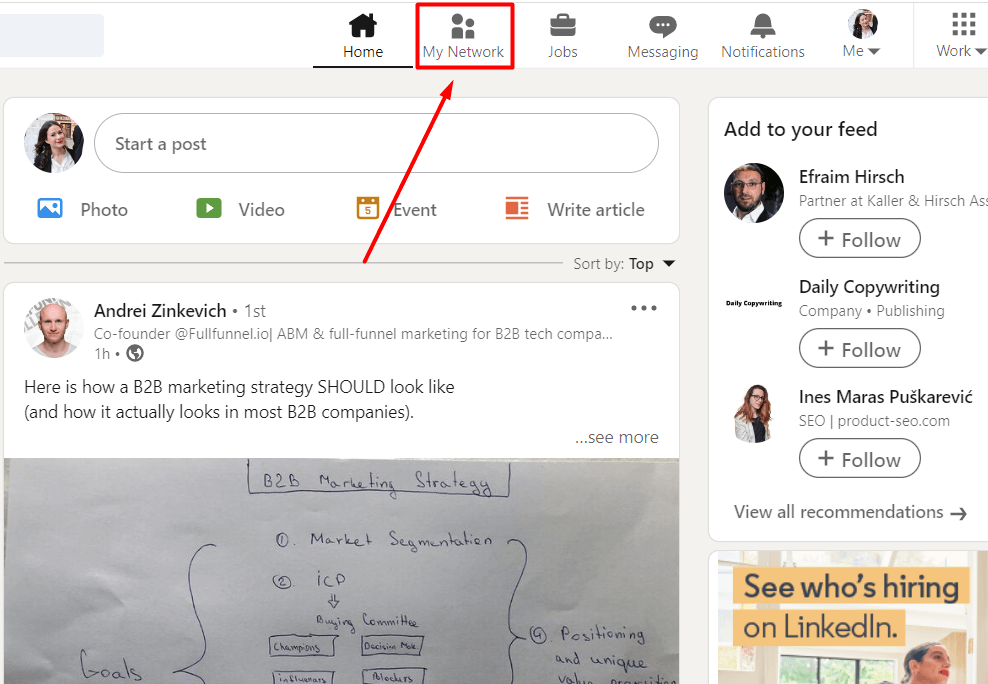
Once you do, you will see the list of invites other people sent you. Hit See all # in the top right corner.
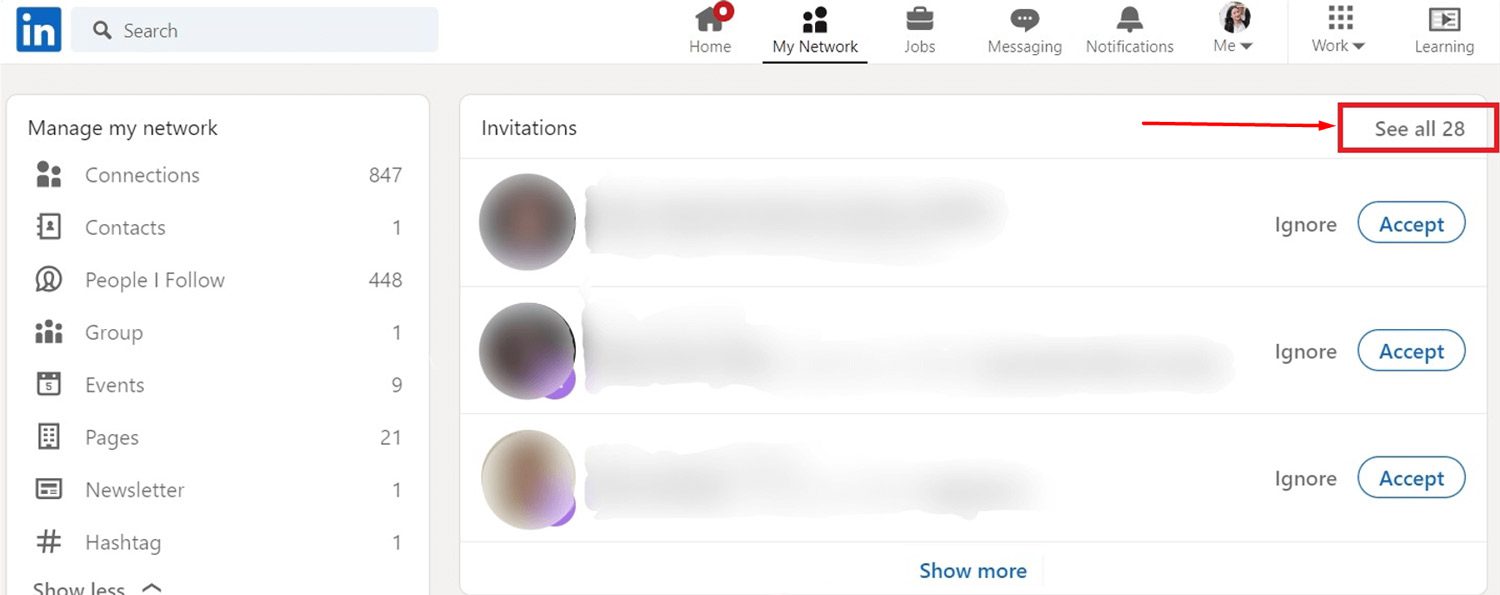
If you don't have any invites you need to approve on this page, the section will look slightly different. In this case, just click the Manage button.
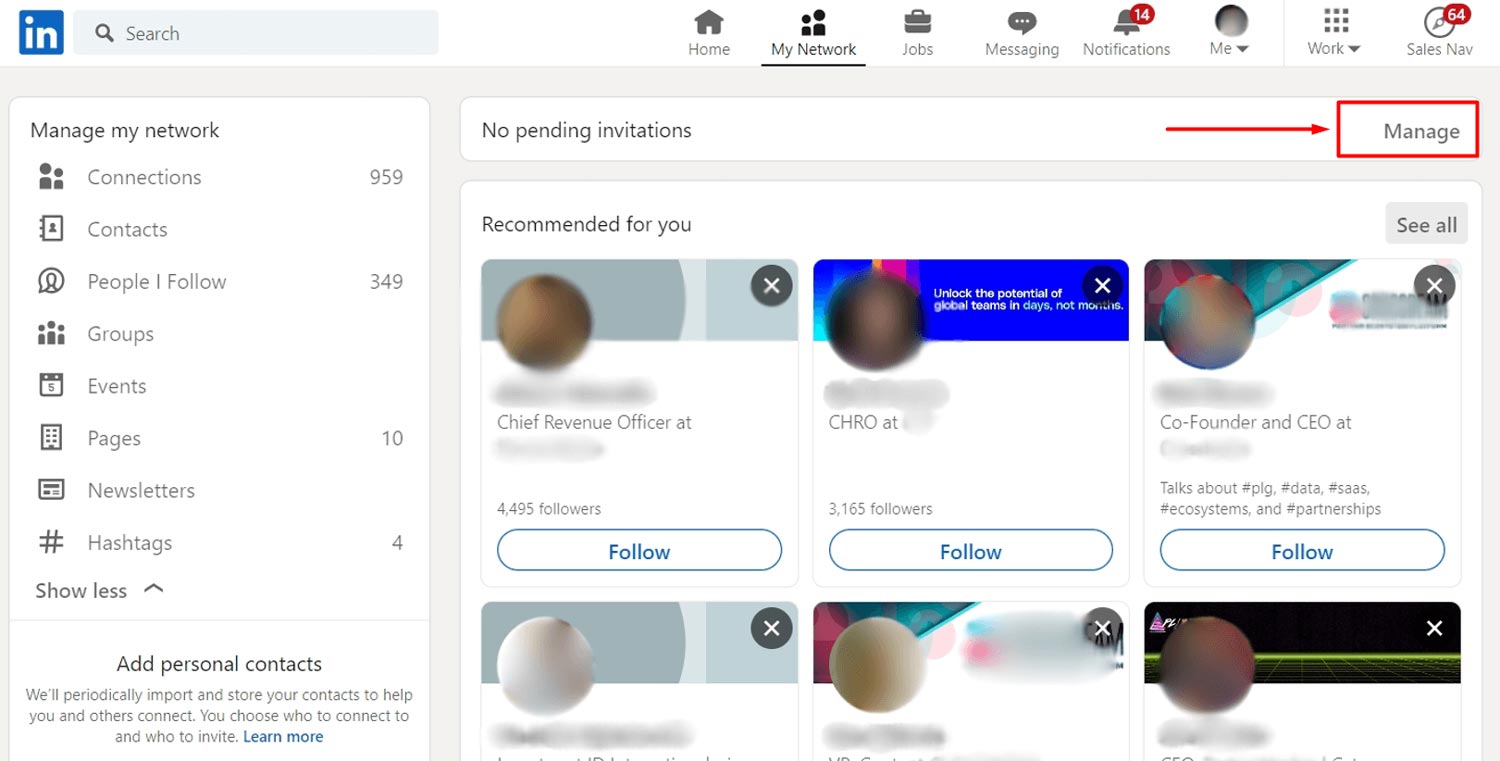
Here, you can see all the invites people sent you. To find the ones you sent out, go to the Sent tab and click the Withdraw button to cancel the LinkedIn invite.
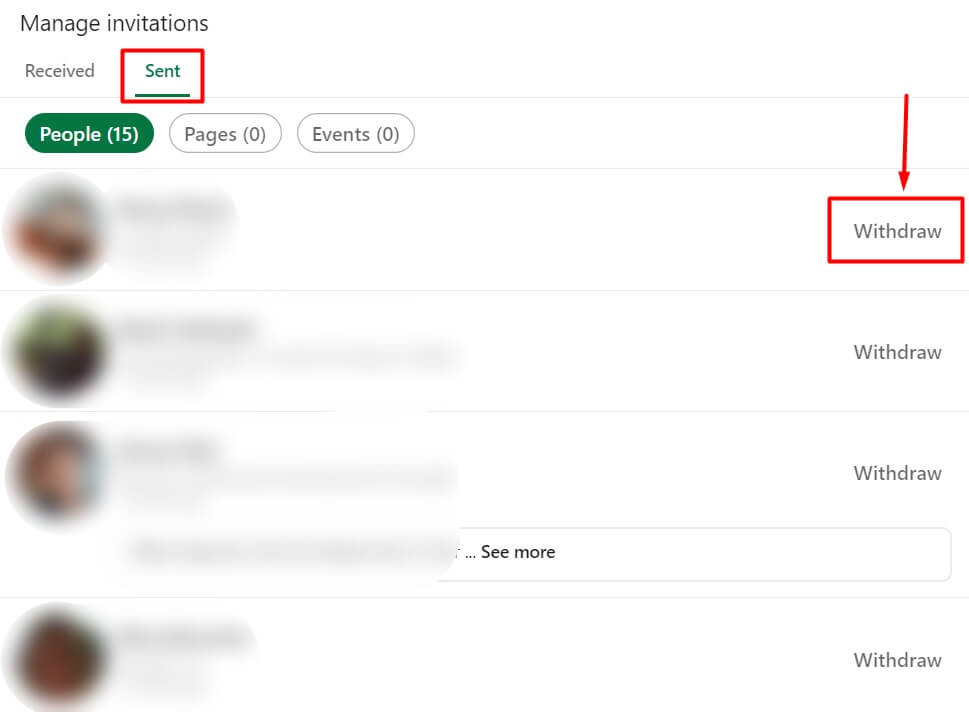
Lastly, LinkedIn will double-check if you wish to withdraw your invite with the notification. Continue the cancellation process, and you will be done.
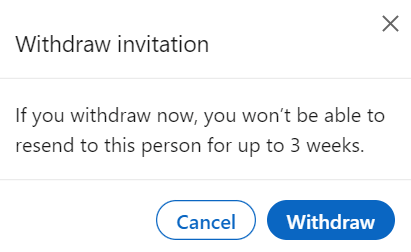
Canceling invites via Android
You can withdraw invitations using your android phone too, and the process is not that different than the one using your PC.
First, go to your Network page, and click the Invitations button.
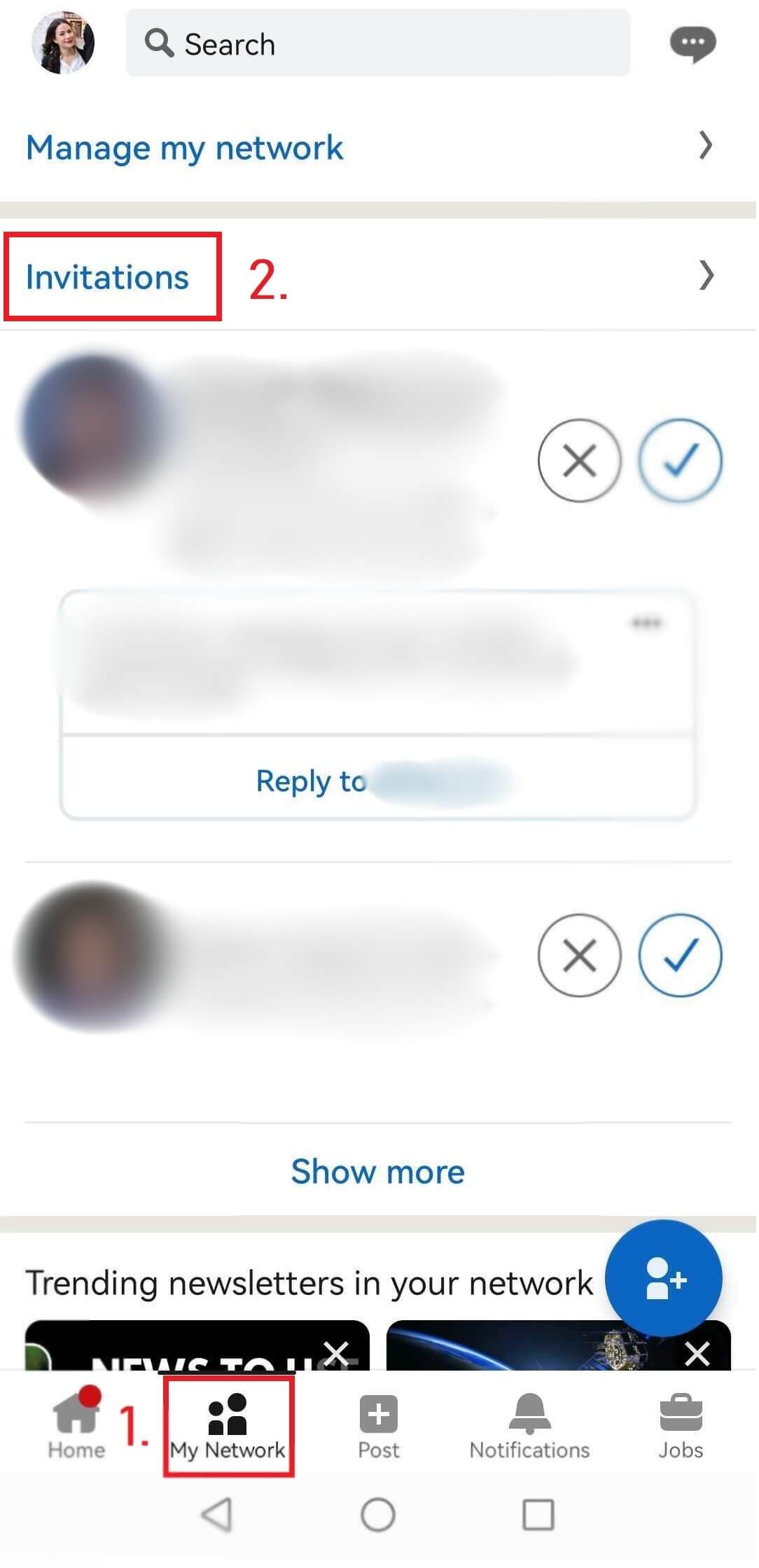
Next, click the Sent tab, and withdraw the invites you wish.
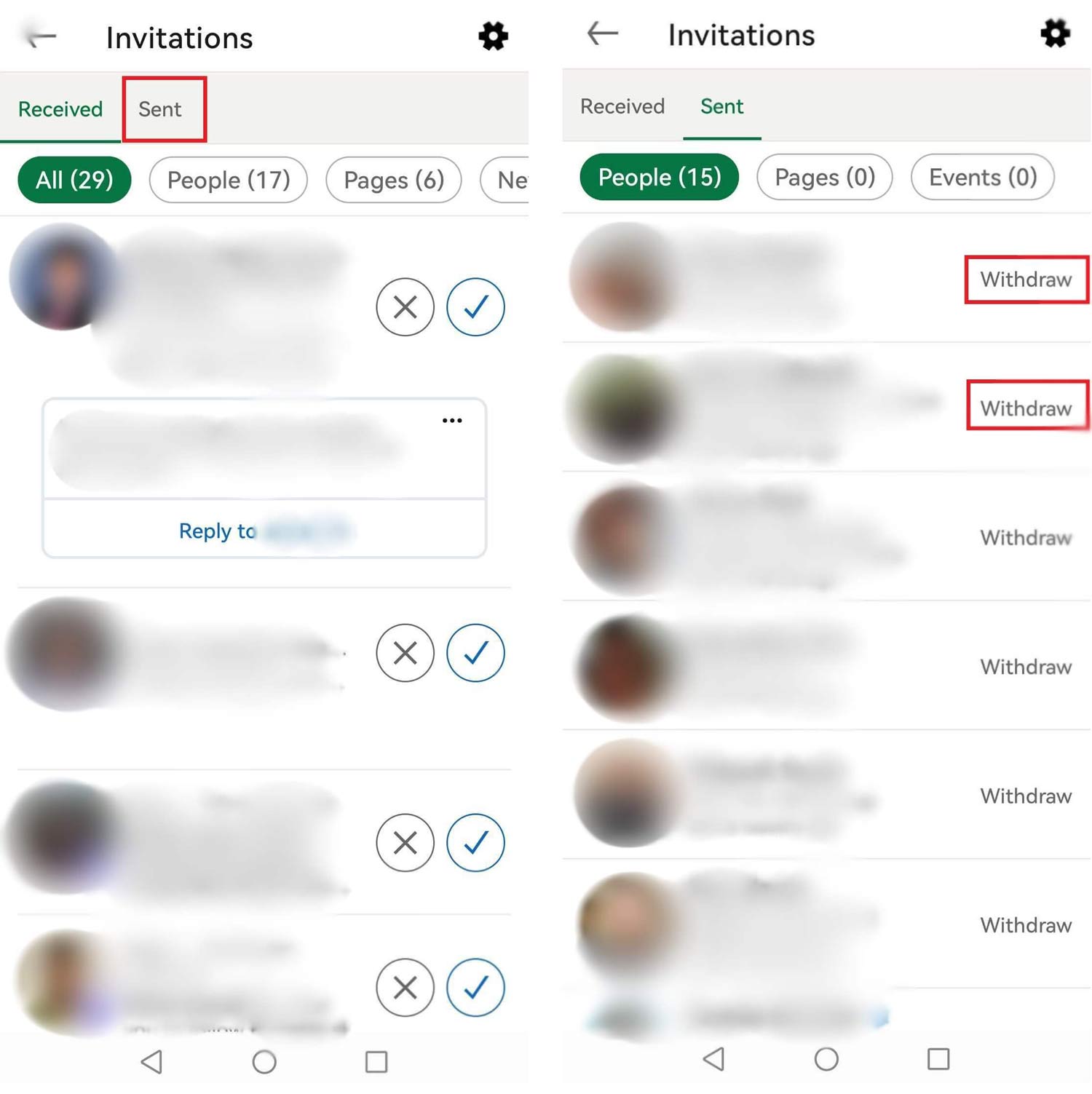
How to cancel LinkedIn invite on iOS
The process is somewhat different on iOS devices. So if, for example, you have an Apple phone, here is how you can cancel LinkedIn invite.
First, go to Notifications at the bottom of the screen. Then, click the Invitations button at the top. After the pop-up opens up, click View invitations you sent.
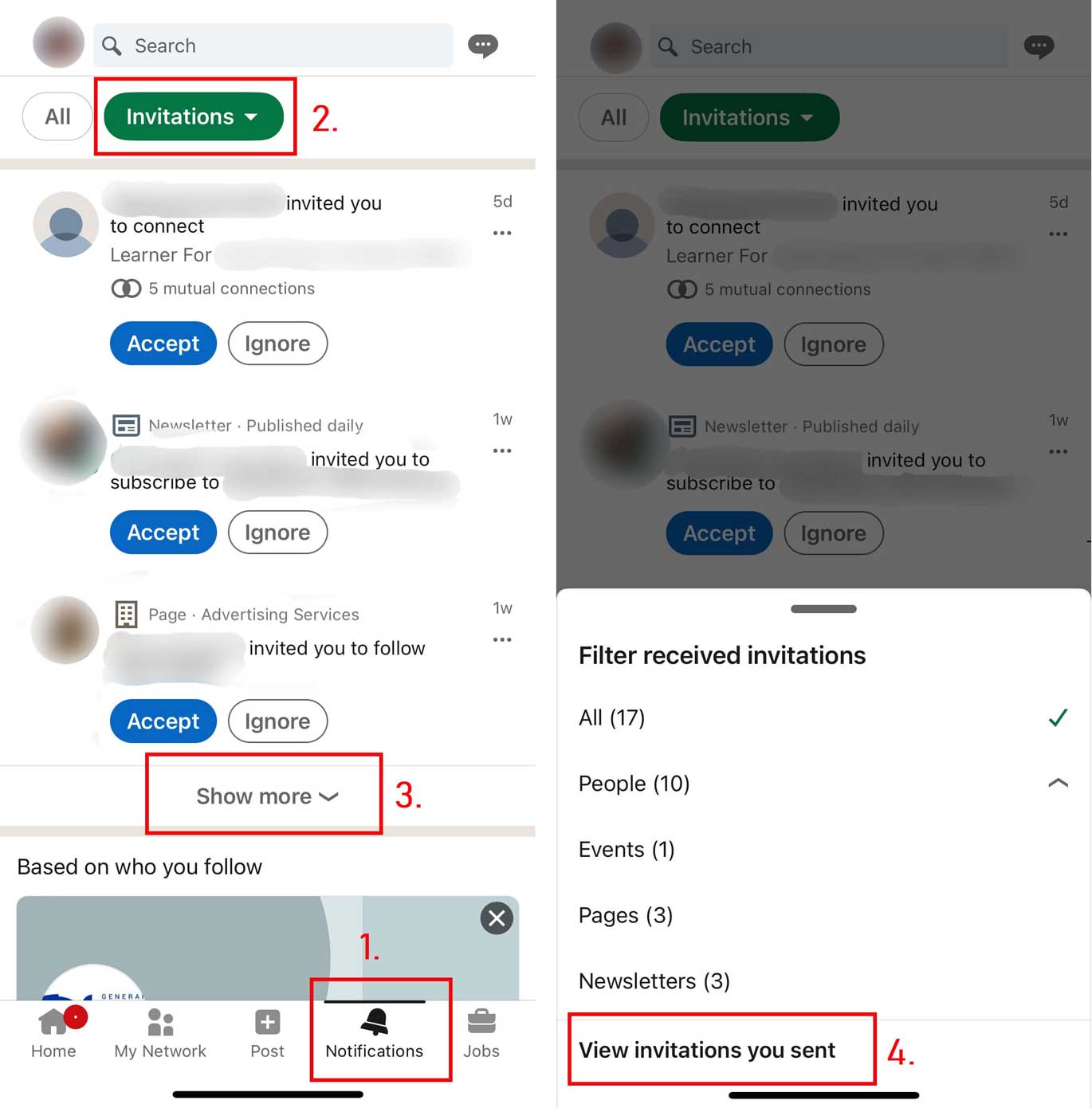
From there, choose the LinkedIn invites to withdraw and cancel them one by one.
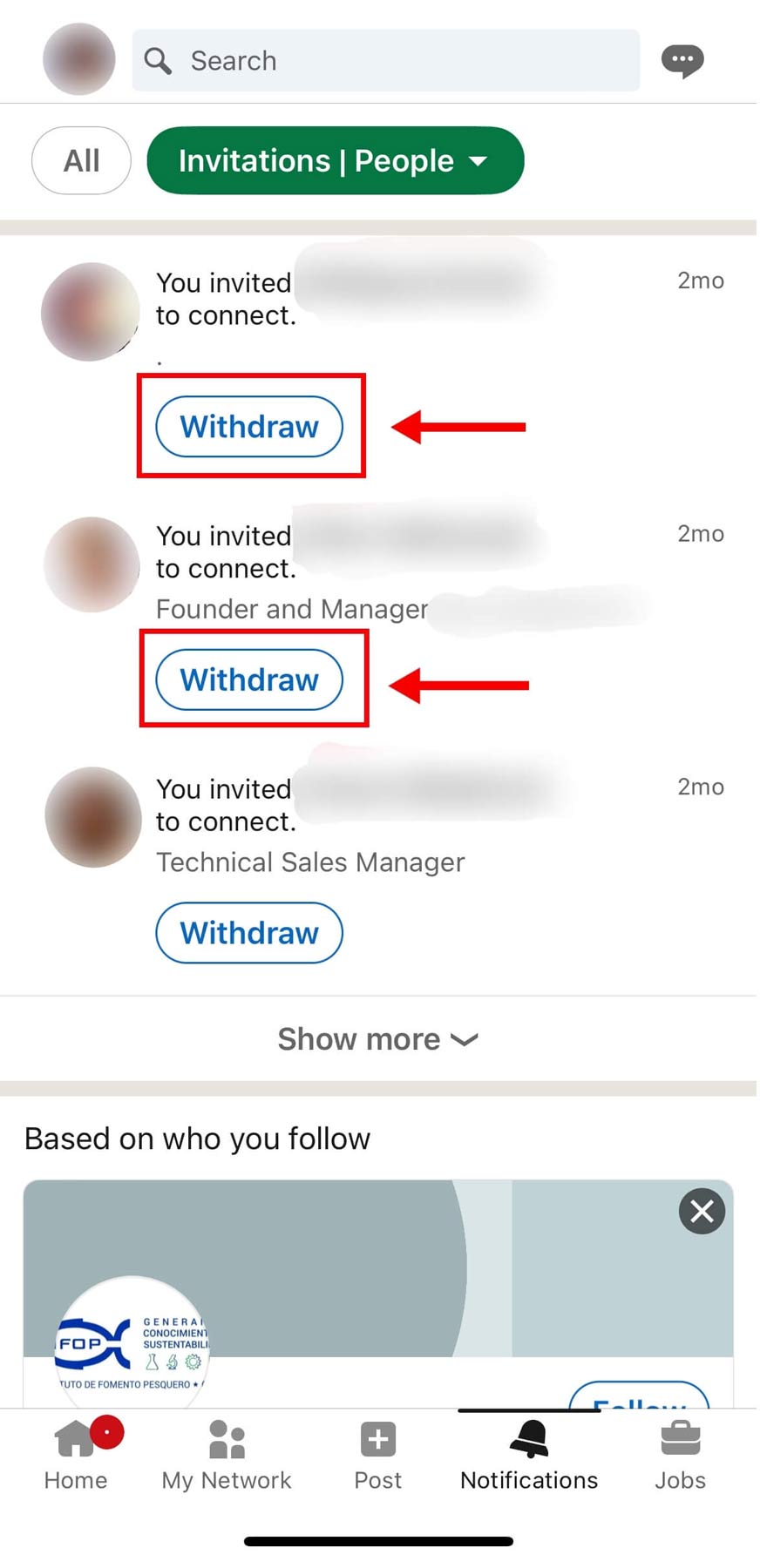
Why your LinkedIn invitations aren’t getting accepted
Speaking of connecting on LinkedIn, the best case practice is to connect with people related to you, your position, and your business industry. Naturally, if you are a salesperson or a recruiter using LinkedIn for lead generation, you’d go with your target group.
In the end, no matter who you wish to connect to and why, the goal is the same – to get the right message across and be accepted. However, there are numerous reasons why your LinkedIn invitations aren’t getting accepted or stay pending for a long time. So, to help you increase your acceptance rate, let’s first cover the possible reasons why this metric is not high at the moment.
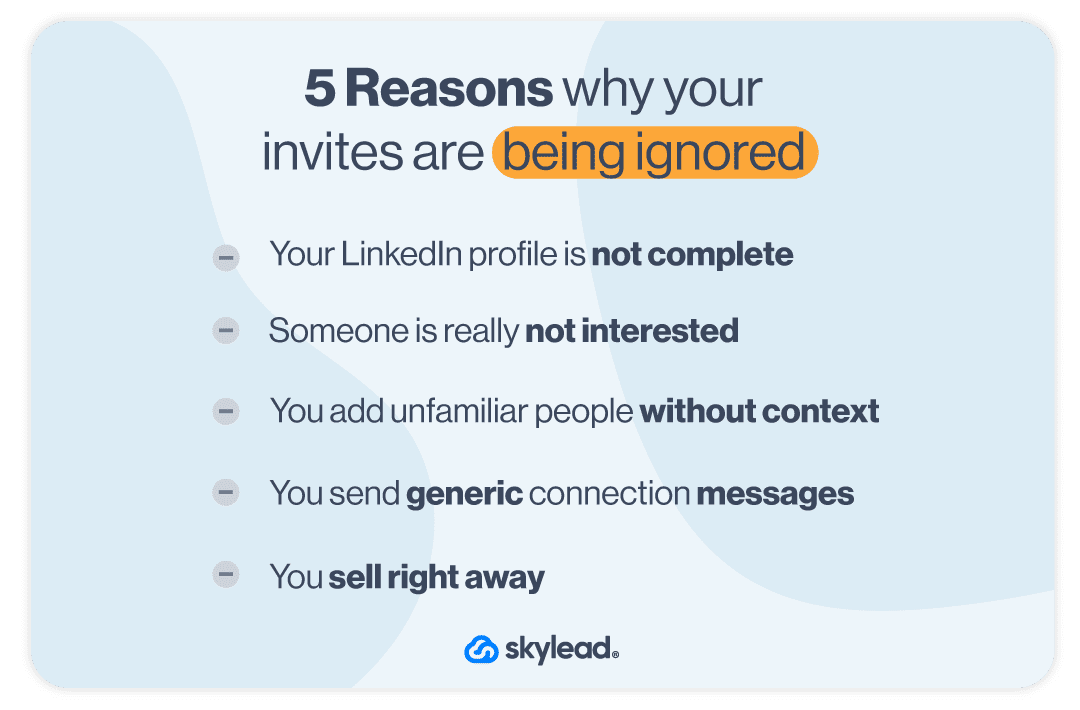
1. Incomplete LinkedIn profile
Sending invitations actively to users without previously setting up your profile is a huge mistake.
There are many profiles on LinkedIn that look like this, and you don’t want yours to be one of them.
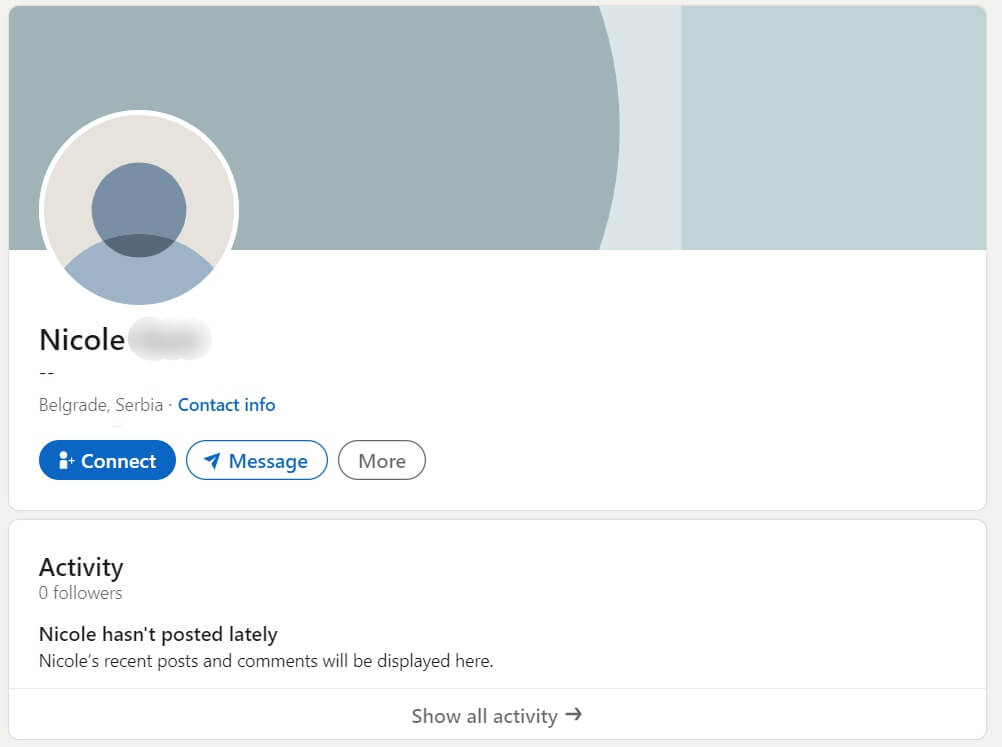
Start from yourself - would you accept an invite from this kind of profile? No, you wouldn’t.
If you have no photo, no description of any kind, and no experience details, no one on LinkedIn will take you seriously. Why would they want to connect with you without knowing who you are, right?
So if you send a request to someone with a profile like the one above, go back and cancel LinkedIn invite yourself. Then focus on setting up your LinkedIn profile first.
2. Someone is really not interested in accepting the invite
One reason may be that the user does not wish to connect with you and just prolongs declining your invite. I know - it’s like ripping off the band aid, but it had to be said.
3. Outreaching unknown people without context or common connections
This depends on the person, but some LinkedIn users don’t accept unfamiliar people. To clarify, those people sometimes see nothing they have in common with you, which makes them skeptical.
In this case, it’s good to have or reference a mutual connection, so they do not ignore your request.
4. Sending generic message requests
This mistake is the one that most LinkedIn users make. They think that writing something generic like “Hey, I’d like to connect with you” is enough to have their request accepted. Yeah, right!

These requests may be accepted in some cases, but not by a person who gets a lot of invites daily. Such people tend to get tons of messages that resemble yours and mostly ignore them. So, why would they make an exception for you?
What’s more, with this kind of message or no message at all, there is a chance the recipient can click the Ignore button and then the I don’t know this person option. With too many “I don’t know this person clicked“, you risk getting your account restricted by LinkedIn.
5. First touch selling
The chances of successfully selling something via the LinkedIn invitation request are close to zero.
You have probably received tons of invitation messages where someone is trying to sell insurance to you.
It is not the way sales work. Nowadays, it’s all about social selling and sales engagement, where building trust and delivering value come before the pitch.
In your invitation message, you should explain why you want to connect with the user you’re reaching out to, but not by trying to sell something. First, focus on personalizing, building normal human connections, and providing value before they buy anything you’re selling.
How to create engaging LinkedIn invites and boost acceptance rate
We cannot stress this enough. Before you even start creating and sending out your invitations, you need to optimize your LinkedIn profile first.
Almost every LinkedIn user will check your profile before they decide whether they should accept or ignore your invitation. That’s why it’s in your interest to give them a strong reason to accept your invitation, get value from you, and create a relationship.
After you’ve taken care of your profile, you’re ready to start inviting other users to connect. Here is our advice on how to do it more efficiently.
Prepare the ground for an invitation
It’s easy to connect with your colleagues or someone you know because those people know you personally.
However, even if you don’t know someone, you can try to remove that obstacle by becoming more familiar with that person. In other words, it’s good to start engaging with the posts of those potential connections.
Start liking their posts, create meaningful comments, and try to make a connection with them before sending an invite.
This will pave the way for you to build a relationship, and those users will start to perceive you as someone who is a valuable connection. Consequently, you won’t get in a position to cancel a LinkedIn invite that has been pending for a long time.
Personalize your invite messages
Before sending an invitation, make your messages as personalized as you can. It is a must if you want to improve your acceptance rate.
Sending personalized messages helps you leave a good first impression. Also:
- Addressing users by their names,
- Referencing something familiar to them,
- And avoiding generic phrases
play an important role in creating a strong relationship between you two.
Start by answering how you came across their profile and what made you want to connect. Don’t worry - the time you invest in LinkedIn prospecting your potential connection always pays off here.
Since you’re limited to 300 characters, you can use it to be more direct and honest.
Discover 20 ready-to-use connection invite templates with up to 78% acceptance rate.
Mention common interests
Adding many LinkedIn users who aren’t from your niche can decrease the quality of your LinkedIn feed and make it full of irrelevant content. That’s why connecting with someone that you share interests with is a great approach.
Mentioning the shared interests in your invite will show those users that you’ve invested some time into getting to know about them and their work. Moreover, you can mention the topic you wish to discuss with them. A message with these two elements will skyrocket your acceptance rate for sure. So, you won’t have to be in a position to cancel LinkedIn invite that has been pending for a long time. 😉
For example, start your message by commenting on your mutual job position, an event you both attended, or a post you both liked a while back.
Involve a little humor
It’s essential to have a professional tone of voice when you write your connection invite. However, “professional” doesn’t mean not having some sense of humor. You can always add a subtle joke here and there to make your invite stand out.
Moreover, using humor in your outreach is a nice pattern interrupt and has an immediate effect. Here is our example.
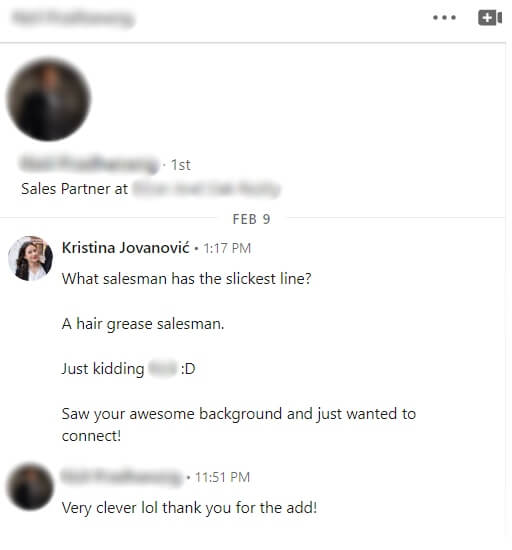
Check out our list of 35 position-related jokes ready to use in your outreach.
At the end of the day
We hope this article helped you understand why your requests have been pending for a long time and learn the tricks to improve the acceptance rate.
Remember: you must keep track of the requests you sent and clear the list on time. This is just so you don’t land on the LinkedIn radar for suspicious activity and get restricted.
That said, we recommend you invest time in your connection messages and your LinkedIn profile because, that way, you'll likely not be in the situation where you have to cancel a LinkedIn invite.
And if you wish to save 11+ hours a week, hours that you can better spend crafting winning messages and optimizing your profile, Skylead is here to help! It's the #1 sales engagement tool to use if you wish to optimize your sales processes.
Sounds good? Sign up for our 7-day free trial & take a glimpse at what it can do for you!
CRM software and tools are definitely here to stay. There is no doubt that, with the global CRM market growth projection of $128.97 billion worth in 2028, the substantial popularity of the best CRM software is yet to come.
And with the reason. Firstly, CRM offers a wide range of benefits, including centralized data and automation of tedious sales processes. Above all, a well-implemented CRM software can reach ROI up to $45 for each $1 spent.
We all wish to jump on this train. And some of us already did. But in the sea of CRM software, how would you know which one is the best for you? Whether you are starting out or considering changing your CRM software, we’ve got your back.
Therefore, in this article we will cover some of the best CRM software, why they are the best, and how to integrate them with other tools.
Furthermore, we will cover what CRM software is, if you need it and if you should buy it. Let’s get to it!
What is CRM?
Customer Relation Management, aka CRM software, is a tool that helps companies collect, organize and manage data and streamline processes related to customers’ lifecycle.
In other words, sales terms, CRM software helps teams visualize their pipeline and organize or perform tasks related to the buyer journey. Furthermore, it pinpoints the location of specific prospects in the sales funnel, their status, the next activity the sales team needs to perform, and potential value.
CRM software substitutes various spreadsheets and documents companies use to keep up with prospects’ or customers’ data. It stores all information in one place - such as messages, meetings, pain points, buyer persona type, and, in some cases, calls with customers - everything you need to know about specific leads to help you build a relationship and close deals. Lastly, CRM software shows how effective your sales strategy is and if something in your process needs improvement.
Customer-wise, CRM software provides information about each customer, their history, and any pending tasks related to nurturing and upselling.
Why is CRM one of the most valuable assets a company can acquire?
Why CRM? To clarify, let’s check out a couple of statistics first:
59% of companies tested say that CRM helped them improve Customer Retention and Satisfaction Rate by 47% and reduce lead costs by 27%. (FounderJar)
According to Salesforce, 81% of sales representatives emphasize the importance of having a view of data across the complete customer journey.
97% of sales professionals tested think that technology and CRM software are either essential or crucial for business. (LinkedIn)
Looking at the previous statistics and many more across the internet, CRM software is an essential tool for sales teams, and for good reason. To clarify, they are not just any tool on the market - they make building the relationship and social selling easier tasks and help the sales team be more customer-oriented - which is the core point of today’s sales.
Best CRM software can…
1. Centralize and label your data
CRM keeps track of all leads’ data. In other words, CRM’s centralized storage offers salespeople all the information on every individual prospect or customer at hand so they can build relationships and close deals faster.
In addition, since the prospect base can be distinct, the best CRM software also labels and sections your customer data. To clarify, you as a salesperson must know at any given time where your prospects are in the pipeline, on what note you ended the conversation, are they warmed up, or what is the next step towards closing the deal. CRM software does this for you by analyzing and labeling existing data in the system with various parameters you set. Therefore, you can be more customer-oriented by creating different messages depending on the buyer lifecycle and more personalized outreach.
2. Automate the process
With almost every piece of data being actionable, the best CRM software can automate some tedious parts of the process for salespeople, so they can focus on nurturing prospects through the pipeline. For example, appointment scheduling, assigning leads to different sales reps, or updating and importing the prospects’ data.
3. Offer analytics to close more deals and increase customer satisfaction
We can’t stress enough how important it is to conduct data analysis. Luckily, creators of the best CRM software out there share our opinion. Hence, every CRM has an analytics or reports page to help sales teams make data-driven decisions.
In other words, CRM can help you see how many deals you won or lost, what tactic you used, deal value, and much more. Thanks to this, salespeople can adjust their approach, close more deals, and improve customer satisfaction and retention.
4. Remind salespeople of pending tasks
Sometimes we as people, amongst other work, forget to write a follow-up email or two, or simply a meeting slips out of our mind. It happens. However, forgetting such tasks can cause a lost prospect or a customer. However, CRM software offers a solution to this problem, and it is an option to alert you of actions needed for every customer in the pipeline to make sure these mistakes never happen.
To buy CRM software or to create a spreadsheet? That is the question.
Our experience says to buy. CRM software offers many useful features that you can use to streamline and automate processes and save you much more time than the spreadsheet.
However, if you are just starting out, perhaps you don’t have the necessary budget or have a small company, you might want to consider creating a CRM in a spreadsheet for yourself. It can help you understand how CRMs work and how your business can benefit from them.
Additional tip: If you want to level up but are not ready to pay for the CRM itself, try out some CRM software with free plans, such as Bitrix24, Really Simple Systems, or EngageBay.
Nevertheless, if you or the company scales up, do not dwell on these spreadsheets or free plans (unless you want to), as you might miss out on the amazing features that some of the best CRM software have.
In case you wish to buy CRM software, here are the ten best CRM software currently on the market (people’s choice).
10 best CRM software for sales
CRM software is an essential tool for every sales team. However, as prospects differ, so do the salespeople. In other words, not every CRM suits every business's needs. So, how would you know which one is the best for your business needs?
Thus we present you with the top 10 list of highest-rated, best CRM software for the sales team from various listing websites. For this article, we are going to calculate the current average rating from the most popular review sites:
Furthermore, we will list who they are most suited for, advantages, disadvantages, pricing, and additional information to help you find the best CRM software for you. Let’s get started.
Salesmate - Best CRM software for cold calling
This CRM software is great for small and medium businesses who are cold calling. In addition, Salesmate has a relatively easy-to-use interface and quick access to the features you require.
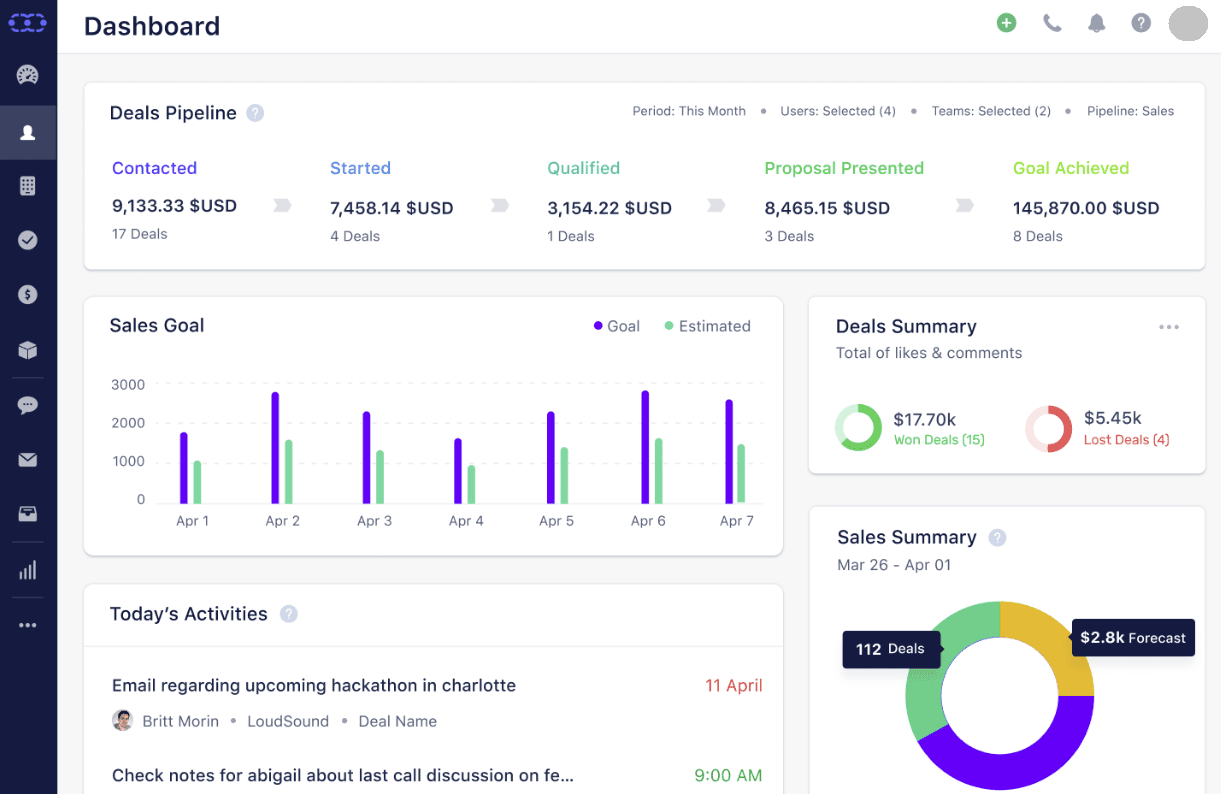
Salesmate can be integrated with Gmail or Outlook. Furthermore, each sales member can centralize prospect data, including email messages, and share them with other team parties.
Salesmate also offers reports that enable business owners and managers to track sales reps’ productivity and achievements. Team leads can also listen to calls by using the call recording option.
Advantages:
Salesmate has an option to generate tasks for you automatically. If, for example, someone fills a form on your website, that lead can directly go into Salesmate, and it automatically creates the task to follow up with that lead.
Secondly, there are calling and texting features so the sales reps can contact leads. Thus, it eliminates the need for adding other tools and saves budget, in a way.
Disadvantages:
A couple of reviewers reported a periodical system lagging. Furthermore, since every text message and call minutes have an additional price, the amount billed each month increases by that sum. This can be a problem for some users, as the amount can escalate if not properly and regularly managed.
Price:
- Starter: $15 per user / month or $144 billed annually
- Growth: $30 per user / month or $288 billed annually
- Boost: $50 per user / month or $480 billed annually
Listings rating: ⭐ 4.64
HubSpot CRM - Best CRM software for teams that are developing
There is no doubt that HubSpot surprised everyone with free access to the CRM software. However, the free version does come with its limitations.
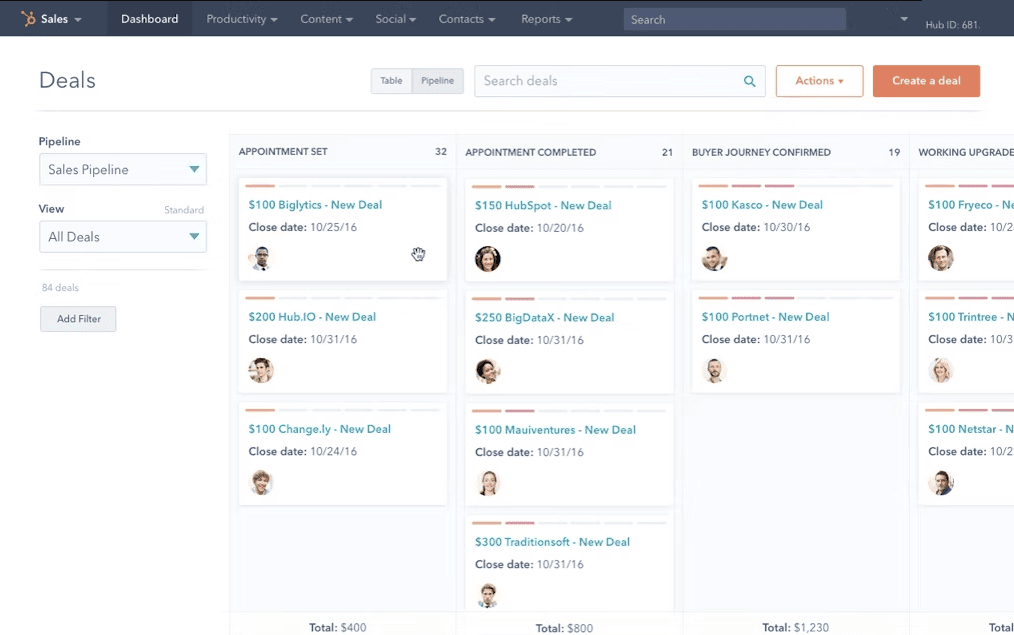
In a free account, you get:
- Contact management
- Deal pipeline
- Quotes
- Meeting scheduling
- Live chat
- Reporting dashboard
If you wish for anything else, you need to upgrade to a paid version.
HubSpot CRM is perfect for individuals or companies that are just getting started with CRM software. Furthermore, it is useful for other medium-sized businesses that outgrew that phase.
Advantages:
HubSpot overall offers various nifty features, including sales playbooks, sequences, workflow automation, and reporting. In addition, this CRM can process up to 1,000,000 contacts and users for free and offers unlimited storage. Their Starters pricing plan is pretty fair and is somewhat beginners friendly, as opposed to other CRMs on the market.
Disadvantages:
If you wish for additional features, pricing for professional and enterprise packages is pretty steep. Furthermore, it does not directly support Dynamics 365, and pipeline and managing deals are not that intuitive.
Pricing:
- Starter: $50 per 2 users / month or $540 yearly
- Professional: $500 per 5 users / month or $5400 yearly
- Enterprise: $1200 per 10 users / month, billed yearly
Listings rating: ⭐4.504
Salesforce Sales Cloud - Best CRM software for sales experts
This is a complex and useful CRM that allows sales professionals to manage and build relationships with their prospects and customers. Salesforce Sales Cloud helps you optimize your workload, maximize your budget, and offers real-time data all in your favor so you can close more deals.
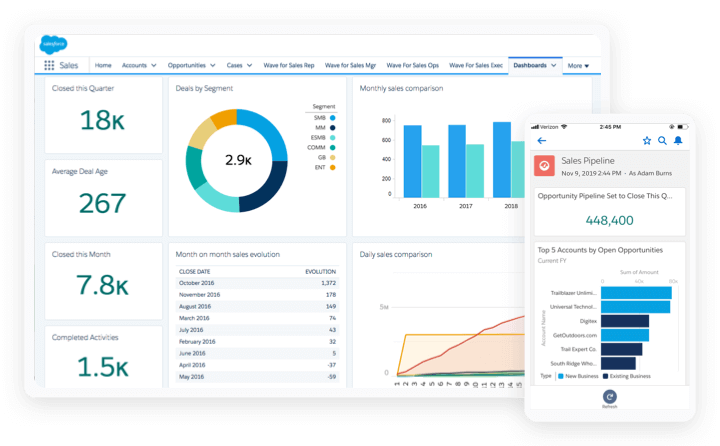
This CRM is not for beginners. In other words, they offer features galore that can be useful to sales experts already using CRMs for a couple of years, but if you are a beginner, you might want to test out and use other systems for a while before jumping to Salesforce.
Advantages:
Salesforce’s various and unique features are actually its advantage. Furthermore, they offer mobile app for Android and iOS to let you do the work on the go.
Salesforce also possesses the visual workflow drag-and-drop feature and lets you create, do and change tasks fast. In addition, Salesforce Sales cloud integrated with Slack so you can engage with prospects and customers in real time.
Disadvantages:
Salesforce is not beginner friendly and it is billed annually.
Pricing:
- Essential: $25 per user / month, billed annually
- Professional:: $75 per user / month, billed annually
- Enterprise: $150 user/month, billed annually
- Unlimited: $300 per user / month, billed annually
Listings rating: ⭐4.5
Zoho CRM - Best CRM software companies interested in contact and pipeline management only
The core functionality of Zoho’s CRM is contact management, pipeline management, and purchase control. Its dashboard is customizable, and it allows users to brand it according to their business brand.
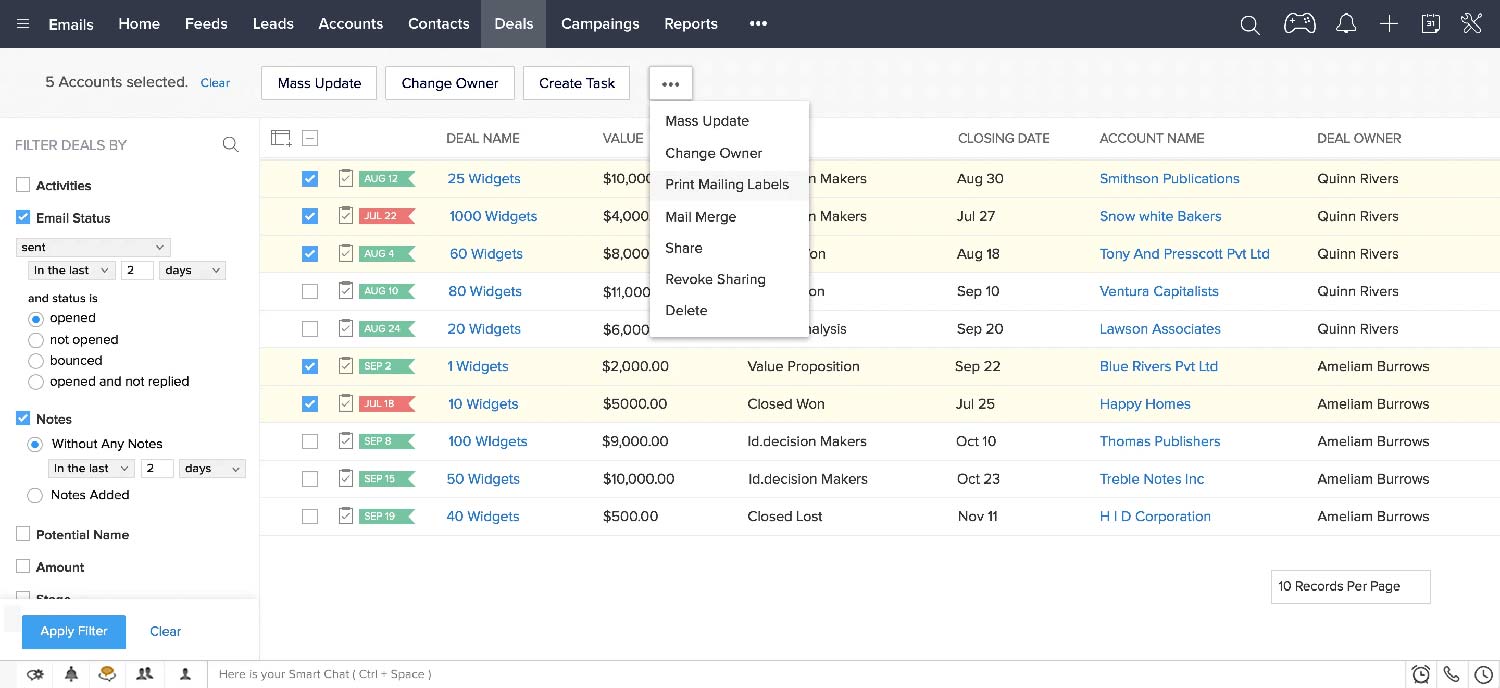
Advantages:
One of Zoho's biggest advantages is that it allows you to reach people who use Twitter and Facebook. Furthermore, Zoho CRM tracks their actions and categorizes them as contacts so you can connect with them.
Disadvantages:
Zoho is a kind of CRM with mixed feelings - its interface is a bit outdated, it doesn't work well with extensive outreach, features are sometimes not communicating between each other, and billing annually are perhaps the reasons why Zoho is so low on the list.
Pricing:
- Free Edition: Free up to 3 Users.
- Standard Edition: 20€ per user / month or 14€ per user / month but paid annually
- Professional Edition: 35€ per user / month or 23€ per user / month but paid annually
- Enterprise Edition: 50€ per user / month or 40€ per user / month but paid annually
- Ultimate Edition: 65€ per user / month or 52€ per user / month but paid annually
Listings rating: ⭐4.292
Monday Sales CRM - Best CRM software for workflow
Before, Monday was a project management software, but now with its product development, it is much more. Now-developed Monday Sale is CRM software that centralizes your entire workflow and customer data. It allows tracking every aspect of the sales cycle, from lead generation to after-sale customer nurturing.
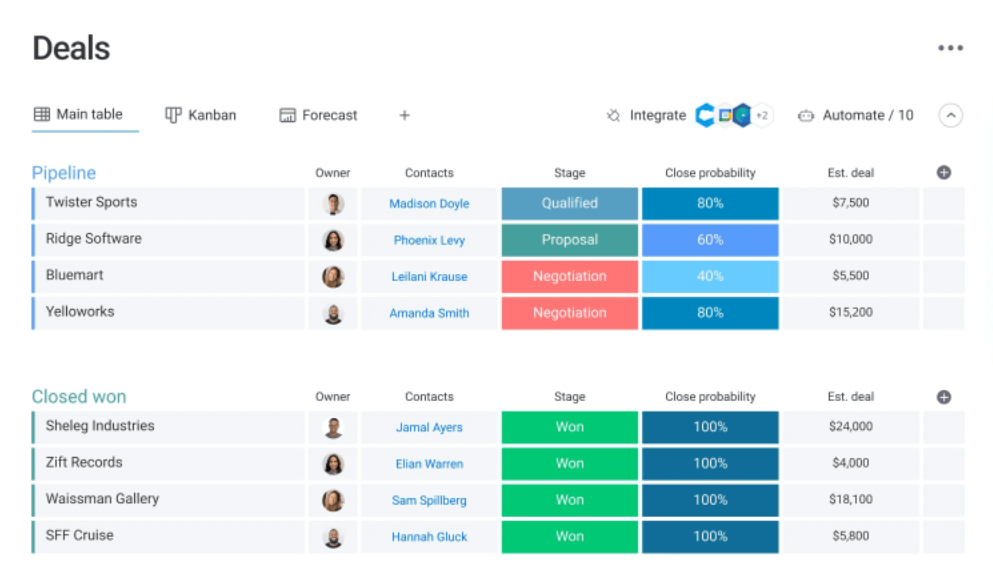
This CRM is best for small and medium-size businesses, and it is completely customizable.
Advantages:
Monday offers various templates that you can use for your workflow. In addition, the Monday.com dashboard is clean and straight-to-the-point, so you can easily spot any issues in your sales cycle.
Disadvantages:
Their pricing plan is confusing since they require a minimum of 3 seats, and you cannot use it as an individual (you can, but you need to pay for 3 seats). Furthermore, Monday Sell has issues with tablet and mobile device apps, and workflow automation needs additional manual work.
Pricing:
- Individual: $0 free forever (up to 2 seats), billed annually
- Basic: $8 / seat / month (3 seats minimum), billed annually
- Standard: $10 seat / month (3 seats minimum), billed annually
- Pro: $16 seat / month (3 seats minimum), billed annually
- Enterprise: Contact Monday.com for a custom quote
Listings rating: ⭐ 4.675
Zendesk Sell - Best CRM software on a budget
Formerly Base, Zendesk Sell is a CRM software perfect for small and medium-sized businesses. It provides access to all channels the sales team uses for communication including SMS, voice calls, and emails.
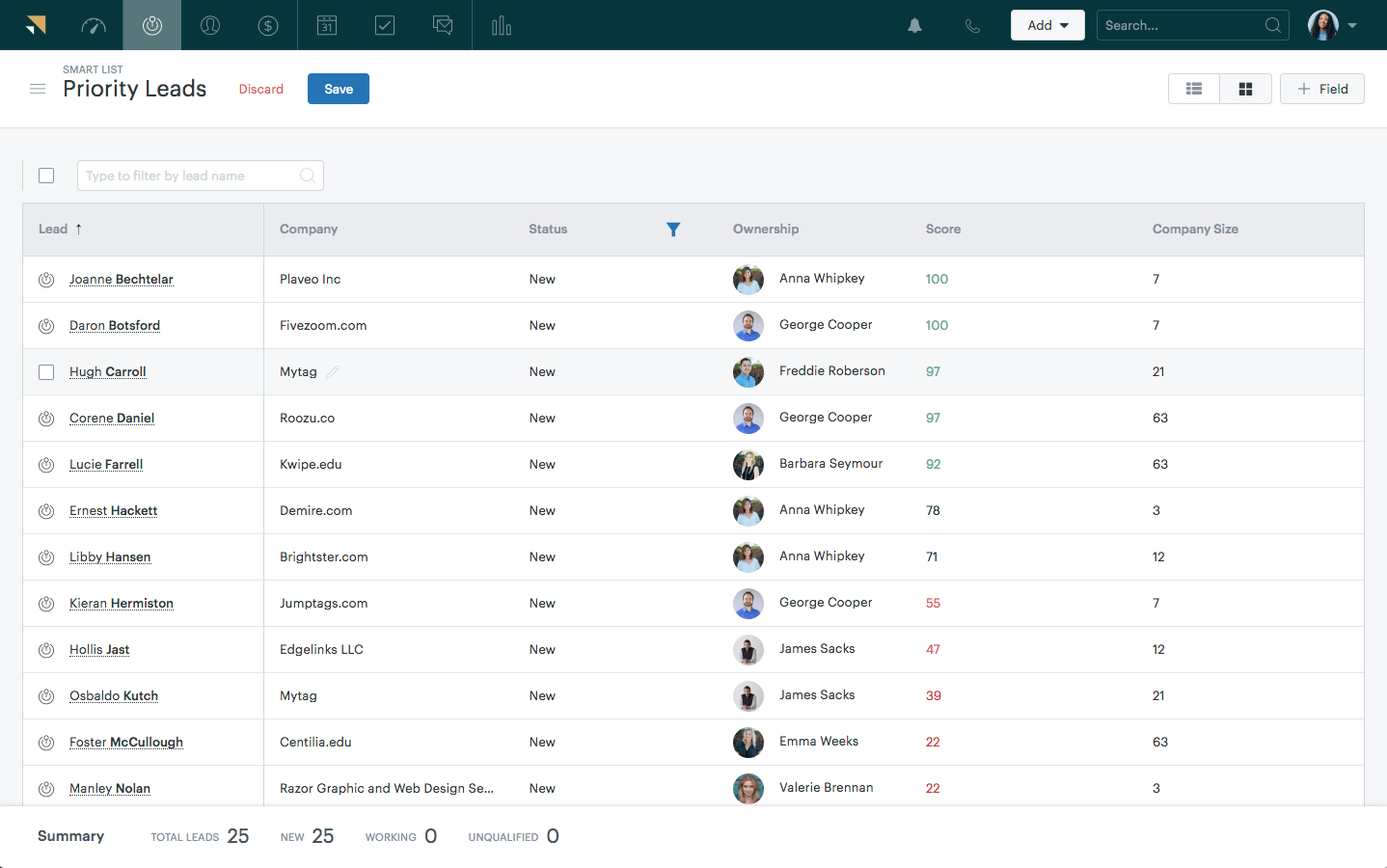
With Zendesk Sell, it is pretty easy to gain a full insight into the specific lead, thanks to features such as funnel tracking, customizable lists, templates, and conversion rate tracking.
Advantages:
One of the best features Zendesk Sell has is a calendar-reminder system. In addition, Zendesk Sell can be linked with Microsoft Office and possesses one tool that automatically detects duplicate leads and task sequencing.
Disadvantages:
Zendesk users reported problems such as slow loading time, mistakes in automated data entry, and issues with customer support. In addition, subscriptions are billed annually, and users need to pay more for certain features.
Pricing:
- Starter: $19 per user / month, billed annually
- Professional: $49 per user / month, billed annually
- Enterprise: $99 per user / month, billed annually
Listings rating: ⭐4.216
Copper - Best CRM software if you use Google Workspace
This is a CRM software with the main emphasis on Google Workspace. It has a well-designed UX/UI. What’s interesting about this CRM is that it contains in-app voice transcription, allowing you to take bullet points from the call right away.
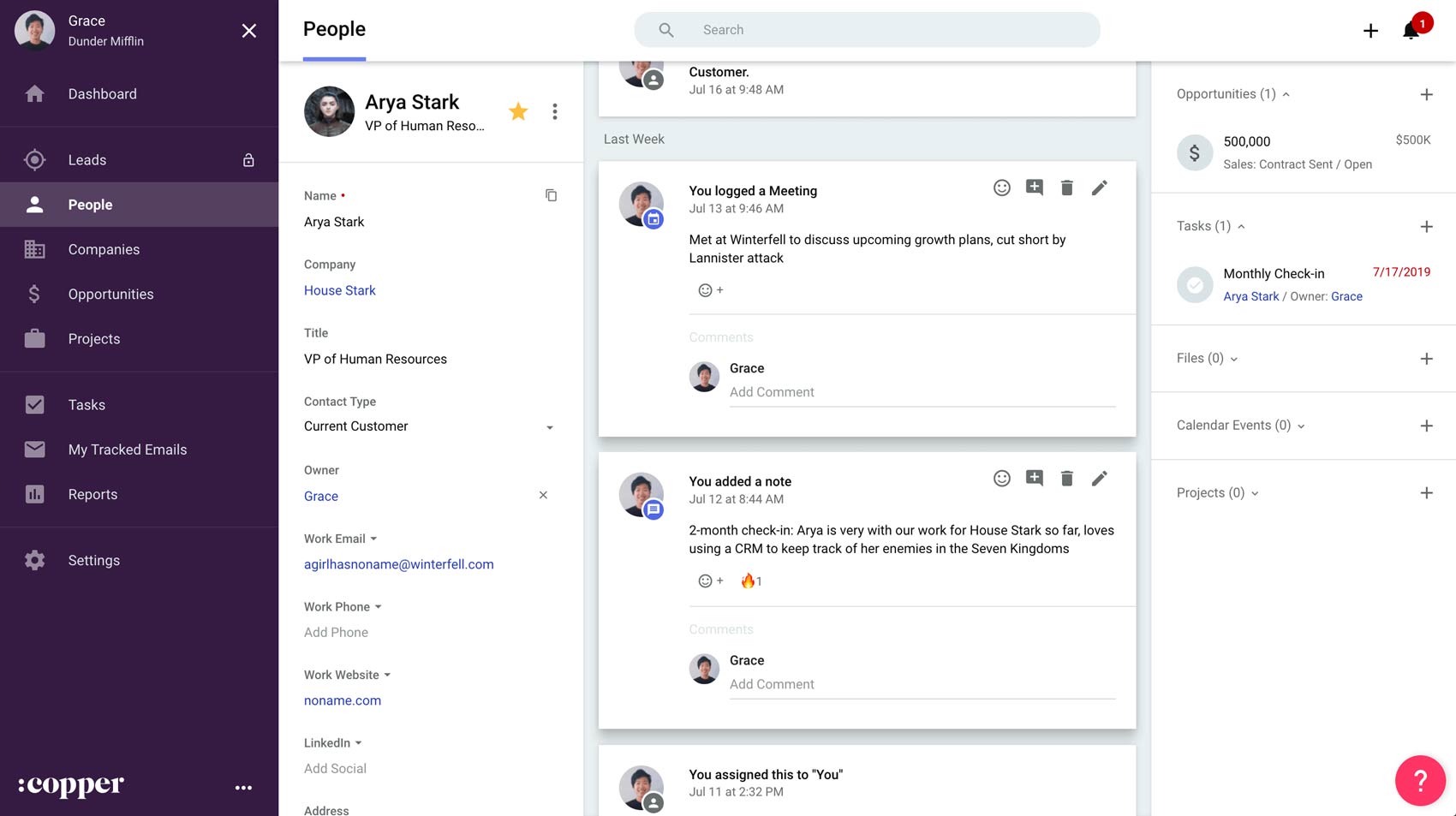
Like other CRMs, Copper offers detailed reports and suggests improvements in workflow, while alerts keep you focused on the most important tasks. Furthermore, Copper is a nice CRM if you are a beginner or if you wish to change your current CRM.
Advantages:
The main advantage is that Copper integrates completely with Google Workspace - Gmail, Google Docs, and Google Sheets. In addition, the onboarding process is seamless and the system itself is simple to use.
Disadvantages:
Firstly, you are not able to attach files to emails you send in Copper. Secondly, workflow automation is a bit confusing since Copper uses rule-based workflow automation, and it may be time-consuming at first. Furthermore, another thing you might need to spend time with is filtering and extracting data.
Lastly, there is a lack of flexibility outside Google Workspace. To clarify, companies that use different email providers will not be able to integrate them with Copper.
Pricing:
- Basic: $29 per user / month or $300 annually
- Professional: $69 per user / month $708 annually
- Business: $129 per user / month (with annual commitment) $1.428 annually
Listings rating: ⭐4.53
Pipedrive - Best CRM software for multiple pipelines and customization
CRM software, Pipedrive, handles all the essential sales CRM features. It is intuitive, and you can easily separate priority deals and create different strategies for each lead.
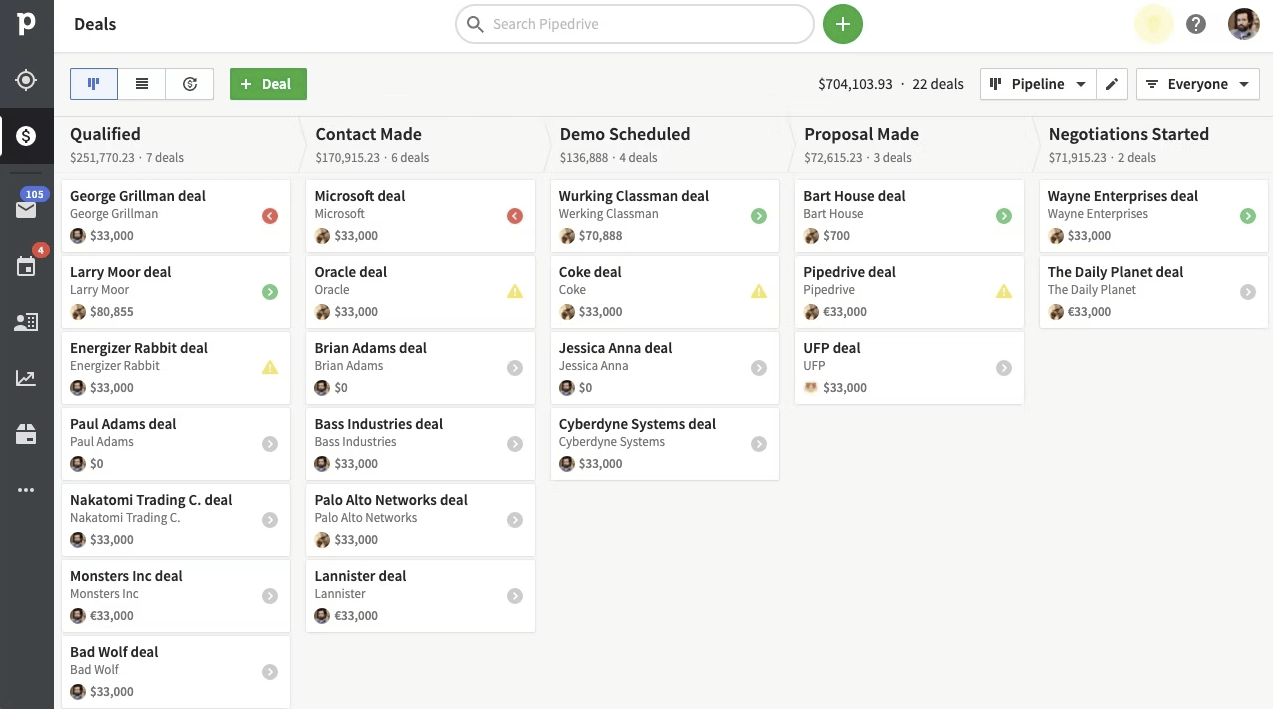
Advantages:
Firstly, Pipedrive lets you build multiple sales pipelines and customize stages which are great for sales reps or team leads who manage various pipelines at once.
Secondly, Pipedrive’s star feature is that you can create web forms and LeadBooster chatbot, a custom chatbot to pop up next to a webform. Pipedrive then automates the process and puts lead directly into your pipeline.
In addition, Pipedrive’s powerful AI understands leads’ behavioral patterns and can give you hints on how to close deals with them.
Disadvantages:
Pipedrive can’t send a follow-up message or birthday greetings based on a date at this moment in time. In addition, users noticed some lagging issues and poor mobile app experience. Lastly, customizable reports are not available.
Pricing:
- Essential: $15 per user/month or $12.50 per user / monthly billed annually
- Advanced: $29 per user/month or $ 24.90 per user / monthly billed annually
- Professional: $59 per user/month or $49.90 per user / monthly billed annually
- Enterprise: $119 per user/month or $99 per user / monthly billed annually
Listings rating: ⭐4.446
Salesflare - Best CRM software (people’s choice)
The best CRM software on our list is Salesflare. It is a CRM software primarily for startups and small businesses, but many agencies and enterprises use it. Salesflare is intuitive and easy to use and can be integrated with more than 400 other productivity tools like Trello, thanks to Zapier.
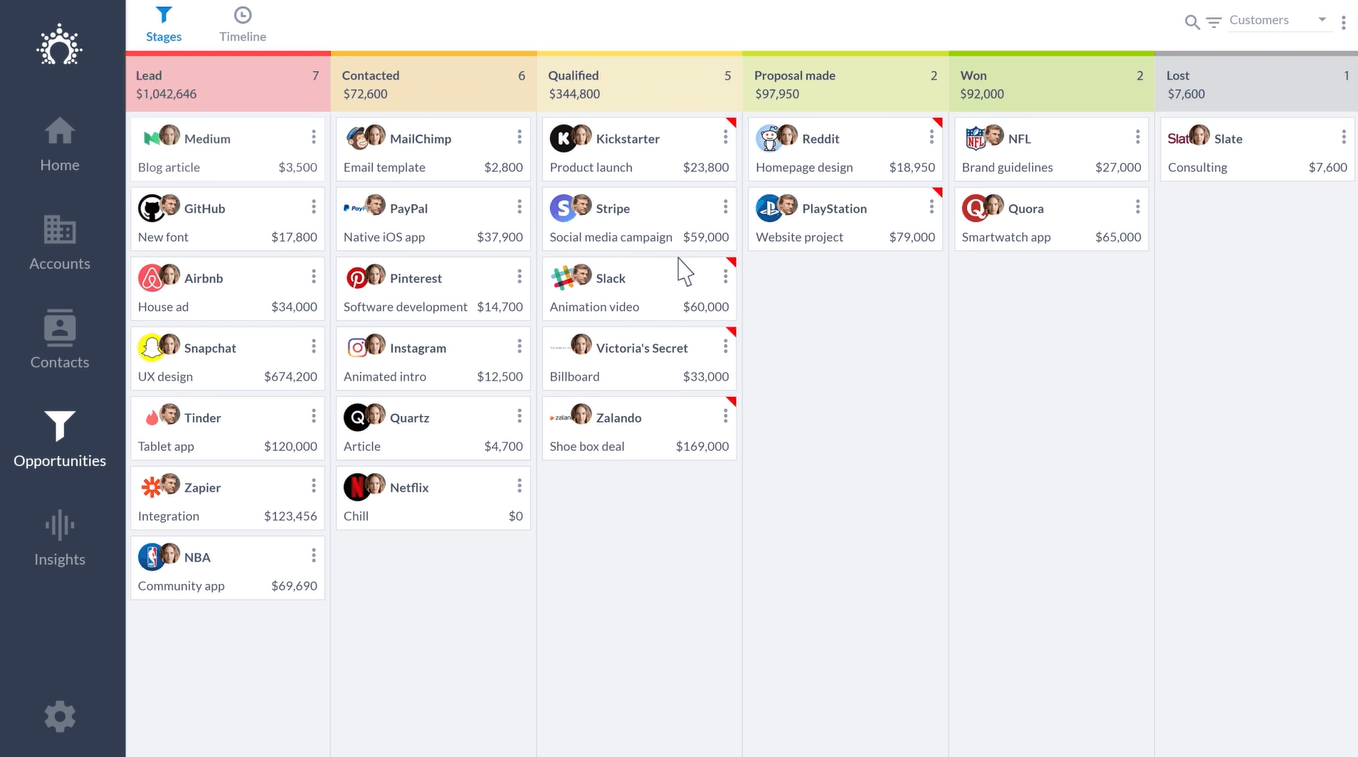
Salesflare offers automation features, such as an automated address book, timelines, file repository, and sending emails based on triggers. It can also provide task suggestions automatically.
Advantages:
The good thing about Salesflare is that they provide dedicated support no matter the plan you choose. In addition, for all technical advice, you can even talk to developers.
Furthermore, they have a mobile app, various team access levels, and a great data gathering system. Lastly, Salesflare will automatically log phone calls or meetings, and gather contact information from email signatures, and even social media profiles.
Disadvantages:
Fortunately, there aren't many disadvantages when we talk about Salesflare - the users seem pretty content. There are, however, a couple of suggestions from them: it would be nice to have email drip functionality, and email reporting needs improvement.
Pricing:
- Growth: $29 per user / month (billed annually) or $35 billed monthly
- Pro: $49 per user / month (billed annually) or $55 billed monthly
- Enterprise: $99 per user / month (billed annually) or contact their support for custom plan
Listings rating: ⭐ 4.73
EngageBay - Best CRM software for enticing your sales team
Cloud-based CRM, EngageBay is a software that integrates sales, marketing, and finances on a single platform. The core function of this software is complete automation. Furthermore, it offers contact management tools specially designed to be simple to use. In addition, it can track web activity, email response, and analytics.
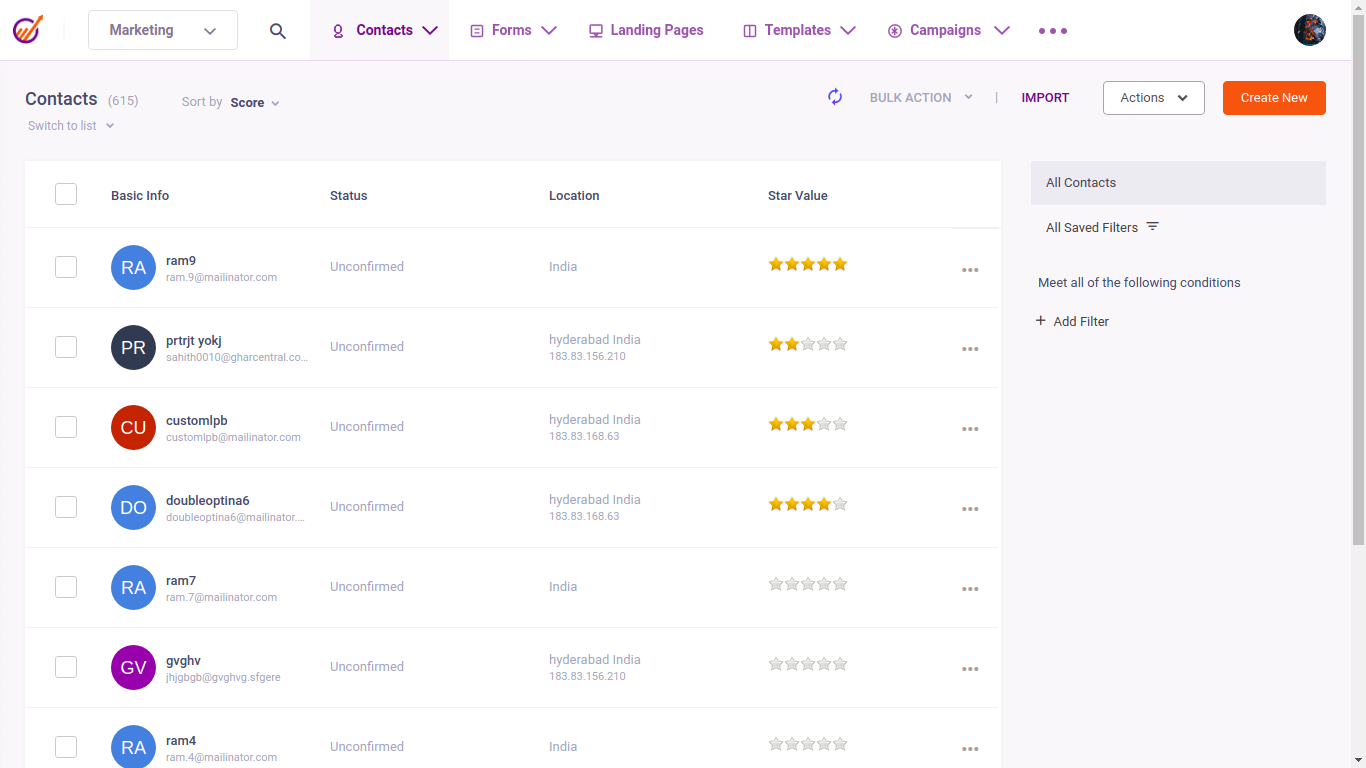
EngageBay easily Integrates with Gmail, Office 365, or any other service, with integration capabilities through Zapier or other similar integrations to further streamline your sales efforts.
Advantages:
The possibility to make a call from this CRM is a big plus, as well as an option for transcripts. In addition, what separates EngageBay from other systems is the possibility to gamify sales processes and thus keep your sales reps motivated.
Disadvantages:
A couple of lesser disadvantages came up with EngageBay. There is less troubleshooting documentation, email templates are limited, and the Chrome plugin doesn’t trigger an event, so automation needs to be done manually.
Pricing:
- A free plan is available, limited to 1,000 contacts emails
- Basic: $12.99 per user / month, $11.69 per user / month annually
- Growth: $24.99 per user / per month, $22.49 per user / month annually
- Pro: $49.99 per user / month, $44.99 per user / month annually
Listings rating: ⭐ 4.636
How to use CRM software with other tools?
We all know that only one tool won’t do if you wish to optimize your sales workflow as much as you can unless that one tool has everything you need, which is pretty rare.
So, in addition to CRM, you might be using sales engagement or meeting scheduling tools. So the question arises - is it possible to integrate them all? Short answer - yes.
Long answer? Let us show you how you can do it.
For example, let’s take our sales engagement tool, Skylead. This tool helps you outreach leads and take action depending on their behavior. As you fill your pipeline with it, it leaves you more room to concentrate on important matters such as building relationships and closing more deals.
In addition, you can integrate Skylead with your CRM of choice by using webhooks. A webhook helps you transfer data to other applications immediately, when certain action happens. For example, as soon as the lead responds in a Skylead campaign, a webhook is triggered, and will automatically send lead’s data to your CRM.
Moreover, webhooks are the most common way to integrate tools directly into your CRM and push data about the leads in one place. You can create them by using tools such as Zapier.
Apart from using webhooks, you can also push your prospects’ information to your CRM by using Skylead’s global BCC option. To use it, simply insert the email address you get from your CRM in Skylead’s Global BCC option. This option is available only if your CRM of choice doesn’t offer direct sync with your email but through BCC.
The best CRM software in conclusion
With so many CRMs on the market, it can be daunting to go through every single one of them. But if we take software listing websites into the account you can more or less see the situation on the market.
So, let our list be your guide to narrow your choices, or figure out what other solutions are out there. Thus, here is the short overview of the best CRM software currently on the market.
| CRM Software / Listing Website | G2 | Capterra | GetApp | Software Advice | Software Suggest | Average Rating |
| Salesforce | 4.2 | 4.4 | N/A | 4.25 | 4.9 | = 4.5 |
| Hubspot CRM | 4.4 | 4.5 | 4.5 | 4.52 | 4.6 | = 4.504 |
| Salesmate | 4.6 | 4.7 | 4.7 | 4.7 | 4.5 | = 4.64 |
| Zoho CRM | 4.0 | 4.3 | 4.3 | 4.26 | 4.6 | = 4.292 |
| Monday | 4.7 | 4.6 | N/A | 4.6 | 4.8 | = 4.675 |
| Zendesk Sell | 4.2 | 4.3 | 4.3 | 4.28 | 4 | = 4.216 |
| Pipedrive | 4.3 | 4.5 | 4.5 | 4.53 | 4.4 | = 4.446 |
| Copper | 4.5 | 4.4 | 4.4 | 4.38 | 5 | = 4.53 |
| Salesflare | 4.8 | 4.7 | 4.7 | 4.72 | N/A | = 4.73 |
| EngageBay | 4.6 | 4.6 | 4.6 | 4.58 | 4.8 | = 4.636 |
Wish to use an advanced sales engagement tool in combination with your CRM software and close even more deals? Then, try out Skylead for free - an outreach that thinks for you!
What would you say is the first thing that catches your prospects' attention in their inbox? That is right, email subject lines. They are undoubtedly the most integral part of your cold email outreach. In just seconds, the faith of your outreach success is determined.
How? Well, if you do not create catchy email subject lines, you risk getting your email deleted, your open rate becomes much lower, and you will be disregarded as Spam. Consequently, this ultimately leads to a lower number of warmed-up leads and closed deals. Furthermore, effort and time spent will go to waste.

Don’t panic. We’ve got your back.
In this article, we are explaining what the subject line is and why it is important for your email outreach. Furthermore, we are digging deep into catchy email subject examples, why they work, and help you create your golden subject line that catches your prospects’ attention immediately.
What is an email subject line and why is it important?
Let’s start with the basics. When you open up email inbox, you can notice the 3 following components of the email message:
- Senders’ name,
- Subject Line,
- And Preview text.
Email subject line is a text line next to the sender’s name, describing the title of the email message. In other words, it is an indication of what the message is about and why you should read it.

Email subject line communicates value, sets expectations, and entices recipients to discover more about the topic by reading the email message.
Getting your email subject line just right will make you stand out in the sea of other emails and increase the open rate. In sales terms, this means increasing the chances of getting your message across and warming up leads so you can close more deals.
Another thing worth mentioning is the importance of the Preview Text.

A preview text, aka preheader text, is a line next to the subject line that shows the beginning of your email message. In some cases, preview text can be custom-made if you use newsletter software or similar tools, but in most cases, it shows a preview of your message. That is why it is important to perceive them in synergy rather than separate components to make your sales engagement as effective as you can (but we will talk more about this below).
How to write catchy email subject lines: Tips to get started
Email subject lines’ first and foremost purpose is to get your prospects to open up your email. In other words, you need to catch their attention and entice them towards this action.
Therefore, make email subject lines mean something. Let’s go through a couple of steps to get started.
1. Determine the type of subject lines
As a salesperson, especially when doing a cold outreach, your job is to set the tone of the email subject lines. There are many ways to do it - making bold, sweet, or commanding statements - but first, you need to figure out the email content. After that, write down the email core meaning, and choose the type of tone which best fits your outreach message, personality, and prospects’ preferences.
The usual subject line types for sales are:
| Email Subject Lines Types | Email Subject Lines Examples |
| Controversial | LinkedIn is not for outreach if… |
| Lack | Poor quality data costs you. Here’s why… |
| Personalized | Amy, this tip will improve your business |
| FOMO (Fear Of Missing Out) | Catch limited time offer |
| Guide | How to close deals in 3 days |
| Questioning | What is your top priority? |
| Sneak peek | A discount gift for you |
| Making an offer | 10% off lifetime offer |
| Statistics | 92% of salespeople swear by this strategy |
| Directive | Use this fantastic tip to improve sales |
| Pain point | If you struggle with wasting time, use this hack |
2. Straight to the point
Be clear and concise about your email subject lines whenever you can. The reason is that often prospects prioritize the emails by their subject line and order of reading/replying. For this reason, the email subject line should communicate what the message is all about and its importance.
Avoid vague subject lines, such as “While I wait for your response”, that doesn't show anything about the email content as it will end up at the bottom of the priority list, and prospects will eventually forget it.
However, this doesn’t mean you can’t get crafty with it. You can create wordplay such as “Let’s Taco ‘bout your performance”, create a theme as “Let’s schedule a coffee chat”, or even use the power words to enhance your catchy email subject lines.
3. Power words in email subject lines
Specific words can trigger an emotion in us on a conscious or subconscious level. Let's take the word “happy” for instance. After reading it, you suddenly felt a slight uplift in your mood, didn’t you? What happens with the word “Sad”? You felt slightly down there, correct?
Words are indeed powerful. So using specific words in subject lines can do the same for your prospect. To be more precise, using Power words can really catch your prospects’ attention and activate an emotion. Furthermore, if you put the Power word at the subject line beginning, it will draw even more attention.
Here are power words example list to catch your prospects’ attention and get them to open up your email:
| Providing value: - Inspire - Learn - Guide - Enjoy - Proven - Lifetime - Discount - Valuable - Nifty - Secret | Pain point focus: - Ready - Change - Save - Stop - Avoid - Easier - Faster - Improve - Skyrocket - Reach |
Note: The important thing is to set expectations with power words, but be careful not to overpromise, as this will only annoy your prospects. And do not go overboard with them.
4. How long should email subject lines be
On average, email subject lines should ideally be 4 to 7 words. If you need more words, aim for a subject line no longer than 9 words, which is the upper limit. Furthermore, contemporary inboxes can reveal up to 60 characters on average, depending on the email provider.
Also, keep in mind that some people check their emails on mobile devices, which show only 41 to 50 characters. This roughly translates to 7 to 8 words. Therefore, to lower the number of characters, you need to remove any filler words, such as just, hi, thanks, going to, etc.
Note: If you plan to reach out to your prospects using LinkedIn InMail, you should know that the subject line character limit is 200 characters. Check out our complete guide on how LinkedIn InMail works and 13 InMail templates for a better response rate.
5. Use subject lines and preview texts in synergy
As we mentioned earlier, the preview text is a line of text found next to the subject line. It shows the first couple of words of your email message. In addition, it can show custom text if you use a newsletter software tool.
Preview text is just as important as the subject line - it is your chance to deepen the message and make it more effective to get your prospects to open up an email.
Preview text is usually 35 to 90 characters long, depending on the email provider. To make a subject line and preview text work together, it is best to perceive a preview text as a collection of details that didn’t fit the subject line. Here is an example:
Subject line: 🎁 A discount gift for you
Preview text: Happy Women’s Day! Up until the end of March, you get a discount of […]
Note: To convince a prospect to keep on reading the email and perform the desired action, make sure you get your opening paragraph and a Call To Action right.
Email subject lines best practices [and some worst ones to keep away]
Now that we’ve set the email subject lines basic steps, let’s go through the best practices and what you need to avoid.
Subject lines best practices
1. Personalization
Did you know that personalizing subject lines can increase the open rate by 22.2%? The increase in open rate happens because personalization creates a sense of familiarity in leads. Especially if you found those leads by prospecting on LinkedIn. Furthermore, it comes across as genuine and that you care for them.
Personalize your email subject lines using the following demographic, psychographic, and firmographic data:
- Interaction with your brand
- Their location
- Years in the company
- Current company
- Interests and values
To gain a full understanding of how powerful personalization in outreach can be, check out our blogs on how to increase the level of personalization in outreach and how to personalize image and GIF to improve response rate.
2. Use emojis In email subject line
In modern days times, emojis can be a nifty tool to spice up your subject line. They are a friend in need to get your point across, make your email stand out in the inbox, and they cost only one character (speaking of saving the space in the subject line :).
To back this up, take a look at the following statistics:
Emojis in subject lines had an open rate of 56% higher than those without them.
Not bad, ha 🧐?
3. Include numbers
Catchy email subject lines that include numbers achieve 45% higher open rates. This way, prospects will perceive your subject line as more precise and attract their attention. Use numbers to state how many tips you send them, time stamps, or statistics to increase the value.
4. Email subject lines specifying time
Providing your prospects with the right information that is in correlation with time will attract their attention as it represents information that is a “current trend”. Nicely timed subject line will increase an open rate, as well as response rate depending on the email body.
Example:
Here is how to boost your April’s website performance
5. Hint the valuable content
One of the perfect ways to increase the open rate is to give your prospects a sneak peek into the body of the email. This catchy email subject lines’ teaser can be in the form of content that prospects will value, such as images, infographics, and guides with top 5 tips.
Example:
Why Sales Needs To Get Out There And Use Social Selling More (Webinar)
6. Subject line testing
You need to test your email subject lines to be sure you got them just right, and there are a couple of ways you can do it.
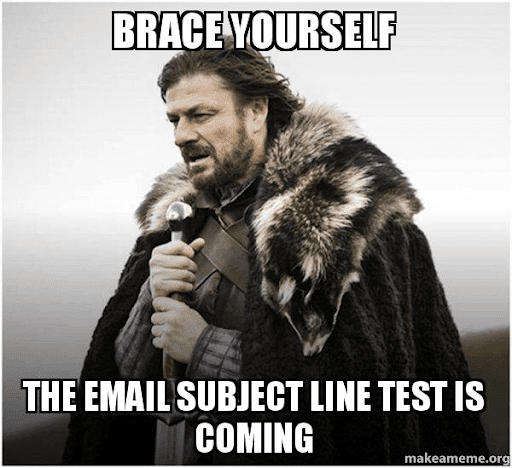
A/B testing
Every audience is different, and in some cases, one subject line that worked previously won’t be that effective anymore. And then, there is the following fact:
A/B testing can increase email open rates by 49%.
That is why you need A/B tests as much as possible. In order to do this, take 3 to 5 subject lines and send out those cold outreach emails to check which one has the highest open rate.
For example, in Skylead, you can test different subject lines for your outreach campaigns on autopilot and see which one works best for you.
Online email subject line testers
Online email subject line testers are nifty tools to have at hand if you are not sure about the effectiveness of your subject lines. Whether you wish to test the emotional tone of voice or the overall effectiveness of your subject lines, you can use tools such as Send Check It, EMV Headline Analyzer, or GradeMyEmail.
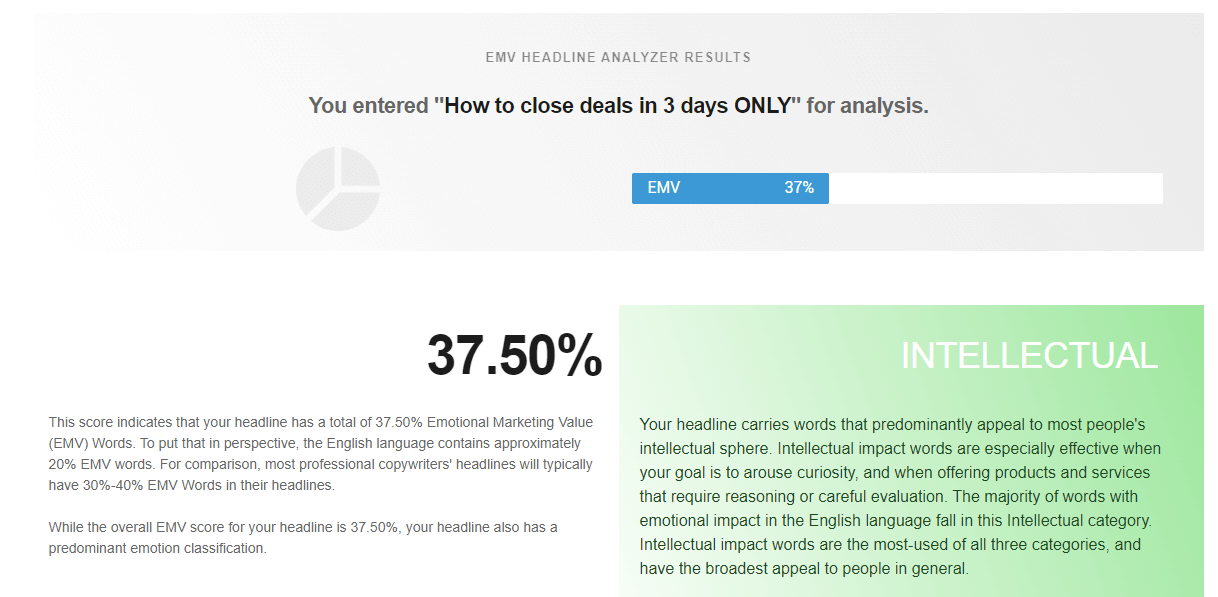
Email subject lines DON’Ts
1. Hi there
Avoid phrases such as Hi there, Greetings George, or Hello. The reason is they aren’t specific enough and do not show any hint of what the email message is all about. Instead, draw your prospect’s attention by clearly stating the purpose.
2. Misleading prospects
Being deceptive and promising your prospect one thing in the subject line and showing them another will annoy them. Consequently, you will lose trust and respect instantly. Not to mention, you will fail to close the deal with the prospect forever. Therefore, avoid click baits, or RE: and FWD: entirely just to get them to open up an email.
3. DO NOT USE ALL CAPS OR BUNCH OF EXCLAMATION POINTS!!!
See how that was unnerving and frenzy-like? Using letters in Caps Lock or with multiple exclamation points is a synonym for spammers these days. It also looks aggressive and distasteful, and you do not wish that for your brand, trust us. Furthermore, if you use this kind of email subject line, you risk getting your emails in the Spam folder. However, Caps Lock and exclamation points are not prohibited - you can always use one from time to time to emphasize your statement, but please do not go overboard.
4. Avoid spammy words
Similar to all-caps-lock words and multiple exclamation points, spam words can also ruin your outreach efforts. These words have been all over the internet for many, many years (not to mention billiards in the 80s) and are now considered repulsive and plain out pushy.
Here are a couple of examples to watch out for:
- Act Now
- Cash
- Cheap
- Credit
- Double your ROI
- Earn Extra cash
- Millionaires
- Free
- Fast money
- Get it today
Catchy email subject lines examples and templates
Follow up email subject lines
- Had a {{Topic}} idea for you since we last spoke
Example:
Had a social selling idea for you since we last spoke
- Been thinking about what you said
- Should I give up on you and close the file?
- I forgot to mention in our meeting that…
- The final and easy step…
- Tuesday meeting at 10PM
- Sending info I promised 👉
- I spoke with {{ReferredName}} and they said…
Example:
I spoke with Mark, and he said…
- Down to business - How we can help
- Need any help?
- {{firstName}} I need your advice
- Have 5 minutes for a quick call?
- I don't expect you to open this email but…
General cold outreach email subject lines
- ❤️ how you contribute to {{DesiredResult}}
Example:
❤️ how you contribute to closing the deals faster
- {{firstName}} let’s connect
- Are you completely happy with {{CompetitorName}}?
- Get lifetime access to {{SoftwareName}}
- What are your insights from {{Event}}?
- The most exciting opportunity for {{Industry}} companies in 2024
Example:
The most exciting opportunity for insurance companies in 2024
- Saw your amazing post - Interested in creating shared content?
- Exclusive for {{CompanyName}}: 3 tips to get conversion faster
- Congrats on {{Achievement}} 🥳
Example:
Congrats on becoming CEO 🥳
- Join forces? 👊
Urgent email subject lines
- Do you have these numbers and analytics yet?
- Hot conversion data insight for {{CurrentMonth}}, 2024
- Resource on {{Topic}} that’d go great in your {{Topic}} post
Example:
Resource on Email Statistics that’d go great in your Outreach post
- Omg {{firstName}}...
- It doesn’t look good
- 10 must-know trends to keep up on the market
- Your Free Trial is ending!
- Save 30% before the New Year
Email subject lines that entice curiosity
- Everyone’s favorite {{Occupation}} trick is…
Example:
Everyone’s favorite Sales trick is…
- 🤫 Real secret to {{Task}} or {{Benefit}} is…
Example:
🤫 Real secret to outperform outreach is…
- About your approach…
- I have a question about how {{DoingRelevantTask}}
Example:
I have a question about how you handle budgeting
- Does Thursday work for you?
- New year, a new strategy to {{Goal}}
Example:
New year, a new strategy to achieve 50+ conversions a month
- Are you taking advantage of your detailed reporting?
- How we accomplished {{DesiredResult}} in 2 months
Example:
How we accomplished 6x more sales in 2 month
- {{RelevantTopic}} trends that are the talk of the town
Example:
Sales strategy trends that are the talk of the town
- Save 5 hours a week with {{Task}} on autopilot
Example:
Save 5 hours a week with outreach on autopilot
- 56% of {{JobPosition}} use this trick to improve conversion
- A cheat-sheet for better conversion — Interested?
- {{Topic}} resources that can help you at this time
Example:
Cold outreach resources that can help you at this time
- 4 tips to help increase sales during hard times 💪
- It’s that simple 😃
- Few in the {{IndustryType}} know about these hacks
- Pick one out of these 2 strategies
Email subject lines that address pain points
- How to survive {{PainPoint}}
Example:
How to survive working 10 hours a day
- 5 easy steps to beat {{PainPoint}}
- How to deal with {{PainPoint}}
Example:
How to deal with LinkedIn algorithm
- 5 Ideas for {{PainPoint}}
- A resource to help you with {{PainPoint}}
- How happy are you with {{Department}} performance?
Example:
How happy are you with Sales performance?
- Steal this strategy from us - It will work for {{PainPoint}} 😁
- 7 tips for turning {{PainPoint}} around
- Proven solution to {{PainPoint}}
- Tired of {{PainPoint}}? Let’s have a chat
Subject lines that relieve pain and offer solution
- The fastest way to reach your Q2 target 💹
- Here is the shortcut to {{Benefit}} 🙌
Example:
Here is the shortcut to tracking performance easier 🙌
- Help is on the way - best strategies for LinkedIn lead generation
- Problem with closing the deals? Here is how to fix it easily
- Save up 5 hours of work per week
- {{ProductOrSolution}} empowers companies such as {{CompanyName}}
- Ready to implement {{Tool}} to eliminate {{PainPoint}}?
Example:
Ready to implement Skylead to eliminate wasting time on manual outreach?
Personalized email subject lines
- {{firstName}}, I was researching {{CompanyName}} and…
- {{ReferredName}} said to reach out to you…
Example:
Your colleague Steve said to reach out to you…
- {{ReferredName}} think you’ll love us too
- {{firstName}} I loved your post on LinkedIn about {{Topic}}
Example:
Sandy, I loved your post on LinkedIn about how to modernize sales
- Does this work for you {{firstName}}?
- {{firstName}}, a quick question regarding your performance
- {{firstName}}, I notice you try to achieve a 50% increase in sales
- Opportunity for {{CompanyName}}
- Partner up with {{CompanyName}}
- {{firstName}}, I have a story for you
- {{TheirCompetitorName}} VS {{CompanyName}}
- {{firstName}} perform {{Task}} better from Now on 💪
Example:
Andy perform outreach better from Now on 💪
- New managing employees strategy for {{CompanyName}}
- Loved the blog you wrote for {{CompanyName}}🔥
- {{firstName}} I missed you at {{Event}}
- What is your expert opinion on {{Topic}}, {{firstName}}?
Example:
What is your expert opinion on social selling, {{firstName}}?
- {{firstName}} is there a lot on your plate r/n?
Humorous email subject lines
- 🌮 Can we Taco ‘bout your growth?
- ⚽ I wondered why the ball was in my court, then it hit me
- I tried an elevator pitch - it was great on so many levels 🆙
- 🐝 You are likely an indecisive bee. Might I call you maybee?
- 🤝 Connect with you in present or future? It’s kinda tense
- 🪐 Should I organize a space for our meeting and planet?
- ⛵ Need a {{Topic}} strategy arc? I Noah guy.
Example:
⛵ Need a Sales strategy arc? I Noah guy.
- My coffee is mugged and waiting for your call 😅
- I'm gonna make him an offer you can't refuse…
- May the Force be with you, and {{YourCompanyName}}🌌
- {{ReferredName}} said to say hello to his little friend 🙋
- “You can’t handle the truth!” Or can you?
- Shaken, not stirred. 🍹 A {{Resource}} you asked for.
Example:
Shaken, not stirred. 🍹 A Guide To Outreach you asked for.
- I like {{ProductOrAService}} as my wine - sweet and victorious. Do you? 🍷
Frequently asked questions
How can one effectively A/B test different subject lines to find the most effective one for their audience?
A/B testing for email subject lines involves sending two variants to a small segment of your audience to see which performs better, then using the more successful one for the broader audience. Monitoring open rates for each variant provides actionable insights. You can automate A/B testing by using the LinkedIn automation tool and cold email software with such a feature, like Skylead.
Are there specific strategies for crafting subject lines that improve click-through rates, not just open rates?
To improve click-through rates, subject lines should create curiosity or offer value that compels the recipient to discover more inside the email. Personalization and urgency can also encourage clicks by making the email feel more relevant and time-sensitive to the reader.
How do the recommended subject lines perform across different industries, such as tech versus creative fields?
The performance of subject lines can vary by industry due to different audience expectations and content relevance. Customizing subject lines to reflect the specific interests and language of your target industry is crucial for maximizing engagement.
Summary
Strong and catchy email subject lines are mesmerizing and alluring to your prospects. They are links between your leads and your message. For this reason, it is important to make it as perfect as you can so you can increase the open rate, nurture the prospect and ultimately close the deal. And when you pass through the importance of it all, creating email subject lines and testing them can be fun indeed.
Here is a quick throwback of what you should and shouldn’t do when writing the email subject lines.
| Email Subject Lines DOs: | Email Subject Lines DON’Ts: |
| Use personalization | Avoid words such as Hi and Greetings |
| Make emojis your best friend | Do not mislead the prospects |
| Include numbers | Avoid words in Caps Lock |
| Make timely email subject lines | Remove excessive exclamation points |
| Hint the valuable content inside the email | Avoid symbols such as $$$ |
| Test your email subject lines | Forget about spammy words |
Now it’s your turn. Go and rock out those subject lines!
Wish to use Skylead for your outreach campaigns and A/B test your emails? We would be glad to hear from you and chat. Say hi by scheduling a Demo with us.
Blank email interface. Insertion point flickers on your document. You can feel it staring back, almost judging you for not knowing what to write anymore for your cold email outreach. You tried everything - it’s not working, and you don’t understand what you are doing wrong.
Once again, without any inspiration, you scribble what your company does, offer a product, and mass blast it.
You wait. A couple of days later, history repeats itself. There is no response.
You think to yourself ’’This is too hard’’, or worse ’’This is not working for me’’.
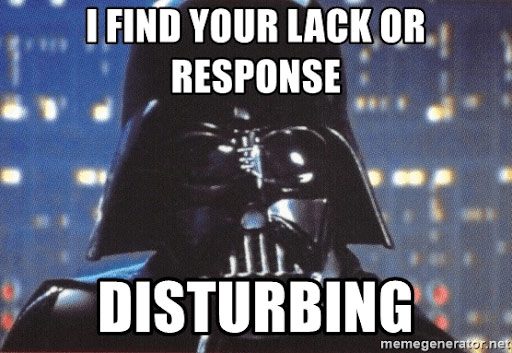
As Darth Vader, you start breathing heavily. Take off the mask and get wind of the list of cold email mistakes you're probably making, what impact they have on your email metrics, and how to fix them to improve email campaign performance.
Do not worry. These mistakes happen to everybody.
The most important cold email outreach metrics
Before we dive deep into these email mistakes, let’s recap the metrics you need to track that will tell you a lot about your overall campaign performance.
Understanding and tracking the email metrics is crucial when deciding if your outreach campaign was victorious. It’s like putting a billboard up in the city and not knowing how many people saw it or bought your product afterward. Thanks to technology, now you can.
To be more precise, to measure email performance, you need to knowhow many emails were bounced, opened, responded to, and how many people converted via cold email outreach. Once you have that mastered, you can start creating engaging cold email campaigns.
#1 Cold email metric: Bounce rate
Bounce Rate in email outreach is the total percentage of email messages that have not been delivered successfully. This can happen if for example an email address is invalid or there is a technical issue with the email provider.
How to calculate email bounce rate
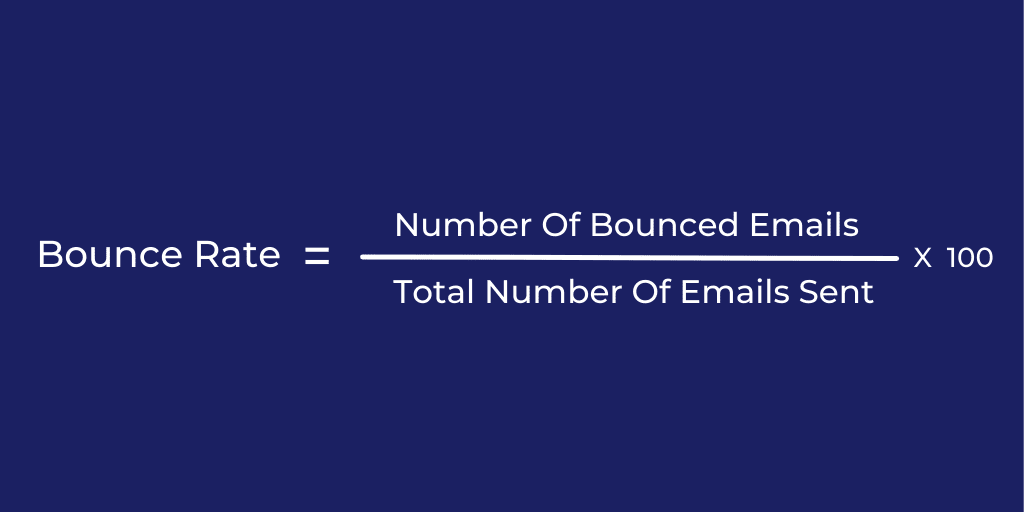
Example:
Let’s say that during your email campaign you sent 1000 email messages. Out of those, 98 weren’t successfully delivered. The calculation would go like this:
Bounce Rate = 98 / 1000 x 100 = 9.8%
#2 Cold email metric: Open rate
Email open rate is the percentage used as an indicator of email campaign health. The higher it is, the better.
This metric doesn’t tell you a lot about the email convertibility as a whole. However, it can indicate why it wasn’t opened, whether or not your subject line, or preview text (first several words of your email body) are appealing or can imply broken email deliverability.
How to calculate email open rate
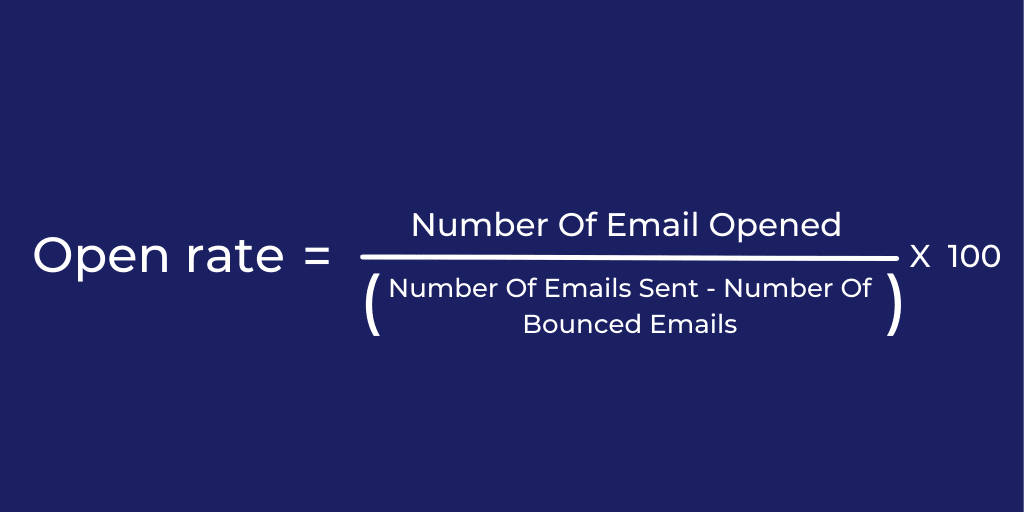
Example:
Taking the numbers from the previous example, say, you have 1000 sent out, 98 out of those bounced and 565 were opened. The calculation will go like this:
Open rate = 565 / ( 1000 - 98 ) x 100 = 62.63%
#3 Cold email metric: Response rate
It’s nice to have a high Open rate, but it is even better to have a high Response rate, as well. As per its name, this metric indicates the number of individual emails in the cold campaign that leads responded to. This metric shows the quality of your email’s content. Ultimately, a good response rate means that you’ve managed to get the lead’s attention.
How to calculate email response rate
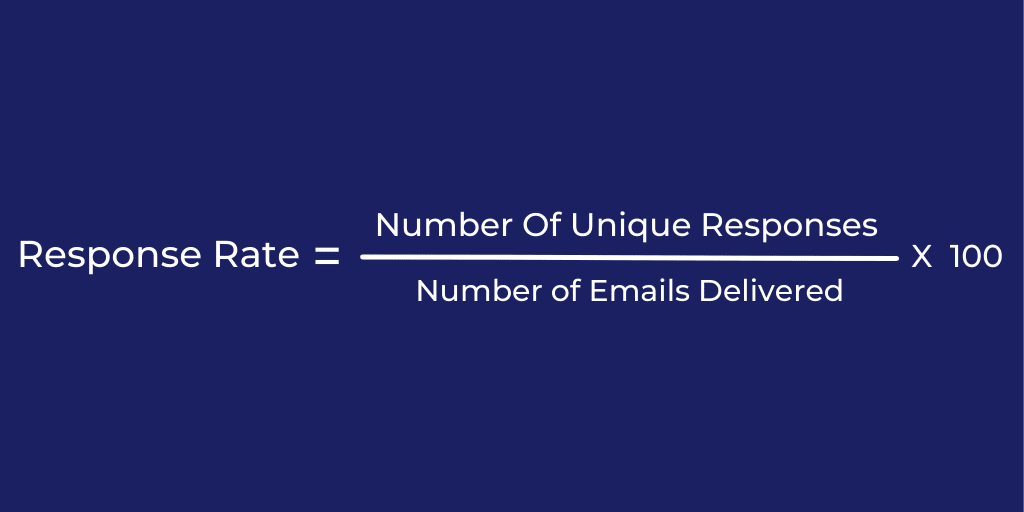
Example:
Continuing the example thread. Now you have 902 unique emails that have been delivered. Out of those, only 133 leads responded. The calculation goes like this:
Response rate = 133 / 902 x 100 = 14.75%
#4 Cold email metric: Email conversion rate
Conversion is an activity when a lead completes a desired goal, such as signing up for Demo or starting the Subscription. That said, conversion rate for email outreach is the percentage of prospects who took the desired action from your email campaign.
To find out more about conversions, their types, and other KPIs, check out 5 Must-Know KPI Metrics to Grow Your B2B Business [Bonus Metrics Included].
Needless to say, the conversion rate is the ultimate metric to figure out if an email campaign was successful.
How to calculate email conversion rate
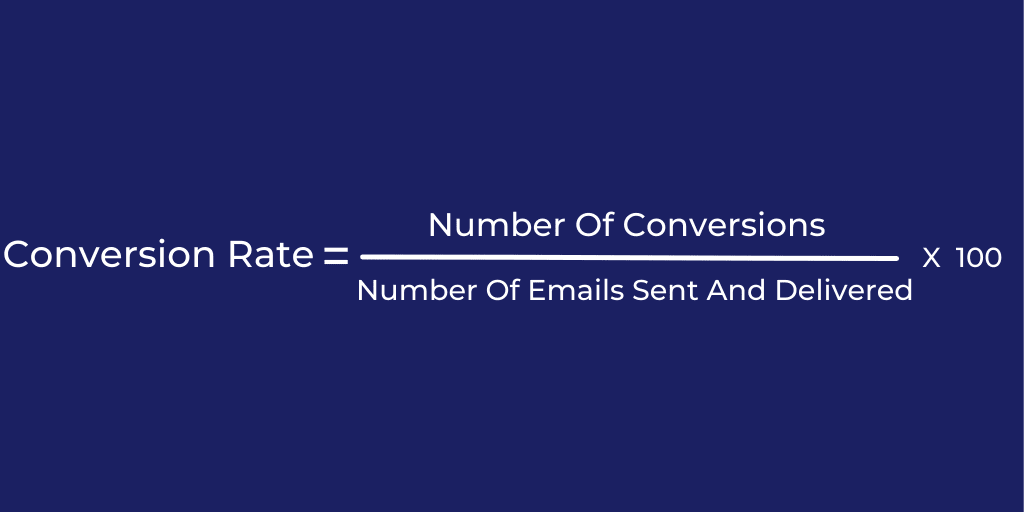
Example:
Out of 902 successfully delivered emails, you have 36 conversions in total. Calculation is the following:
Conversion Rate = 36 / 902 x 100 = 3.99%
Now let’s see what email mistakes you are making that negatively impact these metrics and how to correct them.
Cold email outreach mistakes to say goodbye to
Successful email outreach is a lot tougher than ever these days. With so many emails cramping up the leads inboxes, it is hard to remember and know what best works for your targeted prospects, let alone see the mistakes that slither in without you even noticing.
That’s why we created this ultimate guide to the most common email mistakes, how they affect the metrics, and how to fix them. First, let's break the email mistakes down into the following four categories to make it easier. There are Email Mistakes:
- Affecting Deliverability
- Regarding Content
- Related To Attitude Towards the Prospect
- Affecting Sales Process
I Email mistakes affecting deliverability
1. Acquiring poor quality leads
Let’s address the elephant in the room: many came across a situation where you are weighing options whether you should go for a cheaper alternative or not when buying prospects’ data. Unfortunately, the cheaper option almost always leads to devastating results in the end.
Starting, the leads’ contact information you get from unverified vendors might be completely untargeted for your outreach. You can get every mistake right on this list, but if your ICP is not targeted, the entire email outreach will fail.
Or, maybe the prospect’s name is incorrect, and you might address them wrongly which will definitely affect the response rate and you will lose this lead. Forever.
But there is a worse case scenario above all: if emails are invalid or non-existent, they can crumble your email outreach efforts because it increases the bounce rate and risks getting your domain blacklisted.
Think of it as the butterfly effect: the bigger the bounce rate is, the more it damages your domain health and increases the danger of getting your emails in the spam folder or domain blacklisted. It also decreases your open rate, response rate, and conversion rate in the long run.
What to do?
Buy the data from well-established and verified data vendors or gather the right information as first-party data yourself.
Another solution is to find a reliable partner for data research or introduce your sales team to a platform built for sales engagement - one that includes outreach and email discovery and verification features.
2. Adding a big number of links or sending the broken ones
Everyone wishes to tell the prospect as many things as possible about our product or service. We want to show them the blogs, ask for a meeting, attach a whitepaper file and add alternative comparison pages for them to see. While this confuses the prospect regarding CTA (which we will mention below), it also overcrowds the email itself, making email providers raise their robot heads as bloodhounds. Too many links or files in your email will trigger a warning to the email provider and increase the possibility for your emails to twirl down to the Spam folder.
Furthermore, if you send a broken link to prospects, they will think of you as an unprofessional or worse spammer, and it will decrease the response and conversion rates, as they will lose interest in you.
What to do?
Try to keep the number of links to a minimum as you can (preferably without any links), and of course, check the links before sending.
Additional tip: If in your signatures you have linked icons, check every one of them. As those links count as well, and sometimes they get broken, it’s better to be safe than sorry.
3. Sending too many messages per day
We all wish to send as many emails as possible for a short period. But this is a big mistake, especially if your email address is new. Sending too many emails per day can result in your messages ending up in the Spam folder. This can be one of the causes of your open rate dropping.
What to do?
Slowly warm up your email address manually by sending a low number of emails, and then gradually increase the volume over some time. Or, use email warm-up tools to do it automatically. The warm-up of a new email address or domain can last from 30 to 90 days.
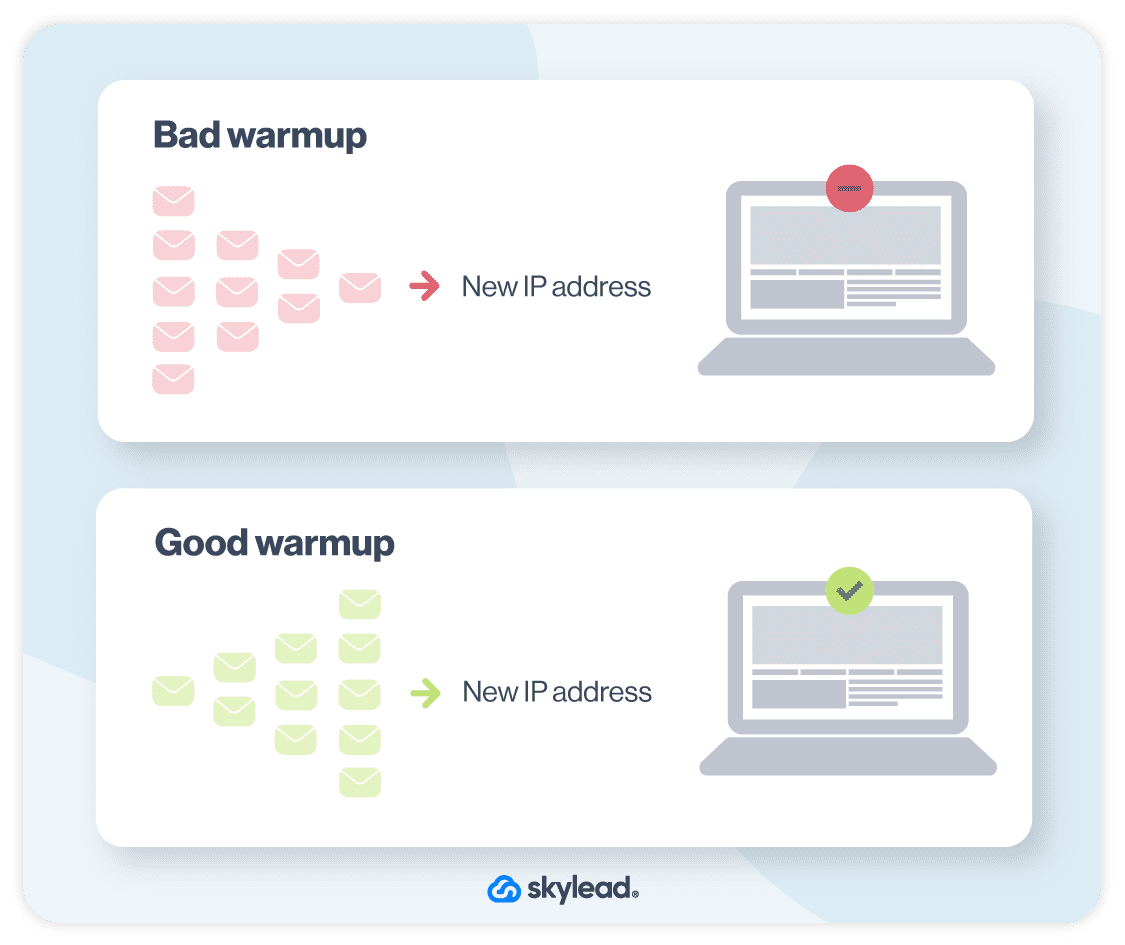
II Email mistakes regarding content
4. Being too casual or too formal
Balance is everything. Sales representatives sometimes go overboard trying to get their prospects to laugh, which only ends up being too cringey. We do not say GIFs or jokes are bad, we even use them in outreach, and thread them to the context of the message. So know what thy boundaries are.
Then on the other side of the scale, we have an overly formal approach. The truth is that everyone wishes to be respected, so a formal approach is good, but if you go overboard, you will sound like a robot.
What to do?
Find the balance between the two scales. You can even send personalized GIFs or Images to show creativity and genuine interest, but keep it tasteful.
When it comes to an overly formal approach, you can loosen up a bit.
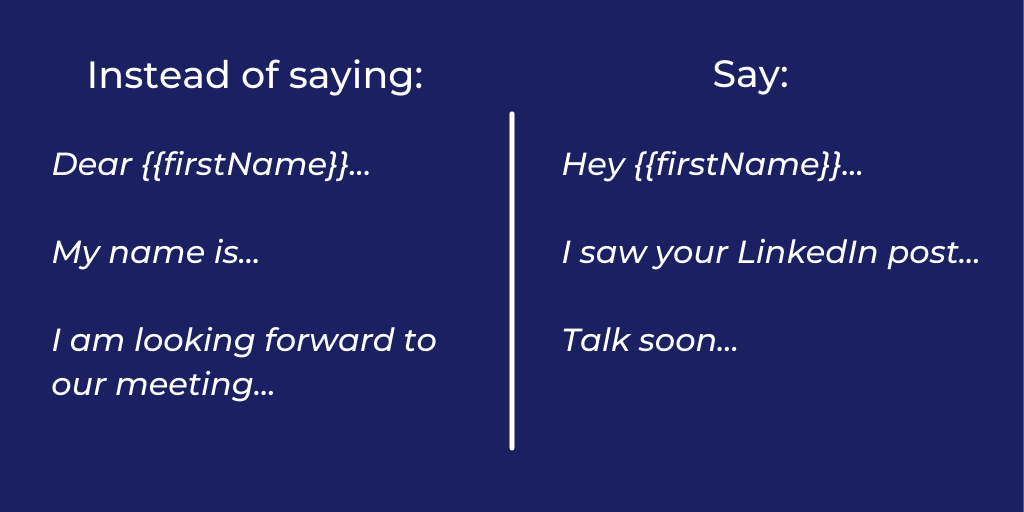
5. Subject lines mistakes
Coming up with the subject line cannot be an easy feat. It has to be attractive, short, explain everything but still leave the prospect interested in clicking on it. As challenging as it is, there are still some mistakes people make when it comes to these:
- Spammy or clickbait subject lines - Big no. It will only enrage your prospects.
- Subject lines not specific enough for the market – This can cause lower open rates as the prospects will not relate to the email at all.
- Subject lines in caps lock - It’s good to be excited, but you don’t need to shout at your leads to get the attention.
What to do?
These mistakes influence every important email metric starting open rate, so make sure to avoid them. Think about how you would attract the leads’ attention and bind the subject line as a whole with the email body. Even better, try to make the subject line as a prequel to your Preview text of the email and make it a united lead magnet.
6. Message copy not relevant to the market
As mentioned for the subject line, you need to keep a close eye on your email content's relevance to the market, as well. Writing an email not relevant to the industry can result in a lower response rate and conversion rate.
What to do?
Go full private detecting on this one. Research the industry, find the pain points. Go even further - find prospects' companies and information about them. Show them you understand the industry problems and what solution you offer instead.
7. Self-centered messages to prospects
Writing messages that are more focused on you instead of your prospects’ companies can come across as being too aggressive or assertive, resulting in lower response rates.
What to do?
Instead, be aggressive in knowing your lead: Showcase the research you did on them, ask for the call to know more about their pain points and see how your product or service can aid them further.
People resonate with what’s in it for them. Talk about them, gain their interest through email.
Example:
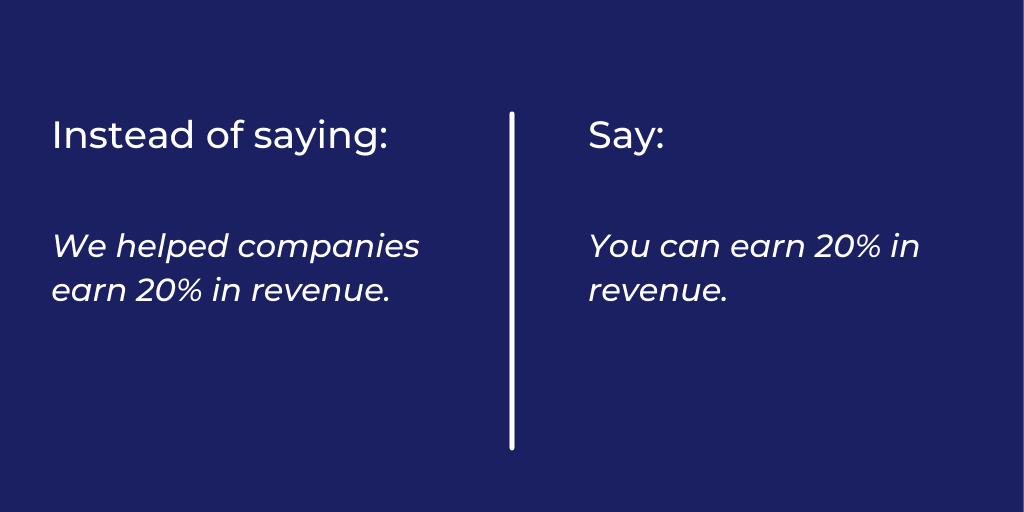
8. Adding too much CTAs or not at all
As mentioned above, if you wish to show the prospect the blog posts, ask for a meeting, add alternative comparison pages for them to see, and top it off with a YouTube video - Stop.
All these are a type of call to action, and piling them in one email will only confuse the prospects regarding CTA.
On the other hand, if you do not use CTA at all, you will lose the purpose of your cold outreach, so the prospects won’t have action in their mind to fulfill.
What to do?
The goals of outreach campaigns are different for every purpose. Define one short CTA, and stay away from the unclear ones.
For more information on CTA in sales emails, check out our Detailed Guide On Crafting The Powerful Call To Action.
9. Not enough value
Often, our value proposition is not deep enough, doesn’t hit the bullseye, and is too generic. This directly affects the response rate, and you will lose the prospect as you weren’t compelling enough.
What to do?
Once again, put on your detective glasses and go into deep search of a particular prospect’s main pain points. You need to know and understand them.
If you can explain their situation better than they can, they will automatically assume you have the solution and gain interest.
Example:
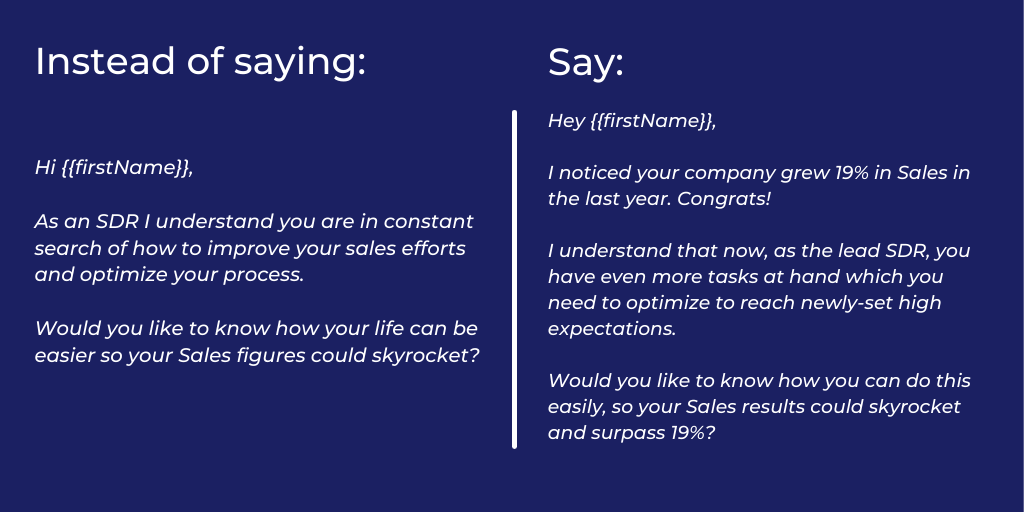
10. Unnecessary text length
If your cold email message is too long and has numerous paragraphs, take a step back.
Let's say you are reaching out to CEOs or other higher-up positions. They usually have a lot on their plate, so you probably know the one virtue they lack is time. Please make sure to not waste it.
What to do?
If you can draw the line through any piece of your text without losing the value, remove it.
Let's say you have sentences such as:
- I know you are busy but...
- I’m following up...
- I’d love to give you a demo…
- Do you perhaps know when would be the best time...
You won't lose the value if you cut them off. So instead, tell them something short, sweet, and essential about their business in particular, straight to the point:
- I see that your company struggles with VALUE...
- Would Wednesday at 10 AM work for you...
III Email mistakes related to attitude towards the prospect
11. Questioning the prospects integrity and authority
Now we have a mistake example, which is little farther down the cold email outreach sequence. Let’s say you have a correspondence with the lead from medium or large company who you are not sure if they are a decision maker or not.
Asking a straightforward question ’’Are you the right person?’’ or responding ’’I guess you are just not the right person to reach out to’’ after they do not reply is a big no-no.
Simply do not ask a straightforward question if someone is a decision-maker. If not a decision-maker, they would feel invalidated.
Or maybe they indeed are, but your outreach was just not that compelling enough to respond to, or they might think ’’If I'm not, would you treat me with the same respect?’’ Either way, this is how you will decrease your conversion rate.
What to do?
If you really wish to know if someone is the right person to reach out to, then you can say something like this:
When you bought this {{Product}} in the past, who was involved in the process?
12. Being authoritative over or submissive under the prospect
There are three ego states in the body: child, adult, and parent ego state. If you command someone to do something, you talk to someone from the parent's ego state, and they will automatically go to their child's ego state.
An example would be ’’Let me know the time that works for you’’.
How would you feel if you got this sales email?
Would you want to rebel against that sentence? Your prospect would want to rebel too.
Another example would be if you start your email with just a prospect's name, it will trigger a child's ego state, and they will think they are in serious trouble. You would want to increase the chance of somebody responding, so when cold outreaching, your goal should be to trigger ONLY their adult ego state.
What to do?
So what to avoid in communication exactly?
- Commanding to prospects to do something (Child ego state trigger)
- Putting accountability on them for not responding (Child ego state trigger)
- Invalidate their objections (Child ego state trigger)
- Sentences like:
- Just checking in...
- I know you are busy but…
- Would you have the time… (Parent ego state trigger)
Overall avoid triggering their Parent or Child ego state. Instead, trigger an adult ego state.
For example, instead of saying:
Would you have the time…
You can offer an up-front contract. For example, write the exact time and date of the meeting and ask for consent. Additionally, provide a sales meeting agenda for your call.
13. Judging or making the prospects feel bad
Even though you think you will never do this to your prospects, this type of mistake is one of the most common ones.
The first example is being harsh regarding the leads' choice to use similar products. Even though you are not saying anything bad about the leads themselves, you are indirectly insulting the decision they made. This easily translates to insulting them.
What to do?
Instead of judging the prospect for using a competitor and bragging why your product is better, say something like this:
Oh, you are using an XY competitor? That’s great! So you are familiar with the type of product itself. What differs our product from them is…
Also, do not allow your words to make your prospects feel bad. Put the onus on you, not on your prospect.
Example:
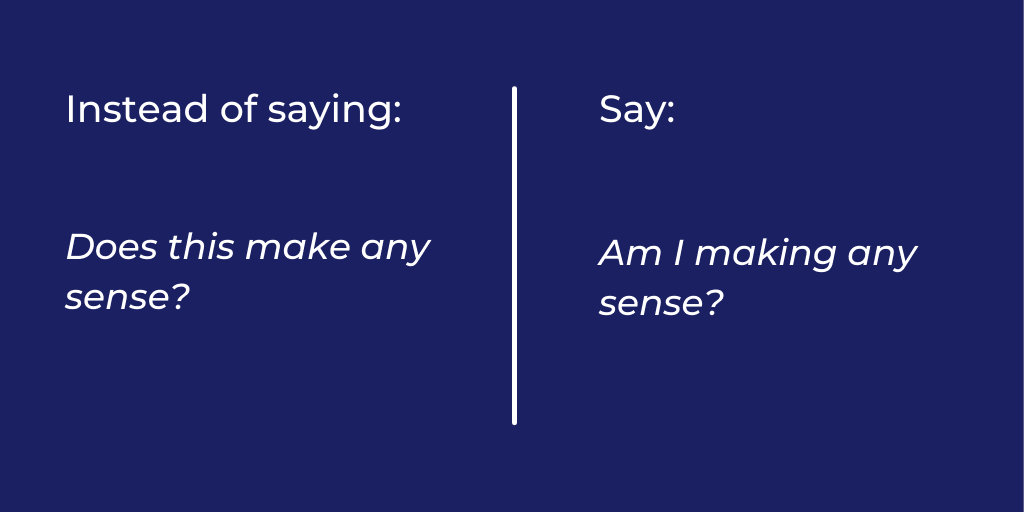
IV Email mistakes affecting sales process
14. Not setting up follow up messages sequences
Not having your follow-up game is the next in line of common lead generation. If the prospect doesn’t reply, do not give up.
Follow-up emails always get a better response rate than the first email. In this study, there is an illustration of difference as follow-ups got 18% response rate higher than the first email, 13% to the fourth, and 27% to the sixth email *.
What to do?
Set up follow-up emailing sequences for the prospects who did not respond. Even if they do not respond to these follow-ups, insert them for other purpose sequences. Never give up, and never give in.
15. Not tracking email campaigns’ performance
As we mentioned in the beginning, tracking is everything when it comes to your sales effort, especially if we talk about cold outreach.
If you do not know what you are tracking, how would you know if the channel is effective?
What to do?
So be sure to set and track the following:
- Bounce Rate
- Open Rate
- Response Rate
- Conversion Rate
On the other hand you can use a sales engagement tool and cold email software such as Skylead to track it for you. Analyze the chosen tool thoroughly and start tracking your performance.
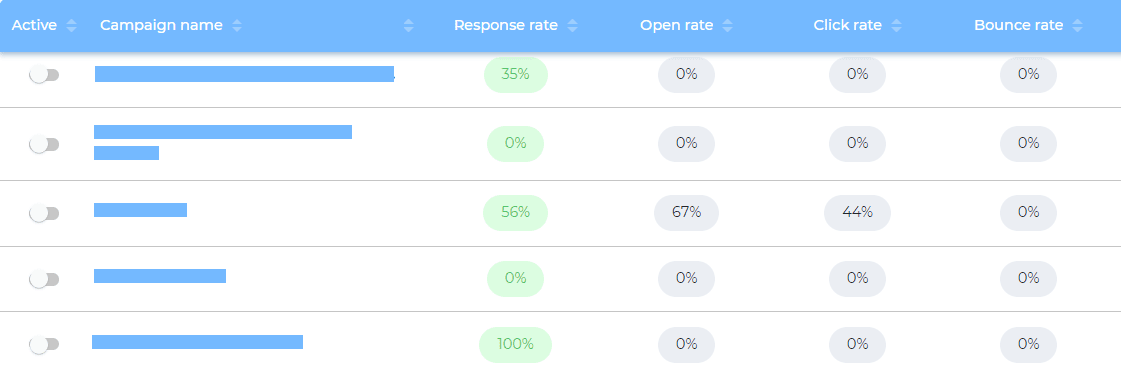
Honorable mentions
We cannot finish this blog, without mentioning a couple of short email mistakes which are essential to correct.
16. Poor Grammar - you have so many grammar checkers and tools available on the internet nowadays to remove sloppiness in communication.
17. Using initials - signing your email message using your initials such as J.K. can come across as unprofessional. Use your full name and surname in your signature.
18. Not personalizing the email - Nowadays, in the cold outreach, you need to step up your personalization game, especially if you did the prospecting first. To learn all about outreach personalization check out Cold Outreach: Increase The Level of Personalization [+Templates]
Summary
Cold email outreach is still a powerful tool for lead generation and conversion if done right. Take time to study all of the mistakes mentioned above, let them be your guide, and double-check.
Here are all the email outreach mistakes to serve you as a checklist:
1. Acquiring Poor Quality Leads
2. Adding A Big Number Of Links Or Sending The Broken Ones
3. Sending Too Many Messages Per Day
4. Being Too Casual Or Too Formal
5. Subject Lines Mistakes
6. Message Copy Not Relevant To The Market
7. Self-Centered Messages To Prospects
8. Adding Too Much CTAs Or Not At All
9. Not Enough Value
10. Unnecessary Text Length
11. Questioning The Prospects Integrity and Authority
12. Being Authoritative Over Or Submissive Under The Prospect
13. Judging Or Making The Prospects Feel Bad
14. Not Setting Up Follow Up Messages Sequences
15. Not tracking email campaigns’ performance
16. Poor Grammar
17. Using initials
18. Not personalizing the email
Now get too cold email writing - You’ve got this. Godspeed!
Wish to level up you outreach and track campaign's performance successfully? See Skylead in action - Start your 7-day Free Trial.
The rules of selling have changed.
A formal product presentation days where Sales Representatives would meet face to face with their potential customers are far behind us.
Nowadays, around two-thirds of the B2B buyers make their decision via online content.
And as you're not the only one with an online presence, you need to find a way to stand out in the era of information overflow.
Nowadays, LinkedIn is the platform that provides salespeople with valuable tools for prospecting on LinkedIn, and researching ideal customers. It allows them to get in touch with their perfect leads and send product or service offers directly in their Inbox.
However, just like salespeople put in less time to reach their potential customers, it takes only a few seconds for customers to decide if they have any further interest in what you are presenting.

The age of the customer
The ability to quickly access information about any product or service changed how business is being done.
Furthermore, customers openly talking about their experience with your company and sharing it for everyone to see has had a considerable impact when opting for a product or service.
Customers are tired of random products and services being pushed into their faces.
They want to hear from salespeople who know how to adapt the qualities and properties of what they have to offer to their customers’ needs and expectations.
They want you to know what they lack better than they do.
The salesy lingo doesn’t work anymore. Moreover, it is highly unwelcome.
So, for all of you that use this platform for LinkedIn Lead Generation and sales engagement activities, here are 5 tips on how to sell without sounding too salesy.
A pitch should never be your first conversation
When you are connecting with someone on LinkedIn, it is highly frowned upon to start a conversation with a pitch.
Moreover, when approaching a potential lead, the Invite to Connect is what in real life is the first impression. You only get a couple of seconds to catch your prospect’s attention or be dismissed for any reason.
That’s why the best way to approach a potential customer is to make a reference to something that you have in common.
It could be a shared interest, you might be members of the same LinkedIn group, work in a similar or adjacent industry, or have attended a specific LinkedIn event, etc.
This type of well-thought approach brings high acceptance and response rates.
Here’s an idea for your Invite to Connect.
[template]
Hello {{firstName}},
I see that you attended the “5 Marketing Strategies for a Post-Covid World” event.
As someone with {{totalYearsInCareer}} experience in the industry, I would love to hear your thoughts on a multi-channel approach to engagement.
After you’ve been accepted, you can proceed following the same “hook”.
[template]
Multi-channel outreach implies so many online and offline channels of communication!
When speaking of LinkedIn, Skylead is an online platform that combines messages, InMails, and Emails with LinkedIn features such as View, Follow, Invite to Connect, etc., to create the highest number of touchpoints with your perfect leads.
It is a very effective way to do multichannel outreach and, with the right targeting, you will be able to generate and get through to leads who are most likely interested in whatever you have to offer.
I would love to tell you more about it. Would you like to join our group Demo Call? By clicking on the link, you will see several dates and times available.
I look forward to hearing from you!
Best,
Joshua
Avoid hyperbolic words & phrases
Avoid hyperbolic words such as “cheap”, “one-in-a-lifetime opportunity”, “incredible”, “amazing”, “promotion”, etc.
Clients take these statements with skepticism.
Instead, show them that you’ve done your research and that you are messaging just because you genuinely believe that what you have to offer will significantly improve the quality of their business.
Be precise where exactly you’ve seen room for improvement and how you can help.
Use words that imply the same.
There is no better selling proposal than the one that is supported with well-researched facts.
[template]
Hello {{firstName}},
I have been following the work of {{currentCompany}} for quite some time now.
Due to your vast experience in the role of {{occupation}} at {{currentCompany}}, I am sure you know the struggle with the timely and accurate flow of critical information during international transport.
I am here to offer a solution.
“OnTheWay” is an application developed in collaboration with over 100 customs worldwide. It provides the most precise, reliable, and real-time information on any type of international shipment. You will be able to give even your biggest customers the exact day and time of their long-awaited purchase.
I would love to schedule a call and further discuss the benefits it could bring to your company.
Best regards,
Evan
Turn your sales into a conversation, not a rehearsed monologue
A genuine back-and-forth conversation will work more to your advantage than just blurting out a rehearsed monologue.
By asking thoughtful and well-aimed questions not only will you keep your leads interested but you will also gain a more thorough understanding of what they exactly need.
This will allow you to position your product or service better in comparison to your competitors that “haven’t done their homework”.
Of course, all of this is on the condition that you have previously targeted your audience well enough to know that most likely there is room for your product or service to help.
Start with something like this.
[template]
Hello {{firstName}},
I can see that you’ve been working in the Manufacturing Industry for quite some time now.
As someone who has been holding the position of {{occupation}}, what is your experience regarding the problem of forecasting demand for products?
Thank you so much for sharing!
Best,
Robert
Once your lead answers back, you can go ahead and investigate further on what they need.
[template]
Thank you {{firstName}} for sharing your insight!
I hear you.
Forecasting demand for products is for sure one of the main challenges of any Manufacturing business.
If you fail the customer demand, your sale will significantly drop. On the other hand, the cost of producing too many items that don’t sell weighs hard on your budget.
Do you mind sharing how you have been handling it so far?
And then, once you’ve come to the root of the problem, try selling your service by showing them how it can apply directly to their particular situation.
[template]
That is quite an interesting way of dealing with it.
What if I told you there was a management system that helps manufacturers analyze consumer behavior, which products they are interested in, when they usually make purchases, how many products they buy at certain times, etc?
Would you be interested in hearing more about it?
If the answer is yes, go ahead and explain why doing business with your company will save them time and money.
Make it all about them
At the end of the day, customers don’t care about the product or service itself. They care about what it can do for them.
And with that being said, it means that they don’t even care about how that product or service worked for YOU. People want to know how it can change THEIR lives and the way THEY have been doing business.
So, when you are reaching out to your potential customers, never start with “Here is how {{product}} helped ME”.
[template]
Hello {{firstName}},
Thank you for taking your time to hear me out!
I am reaching out because I would like to show you how our software could save up to 6 hours a day to your Sales Team while producing 10 times more leads.
- Email Discovery & Verification works perfectly for your cold emailing campaigns. You will be able to discover verified business emails of your LinkedIn leads and expand your prospects list.
- Real-time insights offer detailed analytics so that you can evaluate which campaigns produce the best results.
- Smart Sequences combine LinkedIn with Email Outreach. Would you consider adding LinkedIn outreach to your sales and marketing efforts?
Let’s hop on a Demo Call and discuss how your company can further benefit from it!
Best regards,
Mary J. Luis
It’s OK not to sell
Last but not least, you don’t need to sell at all costs!
Learn how to take no for an answer while still ending on a high note.
Being pushy will not turn a no into a yes. It could just refrain people from ever doing business with you in the future.
You would be surprised how often a genuine interest in customers and in selling them what they really need might result in them coming back or recommending your services to someone else. Even if they have never worked with you before.
Know when to stop, but also how to leave the ending open to a potential collaboration in the future.
[template]
Hello {{firstName}},
It was nice talking to you.
Thank you once again for taking the time to hear about my services.
I appreciate your feedback.
Should you have any questions in the future or simply want to exchange experiences regarding Event Planning, feel free to reach out!
Have a great day and good luck with all your future projects!
Best,
Michelle
Summary
Nowadays customers have access to enough information to make a purchase without ever talking to you.

However, it is usually a personal touch that gives them that extra push.
They want to feel heard and taken care of and not just some random target of the act of selling.
That’s why make sure to narrow down your audience as much as possible, research their needs and room for improvements, and then get through to them with a well-defined offer.
For more effective outreach, consider using a Sales engagement tool such as Skylead. It is an excellent choice for those who want to combine multichannel outreach for their sales process. Not only will you be able to send emails on autopilot but you will also, be able to find and verify business emails and hyper-personalize your outreach.
Long story short - be smart and let Skylead think for you.
Email Marketing has maintained popularity over the years.
It is an efficient way to get new leads, nurture relationships and raise awareness about your business.
With the right strategies, you can gain new customers, as well as develop trust with current clients.
That is, it can become a trusted way to boost sales and grow your pipeline in no time or simply sustain good results long term.
Some businesses have not yet developed tactics for productive Email Marketing. That’s why it is resulting in modest effects or no effects at all.
Disappointed by sparse returns, some have given up on the idea. Most likely they miseed out on perks provided by a good Cold Emailing strategy.
But were they right?

Why is Email Marketing important?
It’s true that in order to grow your business through Email Marketing you need to know a few tips and tricks. However, keep in mind that learning them will be very rewarding.
Did you know that, according to several studies, campaigns that were implemented through email generated significantly more profit compared to ones run through Social Media Networks?
Fact check: A whopping 99% of consumers check their emails every single day. Therefore, the cold mailing is one of the most reliable ways for businesses to develop relationships and boost sales.
Investing a single dollar in Email Marketing brings a return on investment of 40 USD.
Check how much better it rates compared to other forms of Digital Marketing in the chart below.

Knowing just how profitable Email Marketing is, makes learning the right methods definitely worthwhile. Additionally, with the right tool, you are guided through the experience with the utmost care provided by our Customer Support Team and cutting-edge technology.
With Skylead, you can send up to 100 emails per day. However, we always recommend starting off with a lower number, so that your emails don’t finish in a Spam folder.
Contacting leads through email is for sure the most sustainable way to reach more people over time.
So, how do you start Email Marketing or improve existing strategies?
We’ve prepared 10 tips and tricks to help you improve sales engagement via email and achieve the best results.
1. Understanding your audience
When starting out with Email Marketing, it’s crucial for you to understand your target audience.

Who are they?
What do they like?
How can they benefit from your services or products?
After you answer these questions, it will be much easier for you to figure out the perfect way to reach out to them. You will be able to find the tone your audience will enjoy, one that will truly captivate their attention.
But, wait, that seems like a lot of work!
Don’t worry. With Skylead’s state-of-the-art tool, the process of targeting is eased to the extent that building your perfect customer pool will take less than 5 minutes.
Also, have in mind that writing a copy that will be relevant to your target market is now pretty simplified. It will for sure result in a higher response rate compared to generalized Email Strategies.
2. Expanding your mailing list
Many people make the mistake of thinking that putting a form on their website and hoping that visitors sign up will be enough to expand their Mailing list.
Unfortunately, it doesn’t really work that way.
In order to really build an extensive network of potential clients, you’ll either need some time and creativity to get more leads, or you can rely on our innovative Email Discovery feature. It will help you access the email addresses of the most important people related to your industry in just a few clicks.
Skylead’s Email Discovery feature brings the possibility of collecting personal email addresses, incorporated in a lead’s profile, or even a business email.
The alternative is creating lead magnets that will help you receive email addresses. Give something for free in exchange for contact details. It can be a free ebook, a case study, or a product sample – really anything potential customers might find valuable enough to hand out their email address.
Ture, this can take quite some time and resources. But, if you’ve already managed to acquire a rich source of contacts, make sure you make the best use of it.
3. Nurture relationships
In order to reap the most benefits of your EM strategy, it will be necessary to build a relationship with people and companies from your contact list.
You can achieve this by sending out regular emails and follow-ups. These need to keep the interest of respective clients, which is crucial for boosting your sales efforts.
It’s not easy to manually send emails to each contact on your list. We understand that you’re already busy building your business and don’t have enough time to allocate to that part.
That’s why we in Skylead developed a tool that can help you save up to 7 hours a day. Skylead is there to send multiple emails, customize automated messages, and schedule your follow-ups. Furthermore, it is providing a well-organized dashboard and inbox, ensuring you never miss a single message.
4. Segment your mailing list
Not every offer will be equally interesting to your entire list. That’s why segmenting the list is a very important step. It can help you keep your efforts engaging by only sending relevant information.
The sublime labeling option in Skylead’s inbox allows you to best segment your recipient list using easy-to-use sticky notes, helping you provide a tailored experience for your subscribers.
Segmenting your lead list will help you speak directly to your consumer. You will be able to provide them with engaging content that will keep you out of the spam box.
5. Test, test, test
Skylead helps you run multiple campaigns where you can comfortably run A/B tests to figure out the most efficient approach for you.
Try it by pitching two campaigns A and B, to slightly different target groups, with slightly different messages and see how they will react. Track the outcome and find what works best for your business.
Also, there are target groups that are naturally more OPEN for InMails. Make sure to not forget that feature.
By combining all the features and options Skylead offers you, you’ll be more than able to run a good test.
6. Ask for feedback
The best way to keep prospects from your Mailing list engaged is to ask them what they’d want.
Sounds too simple?
Well, people love to be included and appreciate the effort to accommodate their needs. Therefore, asking them about things they’d like to see in your newsletter or suggestions regarding your product/service will not only provide you with helpful information, it will also make your contacts feel appreciated.
That way, your contacts will be interested and invested, making it more likely that they’ll reply or hopefully make a sale. As soon as they see you care about their opinion, they’ll be twice as likely to engage with you.
8. Warm up your cold emailing
What better way to keep your audience engaged than to find a way to speak directly to them?
Just because you automated sending, it doesn’t mean you should write them as if you’re speaking to a large group, disregarding their personalities and needs.
Skylead is bringing you a great way of designing your messages so they seem as if every single email was aimed directly at that particular person.
Wondering how to do that? We got you covered!
Use tags in a message and include details such as first and last name, occupation, years of experience, education, and other relevant data to add warmth to your cold emailing.
Use behavioral data to craft emails that resonate with your contacts and potential clients.
9. Create a highly enjoyable customer experience
It’s worth repeating that impersonal ads, promotions, and sales pitches in emails make a lousy customer experience.
How can you do better, you ask?
Put yourself in the shoes of the receiver. Would you be annoyed or entertained by the content?
Our technology will instantly pause the automation if someone replies. This will give you space to decide whether it’s okay to continue the sequence. If so, you can get a lead back to the campaign.

That’s how we nurture sequences based on leads’ actions and prevent them from sending unwanted emails if they state they are not interested.
10. Add an extra something
Show your subscribers you care about them by including an extra token of affection.
Try Skylead’s awesome Image Personalization feature that will add some color to plain text, making them even more appealing to potential customers.
Choose between our funny, or even corpo visuals if you like, and include details such as the recipient’s name, occupation, workplace and more, to make a cool addition to brightening their day.
You can choose from a variety of templates we’ve prepared for you or simply import some of your images, to really stand out from the crowd and multiply your response rate.
One way to grab the attention of your audience is to also congratulate them on holidays for New Year by including your logo and recipient’s name to a cool, personalized card – what better way to nurture your relationship with clients than send them a cool e-card and wish them good luck.

Read more about our new Email Automation & Image Personalization features here.
And, of course, if any questions arise you can always count on us to chat it through.
Thank you for reading and stay tuned for more blogs.
